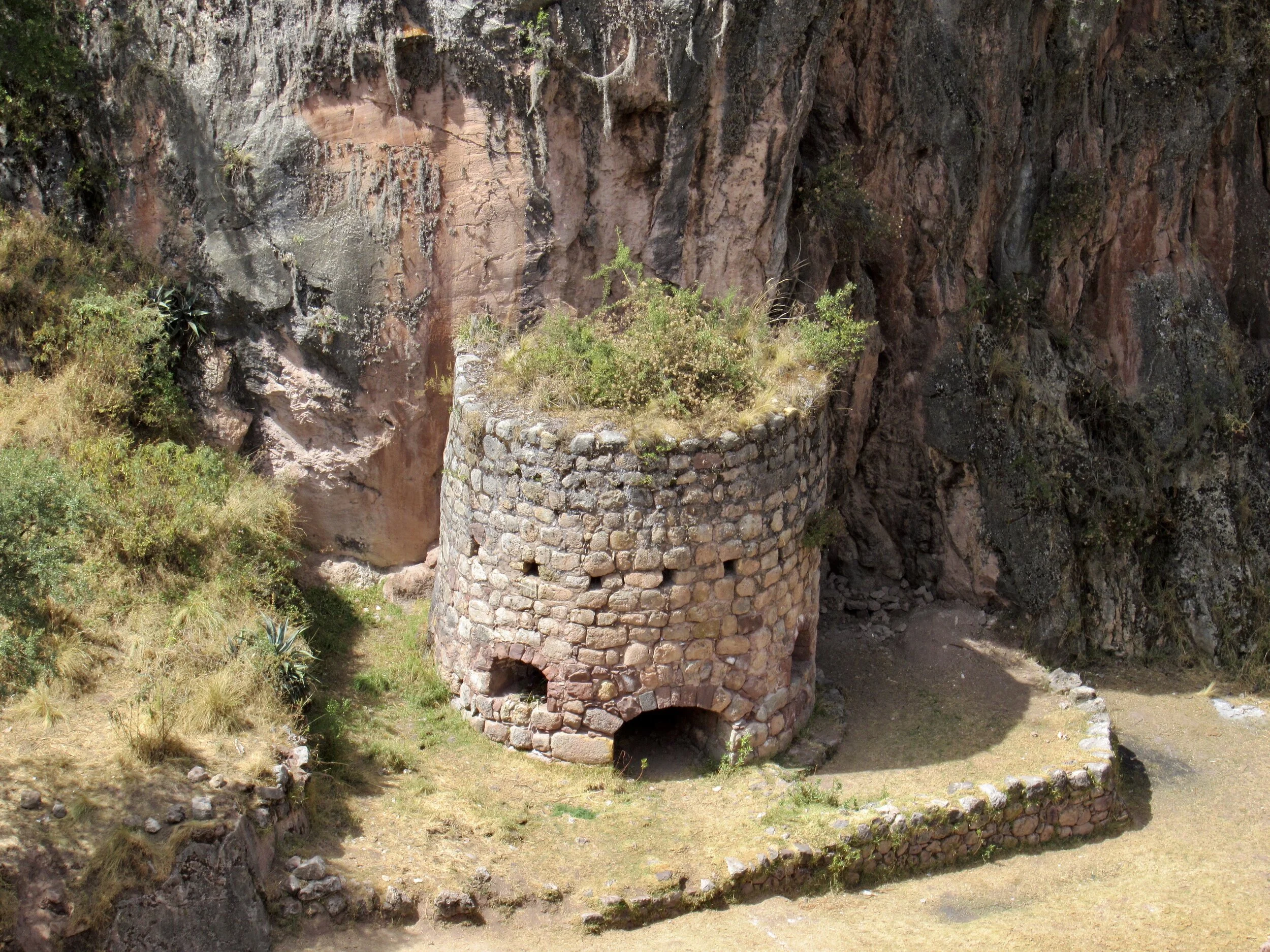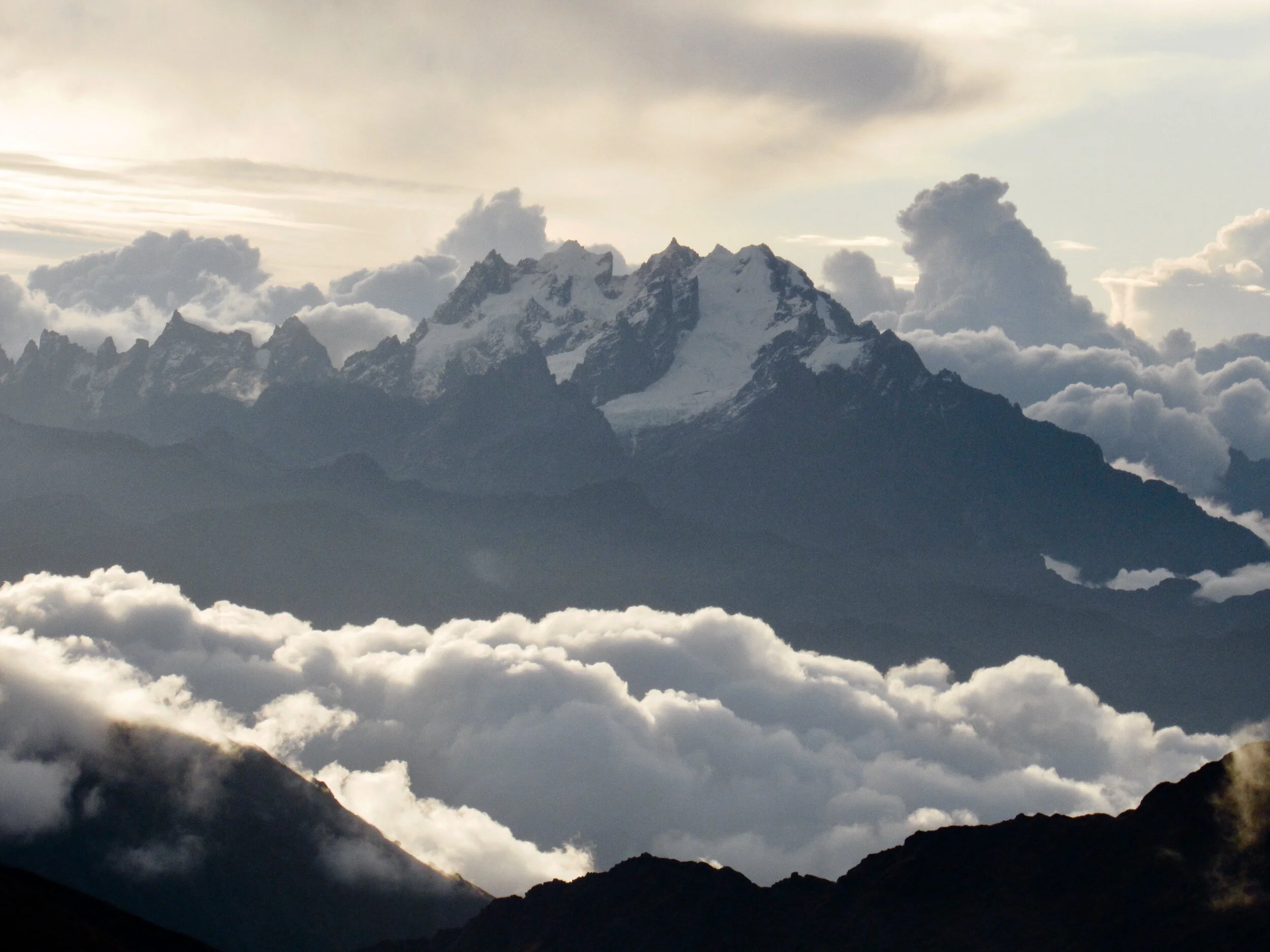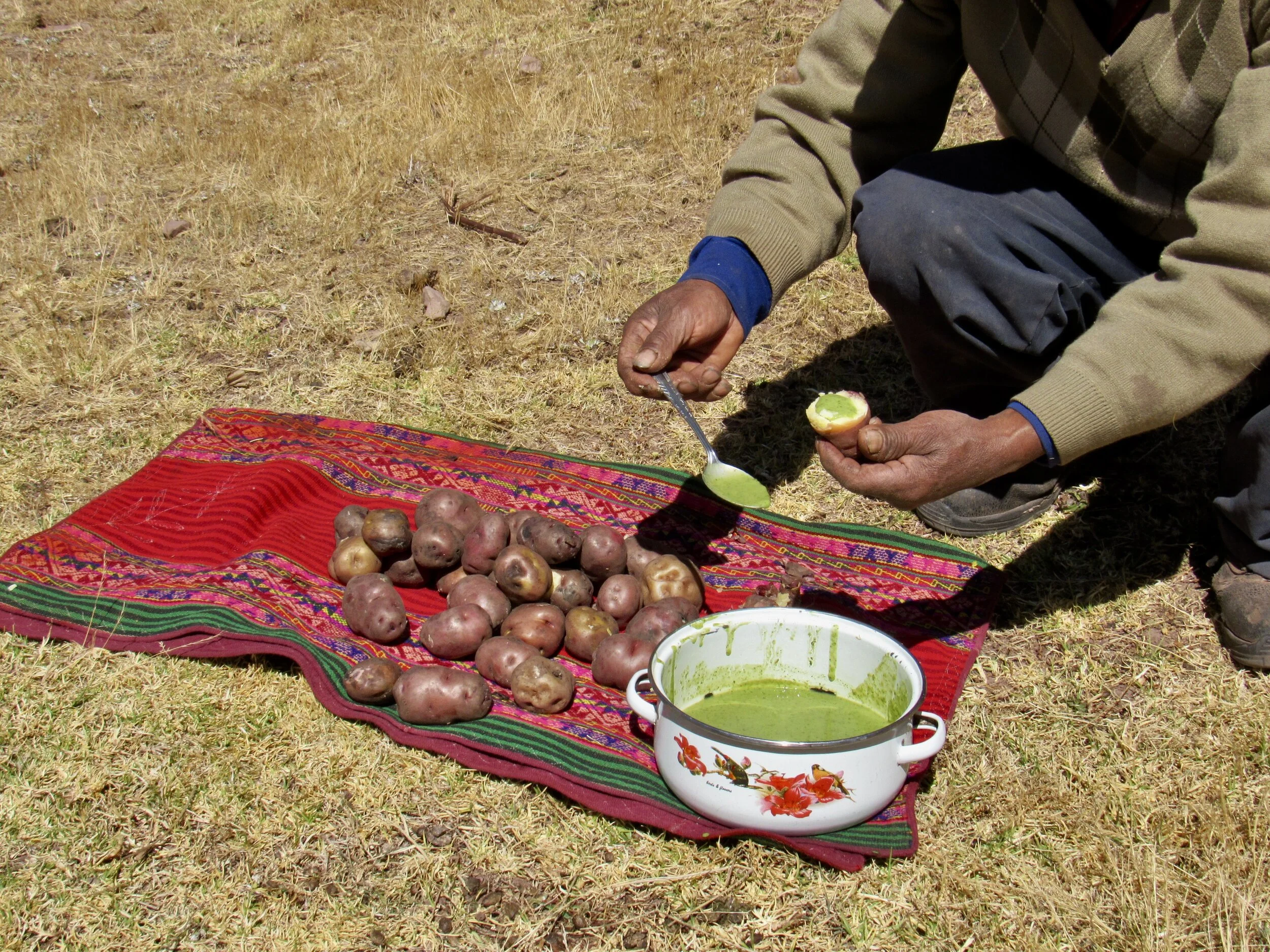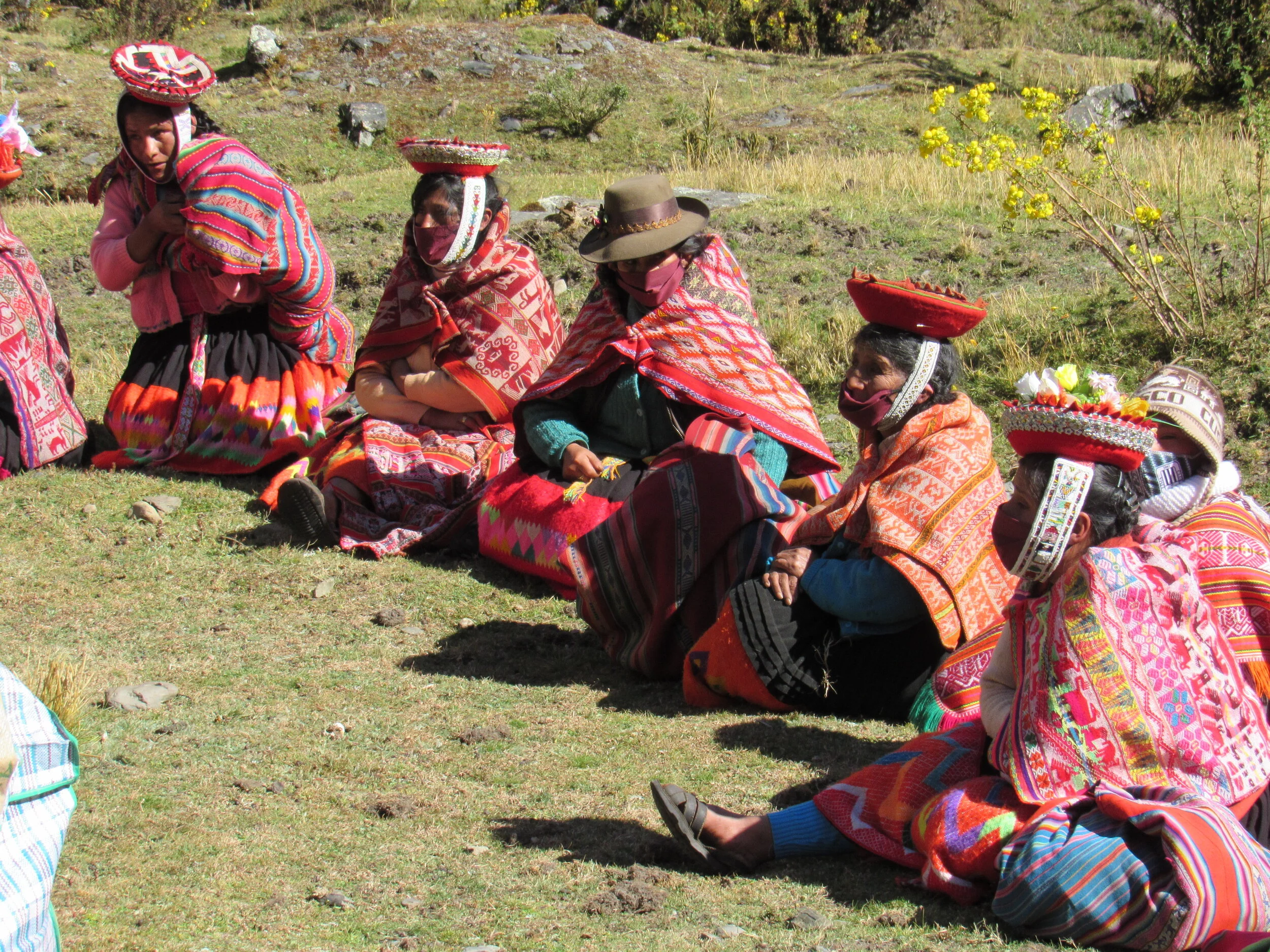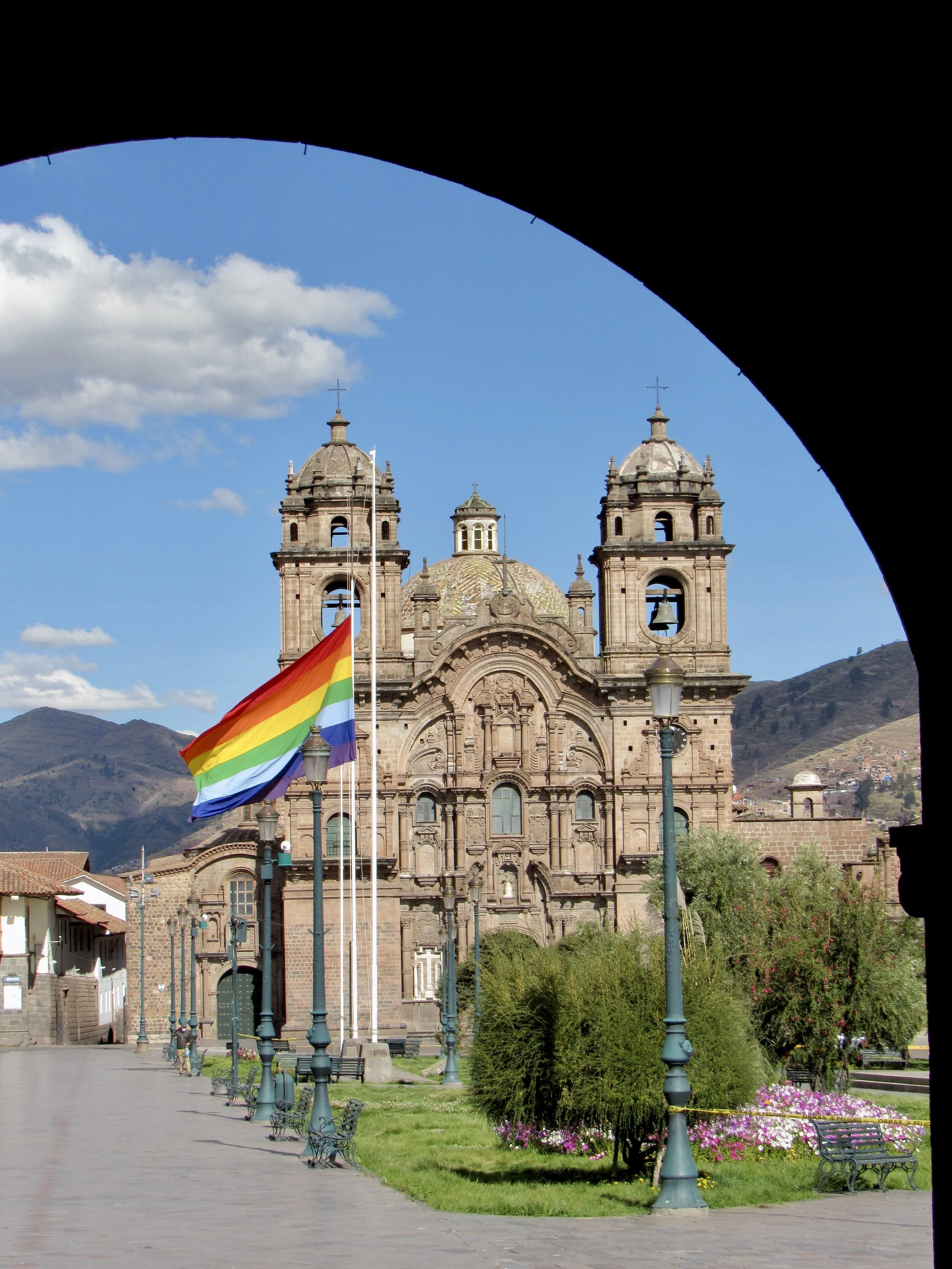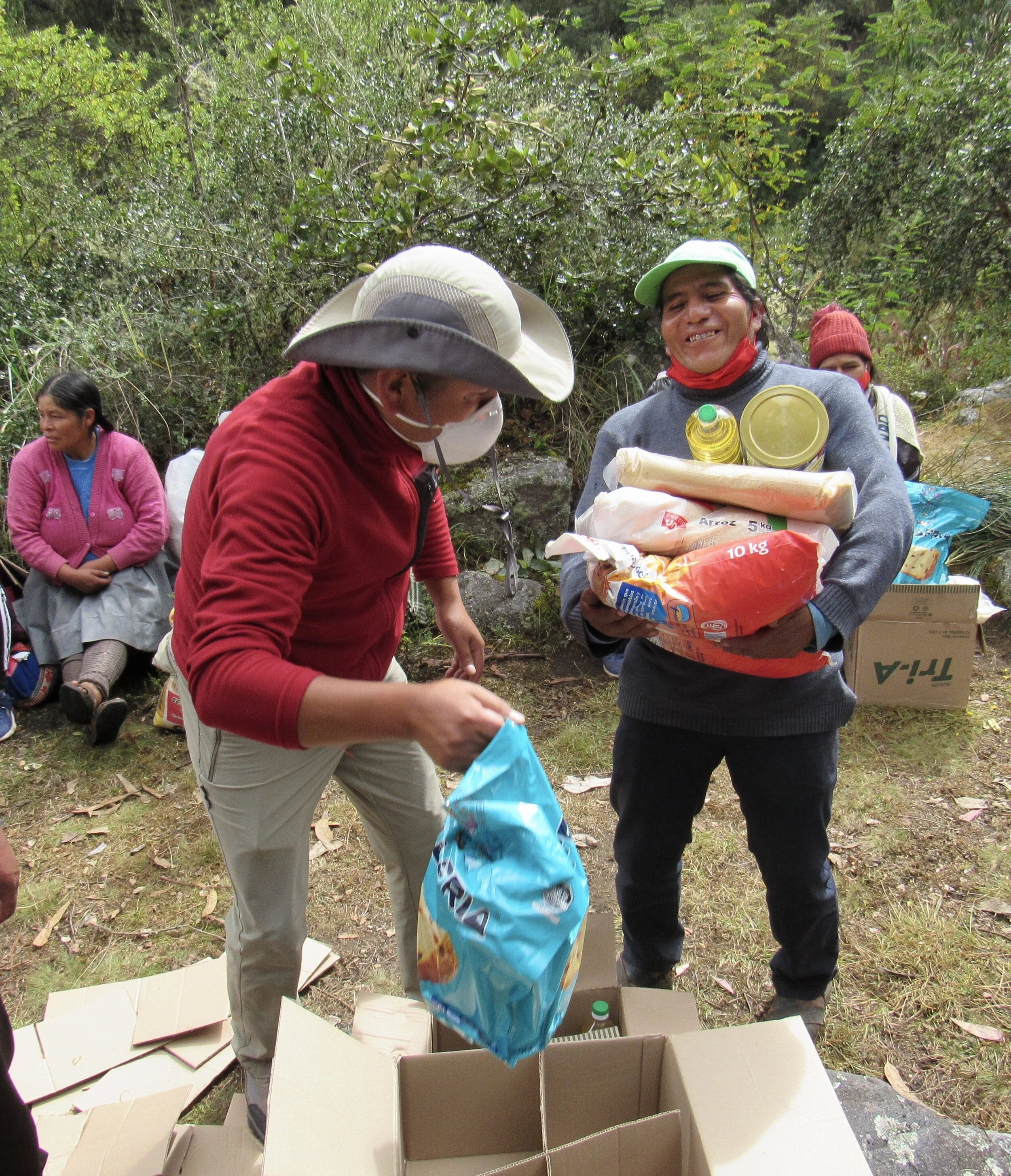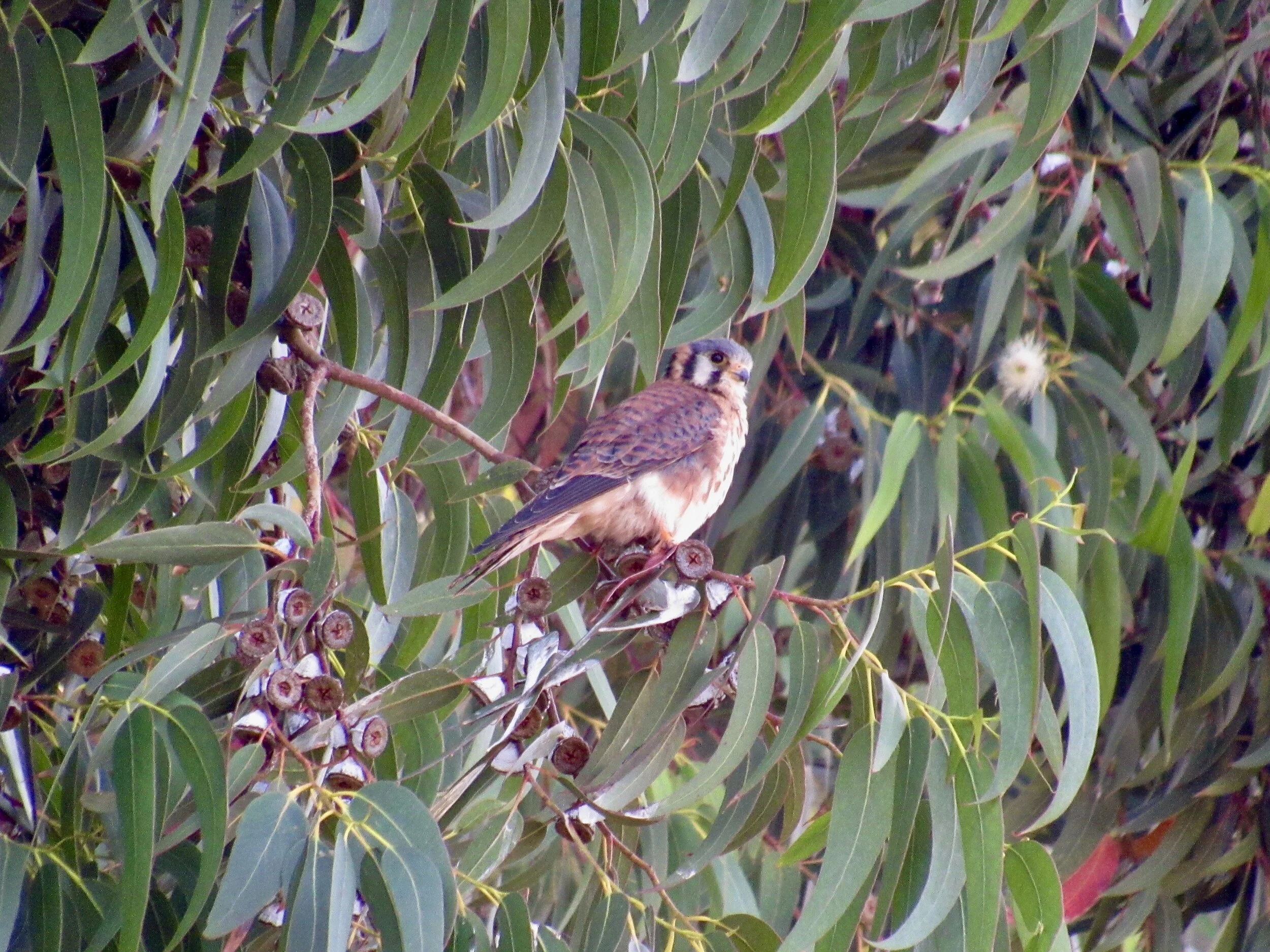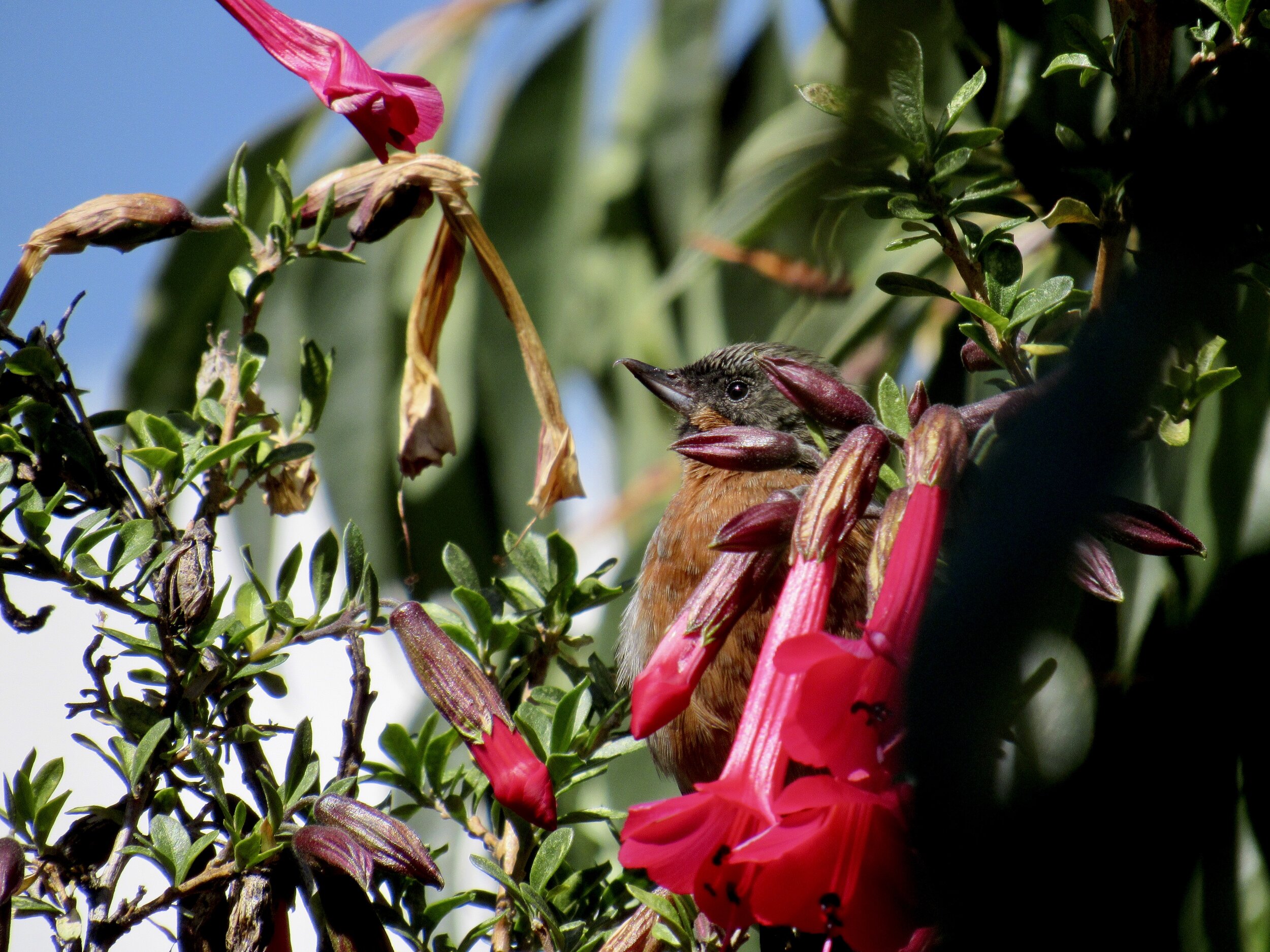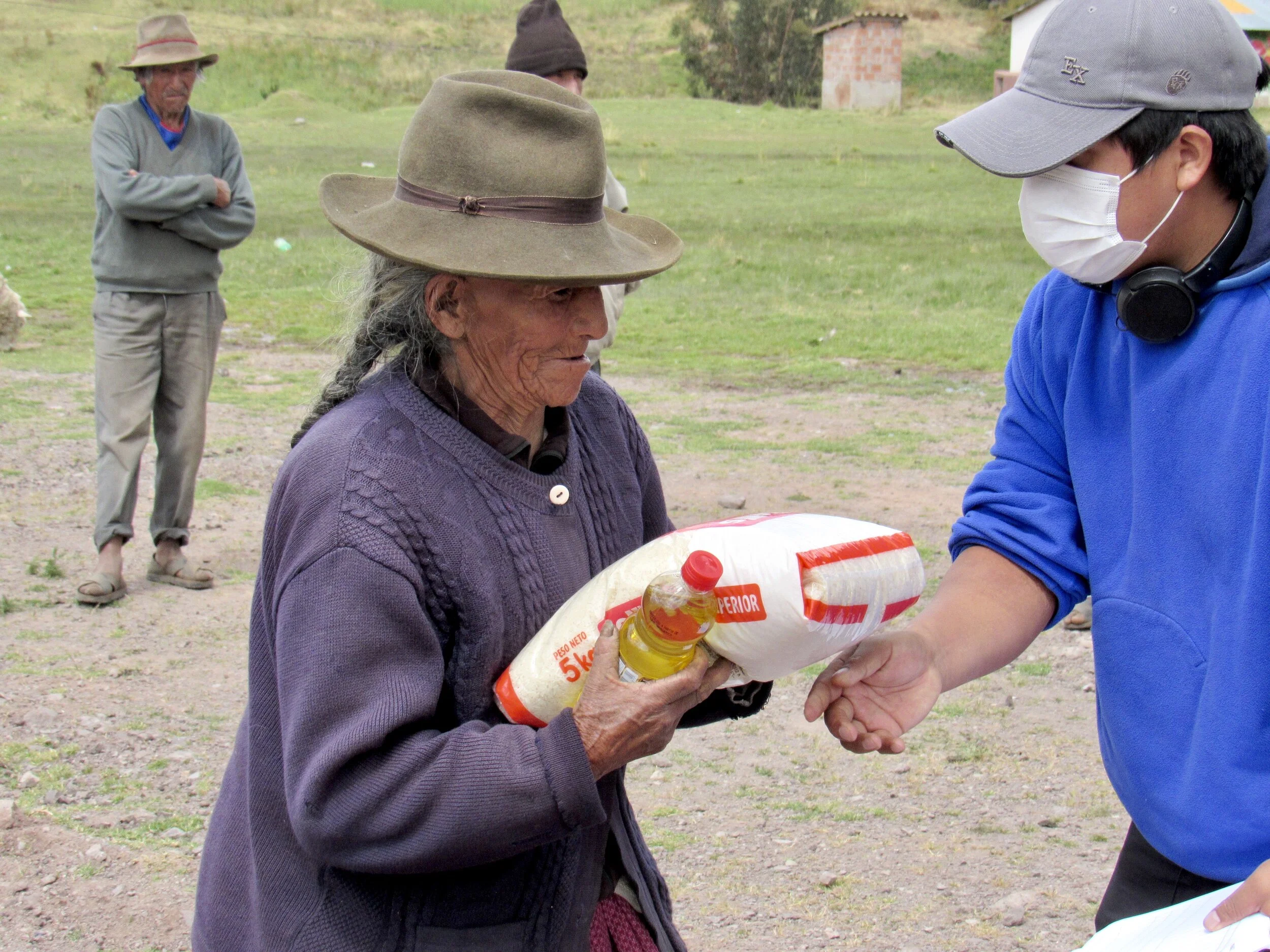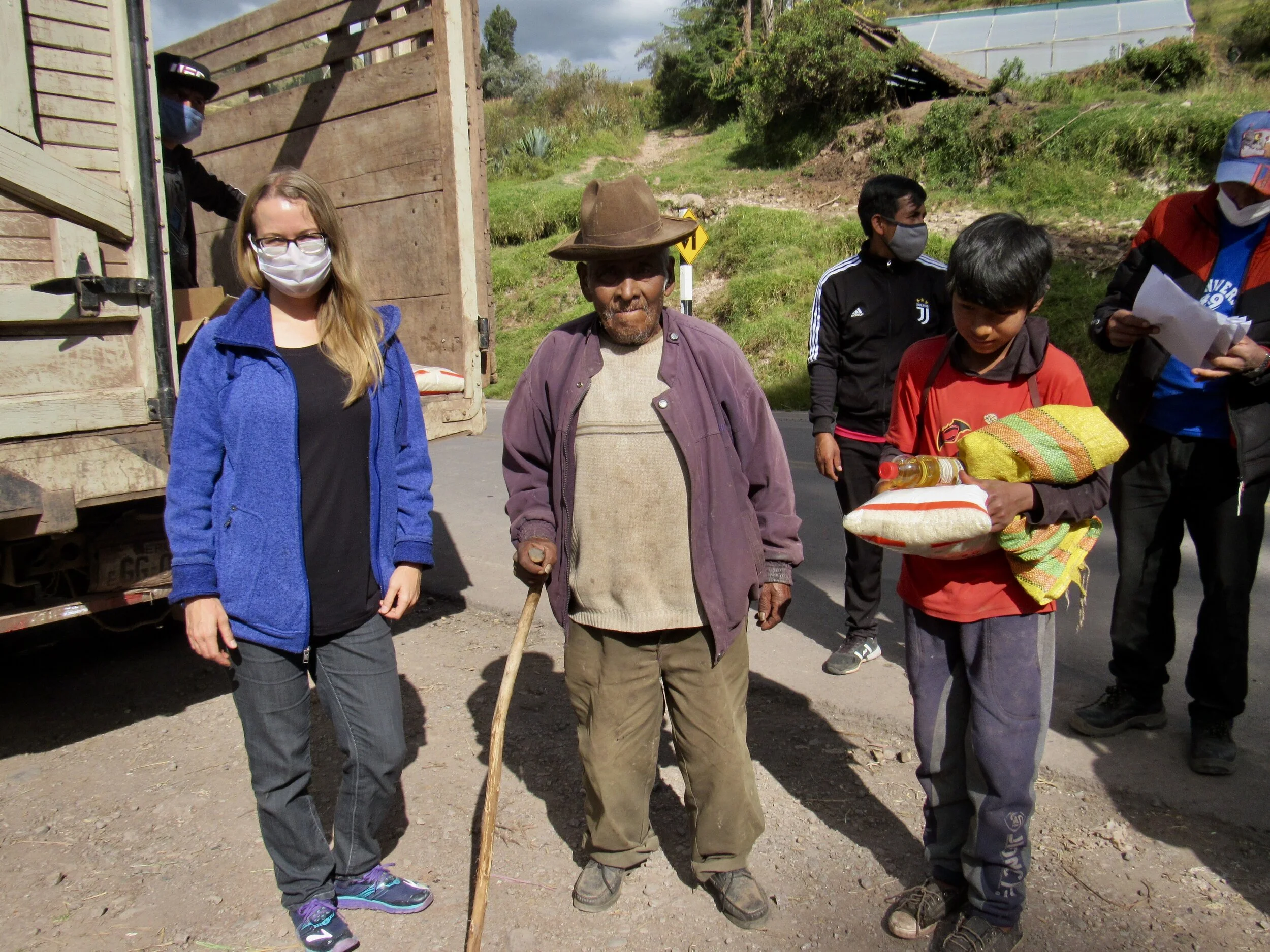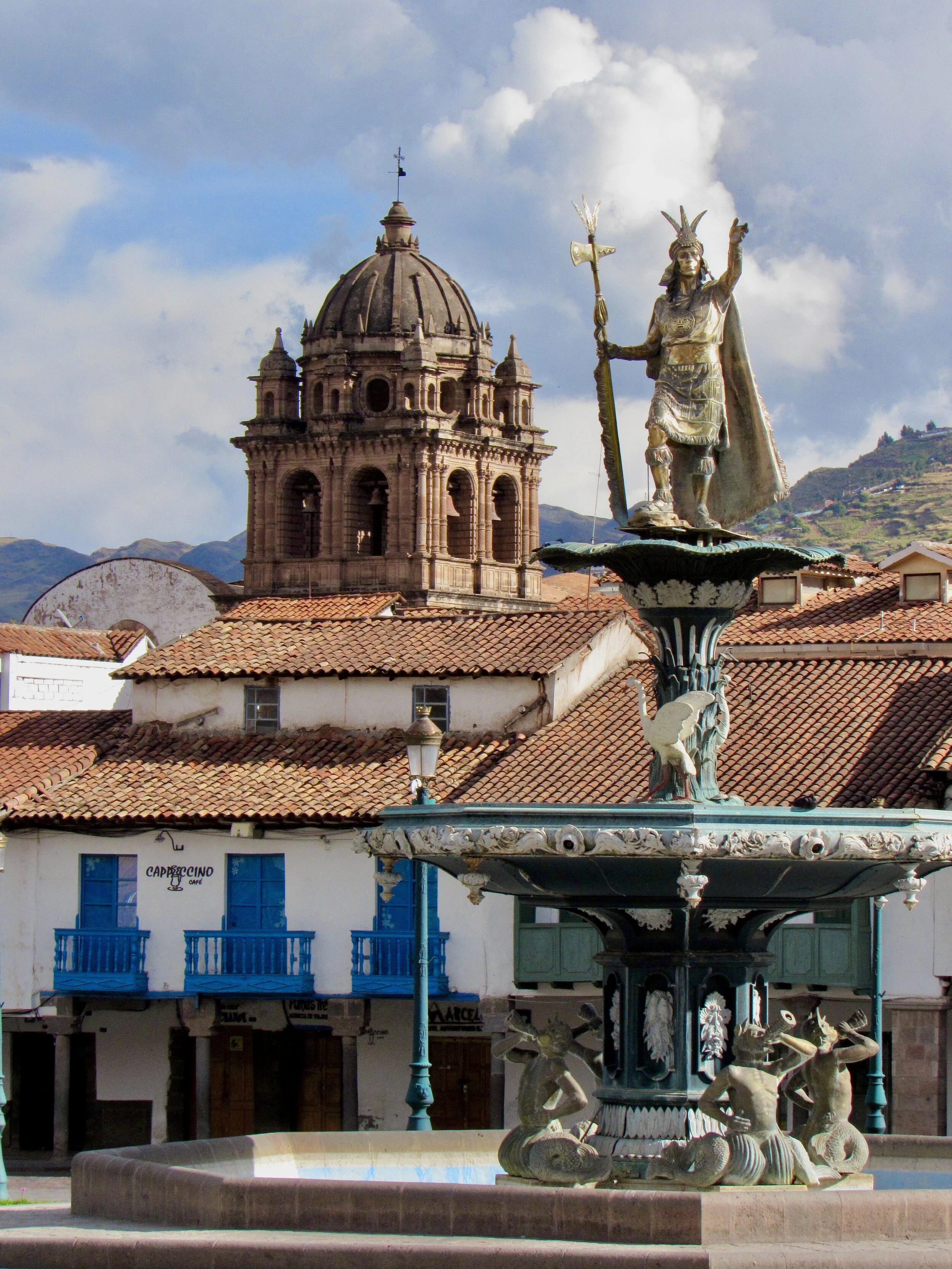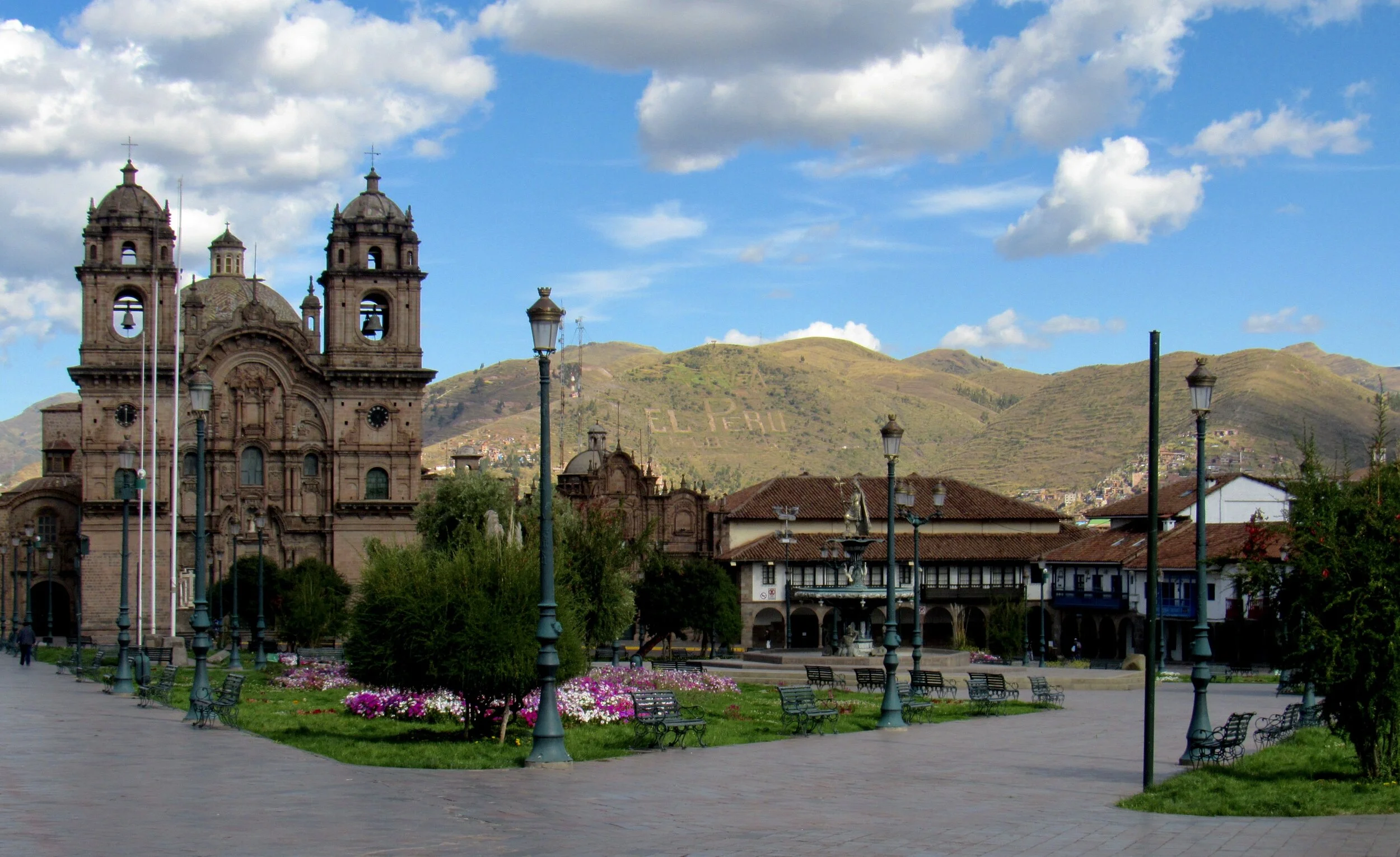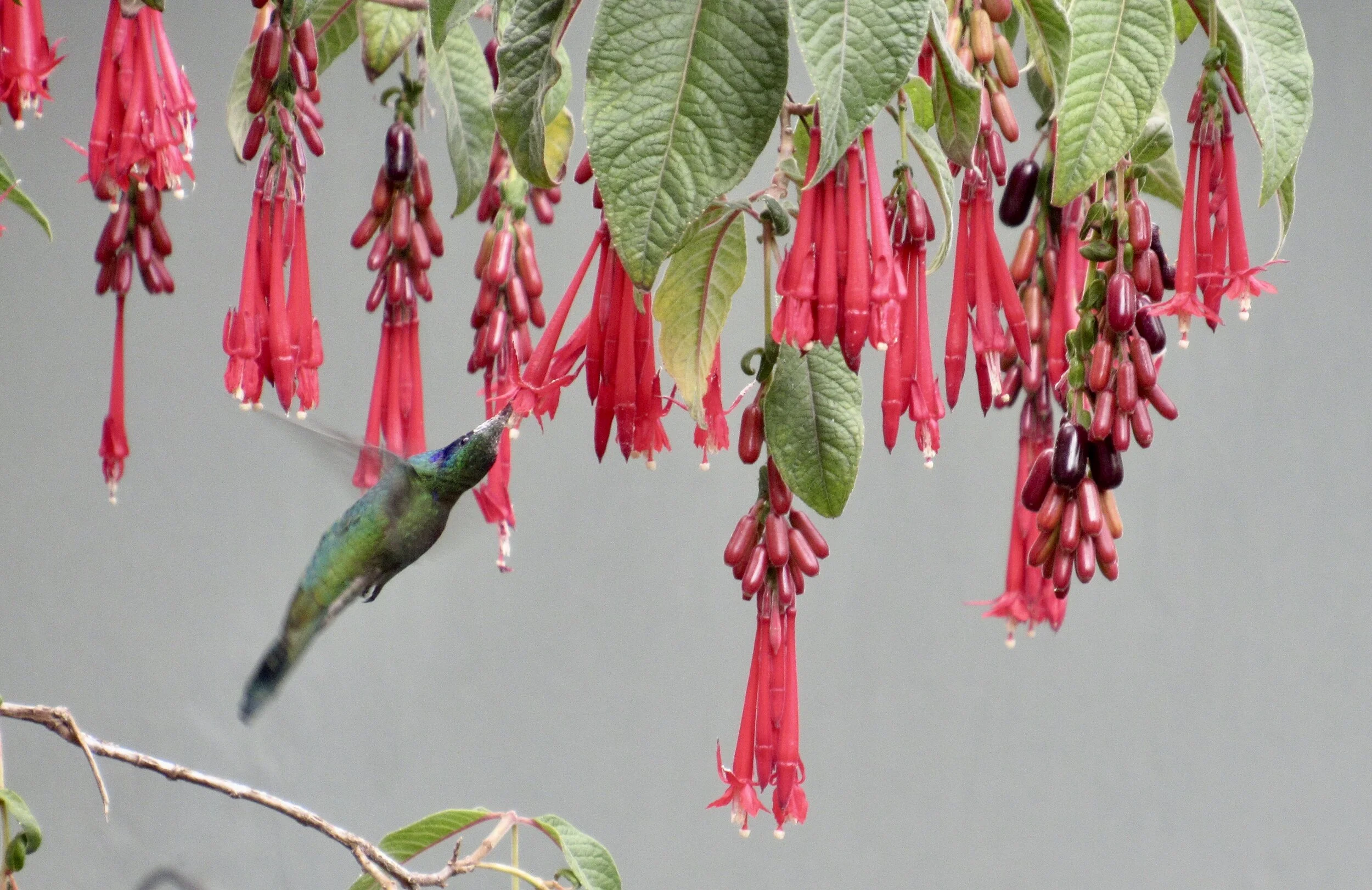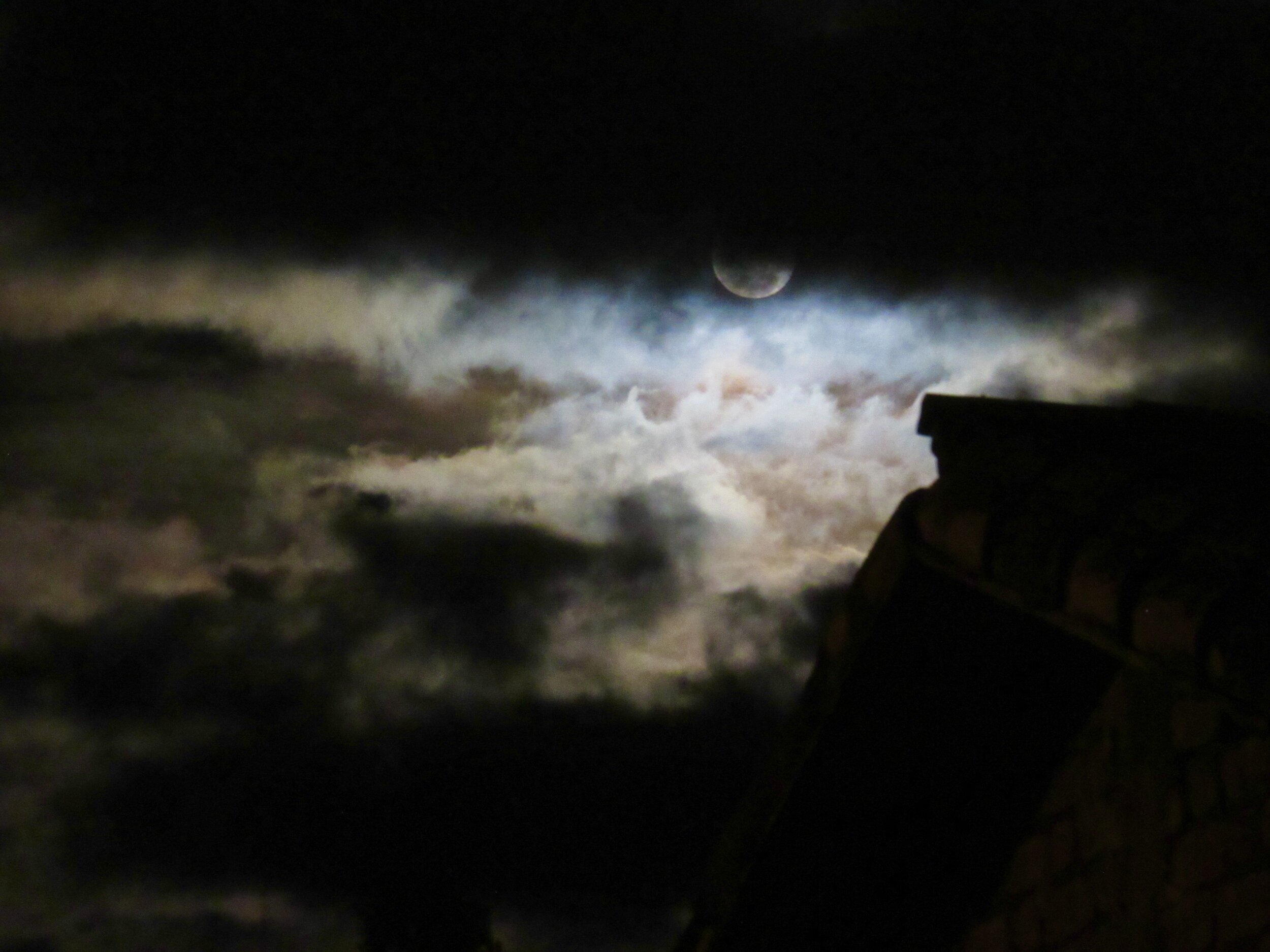COVID in Cusco: Week 22
Hiking helps me escape the realities of pandemic life and I spend time with friends while it’s still allowed.
Sunday, 9 August, 2020
149 days since Covid arrived in Cusco. 365 days since I arrived in Cusco.
I was woken up today by a call from my parents. My Dad had bought me a cake and put candles in it to celebrate today being my one year anniversary living in Cusco. It doesn’t feel like it’s been a year already, probably because almost half of that year I’ve been quarantined in my house.
The lockdown in Peru started on March 15th and was immediate. There was no easing into it here. One day things were normal, the next day the military and police patrolled the streets to keep us inside. In June and July some restrictions were lifted, but many have been put back in place for August. My favorite of these restrictions (no sarcasm) is the full day Sunday curfew. Nobody is allowed to leave the house except for emergencies on Sunday. That means that the construction workers outside my windows won’t be here today.
So much has happened in the past year. I’ve learned so much and seen so much! I was here for only seven months before the pandemic hit, but in those seven months I managed to hike the short Inca Trail, see Machu Picchu for a fourth and fifth time, hike the Lares trek, go see the northern coast of Peru by the Ecuadorian border and visit Paracas National Park and the Islas Ballestas. Most of those trips have their own blogs, but there were also so many things I learned that aren’t the normal topics for my blogs.
I learned how the tourism industry works in Cusco and I learned about all of the different treks besides the Inca Trail. From all of my experience as a traveler, it was easy to know what information would be most important to them and how to best convey that information. Still, it was my first time working in sales and customer service since I had sold kayaks for Idaho River Sports in the summer of 1999.
I learned a lot of Peruvian vocabulary, some of which comes from Quechua. Here an avocado is called palta, a pen is lapicero, a t-shirt is polo and boiled potatoes are papa sancosecha. I also learned a lot of Quechua. I can say all of the greetings like good morning and good afternoon and ask people how they are. I can say all of the goodbyes including see you tomorrow and goodnight. I know tree names, birds and other animals. I can give a toast, especially when drinking chicha. I can talk about the weather and food.
I learned more about Inca history, culture and architecture. Having already visited Cusco three times, and read a lot of books, I arrived thinking that I already knew a lot. However, living here I am surrounded by the history, culture and architecture. I don’t need books. I just need to look around me and talk to people about what I see. Learning from real people is so much better because they can not only give me a synthesis of the most accepted theories from multiple archeologists, they can also answer my questions on the spot.
I learned how to work in an office where I was the only non-Cusqueñian. I was the sole English speaker in the office, so all communication had to be in Spanish. I learned to understand their jokes and sense of humor. I really think that understanding another culture’s sense of humor is the most difficult part of learning their culture. When I was able to counter their jokes with my own, everybody in the office noticed and I felt so much more included.
I learned how to travel with a group of Peruvians. If you have read many of my blogs, you have noticed that I usually travel alone. This was a “retreat” for office staff, with the plane tickets and lodging paid for by the company owner. Twelve of us flew together to Lima, then on north to Piura, continuing in a van up to Máncora. Going along for the ride, on a trip that my manager had planned, every day scheduled with group activities and sharing a hostel room with five other coworkers was like nothing I have ever done before.
The following five months are well documented with my weekly blogs. I am still learning Quechua and some Inca history and culture, but nothing like before. I am trying to still spend time with Peruvians, though all human contact is severely limited by the pandemic.
It hardly seems like I’ve actually been here for a year. The past five months have been a holding pattern, with a few days of activity sprinkled in. Most of those days were with the Covid Relief Project, taking food to families in need. A very few were hikes outside of Cusco, where I got to see something new and learn about a new place, like Huchuy Q’osqo.
Like many of us around the world, I feel like I’m on a layover, stuck in an airport. Being on a layover is technically still traveling, on the way from one place to another. Still, it’s not really being anywhere at the same time. I’ve spent a few hours in the airport in Zurich, but I wouldn’t say that I’ve been to Switzerland. I’ve been in quarantine in my house in Cusco, but I wouldn’t say that I’ve really been living in Peru. I’m just sitting on the couch, like most people I know.
Monday, 10 August, 2020
I was a teacher for twelve years before I moved to Cusco and have been following the situation for many of my former colleagues around the world. I have taught in Boise, Idaho; Istanbul, Turkey; Dhaka, Bangladesh and Seattle, Washington and many of my colleagues from those places have spread out around the world. Some countries have things more under control than others, of course. Schools in Australia sound like they’re well organized. Some international schools have gone completely online, for the time being.
The second year I was in Bangladesh, was an election year. Elections, and the lead up to the elections, can be very violent in Dhaka. There were many days that it was unsafe to leave home and school was cancelled. There were even more days that it was unsafe to leave home in most of the city, but teachers and students who lived near school were able to get to school relatively safely. This led to the policy that we were to teach in person the students who were able to come to school and simultaneously teach online the students who were at home. It was really hard.
I have so much sympathy for teachers who are trying to teach online for the first time, even if they had somewhat of a crash course in teaching online at the beginning of the pandemic, as school in the US was near the end of the last academic year. Teaching online is so much more time consuming for teachers and so much less effective for students. Some people in Peru are already throwing up their hands in exasperation over the situation. Some are talking about this being a “lost year,” that students shouldn’t be penalized for.
The academic year in Peru was just starting when the pandemic hit. Just before the beginning of the new school year, President Vizcarra postponed opening schools. On March 11th, he announced that public schools, which were scheduled to open on March 16th, would be postponed to March 30th. Private schools which had already started the school year were ordered to close. At this point, on March 11th, there were only 13 confirmed cases of Covid in Peru, and none in Cusco.
Then, the date for opening school was postponed over and over, just as our quarantine was extended over and over. Eventually, the minister of education announced the program “Aprendo en casa” or “I learn at home.” This is a national curriculum, broadcast every day online, on tv and on the radio. Private schools have created their own online courses, but don’t have access to broadcasting on public tv or radio, like public schools. Many teachers here for both public and private schools have had to make their own YouTube channels so students can watch the lessons or extra help, when possible.
The teachers I know here are exhausted. They spend way more time planning than they used to, since teaching online is so much more complicated. Also, they get questions at all hours from kids and most feel compelled to answer immediately. Teachers know how much kids need answers to their questions. They want to be there to answer their students’ questions. How does that work when there are four kids in the house and one computer to share, so that not all of them can actually do their work during normal school hours?
Even more poignant, how does that work when nobody in the village has electricity, much less the internet or a tv? How does that work when a family lives so high in the Andes that there is no radio signal near their village? In the Peruvian village of Qhantati Ururi children have to walk for miles to get to an area that has a radio signal. These kids spend two to three hours a day walking, just to listen to the radio. This is an area just south of Cusco, but to be honest, there are plenty of villages in the Cusco region that face the same problems.
The same article about Qhantati Ururi cites the heroic efforts of one teacher in Huancavelica who walks about 10 kilometers per day to visit students. It was hard enough for me to teach online in Dhaka, where all students had access to a computer and were capable of getting online during class time. How can you make that work for kids who live in communities without electricity?
Another challenge is getting support at home, when the teacher can’t get to the kids or when they can’t send their questions to their teacher. All around the world, parents are trying to figure out how to both work and help their kids learn at home. Some parents can work from home, but that doesn’t mean they actually have time to both work and be a learning support specialist. Some parents are unable to stay home and have to either leave the kids home alone while they go to work or find somewhere else to take them.
What about the parents who can’t help because they’re illiterate? In Peru the percentage of illiteracy had gone down to 5.9% by 2018, but that includes the whole country. I am absolutely positive that in communities where the people don’t have electricity or a radio signal, many more than 5.9% of the adults are illiterate. Over 17% of women in the Cusco region are illiterate, down from 23.4% in 2008.
Interestingly, trying to find literacy statistics for 2019 or 2020 proved to be impossible. The government here has been so unstable that I would not be surprised if they had been unable to do the necessary work to calculate those statistics in the past couple years. I give them a pass for 2020, since doing anything normal now is next to impossible. Still, the complicated politics of Peru also made 2019 a loss in terms of accomplishing normal tasks. (It’s a long story, but worth reading. Here’s an English version.)
So, while I really do sympathize with my former colleagues in the US, they are mostly teaching kids who have access to the internet. At the very least, their students all have electricity. Most of their students have literate parents.
Traveling to rural communities with the Covid Relief Project, to take food to families in need, I have seen plenty of communities without electricity. I have been to remote valleys that don’t have cell service and probably don’t have any radio signal either. I have met a lot of parents who are very likely illiterate. I completely understand why some people here in Peru would throw up their hands in exasperation and start talking about the “lost year.”
Tuesday, 11 August, 2020
This morning I went to the San Blas market and realized how weird the new normal is. The cop at the entrance to the market, watching us wash our hands barely even registers anymore. I automatically wash my hands, thinking about what I need to buy rather than how sad it is that the pandemic has forced us to have to wash our hands to go buy food. In weeks, if not months, I haven’t even noticed that more than half of the stalls in the market are empty. I have learned to just look at the ones that are open.
The same two women I used to buy from before the pandemic are still there, so my shopping habits haven’t really changed much. However, the woman I used to buy coffee and chocolate from is gone. Little by little, I bought out her stock of chocolate and coffee throughout March, April, May and June. Every time I complained that she wasn’t getting in any fresh coffee and she would tell me that the roasters in Cusco were closed. All she had was what she had in stock before the pandemic. Every week her selection of chocolates was worse. First I bought all of her dark chocolate with almonds, then all of her dark chocolate with pecans, then the quinoa and kiwicha. Then, a couple weeks ago, her stall was boarded up. I haven’t seen her since.
The woman I buy veggies from is near the entrance of the market. She’s a thin woman, well under five feet tall, with some gray at her temples. I usually buy onions, tomatoes, peas or fava beans, sweet potatoes or one of the other ten varieties of potatoes she stocks, cauliflower or broccoli, bell pepper and spicy chillies, a cucumber and some basil or swiss chard. I get leeks if I’m going to make a lentil soup and eggplant if I’m going to make a green curry. She also has dried black beans, lentils and garbanzo beans. Black beans are hard to find here, which is one of the reasons that she’s my go to veggie stop.
My fruit lady looks very young, but she has told me that she has a fourteen old daughter, so she must be older than she looks. Since the pandemic started and the market emptied out so much, she is often knitting when I walk over to her spot. She knits baby clothes, which is why I initially thought she must be in her early twenties, with her first baby. Nope. She just likes knitting baby clothes. She gives them to friends and family. I usually buy a papaya or two, oranges for juice, mandarines, passion fruit, bananas and avocados. Avocados are always sold at fruit stands, never at vegetable stands.
I usually spend 30 to 40 Peruvian Soles, which is about $10USD. The quality of the produce here, and the low prices, are what makes being unemployed in Cusco livable for me. On the way out of the market there is another hand washing station. I’m always so weighed down with my bags that I squirt a little alcohol gel on my hands and just walk home. I often think that my fabric bags will break one day, but I have definitely tested them and they have held so far. It’s normal for me to have up to ten kilos in the veggie bag - a kilo each of onions, potatoes, peas, tomatoes, cauliflower plus a bit of everything else. The fruit bag is usually lighter, but still heavy enough that I’m glad home isn’t uphill from the market.
Wednesday, 12 August, 2020
Today started with a hike up past the Temple of the Moon with my friend Hannah. She’s the one I teach Spanish to on Monday evenings. We made it a gentle little walk, very unlike my illegal hikes back in March and April, when I was trying to get up to the top by sunrise and back home before anybody noticed that I had left the house for something other than food or pharmacy. On those hikes, I was walking uphill as fast as my lungs would allow. Today, it was much more of a leisurely stroll.
Walking outside is still legal - for adults. I cannot for the life of me understand that government’s position that those under 14 are a special risk group and should not be allowed out of the house. After months of a complete prohibition on children leaving the house, they are now allowed a half hour outside for exercise, accompanied by an adult and following social distancing requirements. From what I have read, children under 14 aren’t actually a special risk group for Covid. After almost five months of reading that in Peru children under 14 are at special risk for Covid, I’m still at a loss as to where this idea came from.
Hannah moved to Cusco for similar reasons to mine. She thought it would be a nice place to live and that she would be able to find work here. After years in the fashion design industry, in the UK and US, she found work in Cusco with knitting. Specifically, with women knitting in prison. Prison labor has a bad history in the US, but Denmark doesn’t have the same history, or the baggage that comes with that history. Hence, the brand Carcel, from Copenhagen.
Carcel means prison in Spanish, but for some reason it’s a brand name that works in Europe. The company employs women in prison, training them on specialized knitting machines. The mission of the company is to give women skills that they can use to get a job, after they leave prison. This arrangement is not without moral and ethical complications. Done even a little bit wrong, it ends up being exploitation. Done right, women in jail can earn a living wage to send to their families back home. Also, women leaving jail can get a good job and support their families when they do get back home.
According to a 2018 study by the Universidad de Ciencias Aplicadas (University of Applied Sciences) of Lima, six out of ten Peruvian women have committed drug related crimes. That is a staggering number, which I found unbelievable before I read the whole study. Most of these women were economically and socially vulnerable: uneducated single mothers who struggled to earn enough to support their children. Most were coerced by a family member to transport drugs, told that women are never suspected or arrested.
Hannah truly loves her job and the women that she works with. From what I can tell, the Carcel brand is doing things right. It really doesn’t look like exploitation to me. They are knitting expensive alpaca sweaters for exportation to Europe. They are earning a very livable wage and do benefit from a lot of training. Still, prison labor laws in the US prevent Carcel from exporting to the US.
The pandemic has made absolutely everything more complicated, including how often Hannah can enter the prison. I haven’t read about Covid spreading in prisons in Peru, but I wouldn’t be surprised if that was a problem. In the US, it is definitely a problem. I am just hoping that the tragedy in Seagoville, Texas won’t be repeated in Peru.
Thursday, 13 August, 2020
The San Blas market is by far the closest to my house, but the San Pedro market is both the biggest and the most touristy. Of course, nothing is very touristy now, since borders have been closed for almost five months. I went on a search for fabric, as part of one of my ideas of what to do with myself as Peru goes back into lockdown. Yesterday President Vizcarra signed another Supreme Decree, telling us to all stay home again. Curfew for the whole country is now 8pm six days a week, and all day on Sunday. Many of the freedoms allowed in July are being taken away.
Sewing has always been relaxing for me. I live in a country of alpaca and sheep, surrounded by knitters, but knitting has always been more frustrating than relaxing for me. The women here seem to knit while doing everything else. They knit while selling fruit at the market, while watching sheep in the fields, while waiting for the bus and while on the bus. Back when people were allowed to be near each other, I was constantly surrounded by women knitting.
I am hoping that sewing will make me feel productive and useful. It’s something that I can do that doesn’t involve looking at a screen or a whole lot of thought. If you’ve made it this far in this blog, then you know that I love writing. However, lots of screentime is not good for any of us and I have been looking for things to do that give me the satisfaction of creating something, without spending hours on the computer.
Peru is not only a country full of yarn and knitters, there are also amazing textiles woven here. I went to a few fabric shops next to the San Pedro market and each was full of beautiful fabrics. I honestly could have spent all day in each one. They all had machine woven fabrics and also more rustic, handwoven fabrics. I settled on two meters of a rich brown and purple machine woven fabric and a handwoven blue with multicolored stripes. I also got a length of woven ribbon, one of hundreds of options at the shop.
The prices of fabric here are shockingly low. For the meter of ribbon I paid s/1 Peruvian sol. For the machine woven fabric I paid s/24 for two meters. The handwoven was twice the price, at s/50 for two meters. Still, s/75 is only $20, with the current exchange rate. That should be enough to keep me busy at least through the full day Sunday curfew this weekend.
Friday, 14 August, 2020
Knowing that Sunday I won’t be able to leave the house, I’ve planned hiking trips for both today and tomorrow. Today I’m headed out of Cusco through the San Cristobal neighborhood, then up through the Sacsayhuaman archeological area and around to Tambombachay and back down into my neighborhood Lucrepata.
It turned out to be about 7km/4.5 miles of easy walking. All archeological sites are supposed to be closed, but Sacsayhuaman is also a thoroughfare from Cusco to a few small communities in the hills above town. I had no trouble walking along the road, though when I stopped to take photos of the ruins a guard blew a very loud lifeguard kind of whistle at me. I waved so he would know I got the message. Every access point to the ruins, all of the stairways that are over 500 years old, have been roped off with red tape decorated with skull and crossbones that says Peligro (danger).
I was close enough to town to be sure that there were no ronda campesinas in the area - communities that have taken it upon themselves to create a security force to keep outsiders out. It’s really important for isolated mountain communities to stay isolated during the pandemic, but the communities within easy walking distance of Cusco are far from isolated.
It was a beautiful and relaxing walk, without any drama or difficulties. If only I could stay that about every day!
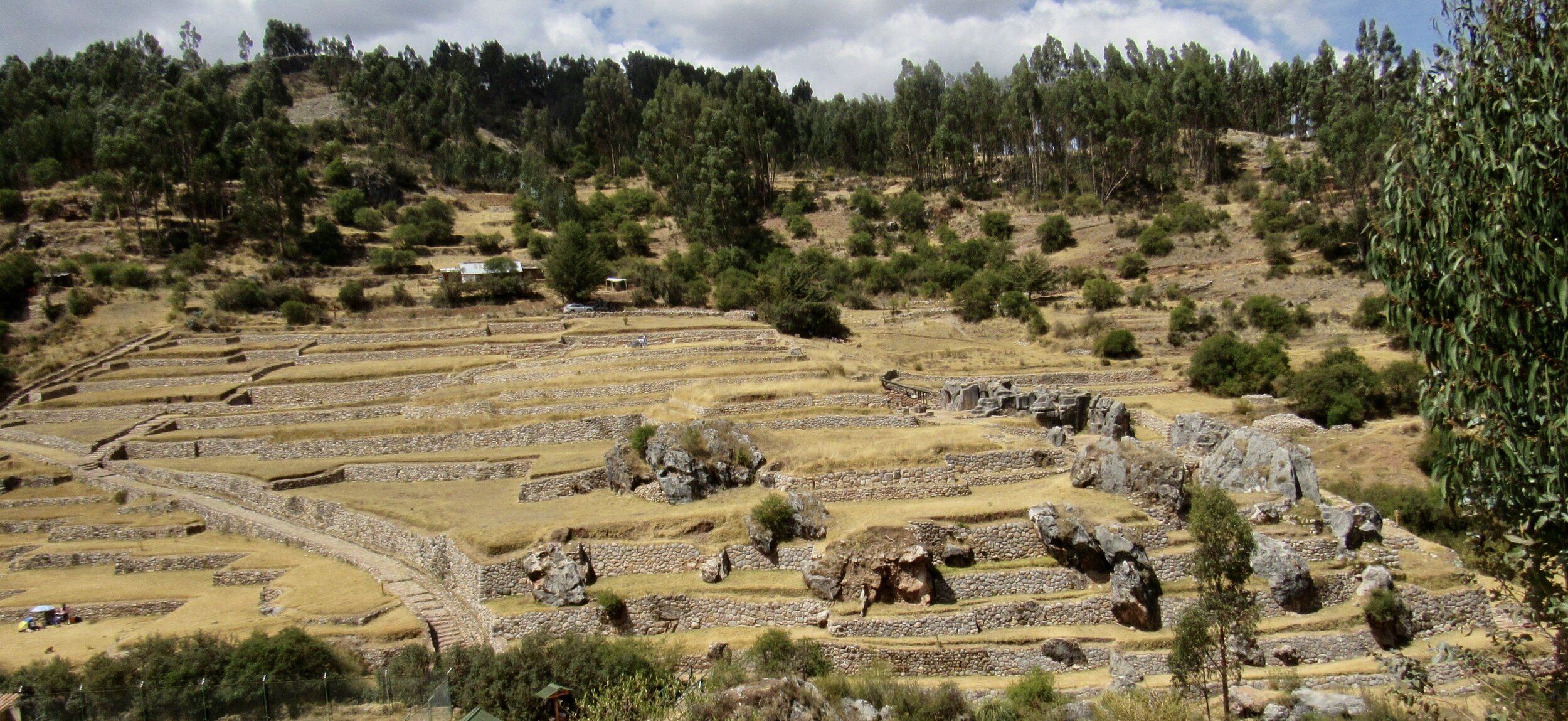
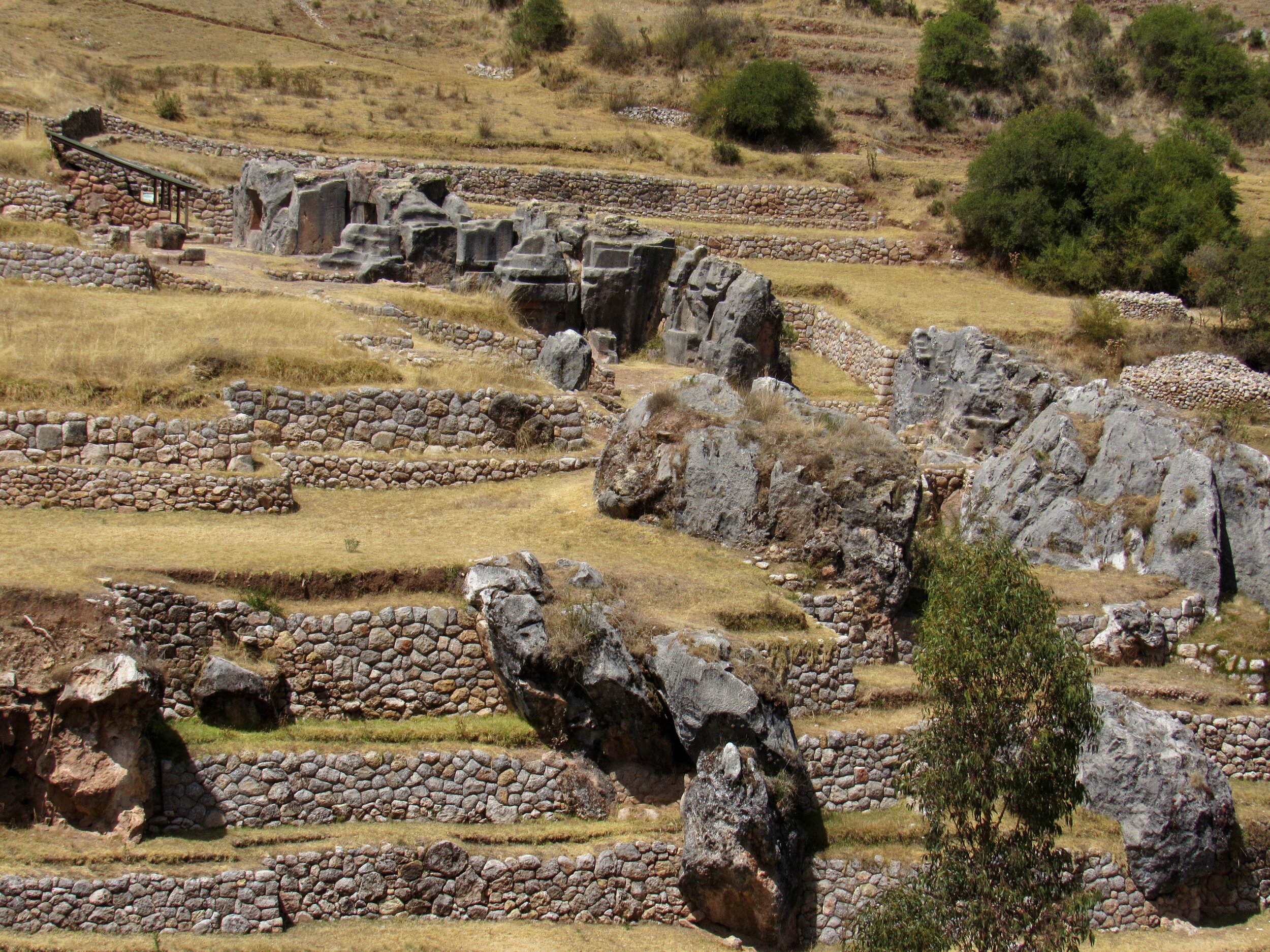
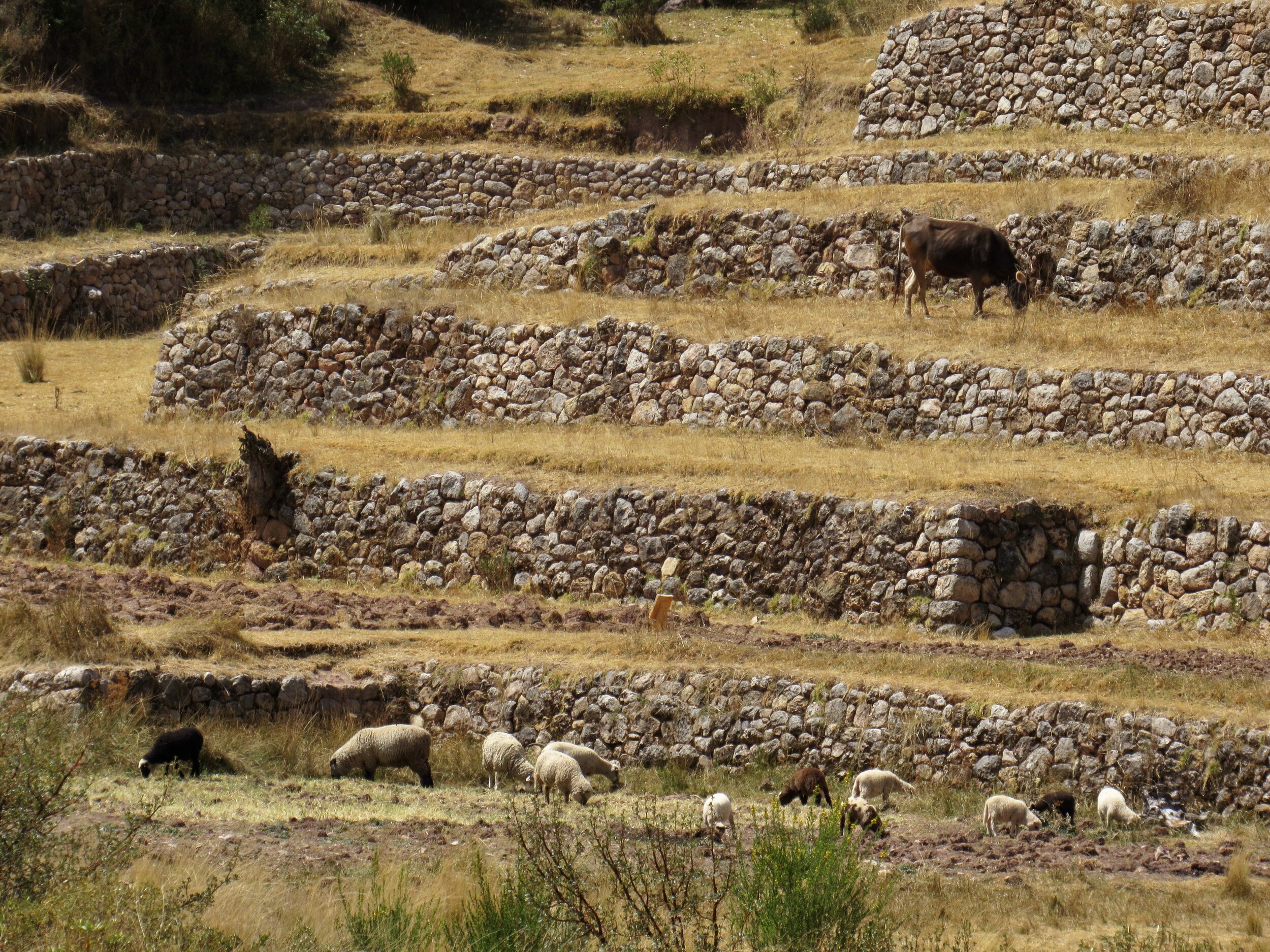
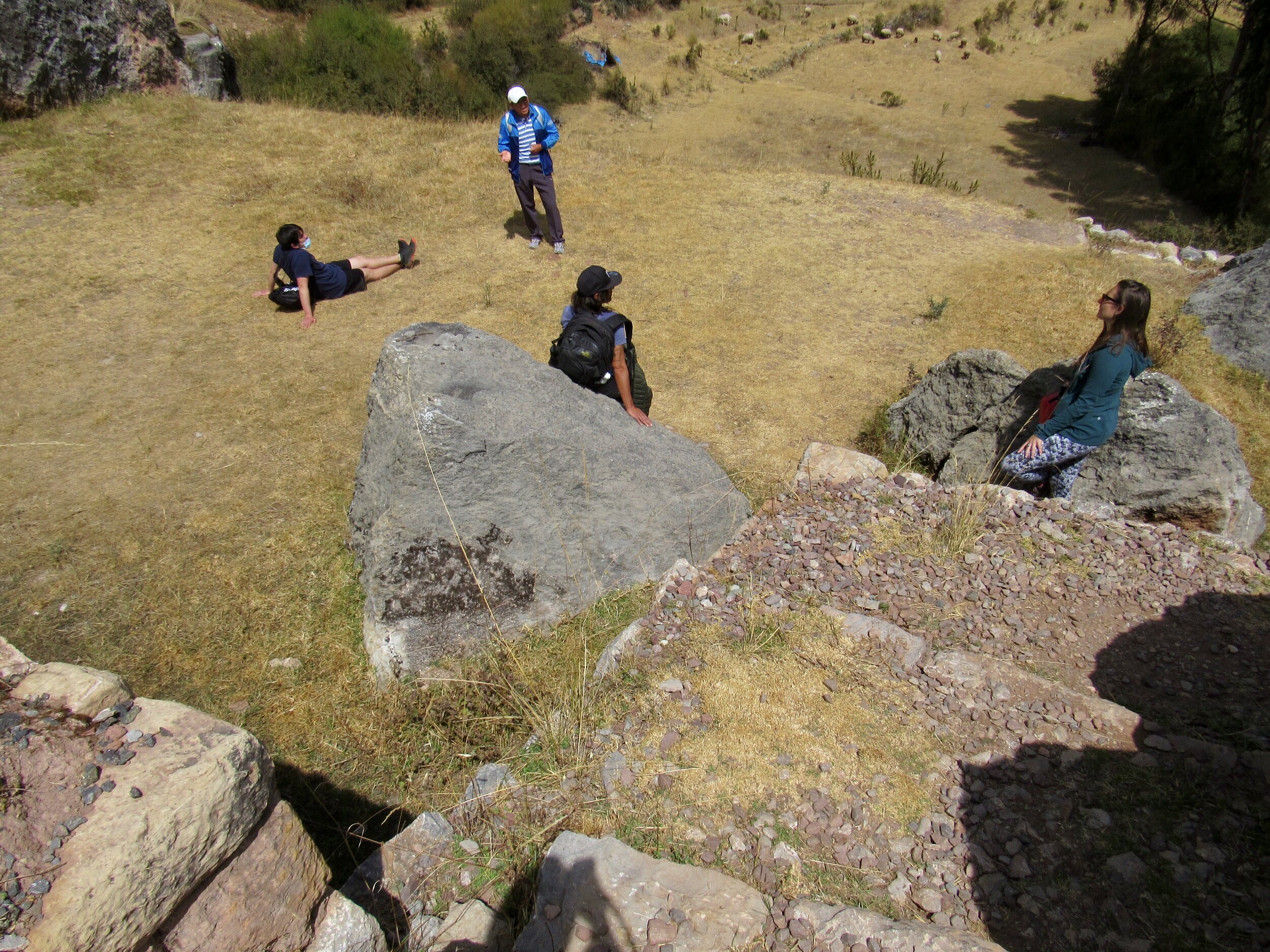
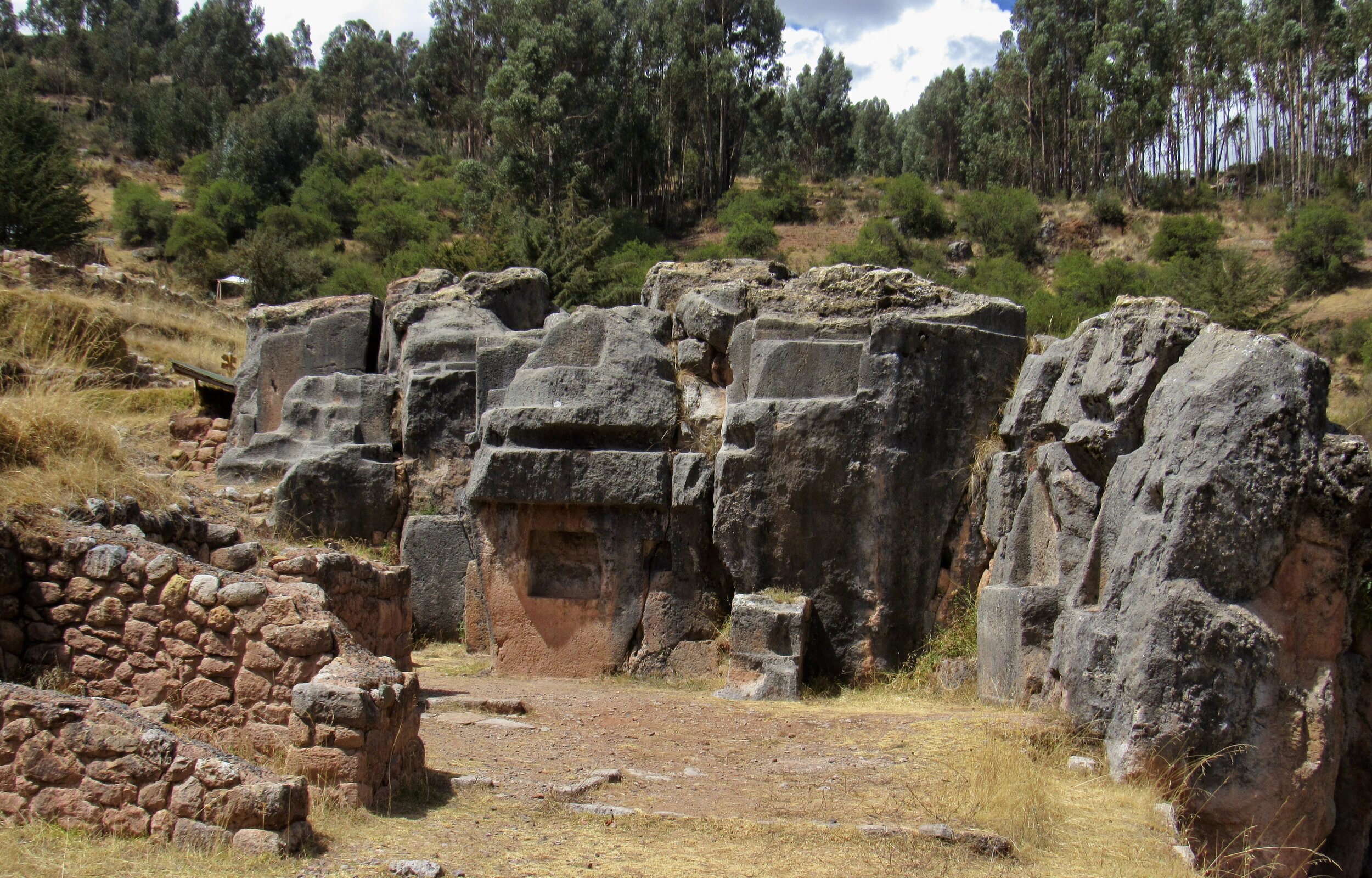
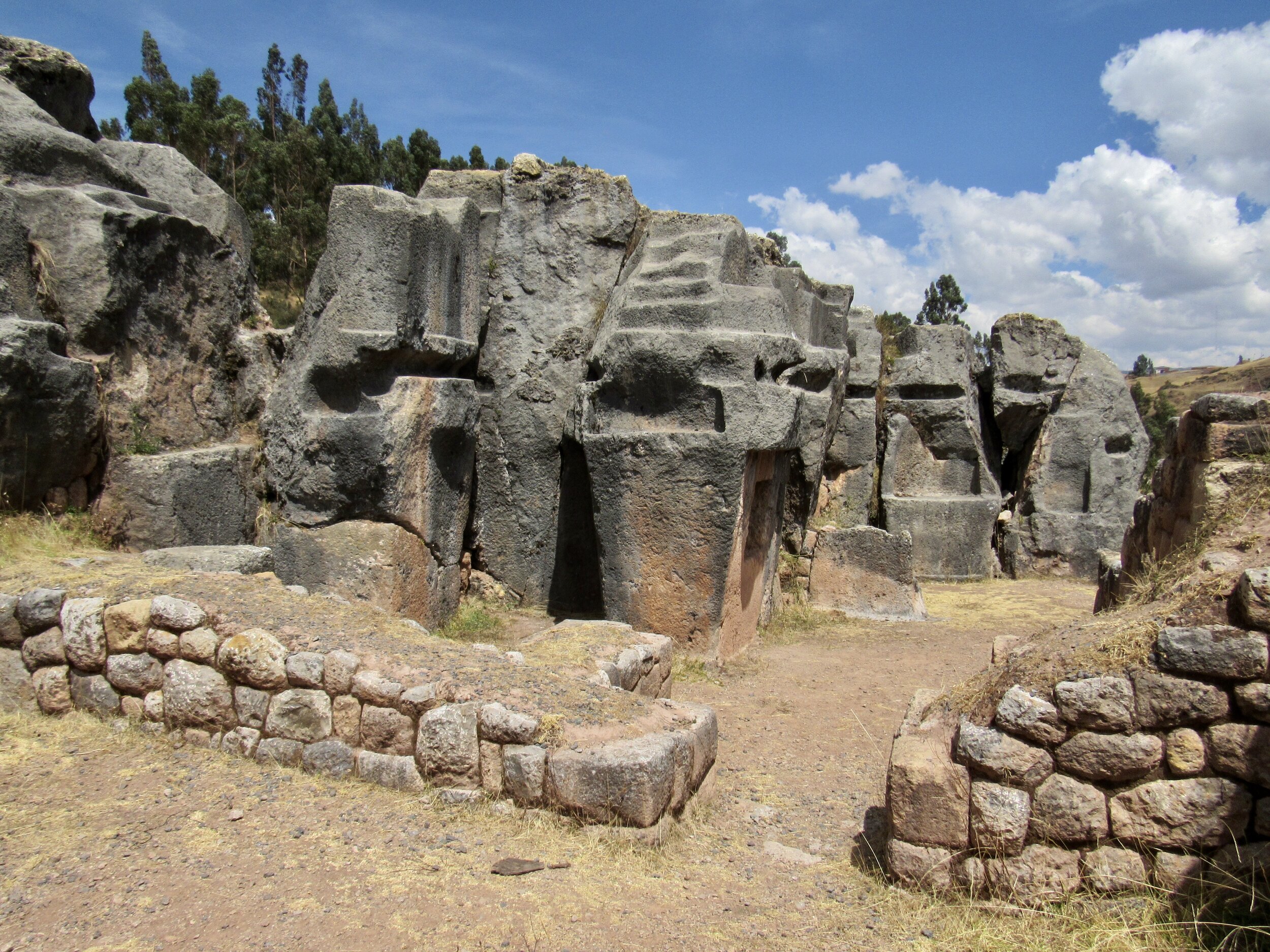
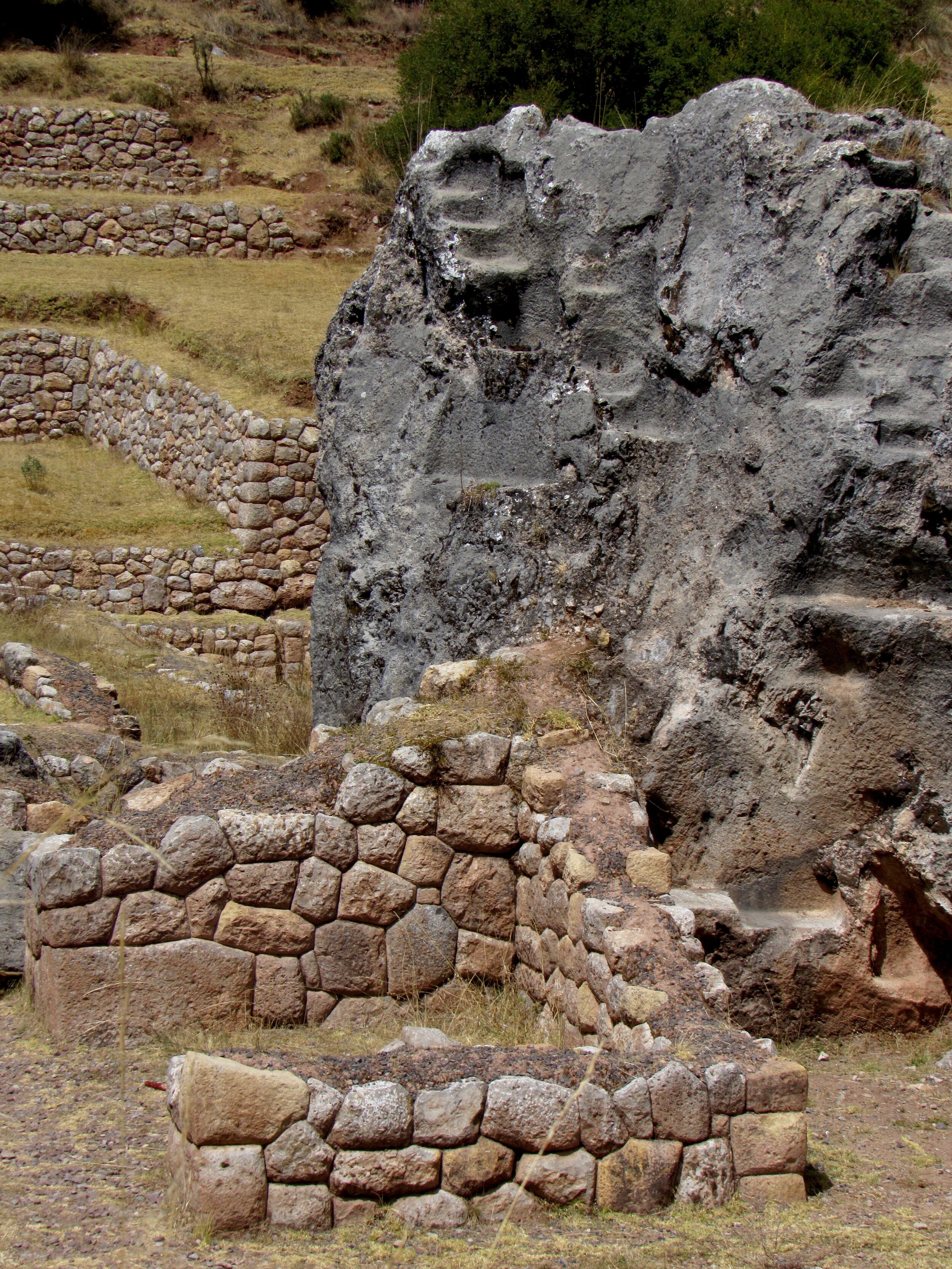
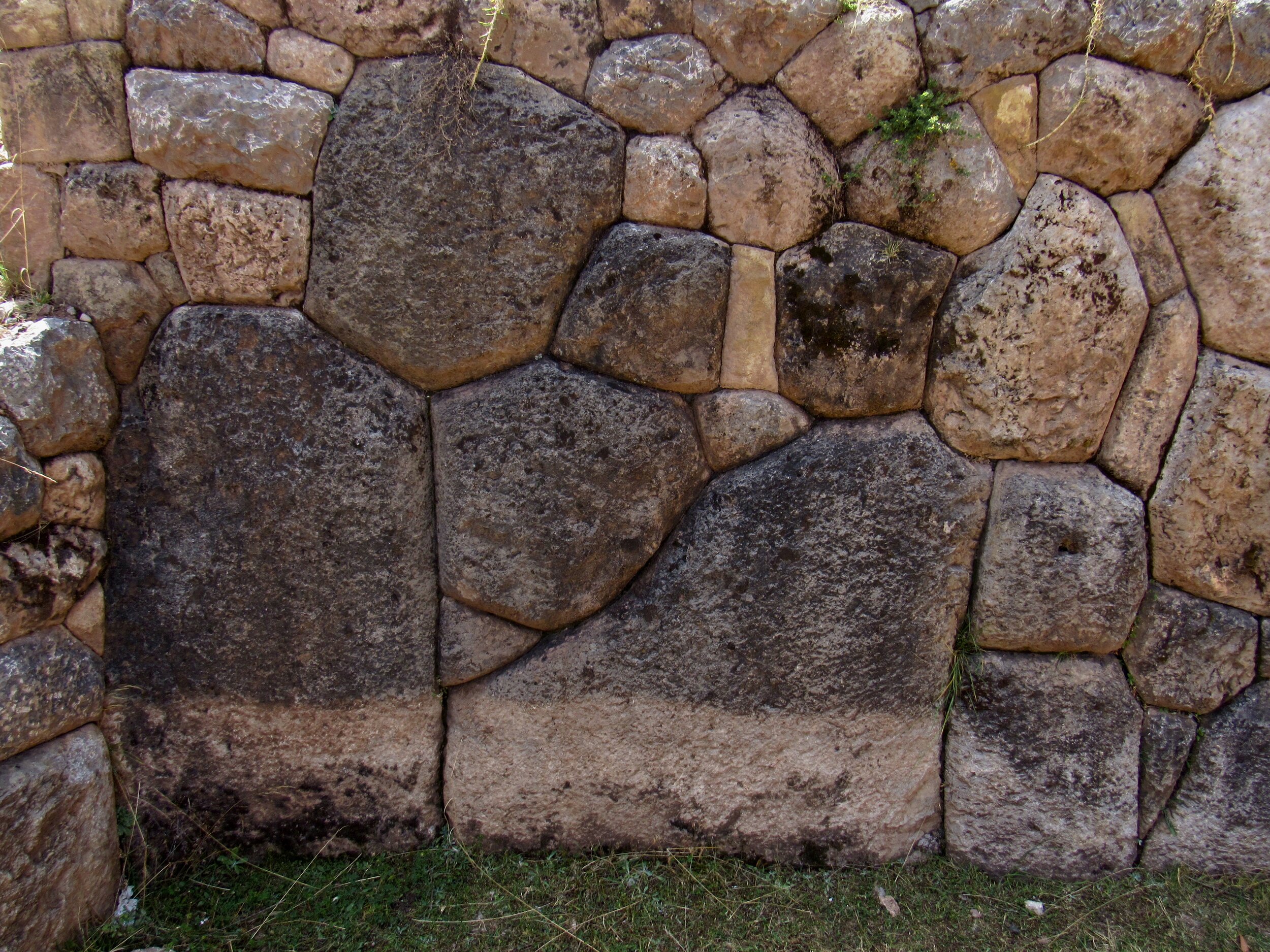
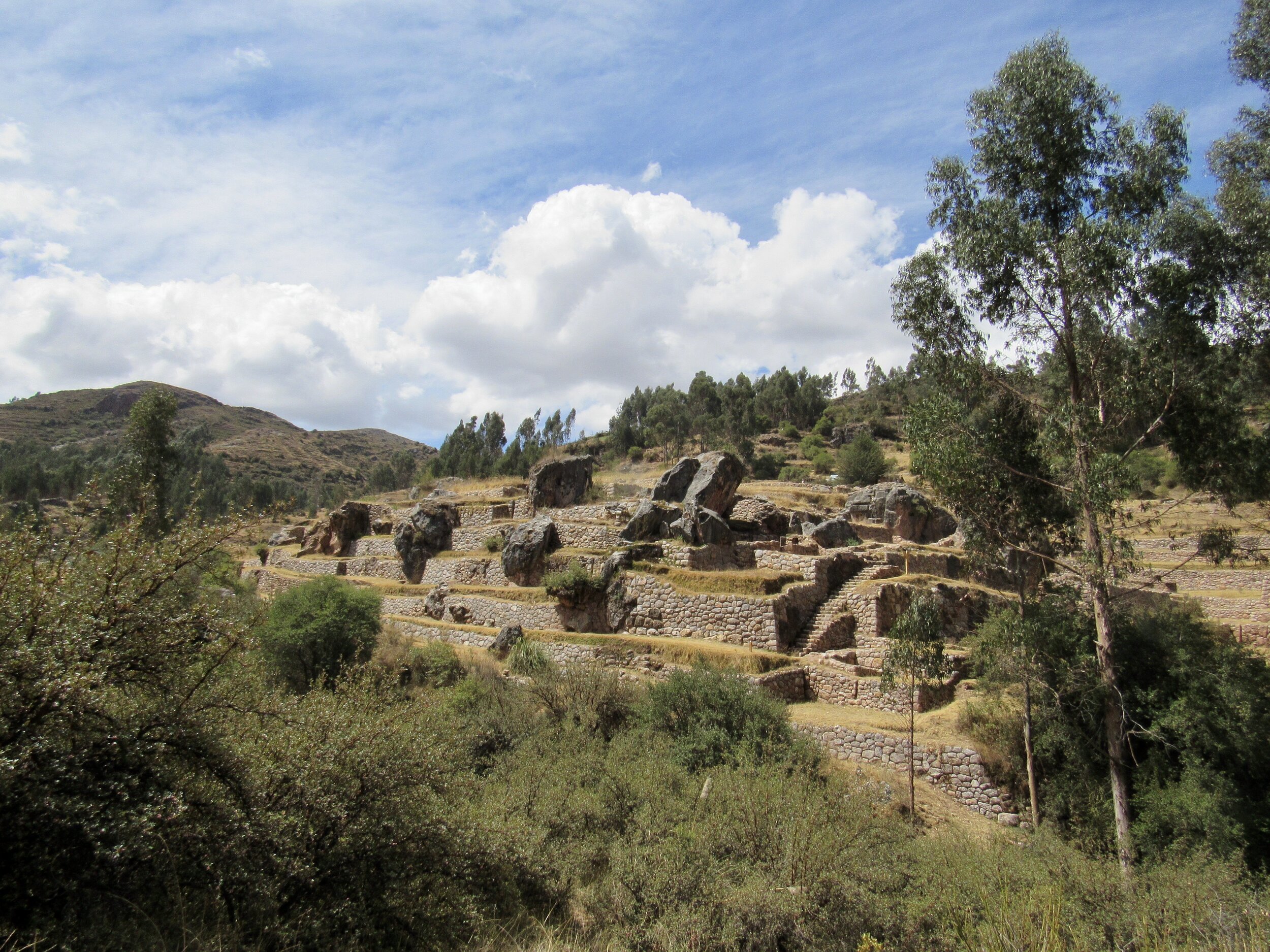
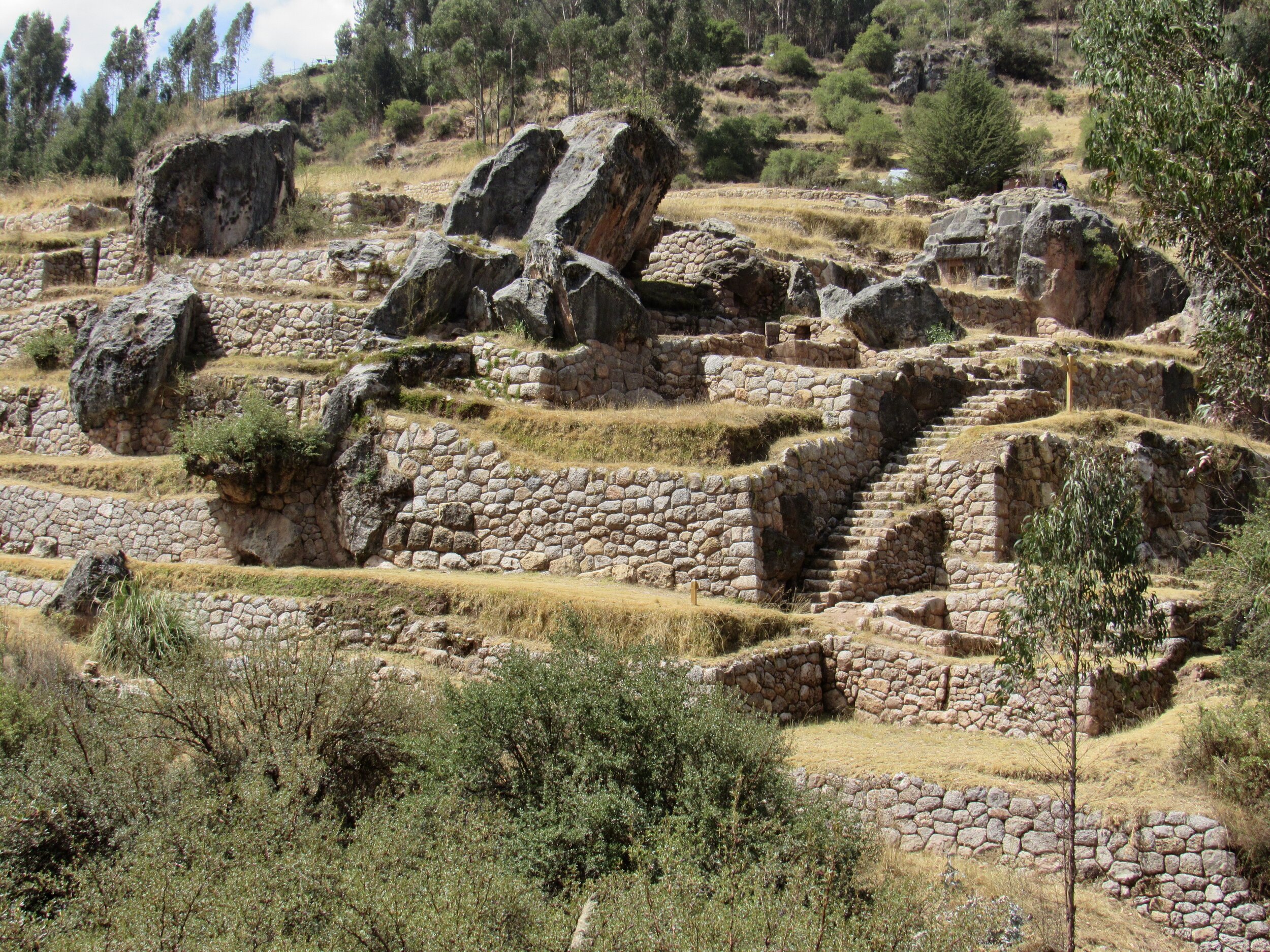
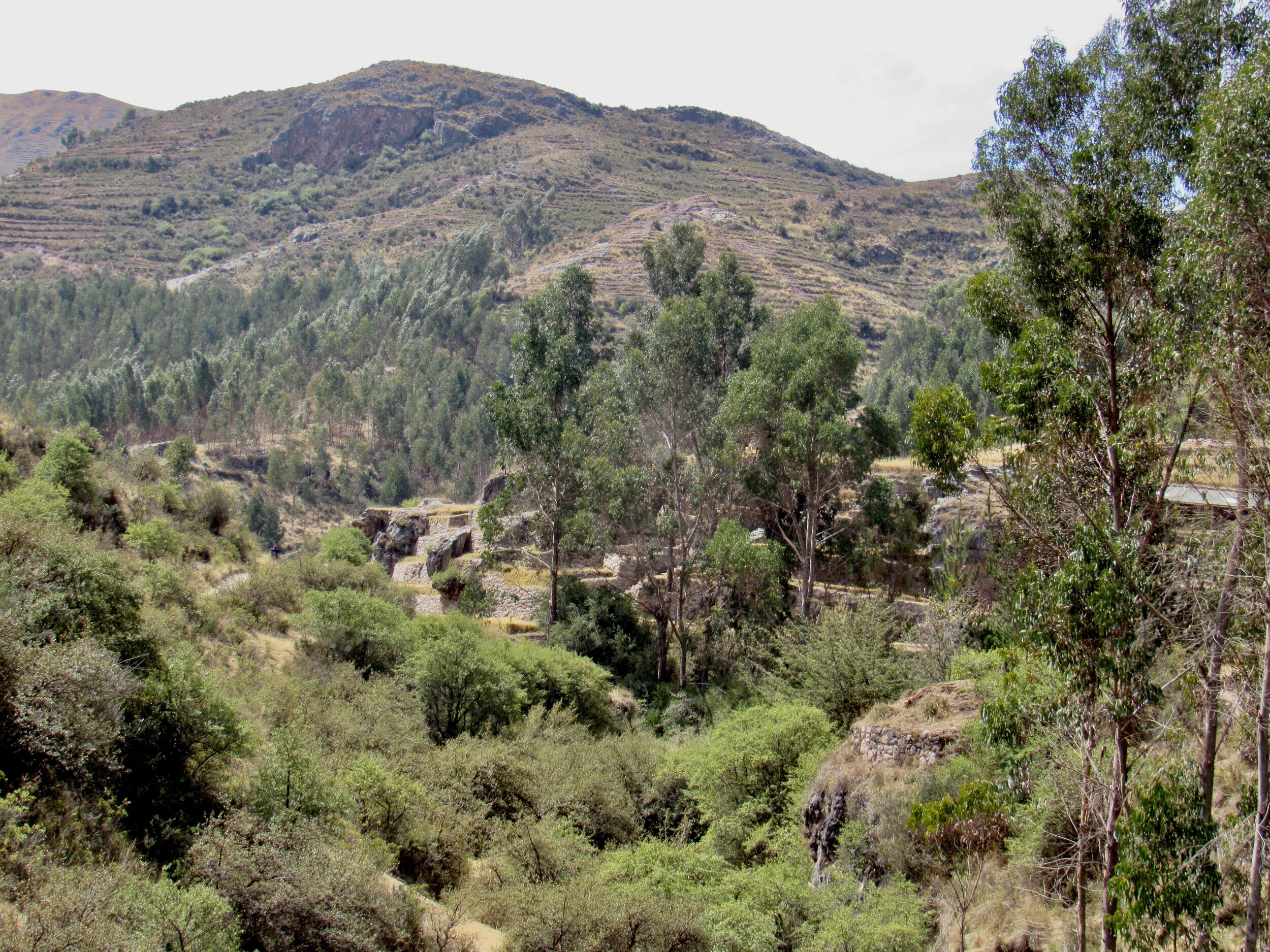

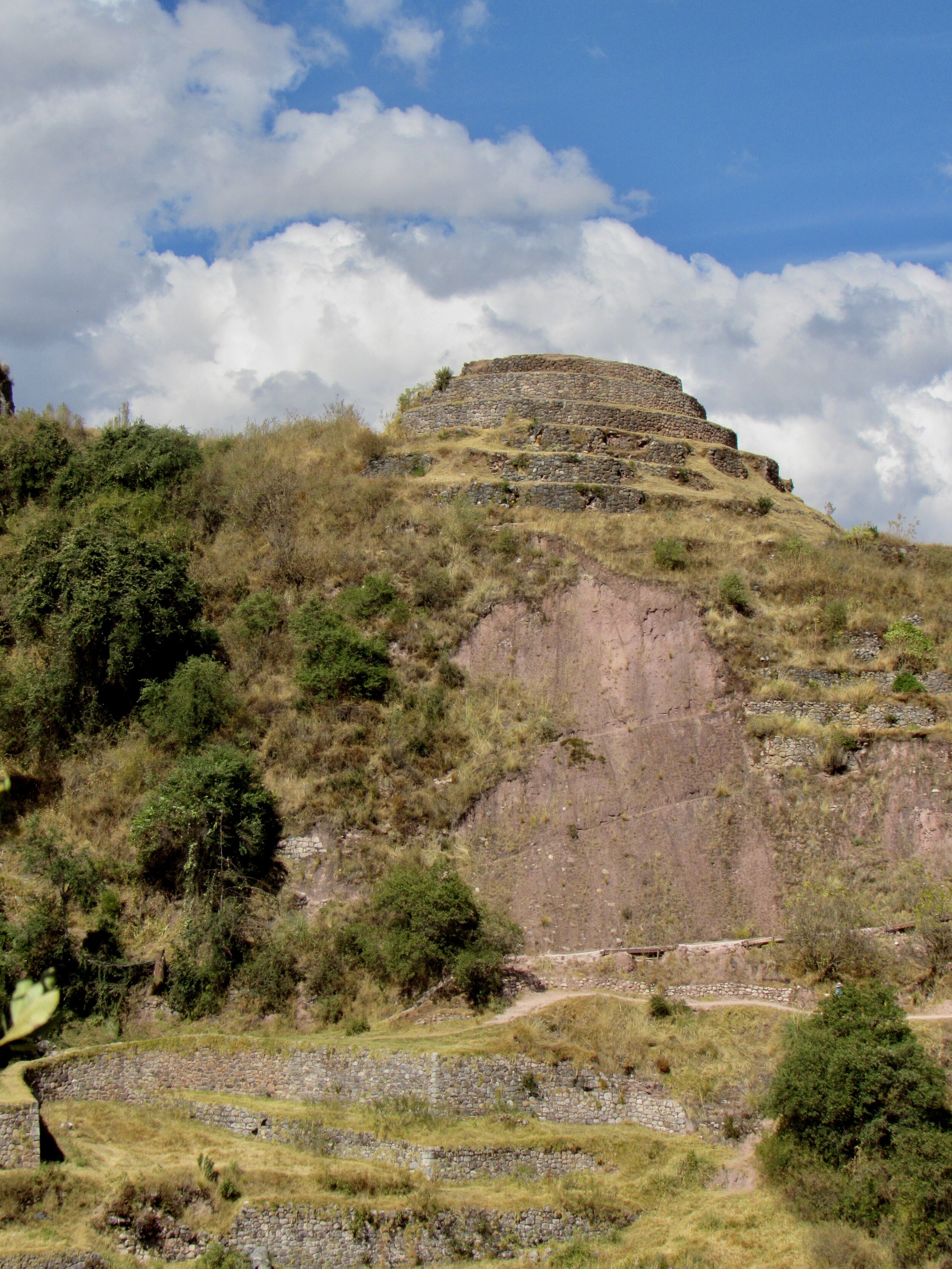
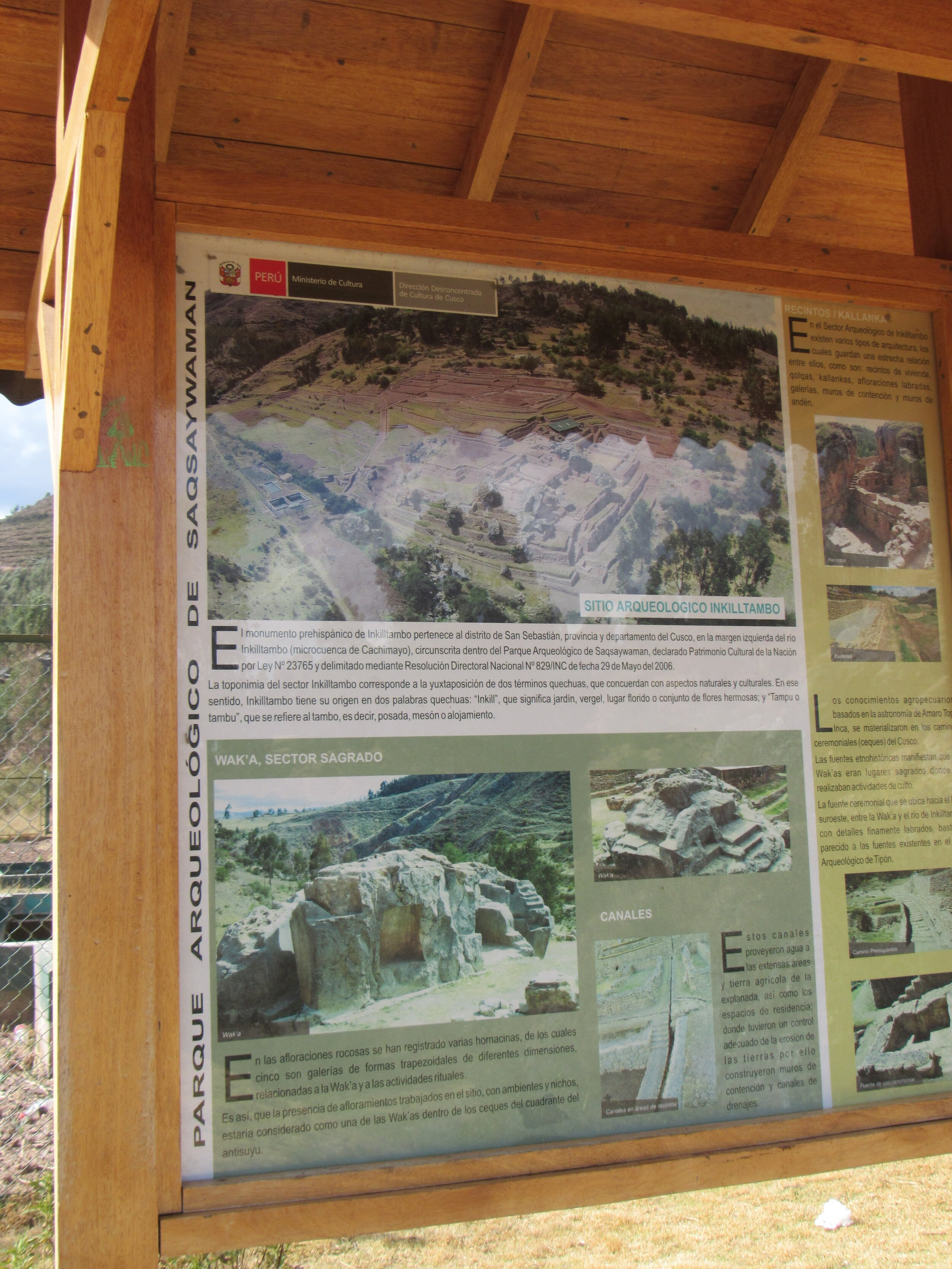
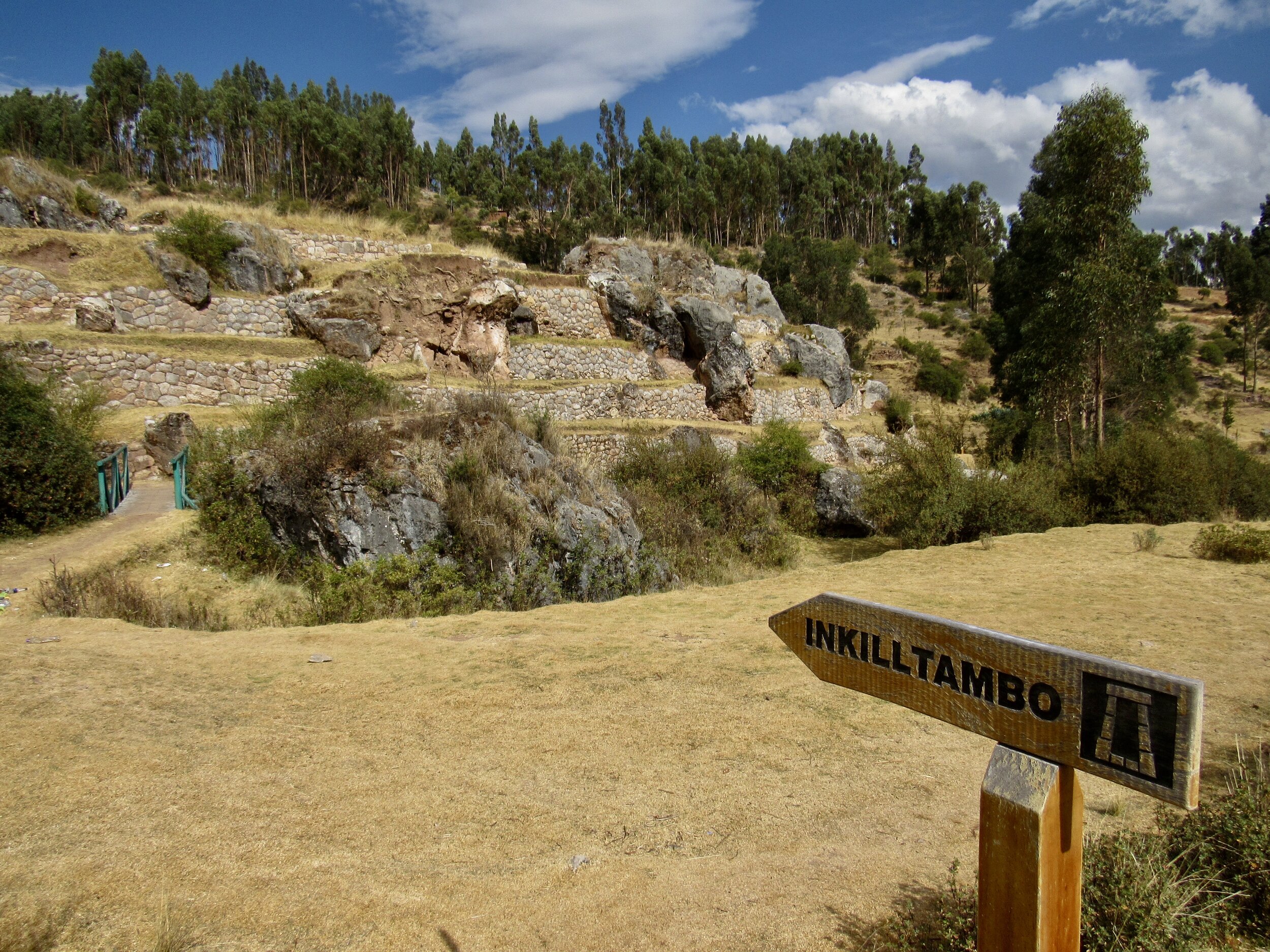
Saturday, 15 August, 2020
I went with a group of four friends to hike to Inkilltambo and have a picnic today. I have learned to greatly appreciate being able to do anything that reminds me of normal life. Of course, we were wearing masks when we were around other people, but when it was just us on the trail, we got to take them off and breathe normally. There was some uphill on today's hike and it makes such a big difference when I can take off my mask to hike uphill. Today we hiked about 10km/6.3 miles and according to my phone, climbed the equivalent of 86 floors of stairs - at 3,400m/11,200ft above sea level.
We started at my house, which is very close to the trail up to the Temple of the Moon. Past the Temple of the Moon, there is a sign for Inkilltambo, pointing down the valley that parallels the valley Cusco is in. I’ve hiked by it many times, but since I’m usually just trying to be out in the mountains, I've never stopped to explore the place. I know that sounds ridiculous, but there really are so many Inca ruins all around and throughout Cusco that you just can’t spend time at all of them.
Inkilltambo is actually pre-Inca. The name comes from the Quechua word inkil, which means garden or small field. Tambo is a resting place, a place where the inhabitants would take in travelers. Most of it is terraces for farming, but there are also several areas that obviously were collections of homes. Though it is a protected archeological area, some of it is still being used for agricultural purposes. We saw more than one herd of sheep, plus several cows and goats grazing on the terraces. If it had been llama or alpaca I could have more easily imagined the place as it was when people really lived there.
Like many places around Cusco, anything pre-Inca became Inca. The place looks like it was a small community, perhaps just a few families. Inkilltambo has the usual division of three areas: terraces for farming, religious buildings and an area with homes and workshops. The religious area includes several wacas, which are ceremonial buildings. There are aqueducts linking the terraces to several water sources. There are two large kilns near Inkilltambo, which were used for firing ceramics. A lot of restoration work has been done on the kilns, so they probably look like they did 500 years ago.
The whole area has actually gotten a lot of recent restoration work and new signs. Although very separate, it is strangely included as part of the Sacsayhuaman archeological site. We walked around the ruins a bit, then walked downstream to a spot that Sonia has been wanting to have a picnic. The five of us sat by the water, passing around tortilla chips, guacamole, fresh salsa, uchucuta sauce, tiny purple potatoes, homemade bread, cheese, wine and chocolate. It was the best picnic I’ve had in a very, very long time. Sitting by the stream, sharing food, we had totally escaped the reality of pandemic life.
COVID in Cusco: Week 21
Peru is heading back into quarantine: restrictions are coming back in response to a significant increase in new cases of Covid.
Sunday, 2 August, 2020
142 days since Covid arrived in Cusco
It was quiet this morning. For the first morning in fifteen straight days, the construction workers were not a few yards from my windows, cutting rebar, mixing cement and blasting their radio.
We are back in quarantine, with another all day Sunday curfew. Nobody leaves the house today, except for emergency medical care. No pharmacies are open, no grocery stores, only hospitals and clinics and even then for emergencies only.
Starting March 22nd, Sundays were a complete shutdown through the end of June. That was 15 weeks in a row when nobody went outside on a Sunday. Then, in July, we were allowed out on Sunday not only to buy food, but we also had the freedom to go for a walk, without a destination. The military vanished from my neighborhood at the end of June and I wasn’t afraid that I’d get arrested if I didn’t have a good story about being on my way to a pharmacy for something “necessary.” I even went camping a couple times in July.
Today, we’re back in quarantine and back to a total Sunday shutdown. To be honest, I don’t mind. I had gotten used to quiet Sundays. During the first 15 weeks of real quarantine, I gradually adapted to staying home most of the time, only leaving the house once per week to buy food and going up on the roof when I needed sun and fresh air.
Plus, the four story apartment building going up about three yards from my bedroom and living room is so obnoxiously loud. With the all day Sunday curfew back, nobody can come to work on the construction site right outside my windows. Not only is it quiet in my bedroom, I can again hang out on the roof in the sun, without construction workers staring at me.
I wonder if anybody else in Cusco is as happy as I am to have the Sunday curfew back.
Monday, 3 August, 2020
Today I got a new student! My housemate Kerry has decided to see how well my teaching will work for her. Of the three women from England who hire me for Spanish classes, Kerry and Hannah are at about the same level, but Sonia is much more advanced. It seems like an odd coincidence that all of my Spanish students are from the UK. There are so many more people from the US in Cusco, than from the UK. My only other two students are David, from Mexico, who is learning French and José, from Cusco, who is learning English.
I should invest some time in getting more students, but I already feel so busy every day that it’s easy to keep prioritizing something else. This might be a classic case of procrastination. How many other unemployed or underemployed people around the world are using the pandemic as an excuse to procrastinate job hunting? I know that I can’t be the only one.
Tonight is the full moon and I plan to go up to the Temple of the Moon to get some photos. It seems like this would be the most obvious thing to do, but honestly I have never gone up to the Temple of the Moon for the full moon. Partly this is because it was the rainy season when I first moved to this apartment, which is almost directly on the trail up to the temple. Partly this is because we’ve had a curfew since March 15th and going up there at night by myself is not only a bad idea, it could have gotten me arrested if I had come home after curfew.
Curfew now is 8pm and since the sun sets now before 6pm, so it really shouldn’t be that hard to get some photos and get home before curfew. Still, I haven’t seen the military come back to the streets and somehow arrest doesn’t seem as sure of a consequence of breaking curfew as it did in April and May. I actually was scared of getting arrested and thought that if I wasn’t always on an obvious trip to the pharmacy or to buy food that I would get arrested. Considering the anecdotes I heard and the constant stories on the news of how many people were arrested for breaking curfew, I think I was right to be scared.
Now though, I don’t worry about getting arrested. Not only have the military vanished from my neighborhood, I see the police so much less. The heavy police presence is gone, although in busy areas of town there are still quite a few police around. They are very obviously more relaxed now. Before they were all just as obviously on edge.
It is such a huge relief to not worry about getting arrested every time I leave the house. (The parallel here with what Black American experience in their daily lives is not lost on me, even though there are no Black Lives Matter protests in Cusco.)
Tuesday, 4 August, 2020
Since I stopped working online, at the end of June, I have drastically cut down my news intake. This has had a very positive effect on my mood and general outlook on life. However, I did wallow in the news a bit today, stunned by not only the explosions in Beirut, but also by the political disaster in the US that just keeps getting worse.
I am registered to vote online, as an overseas voter from Washington State. I will vote this November but I don’t have any money to donate towards political campaigns. Besides voting, there’s not much else I can do from Peru. I can’t go knock on doors. I can’t distribute yard signs.
The news is so relentlessly negative, but there is a little positive effect I have gotten from looking at the news the past several months. I always pat myself on the back for being here, for staying in Cusco. I do feel safer here from Covid than I think I would if I had stayed in Seattle. I also am glad to not be in the US during this election cycle. It’s stressful enough to watch from a different continent. I would be so much more stressed if I were in the US now.
This afternoon my only class was teaching English to José, since Sonia and David had planned to take this week off and go to Urubamba. The return of quarantine and travel restrictions killed their vacation to Urubamba, but they still decided to take a few days off their usual routine.
This evening Kerry and I got in a texting spat with our landlord, Mariela. She was complaining to us about how much electricity we have been using. Electricity is included in our rent, so we never see the bill or have any idea how much she pays or even know when the bill goes up or down. Mariela lives in Lima, so even without the quarantine keeping people at home, she would never actually come to the house to talk with us in person.
Mariela told us that the two of us are using as much electricity as six people. If that were true, I would expect her to send us photos of the bill. She never shows us the bills, which makes me a little suspicious about Kerry and I using such an extravagant amount of electricity. She also told us not to use our electric heaters, which seems odd. This is winter in the southern hemisphere and we live at over 11,000 feet of elevation. It is cold here. We are going to be using our heaters and I think that should be expected, at this time of year.
Wednesday, 5 August, 2020
Weeks 5-10 of quarantine I was having a lot of trouble with the pendulum of going back and forth between anxiety and apathy. Rollercoaster, yo-yo, see-saw, pick your favorite metaphor. It was hard, but back then this seemed like more of a short term problem. In March and April I thought that even if tourists don’t come back in June or July, surely August and September will be more normal. Surely we will have tourists in August and Machu Picchu will be open again. Surely there will be international flights landing in September, if not August.
Now I have accepted that this pandemic will be here much longer. There is no end in sight. We will not have tourists in August. Machu Picchu is not open, despite a promised opening date of July 1st. The Lares hot springs will not open again in 2020, if the townspeople of Lares have anything to say about it. So far, they are keeping tourists out of Lares just as well as the people of Aguas Calientes are keeping Machu Picchu closed.
Personally, I don’t see how the government can possibly open Machu Picchu before they build a clinic in Aguas Calientes. The place is too small to build a real hospital, but to open such an isolated place to international, or even national, tourism, is criminal. There are no roads to Aguas Calientes. Everything goes in and out by train. There are no ambulances in Aguas Calientes. Anybody who can’t be evacuated on the train has to go out in a helicopter. It is not a place that should be welcoming any tourists, national or international, during a global pandemic.
All of this general anxiety about the pandemic, unemployment, living off my savings and my ability or inability to buy my regular medications in Cusco has magnified all other things that can provoke anxiety. My biggest struggle right now is anxiety about the Covid Relief Project.
Anxiety brings catastrophizing: my worst nightmare is that we will accidentally take the virus from Cusco to one of these isolated villages and somebody will die.
All five of the rural communities to which we have taken food so far have been completely free of Covid. There haven’t even been any cases in the area. (If you have been reading all of these blogs and already know all about these villages, bear with me.) Also, none of these five communities have had access to a hospital, clinic or pharmacy. Many of the families in these communities don’t have any running water in their homes. A couple of the places we went didn’t even have a single well in the village: everybody used the same glacial stream for washing, drinking and cooking water.
If/when the virus gets to one of these communities, the effects will be devastating. They don’t have running water to wash their hands. They don’t have any way to get tested.
Are the precautions that we’re taking enough? Every time we go to a village, at some point they want to share food with us. It’s heartwarming and humanizing and such a genuine connection to share food with people. Whether they have boiled potatoes or boiled corn or something else, whatever they have to share, they are giving to us out of kindness, hospitality and gratitude. I don’t want to shut that down. However, it’s the only time we take our masks off.
We have nothing to fear from them. I am not worried about using their utensils or bowls or eating the food they give us. They should be worried about taking back anything that we have touched. Is it overkill to take with us a plastic tub and some bleach, to clean anything we touch before we give it back to them?
Is wearing masks enough? We are always outside, which is very reassuring to me. Still, how do we know that being outside and wearing masks is enough? I had Auqui buy gloves for our team for last Saturday, in Chahuay. Before Chahuay, we just used alcohol gel. Now we have masks, alcohol gel and gloves and we’re outside. We’re asking the villagers to wear masks, but we are not turning them away if they don’t have one. Could I actually refuse to give food to somebody who came to receive a donation without a mask?
How can I be sure? How can any of us be sure? Do I require everybody who is going with me to isolate completely for a week before we go? Can I isolate completely a week before we go to the next village, on August 22nd?
My mind keeps going back to my nightmare scenario: what if we take the virus with us and somebody dies? Is food worth causing an outbreak in a village with no access to any medical care?
People in the countryside in Peru will not starve to death. In their worst case scenario, they will eat boiled potatoes and boiled corn for the next eight to ten months - assuming that tourism will resume in 2021. They will not die of hunger. They will have to go without a lot of things: new clothes, more variety in their diets, electricity (if their village has electricity to begin with). But as long as nobody takes Covid to their village, they won’t be another statistic in a global pandemic.
Thursday, 6 August, 2020
I feel a lot better today. Yesterday my brain went down the rabbit hole of catastrophizing and it definitely sent me into a tailspin. Today I went back and read Nicholas Kristof’s article in the New York Times “This has been the best year ever.” He writes something similar every year and Mom always sends it to me. The 2019 article was published on December 28, 2019, but it’s the sort of thing I can always go back to for comfort. It’s like randomly opening Antoine de Saint-Exupéry’s “The Little Prince” to any page. There’s always something comforting to read again.
Every year, the gist of the article is that global poverty is going down, literacy rates are going up, famines are less common and less likely, fewer children die of malnutrition and disease, et cétera. I am not going to let myself imagine what he could possibly write about 2020, but I did go back to the 2019 article to find this quote:
“I worry that deep pessimism about the state of the world is paralyzing rather than empowering; excessive pessimism can leave people feeling not just hopeless but also helpless.”
That's what I’m really fighting against. Catastrophizing leaves me deeply pessimistic, which leaves me feeling both hopeless and helpless.
Nobody will starve to death if the Covid Relief Project doesn’t bring them food. However, what we’re doing does help. We’re bringing some variety to people’s diets and it’s bringing them some hope. So many have told us that they feel forgotten, high up in the mountains. The psychological effect of isolation is not only for those in a studio apartment in Tokyo or New York. Even villages that have had to completely isolate from larger towns are feeling the emotional toll. We are such social creatures. Isolation, however necessary, is so hard on us. The food we take to these communities is much appreciated, but so is the excuse for the community to come together. They thank us for the food, but also for coming to them, for bringing contact with the outside world.
They’re the ones running the risk of exposure to the virus when we come from Cusco. Is it patronizing for me to worry so much about their risk? They are all perfectly capable of weighing the risk and choosing whether or not to come to meet us. We give the donations to any representative of the family on the list. They can choose anybody they feel comfortable sending to meet the group from Cusco. This is not all on me.
Tonight I got an email from the US Embassy in Ankara, telling me to reconsider travel to Turkey. I got on a STEP list from the embassy when I lived in Istanbul a few years ago. Apparently I neglected to get off the list when I left Istanbul. Today the email says “Exercise increased caution when traveling to Turkey due to terrorism and arbitrary detentions.”
Again, my pessimism is checked. Yes, Peru is dealing with Covid outbreaks. However, terrorism and arbitrary detentions are not something I have to worry about. I really do feel safe here.
Friday, 7 August, 2020
This morning was my usual 10:30 yoga class up at the Temple of the Moon. We practice in a grove of giant eucalyptus trees, near the Monkey Temple, which you pass on the way to the Temple of the Moon. The Monkey Temple is very pre-Inca and there is little left. It’s mostly a pile of massive stones, rubble with carvings on them.
After yoga, I talked with Sonia, who teaches the class and her boyfriend David. They would be a fun addition to the Covid Relief Project donation day on August 22nd. Sonia has offered to teach a yoga class as a fundraiser with all donations going to buying food on the 22nd. She is also spreading the word about our virtual Inca Trail trek, which is currently the only way to do the Inca Trail.
The trail was closed on January 23rd due to a landslide, which killed two porters. It was supposed to reopen, after a lot of maintenance, on March 15th. Unfortunately, that’s the day quarantine began and not only were all archeological sites closed, so were all airports in Peru. The only people who have done the Inca Trail in 2020 are those who braved the rains of January. In theory they might open the trail again later this year. However, with us going back into some kind of quarantine/lockdown on Monday, I have my doubts that it will reopen at all this year.
If you are interested in hiking the virtual Inca Trail with us, all proceeds will go to the Covid Relief Project! https://www.myvirtualmission.com/missions/56777/the-inca-trail-for-the-covid-relief-project-cusco
Saturday, 8 August, 2020
The construction outside my windows has progressed to now being on the same level as my bedroom and living room. It is so bizarre to see construction workers only three yards from my windows, up at the height of what used to be the roof of the shed that is being replaced by a four story apartment building. This is even more motivation for me to look for a new apartment.
Yesterday I invited Sonia and David over for a bbq today. The first two times I used my DIY grill it took almost three hours to get the coals really hot, so I started the fire today at around 11am. I spent the morning baking an apple pie, my first in weeks. I was stress-baking a lot in March, April and May. Then Cusco hit a butter shortage, then a flour shortage, and I stopped baking. Supply chains are working better now, so I made the pie and got it in the oven before I started the fire this morning.
Since I made the grill, I have been collecting sticks every time I go up to the Temple of the Moon. August tends to be the windiest month, so there are a lot of sticks to pick up under the eucalyptus trees where we practice yoga. I can buy charcoal at the San Blas market for less than a dollar per kilo, but it is not the self-lighting briquettes that you can buy in the US. It is large chunks of wood charcoal that take a long time to get hot. By a long time I mean two to three hours.
My bbq grill is made from random stuff I found on my roof: three cinder blocks, a brick, two broken tiles, a piece of corrugated metal and some rocks. I piled the charcoal on the rocks, with the leftover charcoal from the last bbq a couple weeks ago, and started piling the eucalyptus stick on top. After about an hour of keeping the fire going, I let it die down, with plenty of hot ashes covering the charcoal.
The construction workers are obnoxiously loud, cutting rebar and mixing cement. Still, once you get used to it you can block it out somewhat. Sonia and David arrived with more to add to my pile of food to grill and David also brought an amazing guacamole, made with his family recipe. It is nice to have these little social moments, when we can do something as normal as a Saturday afternoon bbq and all try to forget the global pandemic killing thousands in our home countries: the US, Mexico and the UK.
We sat in the sun on the roof, eating chips and guacamole, drinking beer and watching the food cook on the grill. I need these moments of carefully engineered normalcy. Even if we go back into a more restrictive quarantine/lockdown on Monday, it’s these bits of time with friends that help me believe that life will go back to normal, eventually.
Covid in Cusco: Week 20
The fifth donation day of the Covid Relief Project is a great success and the Peruvian government announces the return of some of the quarantine restrictions of April and May.
Sunday, 26 July, 2020
Today I was woken up by the sound of construction out my window. The past few weeks, the obnoxiously loud construction out my windows has woken me up every morning and distracted me from just about everything all day long. Sunday was the only day they didn’t work. Even all day Saturday was fair game. I woke up this morning with the realization that I have lost my one day of peace and quiet.
I have to get out of this apartment. This will be a four story building, which means that soon it will not only be the sounds of cutting rebar and mixing cement right outside my windows. It will be construction workers up at the level of my second story bedroom and living room - then looking down into my bedroom and living room. I’ve started keeping the curtains closed all day, which makes my room so dreary.
Also, the noise from the construction has driven away the birds I used to watch outside my windows. No more Sparkling Violetear hummingbirds, blue and yellow Tanagers, Black-Throated Flower Piercers, Crowned Chat-Tyrants or Golden Billed Saltators. Bird watching got me through the first ten weeks of quarantine, back when I really couldn’t leave the house. Back when police and military were allowed to arrest anybody who wasn’t leaving the house for food or medicine. Back when only pharmacies, grocery stores and markets were open. Back when I could be arrested for hiking up to the Temple of the Moon.
It’s much easier to leave the house for a hike now and even possible to leave Cusco to go for a hike in the Sacred Valley. Still, I don’t have a job to go to every day and as cases of Covid rise in Cusco, I want to spend as much time at home as possible.
This Saturday I am going with the rest of the Covid Relief Project team to the rural community of Chahuay. This is our fifth day taking food to families in need and every time I get increasingly nervous about the risk of taking the virus with us from Cusco. None of the communities we have visited have had any access to a hospital, clinic or pharmacy. We absolutely cannot expose any of these people to the virus. Our efforts to help cannot cause harm.
Monday, 27 July, 2020
Today I went to meet Yesi, the accountant from the trekking agency I used to work for. She helped me though all of the paperwork to get my permanent resident card and work visa and has been unfailingly helpful since I started work there last September. Since she called me at the end of June, to tell me that my last day of work would be June 30th, I have been waiting to hear if the company is actually totally bankrupt or if they just have to stop paying everybody for a while.
I had been the last employee left, working half time in April, May and June. Then, not working at all in July. After talking with Yesi, I called the boss, Saul. He reassured me that he would be able to hire me back part time in September. I learned to live on half of my usual salary April through June, so even at part time, I can get by financially. However, he always sounds so optimistic when I talk to him that I really don’t trust him. He reassured me all through March and April that August would be completely back to normal. Does he really believe any of this or is he just trying to be optimistic to placate me?
Yesi had both good and bad news for me in terms of my health insurance. Since I’m still technically on contract, even if I’m not being paid at all, she still has to pay for my health insurance. Having health insurance during a global pandemic is a very, very good thing. The bad news is that the hospital won’t see anybody if they don’t have Covid. Last week she took her father-in-law to the hospital for a suspected heart attack. They made him stay in the taxi while they took a drop of blood from his finger and came back with the news that he doesn’t have Covid and won’t be admitted. They actually told her to buy some aspirin and take him home.
Like the Kasier system in Seattle, health insurance here is linked to a specific hospital. There is the public hospital for all of those too poor to have health insurance. Then there is the hospital for people with insurance, like me. Then, there are private clinics that charge high prices and only accept some kinds of private health insurance. My health insurance should cover me for all treatment and medication at the associated hospital, except that they won’t let me as long as I don’t have Covid. I can’t get a prescription for my normal meds filled at the hospital pharmacy until I can get a prescription from one of their doctors. It’s another part of the waiting game that the pandemic has put all of us in.
Monday evenings, my friend Hannah usually comes over for her Spanish lesson. However, in an effort to minimize any exposure to Covid, I decided to do the lesson at her place. It’s an odd calculation I have to make. Is it more dangerous for me to go into her home and be exposed to any germs in her space, or is it more dangerous for her to come to my house and breathe in my living room? I opted for going to her place with the idea that I can wash my clothes and myself when I get home more easily than I can wash the couch after she sits on it for an hour. I also insisted that we both wear masks during the lesson.
Tonight I got confused with the KEXP schedule changes and thought I had missed El Sonido. I just kept listening and Chilly came on an hour later than I had expected. One of the changes they are making is that Alvina Cabrera, who has been producing the show, will be co-host starting in a couple months. I love KEXP but it has been bothering me that my favorite DJs, William Meyers, John Richards, Kevin Cole, Darek Mazzone, Kid Hops and Troy Nelson, are all white men. Alvina will bring more diversity to El Sonido and there are a lot of other changes that will bring more diversity to many of KEXP’s shows.
Tuesday, 28 July, 2020
After waking up, working out, showering and having breakfast to the sounds of cutting rebar and mixing cement, I went to check out another apartment. It was by Puente Almudena, on the far side of Mercado San Pedro, which is not the part of town that I’d ideally like to be in. However, it was super cute and I bargained them down to my price range. Like many empty apartments in Cusco, it has been an AirBnb.
With the complete disappearance of all tourism, most AirBnb apartments are now available for rent at normal prices - but with all of the furnishings and amenities of an AirBnb. I have to find a furnished apartment, since I don’t want to bother buying furniture here - especially during a pandemic. I can’t afford new furniture now that I’m unemployed, and I don’t want to buy used furniture that has been in somebody’s home. Who knows how many people have used that furniture in the two weeks before I buy it - and if any of them are carrying the Covid virus?
It just wasn't the right place for me, so I’ll keep looking. When I got home, President Vizcarra was already part way through his presidential address.
Today is the 199th anniversary of Peruvian Independence from Spain. Of course, all parades and parties and events have been cancelled, but we can all watch the president on tv or on YouTube. I watched him on YouTube. The past week or so, there have been lots of rumors that in this address he will give us some information about potential new lockdowns or if we are going back into a real quarantine like we had March, April and May.
He said nothing about new quarantines. He mostly spoke to the congress, telling them about a five point plan for making Peru a better place. It was a long speech but not very useful for those of us who want to know what’s going to happen in terms of work and life. I want to know when hospitals will allow people to make routine appointments and when the borders will open up for international tourists. I appreciate that he has a plan for Peru, but it’s a political plan, not a plan to deal with the pandemic in the next few months.
I cancelled my class with the Cusqueñian guy that I usually teach English to on Tuesdays. Last week he told me that a friend from Arequipa was moving in with him. Arequipa has a much higher rate of Covid cases than Cusco and if I’m trying to be extra careful in anticipation of this Saturday, I really can’t go to his apartment or let him come to mine.
I still went to teach French and Spanish to the couple who have me teach on their upstairs balcony area. I told them ahead of time that I’ll be asking them to wear masks during out lessons this week. The space that I teach in is a partly outdoor rooftop terrace. I’m not in their apartment and there is plenty of fresh air. That seems safe enough to me, even if I’m trying to be extra careful this week.
Wednesday, 29 July, 2020
Kerry found a place for rent that we both went to look at this morning. It was a serious walk up from our current home, which is already up high above the center of town. This place was so high up it was almost out of Cusco, higher even than the San Cristobal church. The place was cute and had a fantastic view, but the kitchen was tiny. With restaurants closed and/or unsafe, a good kitchen is essential during a pandemic.
We walked back down to home and on the way I bought some charcoal at the San Blas market. It’s s/2.50 for a kilo, which was plenty to grill our lunch. This was round two for my DIY bbq that I made for last Saturday’s party. We only had six people over, and they all stayed upstairs, outside on the roof, but it still made me a little nervous since I’m going to Chahuay this Saturday.
I am so thankful that I got to take a little break from fundraising for this Saturday. It’s exhausting to have to continually fundraise. I gave it all I had for the first four villages, but then ran out of steam. This coincided perfectly with somebody in Australia picking up my slack. A couple weeks ago, I met a woman named Kyra at the Friday yoga class. She had seen my posts on Facebook and told her friends back home in Australia about the Covid Relief Project.
One of them, Justine Moorman, who has never even been to Peru, started a fundraiser for us on Facebook. She raised $650 Australian, which became $450 USD when she sent it to our r PayPal account. I could hardly believe it! That’s half of what we needed for this Saturday!
If I hadn’t known that Justine was doing a fundraiser, and if I hadn’t known what the goal was, I would have had to put in a lot more time trying to get donations last week and this week. We usually manage to pull in exactly what we need the night before we actually go to a village, but the whole process is exhausting. It’s especially stressful for me when we’re 24 hours from leaving and still don’t have enough donations to cover the food we need to buy. I’ve started trusting more that the donations will come in, even if they’re late. Still, I am so thankful to Justine for pulling in half of what we need this time. It was a huge weight off my shoulders.
Thursday, 30 July, 2020
This afternoon I had my second round of French & Spanish lessons with masks. It’s really fun to be able to tutor one on one and so much more flexible than with a group. I start out with a plan of what we’ll do during the lesson, but if we head out on a tangent, I don’t have to reign us back in and stick to the plan. We can just follow the tangent wherever it goes, as long as my student/client is happy and learning, we can talk about anything.
Unfortunately, they are going to spend part of next week in the Sacred Valley, so I won’t see them on Tuesday. That actually takes a third of my weekly income away. It’s just another kick in the pants to get me going on looking for more students, either in person or online.
Most of the online English teaching platforms hire native speakers without any teaching experience. From what I’ve heard from other people who teach for these companies, many of them treat their teachers like they’re idiots. With twelve years of teaching experience and a master’s degree in education, I really don’t want to work for any of these companies. I need to do some research and see if I can find one that requires teaching experience, will pay me for it, and will treat me like I know what I’m doing.
Friday, 31 July, 2020
This morning, I walked over to Puente Belén to buy maná. This is the puffed (not popped) sweetcorn that we have taken a couple times when we take food to villages for the Covid Relief Project. Once we bought 40 small bags for s/40, once we bought 3 kilos and small bags to fill ourselves. That only cost s/30 for the maná and s/1 for the bags, and we got 52 bags. Today, I bought 4 kilos and more small bags. I’m hoping to get around 70, so every kid in the village can get something.
Maná is very popular with kids here but small villages don’t have the kind of vacuum puffer that you need to make maná. They obviously have plenty of corn, but they get it boiled or roasted, not puffed. When maná is made they also add some sugar so it’s slightly sweeter than it would be normally.
Back home, I got a message from my friend Steve. I had invited him to join us for the day taking food and school supplies to Chahuay, but he texted me this morning to tell me that his roommate has had a high fever for three days now. Said roommate mentioned it this morning when they were in the kitchen, as if it were no big deal. Steve was also informed that they aren’t going to bother getting tested. Obviously, I had to uninvite Steve. There is no way I can risk taking the virus to Chahuay.
Trying not to worry too much about Steve, I walked up to the Temple of the Moon for the weekly yoga class with Sonia. I asked if she or her boyfriend David would be interested in joining the Covid Relief Project tomorrow, but they’re leaving town to go spend a few days in the Sacred Valley.
Kerry had to stay home to get some work done, and nobody else showed up, so I got my own private yoga class for s/10, which is less than $3. Considering how little I make these days, s/10 is real money for me, although I know that some day I’ll miss my $3 yoga classes. When I moved to Seattle after living in Bangladesh, what I missed most was my masseuse. She came to my house once per week and gave me an hour and a half full body massage for about $12 - and people told me that I was over paying! There are certainly some advantages to living in developing countries.
Back home, after yoga, I checked the health app on my phone. I’ve already walked 7k/4.3 miles today and climbed 43 floors. That’s basically what I was doing in February and March last year, as I was trying to train for hiking the Inca Trail at the end of March. Of course, I was doing that at sea level, in Seattle. Today I did that at about 11,000 feet / 3,400 meter above sea level.
Another thing I really love about Cusco is that living at this altitude makes me feel so healthy. Any little walk I take is a much more athletic endeavor than it would be in Seattle. Even though I’ve been here almost a year, and my body has totally acclimated to the altitude, I’m still at 11,000 feet and my body is still working harder to function with less oxygen.
After hiking the Inca Trail last year, with 20 high school kids, I was only home for a few weeks before I started to plan my move to Cusco. I moved here the first week of August, 2019, only about four months after I got back to Seattle from the Inca Trail trip. It seemed like a sudden move to some people, but when I told my mom that I wanted to move to Cusco, she wasn’t surprised. She remembered me telling her in 2013 that I wanted to move here, right after my first trip to Peru, when I got to spend some time in Cusco. It just took me six years to do it.
The pros and cons of taking a sabbatical from teaching have completely changed with the pandemic. Covid-19 has put everything in a different light and although being unemployed now is terrible timing, it might be worth it to have skipped trying to teach online last March, April and May. I think it’s also worth it to not have to deal with the stress of strikes. It really doesn’t look to me like schools are actually doing enough to make opening safe this September. Teachers’ unions are threatening strikes and I don’t blame them. I certainly wouldn’t want to go into an enclosed space with a number of children from different families.
Each of those families likely has at least one adult who works outside the home, maybe in a factory or office, both known Covid contagion risks. Most of those families have more than one kid, so those kids would each be exposed to every other kid in their classrooms. That web is too big. That is not a safe pod. Schools have to implement massive changes to make them safe. I am so glad that I’m not facing the choice of going to work in an unsafe environment or going on strike, or quitting my job. It just all sounds too stressful.
Also stressful, this afternoon, the regional government of Cusco declared that we are going back to some of the quarantine restrictions. Effective tomorrow our curfew goes from 10pm back down to 8pm. Since these restrictions come and go without any warning, everybody is nervous that this is just the beginning of taking us back to the draconian restrictions of April and May.
Now I’m worried about if we will be able to get to Chahuay tomorrow - and if we will be able to get home in the evening. When travel restrictions were strict, we had trouble trying to get back into Cusco after taking food to rural areas outside of Yaurisque on May 16th and the communities of Sut’uc-Pacchaq outside of Urubamba on June 6th. On May 16th the mayor of Yaurisque drove Henry and I home in his truck, and got through the checkpoint back into Cusco with all of his documentation, some arguing and a strong warning to not transport more than one passenger in a vehicle. The police themselves drove Auqui and I back to Cusco on June 6th, but still got hassled at the checkpoint trying to get back into Cusco.
If we are heading towards increasing restrictions, everybody will be on edge and transportation to Chahuay will be complicated for us tomorrow. The community sent a truck tonight, after the new quarantine restrictions were announced. Auqui, Henry and I went to Wagner’s to help load all of the food. We bought for 90 families this time, since the community leaders of Chahuay told us that there were 90 families who really need help more than the others.
For each family, we bought 5 kg rice, 3kg sugar, 2 small bags of oatmeal, 1 package of soda crackers and 1 liter of vegetable oil. At Wagner’s they helped us find which products they could get the best price on. They also donated about 40 cartons of fruit juice, completely free for the families. Unfortunately, they didn’t have 90, but any help is welcome.
After we saw the truck off, we walked over to the police station to ask if we would need special police permission for tomorrow - like we did in May and June. They assured us that tomorrow there wouldn’t be the same restrictions tomorrow as during the first part of the quarantine and that we wouldn’t have any trouble leaving Cusco - or coming home in the evening. Fingers crossed!
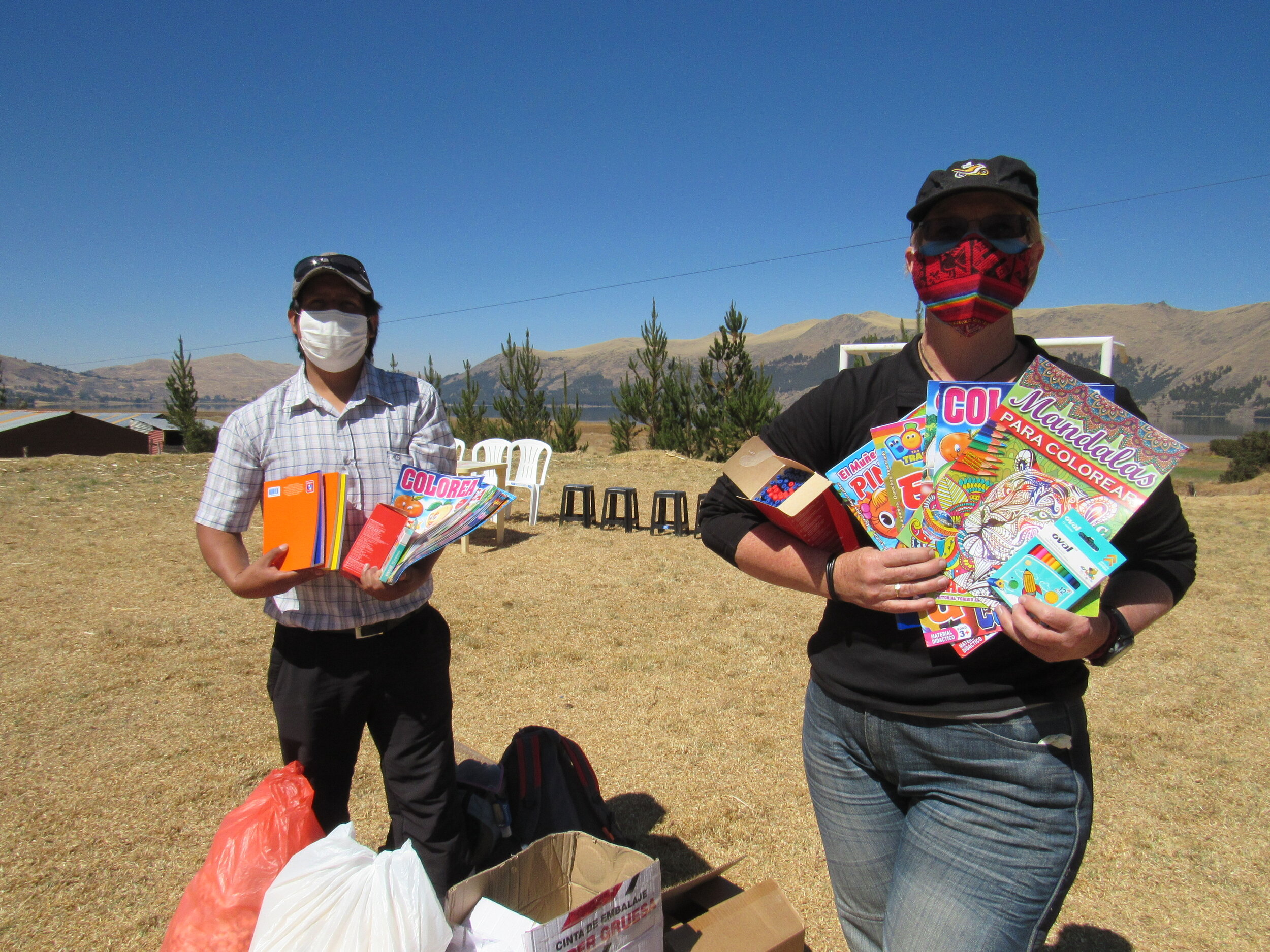
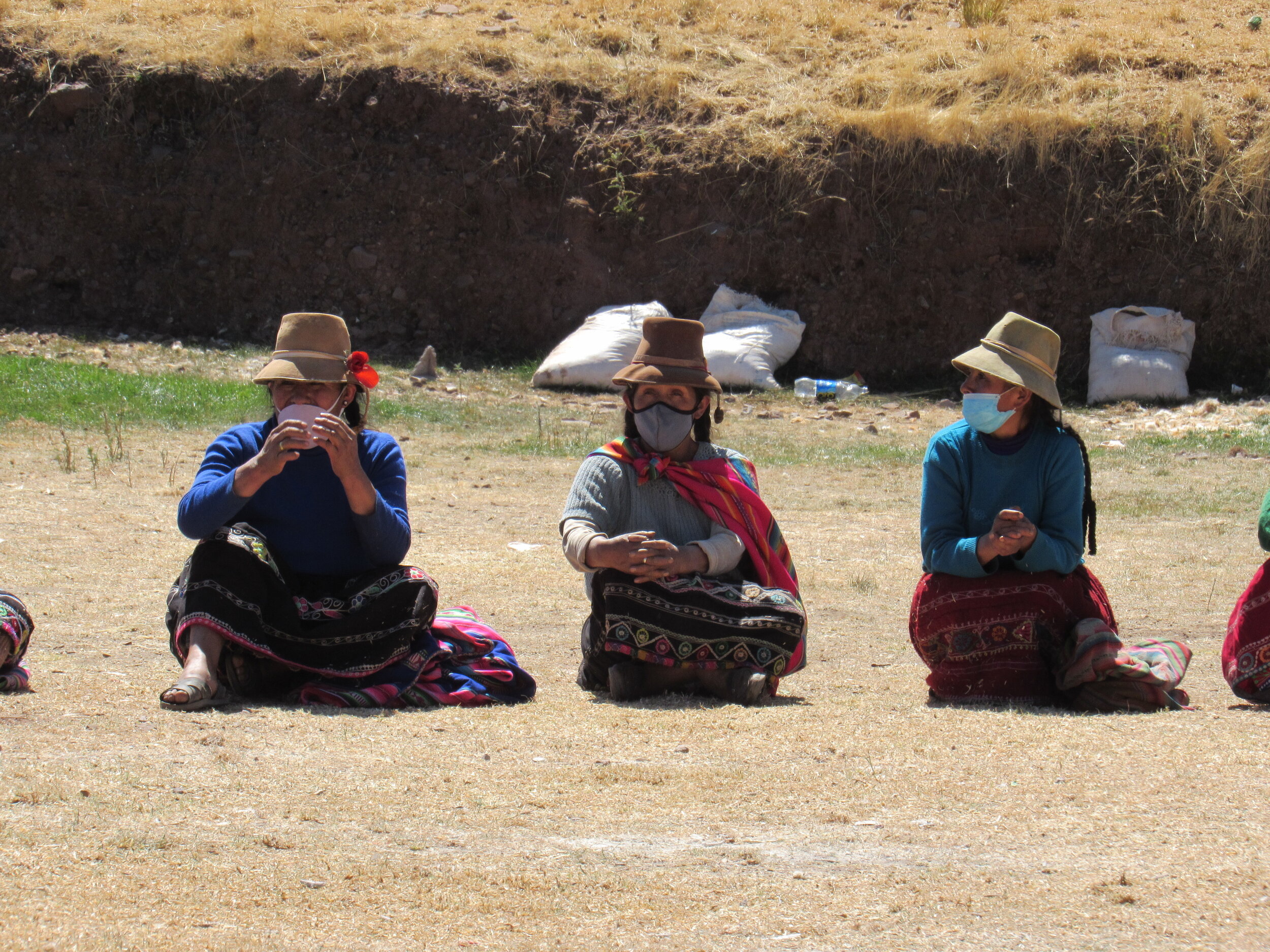
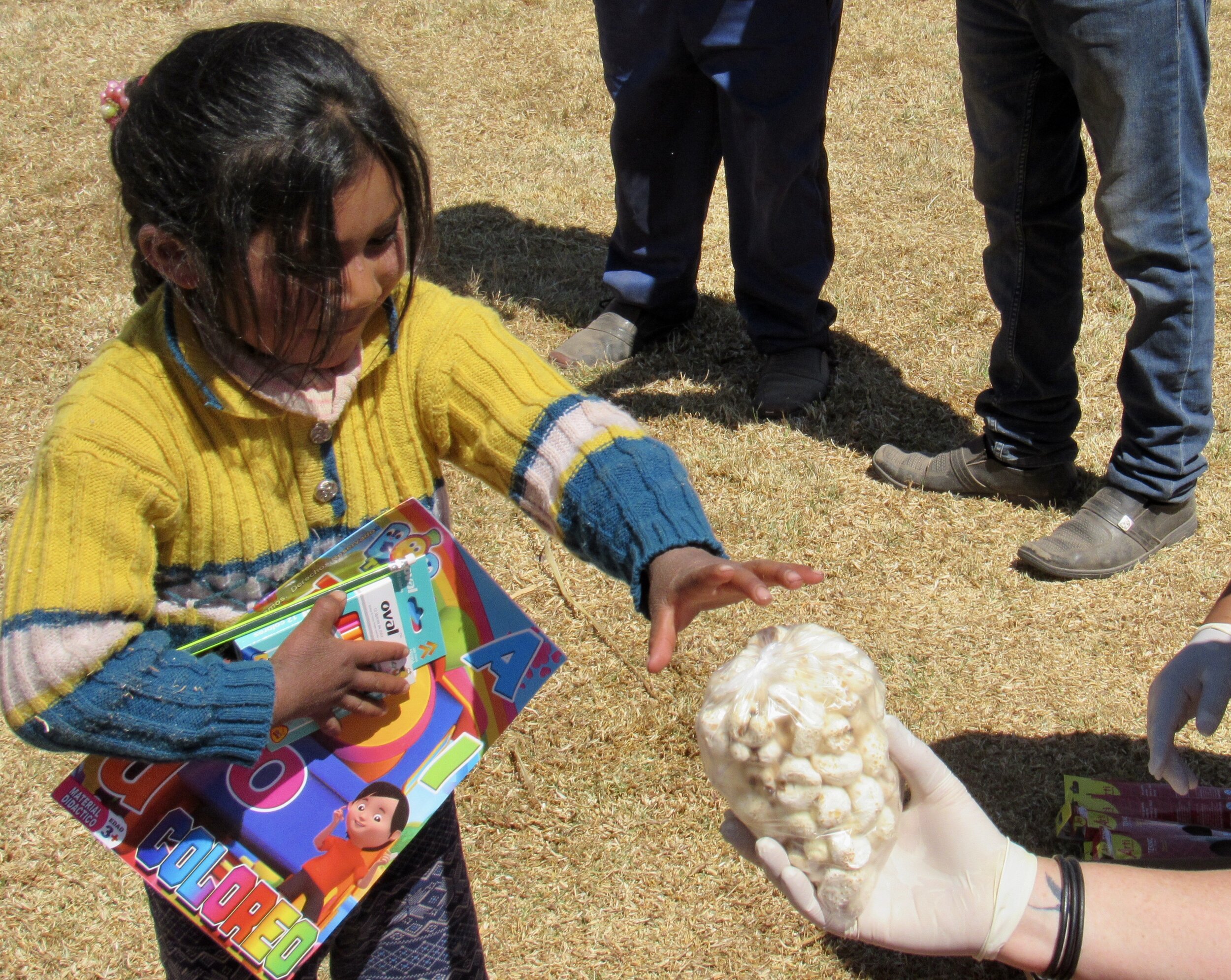

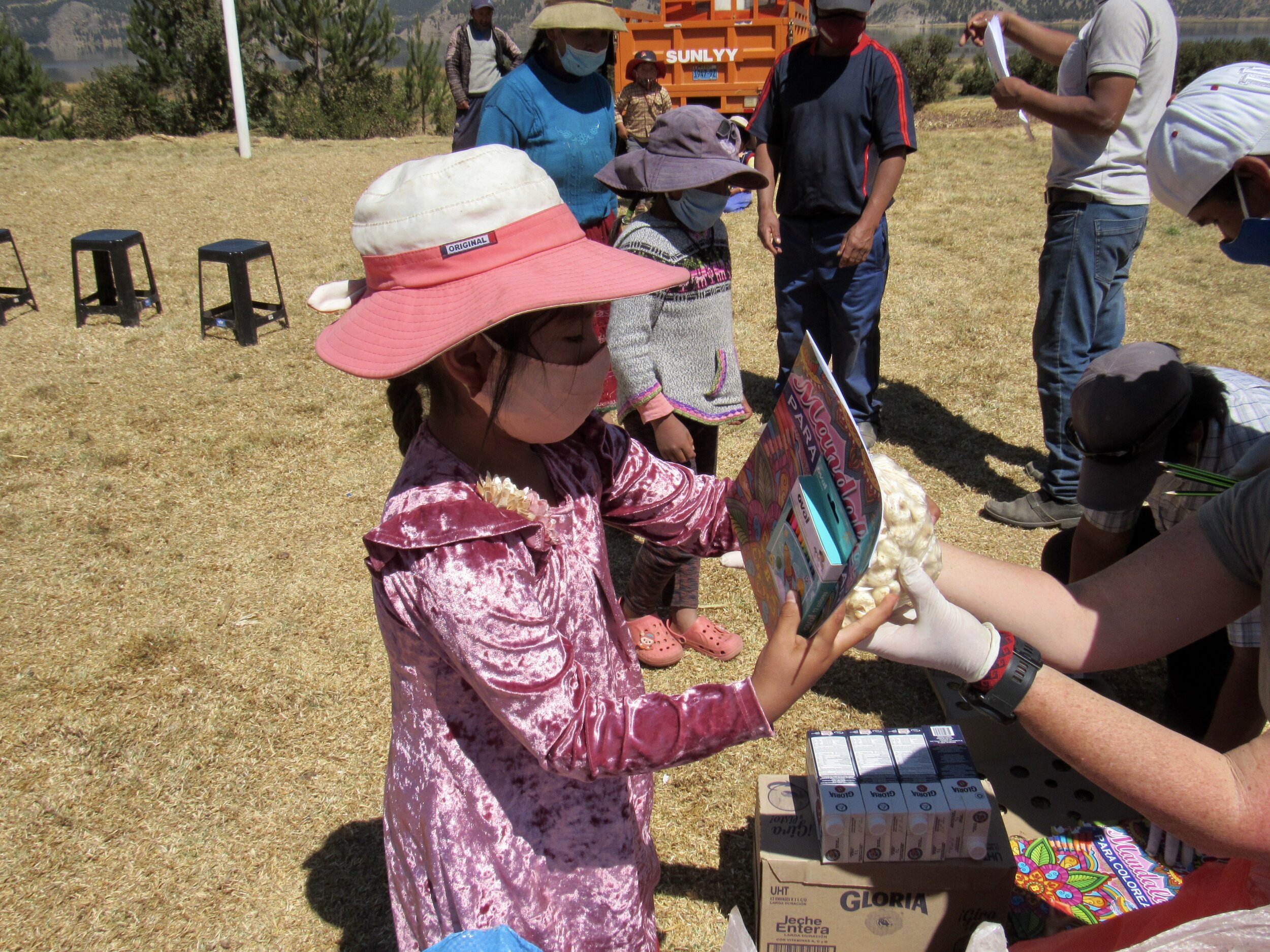
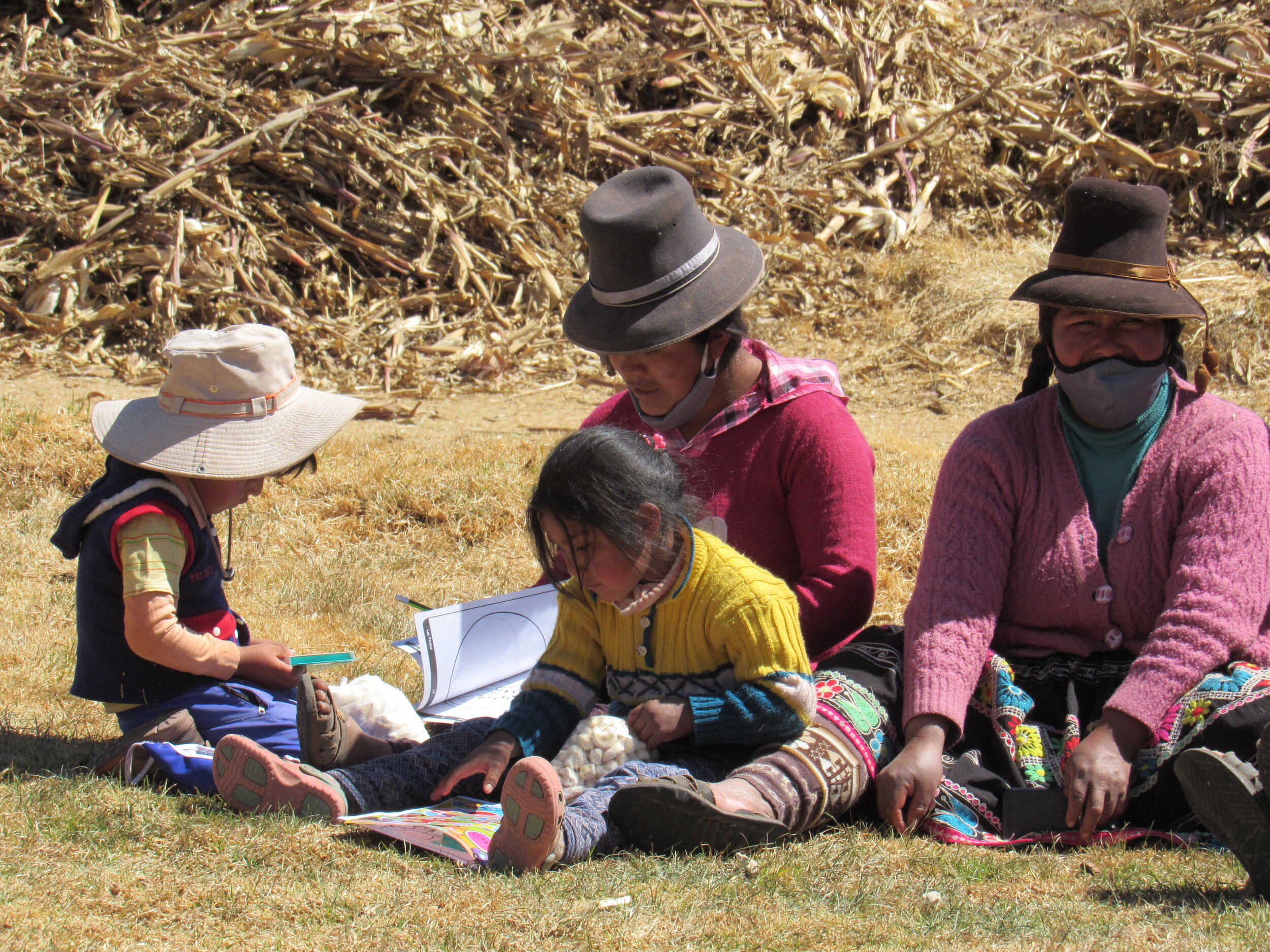
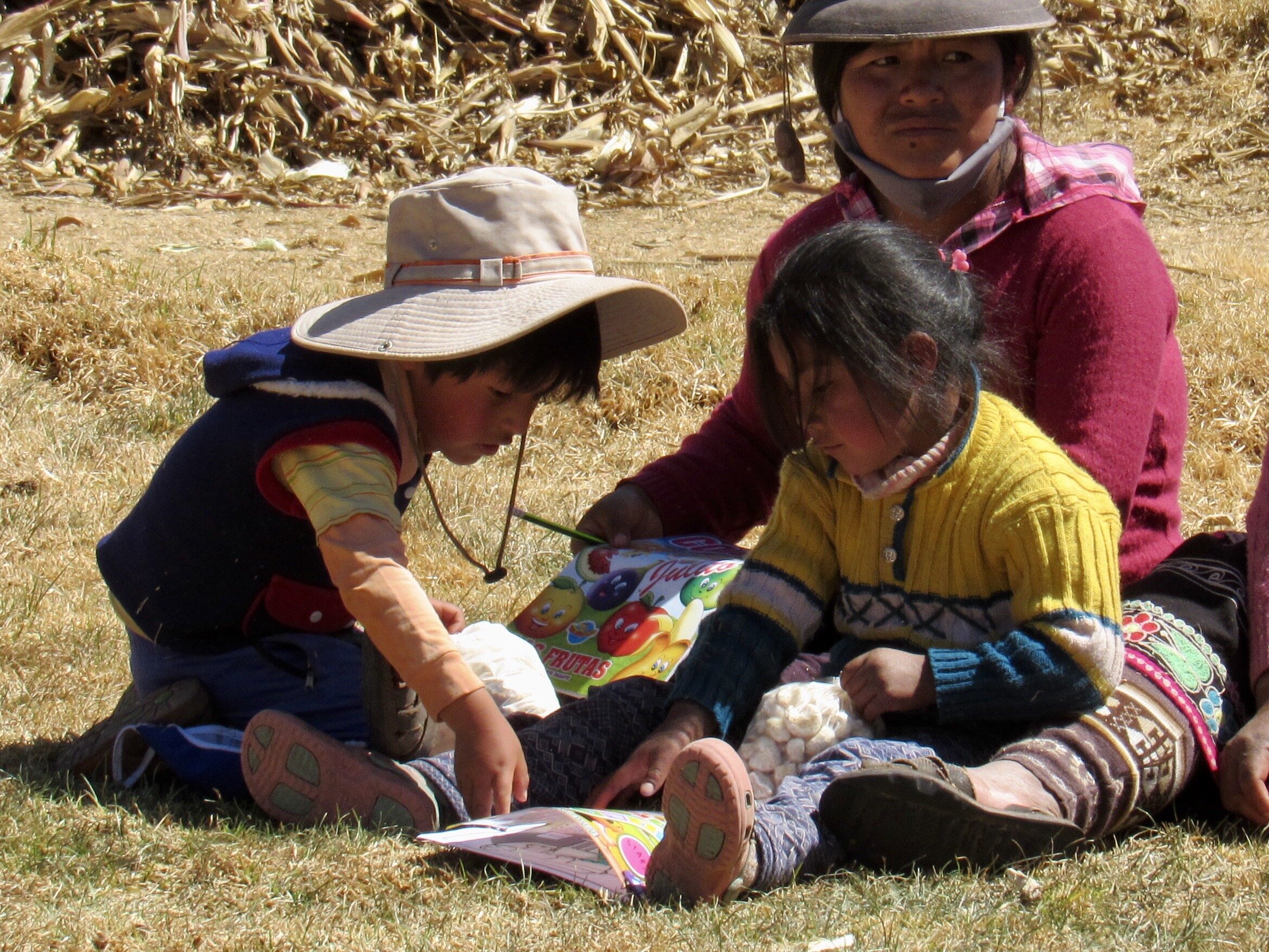
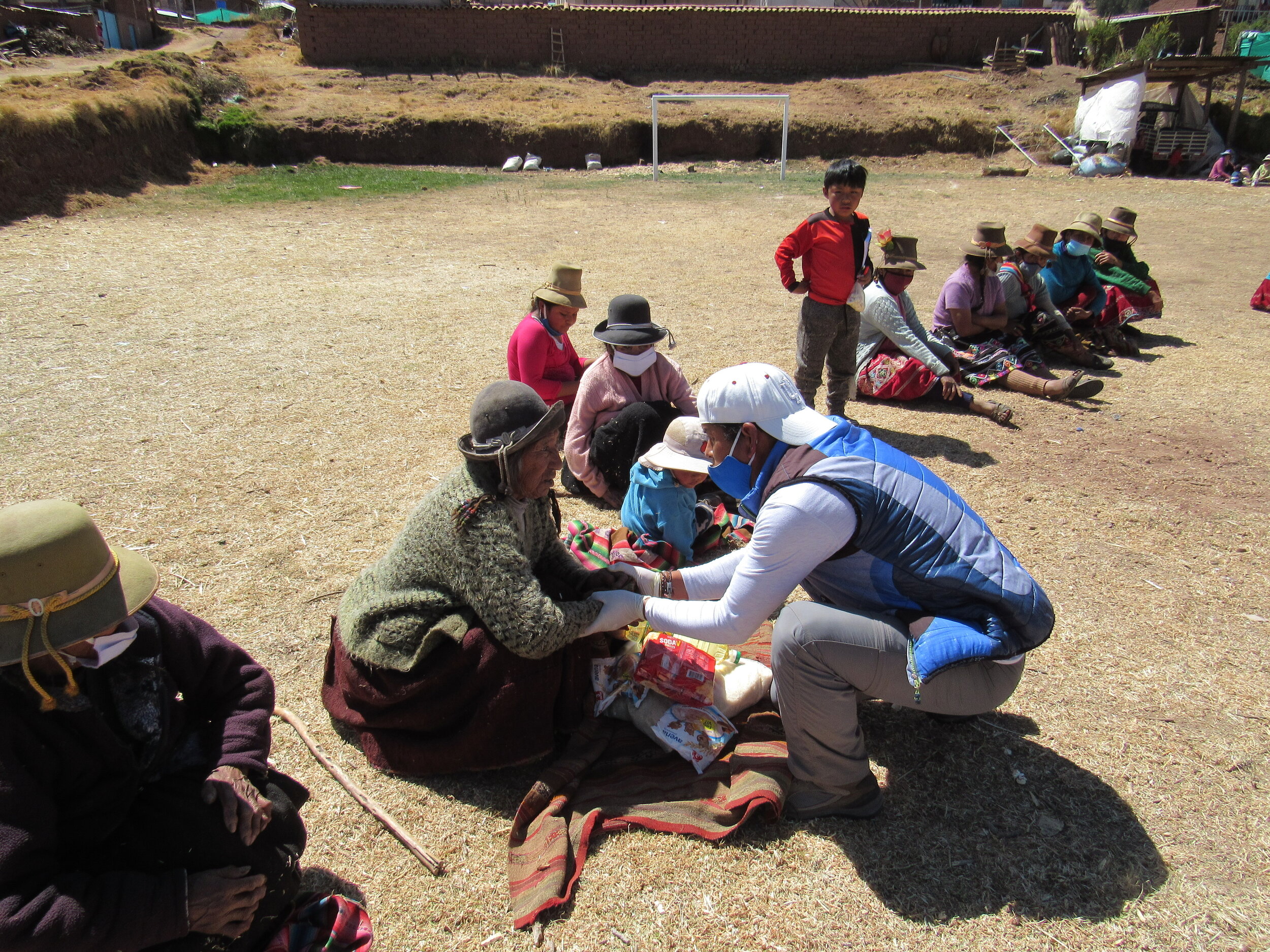
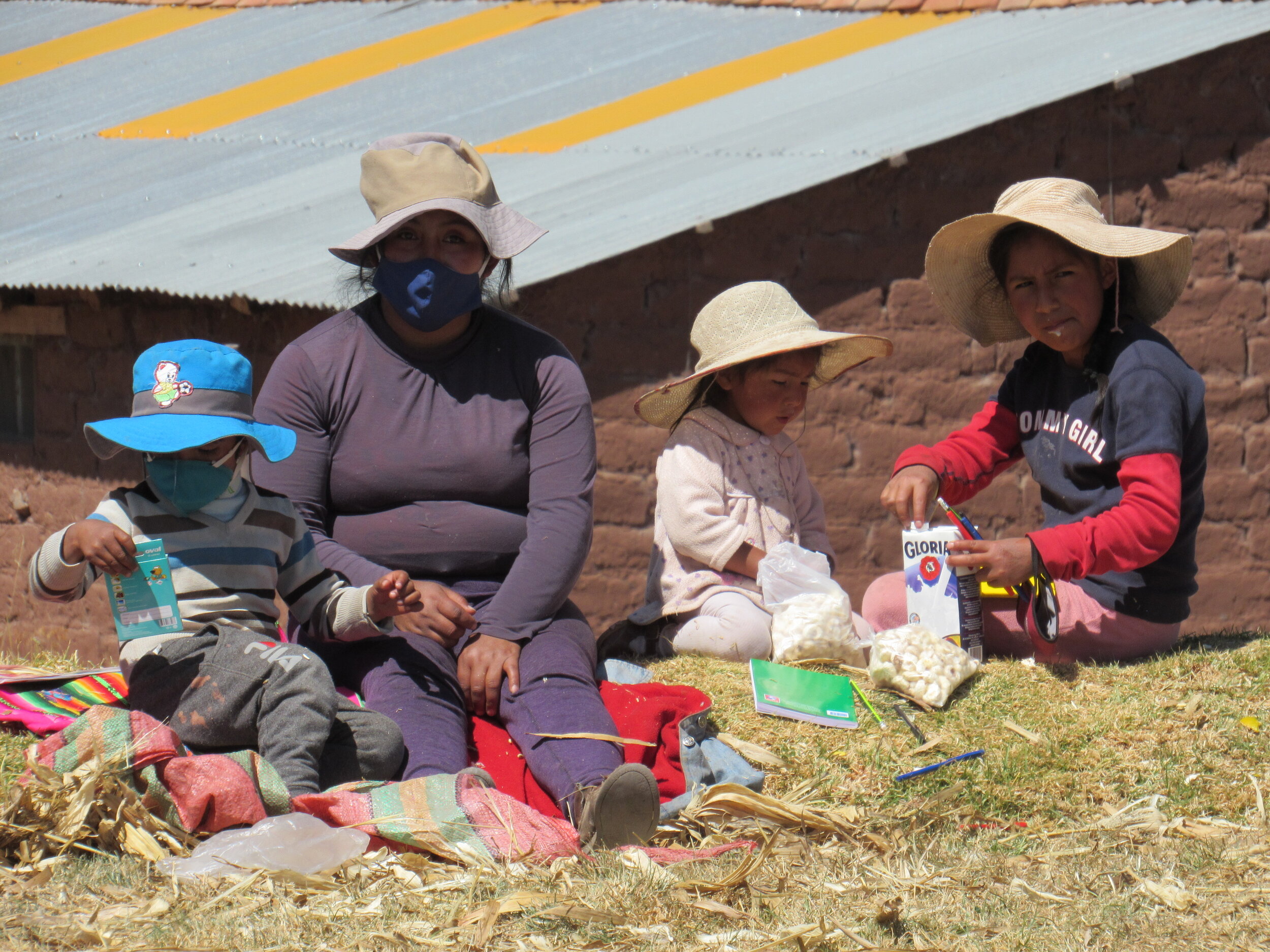
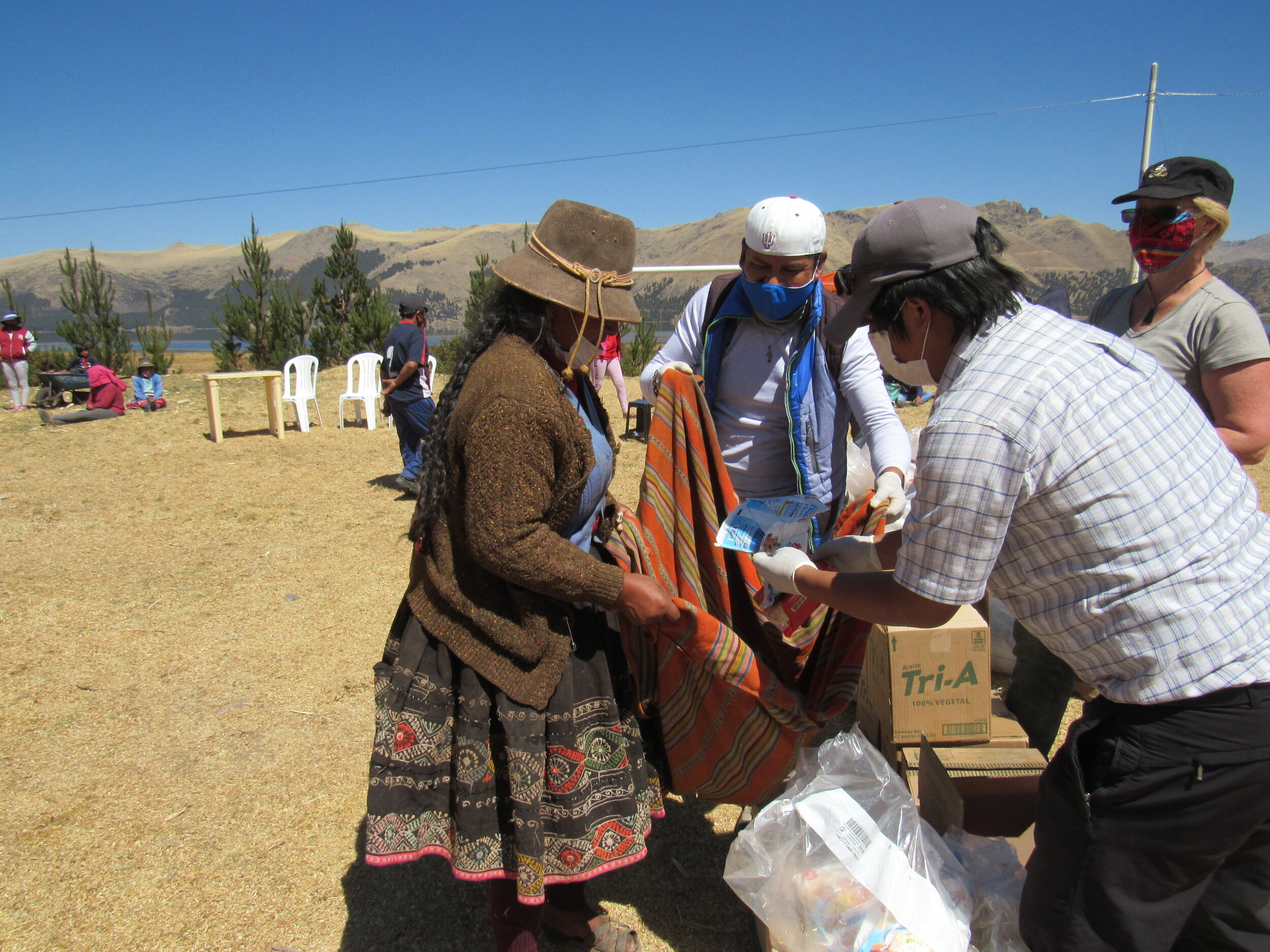

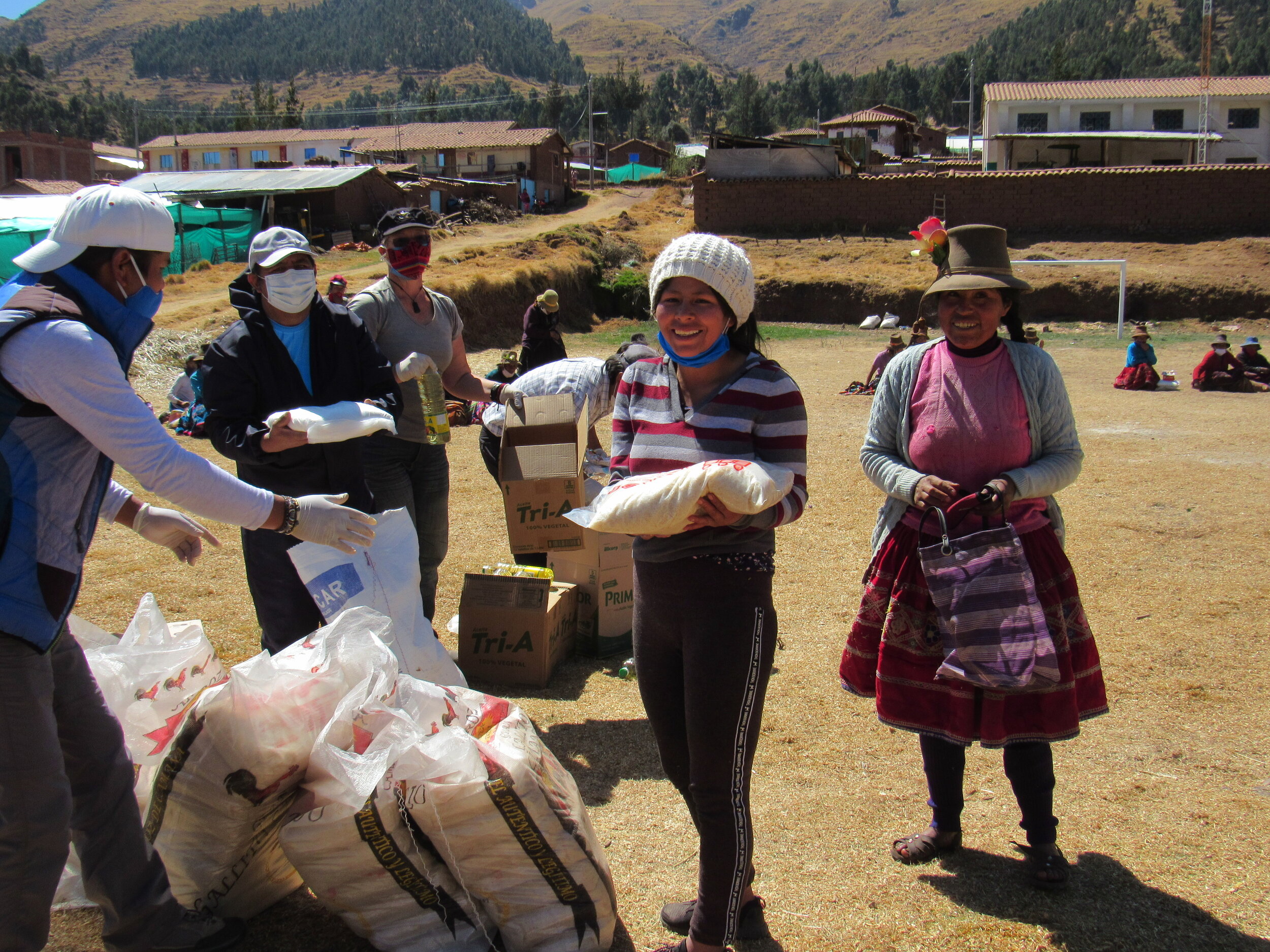
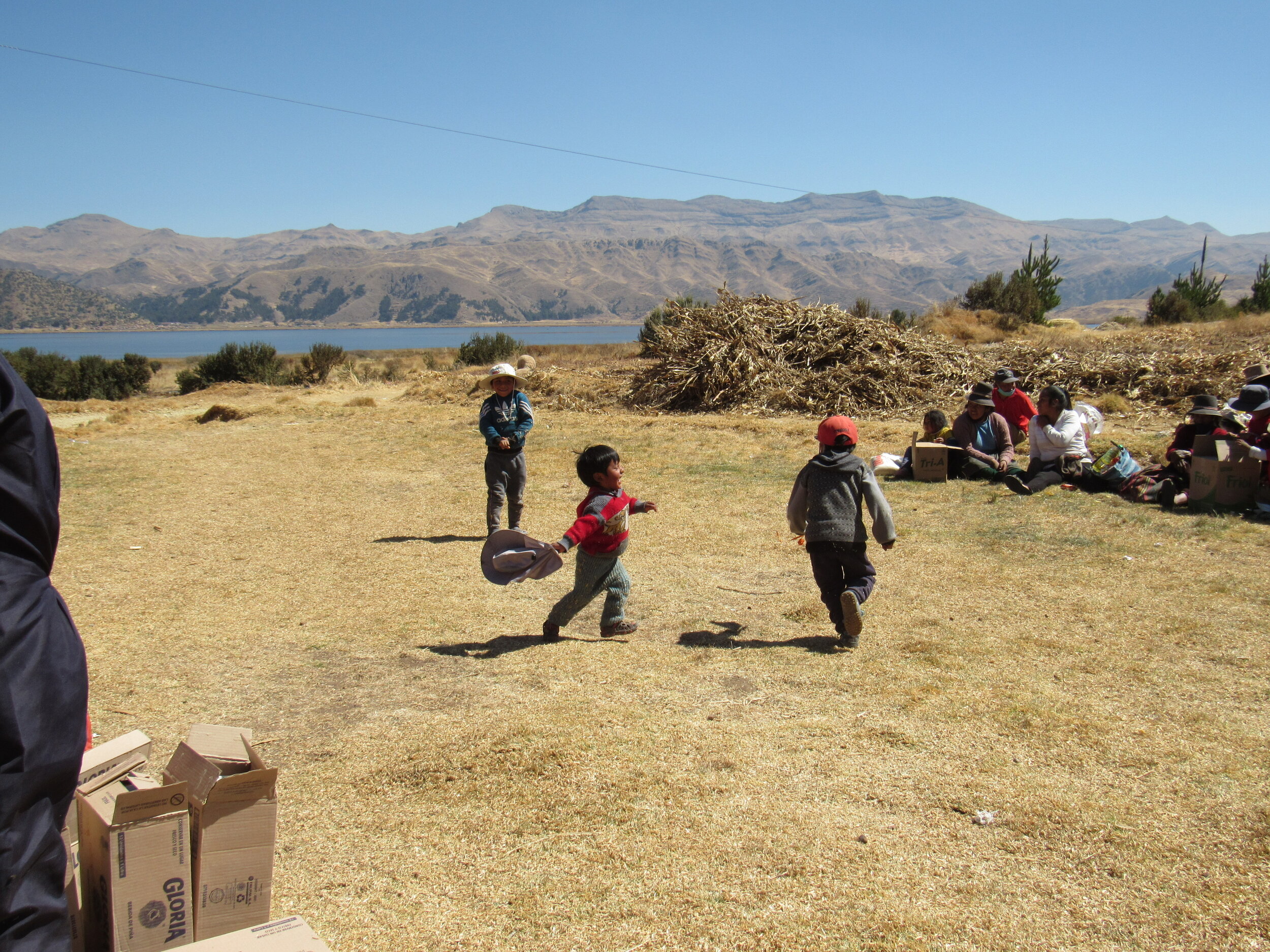


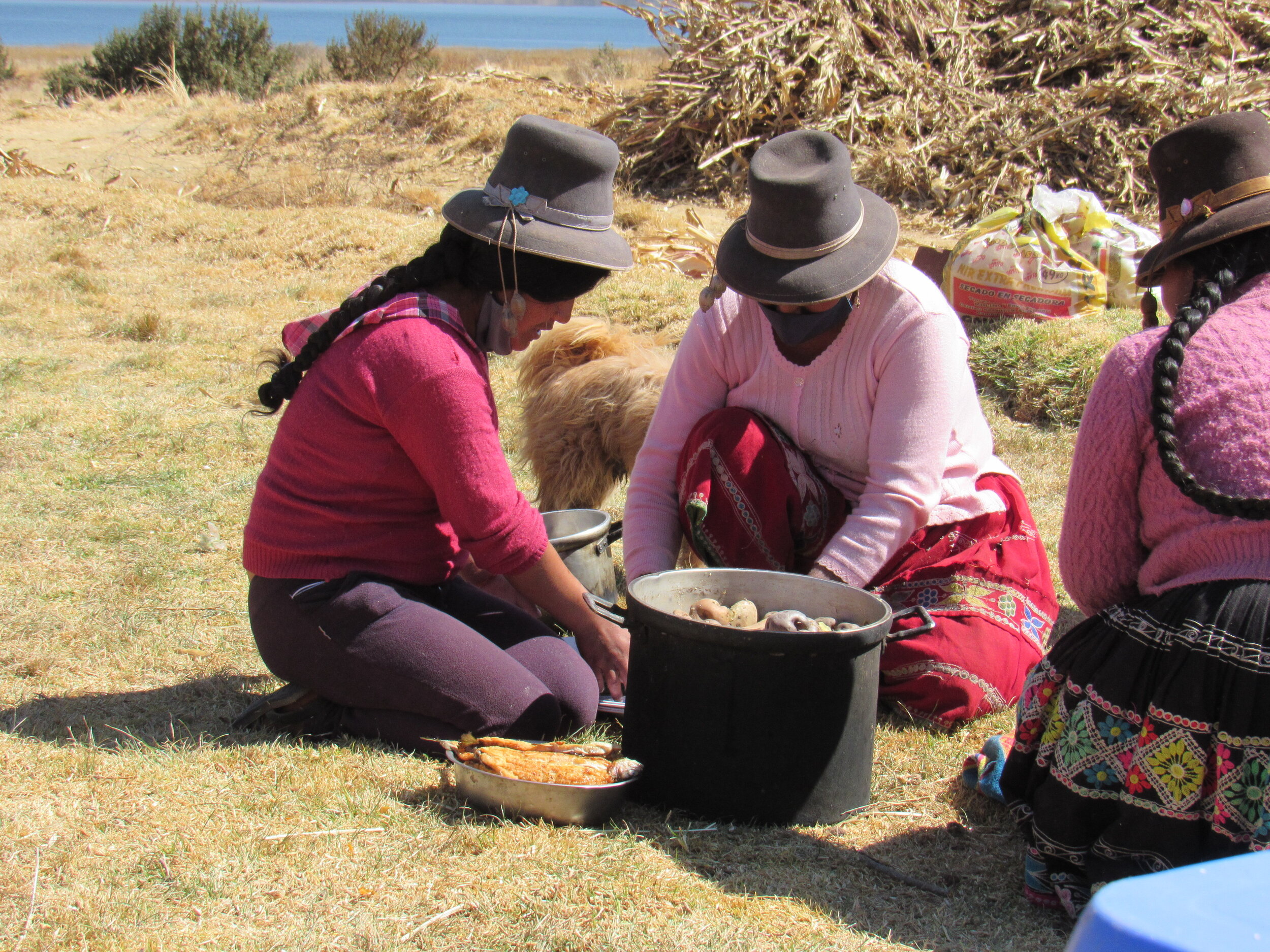
Saturday, 1 August, 2020
Today a van picked up Henry, Auqui and I, plus our friend Kyra Eddy, right at 8am, as they had promised. Kyra and her friend Justine, who lives in Australia, raised almost half of what we needed for today. It was such a huge help for me, since I was getting exhausted with the constant effort of trying to get enough donations every two or three weeks.
Henry did some shopping yesterday and had with him a couple boxes of school supplies. We have a list of the 75 kids 14 and under in Chahuay and we bought notebooks, coloring books, colored pencils and pens for all of them. For the children under 2 years old we bought a carton of milk, since notebooks and pens would be less useful for them.
We loaded the school supplies and the four of us in the van and set off. Kyra and I sat just behind the driver, with boxes piled between us. Henry and Auqui sat in the back, with as much social distancing as possible. We wore masks and every time we went through a police checkpoint I also put on my face shield. They never stopped us to ask for paperwork, but Henry did have that for us, just in case!
It took more than two hours to drive to Chahuay and we stopped on the way, where we crossed the Urubamba river for Henry to do a little ceremony at the river. Today is New Year’s Day for those who follow traditional Andean traditions and religious beliefs. Henry was a river guide for rafting and kayaking for years on this stretch of the Urubamba, so he wanted to thank the river for keeping him safe all those years.
All four of us climbed down the river bank and spent a little time praying over quintu. A quintu is three coca leaves, which you pray over, asking the Pachamama and all of the Apus, sacred mountains, for whatever you want in your life. With one quintu, I asked for protection for my family from the pandemic and for good health in general. Then I set the leaves in the river and watched them be carried downstream. You can pray over as many quintu as you want, so I got another three leaves and asked for protection for all of the people of Peru from the pandemic, from hunger and from poverty. The longer this pandemic goes on, the harder it gets for all of us.
After we set several quintu each down the river, we got back in the van and drove the last half hour to Chahuay. The town is on Lake Pomacanchi, in an incredibly beautiful setting. They had set up for us on the soccer field, which is near the lake. We set out the school supplies, and they brought the food that we had sent in the truck last night. We also got out the maná, which came to 58 bags, once I put the four kilos into smaller bags.
We called the kids first, oldest to youngest, to give them their notebooks and coloring books to keep them busy while we called the adults to come get their donations. The kids happily started eating their maná and coloring in their books as soon as they got back to sitting with their families. Even though we gave milk to the kids under two, we saw several older kids drinking straight from the cartons. I was just happy to see the kids smiling and sharing their school supplies and maná.
It took a while to get everybody on the list checked off, but it was only about noon when we were done. After the villagers all left, the community leaders brought out a couple tables and their family members brought food for us down to the soccer field. They served us plates piled high with boiled potatoes and onion salad, topped with a whole fried trout. Their lake is known for great fishing and it was the best trout I’ve had in a long time.
We ate with the community leaders by the lake and shared chicha. Most chicha is a lightly fermented corn drink. This chicha was made with barley, so it tasted a bit different, but was still delicious and refreshing. I’ve developed a taste for chicha in all forms and am always happy when we are served fresh chicha. This chicha was also “frutillada” which means that they mixed in strawberry juice to sweeten the chicha.
Eventually, we had to leave and piled back in the van for the drive back to Cusco. Thankfully, we didn’t have any trouble with the police checkpoints and the driver took Kyra and I back to my house. Kyra is living in Pisac, in the Sacred Valley, and drove her motorcycle to my house in the morning.
It’s about an hour back to Pisac, but we got back to my house around 4:30, so she easily made it back to Pisac before dark. She said that she didn’t have any trouble with police checkpoints, which was a big relief for me. I was so thankful both for her help today and for her friend Justine’s fundraising over the past couple weeks. I really didn’t want her to get stuck somewhere just because she came to help us.
Tomorrow we are back to the all day Sunday curfew, but I have enough food to get through one day and don’t have any errands I really have to do. We only had three “normal” Sundays, when we were allowed to leave the house, since that was one of the restrictions of the quarantine from March through June. I have no idea how many more restrictions will be added on, now that we are heading back into quarantine in Peru. Hopefully, it won’t be as strict as in April and May.
Covid in Cusco: Week 19
Covid is spreading more quickly in Cusco but I still find a way to go for a day hike in the Sacred Valley.
Sunday, 19 July, 2020
Today I really gave in to taking a day off. I sat in the sun on the roof, read Amy Schumer’s book The Girl with the Lower Back Tattoo and ate popcorn and two packages of cookies. If I’m going to be unemployed, I might as well do nothing on Sunday. There’s no reason to try to get things done around the house. I’m not working all week and now I certainly have plenty of time to do things like laundry Monday through Friday.
Happily, this week I will be a little less unemployed than last week. Since I got laid off, I’ve been working two hours per week, one hour teaching Spanish to a woman from England and the other teaching English to a Cusqueñian guy. This week I will get to add two more hours of Spanish to another woman from England and two hours of teaching French to a guy from Mexico. That means that this week I will have triple the income of last week! Also, on Tuesday I now get to teach one hour of Spanish, one of French and one of English. My brain definitely needs something like this to keep from getting too bored during pandemic life.
Monday, 20 July, 2020
This morning I listened to yesterday’s episode of This American Life “How to Be Alone” with Bim Adewunmi sitting in for Ira Glass. One of the people she interviewed was Leroy Chao, an astronaut who has spent 192 days on the international space station with only one other person: an astronaut from Kyrgyzstan.
Being in quarantine for 15 weeks with Kerry and Andrea wasn’t really like being in space, because we each usually left the house once or twice a week to buy food. Still, I wonder how similar quarantine feels to people who have been isolated by working in space or at lighthouses. Adewunmi said that at the time of recording, she has been in quarantine, isolated at home for about 130 days. I’m at 131 today, but things have loosened up so much in the past two weeks that it doesn’t really feel like isolation anymore.
Still, there are several things that Adewunmi said that I can completely identify with. I think that we all feel like “part of the terror of being alone right now is that this pandemic feels endless.” I keep telling myself that Cusco is a pretty good place to ride out a global pandemic. Even though I really do believe that, I still have to remind myself of that often, to reassure myself that I’m making a good choice. Whether or not Cusco really is a good place to be during a global pandemic, I am very aware that traveling to Lima and then through several airports to go back to Seattle or Boise would be more dangerous than just staying put. Wherever any of us are now, we’re safer staying home, staying inside, than traveling, even to a place that currently has fewer cases of Covid.
Of course, the other scary, or at least difficult, part of this situation is that there is “still no cure, no vaccine, and a steady increase in new cases.” This increase in new cases is happening in Cusco, in Boise and in probably the majority of cities around the world. Even the places that have it under control, for how long will it be under control? Can every country be as good as New Zealand? I have a hard time imagining places like Spain or Kenya or Brazil could follow New Zealand’s lead in any way that would actually get them the same results.
Tonight Chilly played one of his usual Peruvian songs, Bronto by Kill Amigo. It’s a band from Lima that I keep meaning to look into more. I’ll put that on my to do list for the week. Music, I need to focus more on music and less on the number of new cases of Covid in Cusco.
Tuesday, 21 July, 2020
It was just as fun as I thought it would be to teach 3 classes in a row today, one in French, then Spanish, then English. Maybe it’s time for me to focus more on teaching. Maybe this one year “sabbatical” was enough of a break from teaching. Tourism was interesting, while it lasted. Now that tourism is dead in Cusco and dead in most of the world, maybe it’s time to go back to what I loved doing for twelve years: teaching.
Plus, making any kind of income in tourism is just not going to happen in 2020 and perhaps not even in 2021. I made s/60 today, about $17, which is the most I’ve made per day since March. (For those new to the blog, s/ is the sign for Peruvian Soles, like $ is the sign for US dollars.) Like many Americans living abroad, I’m considering teaching English online. I don’t have a university degree in teaching English, like I do for French and Spanish, but I do have a TEFL certificate. If I could make just $40 per day, $200 per week, $800 per month, I would be making more than I was back when I worked full time at the travel agency. That seems feasible to me.


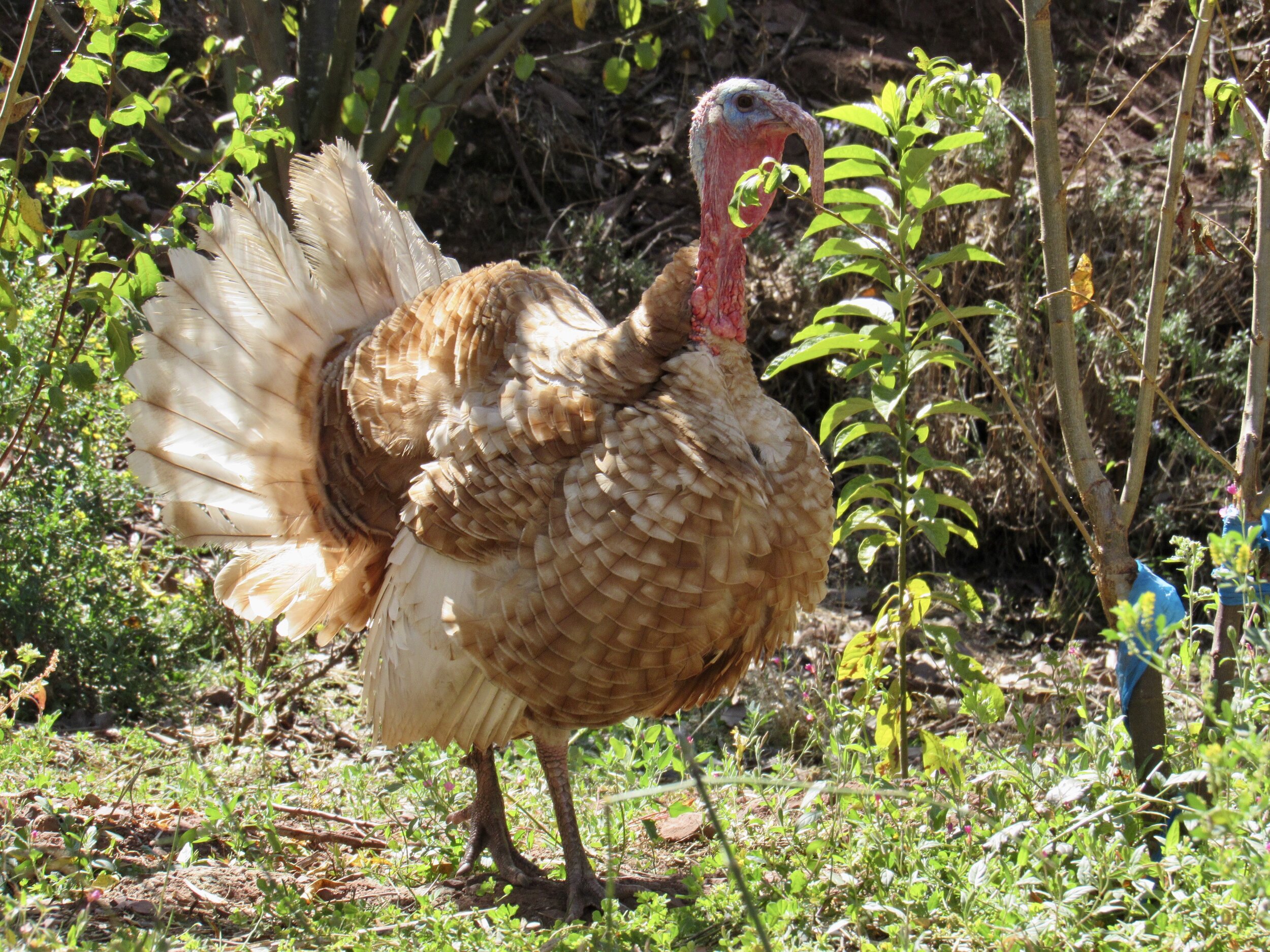
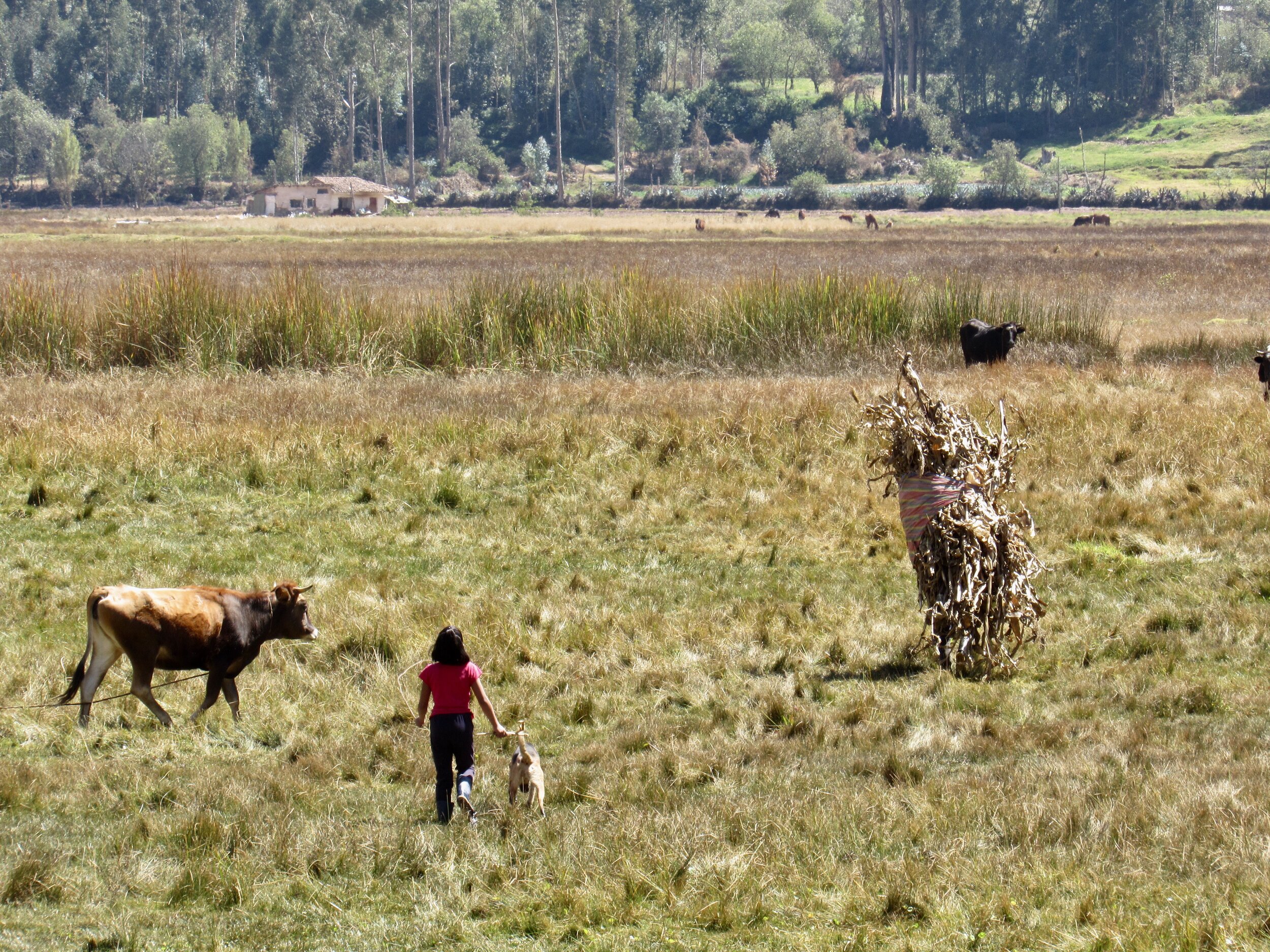

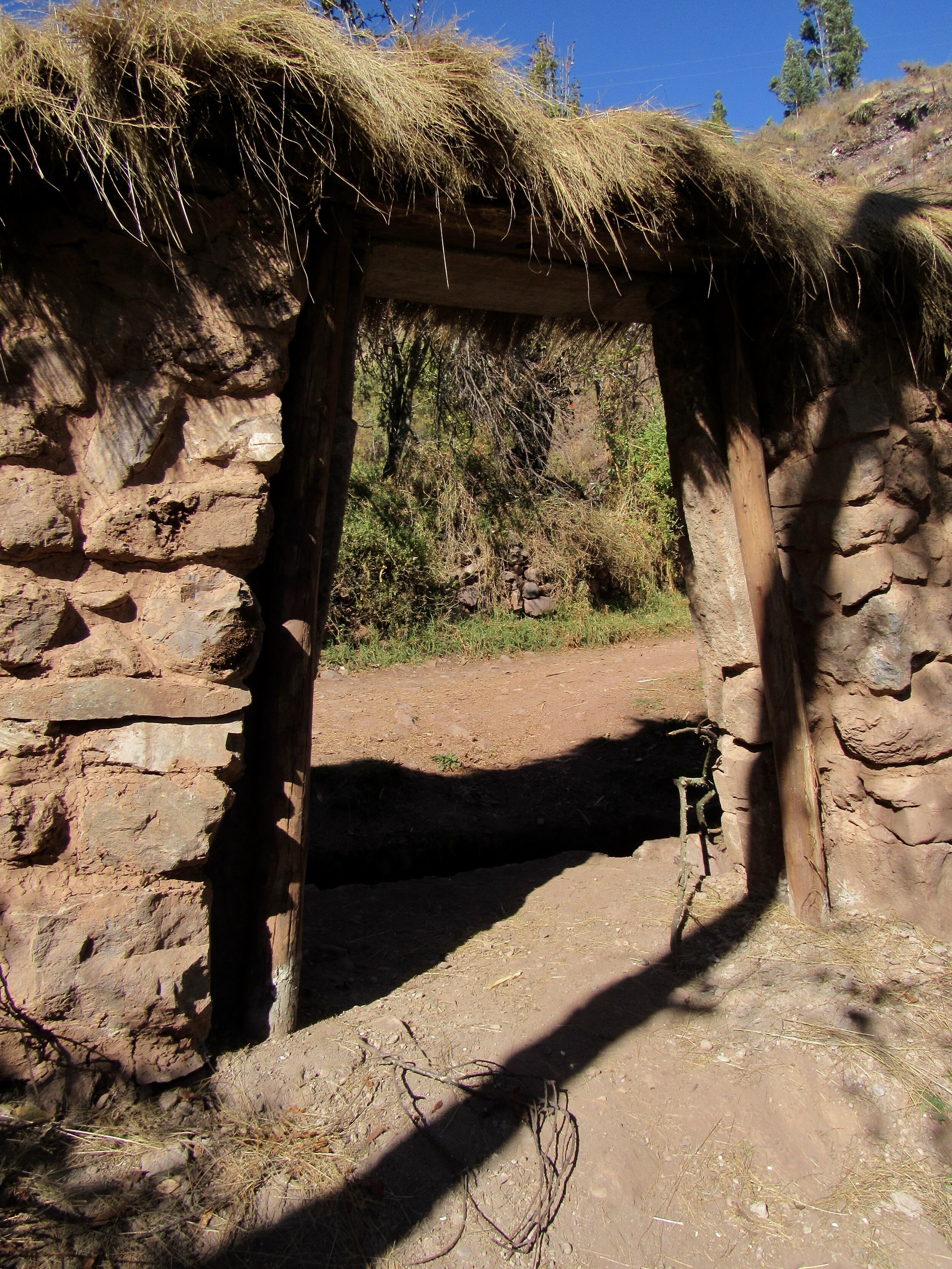
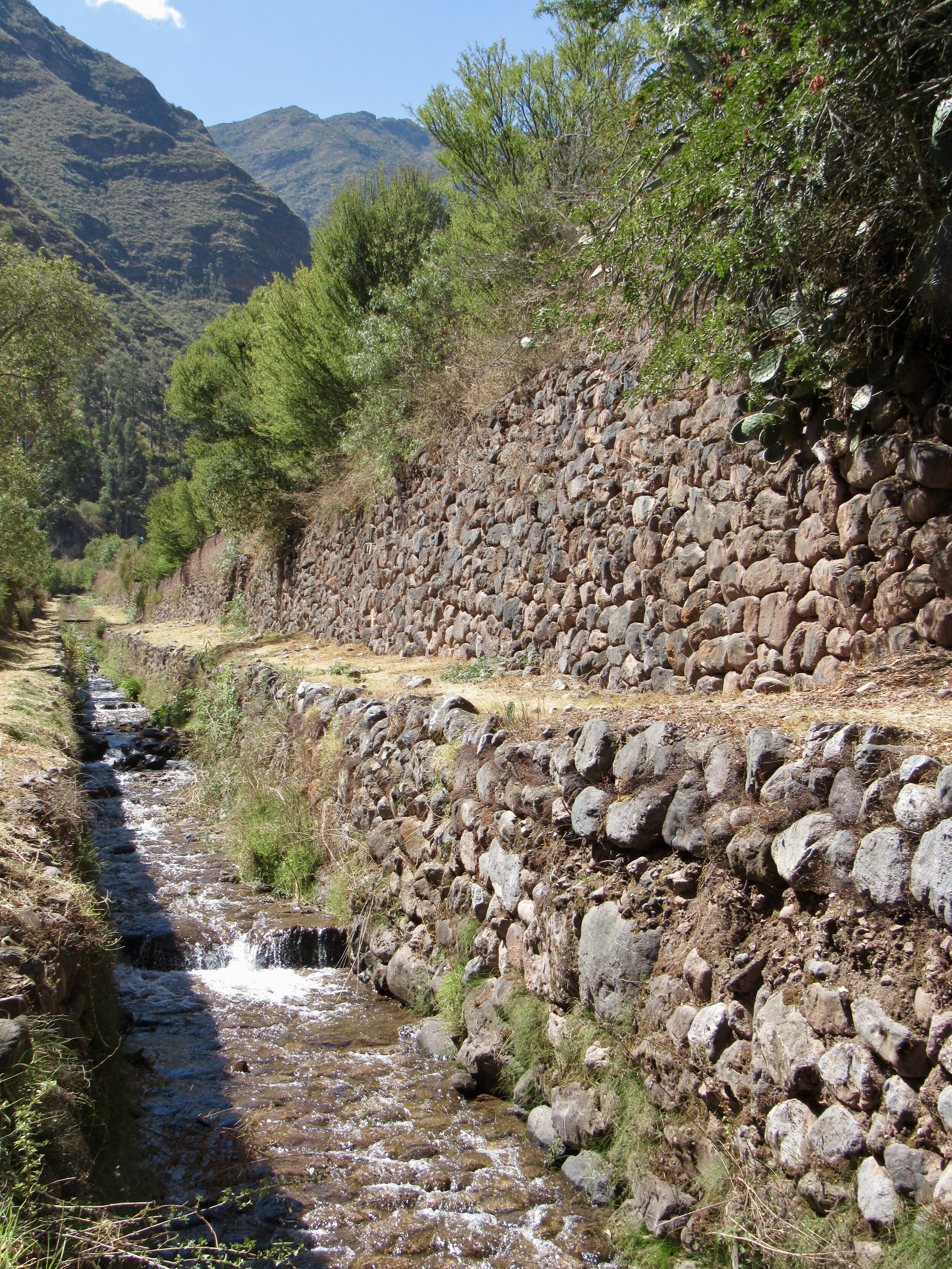
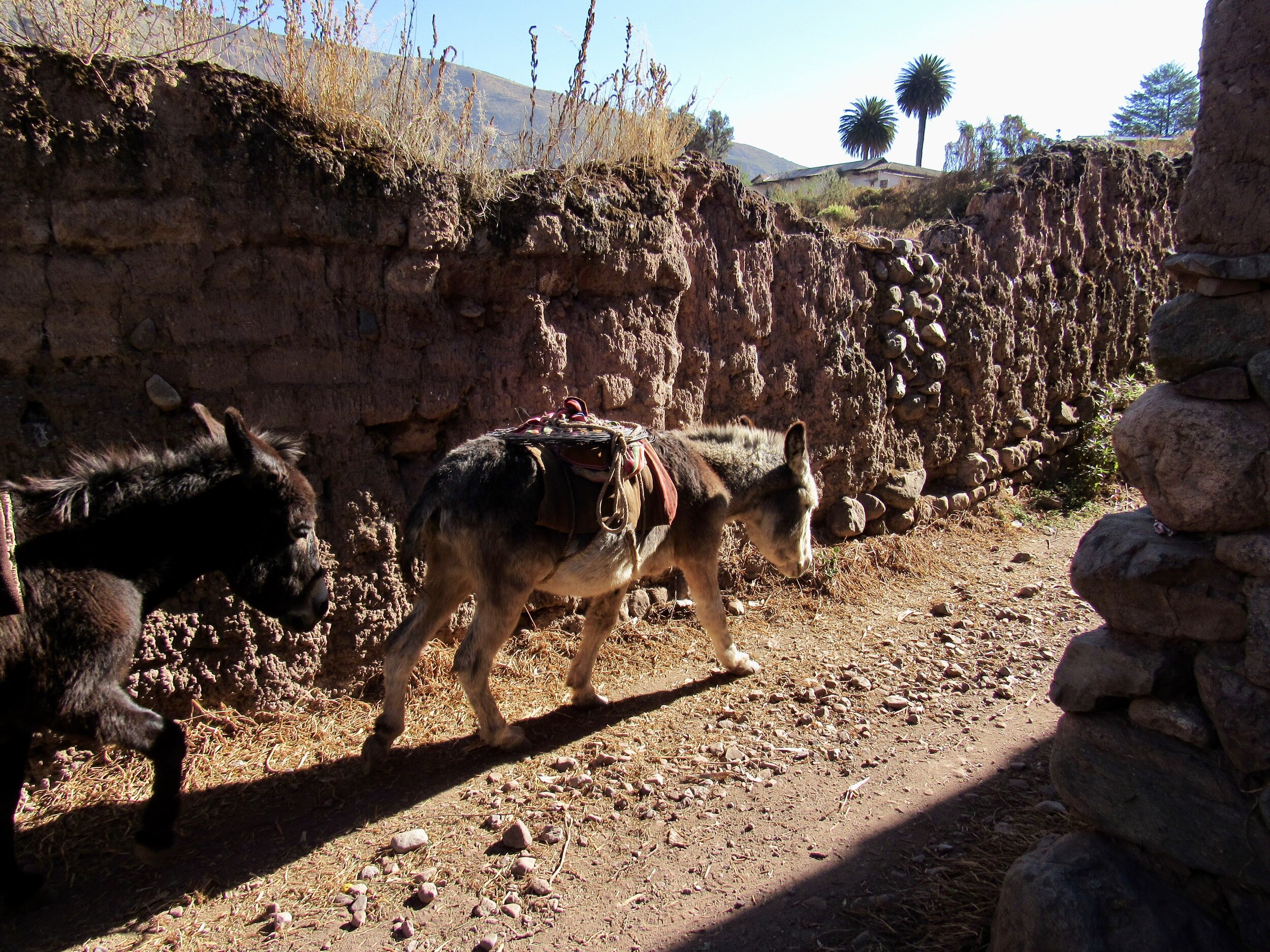
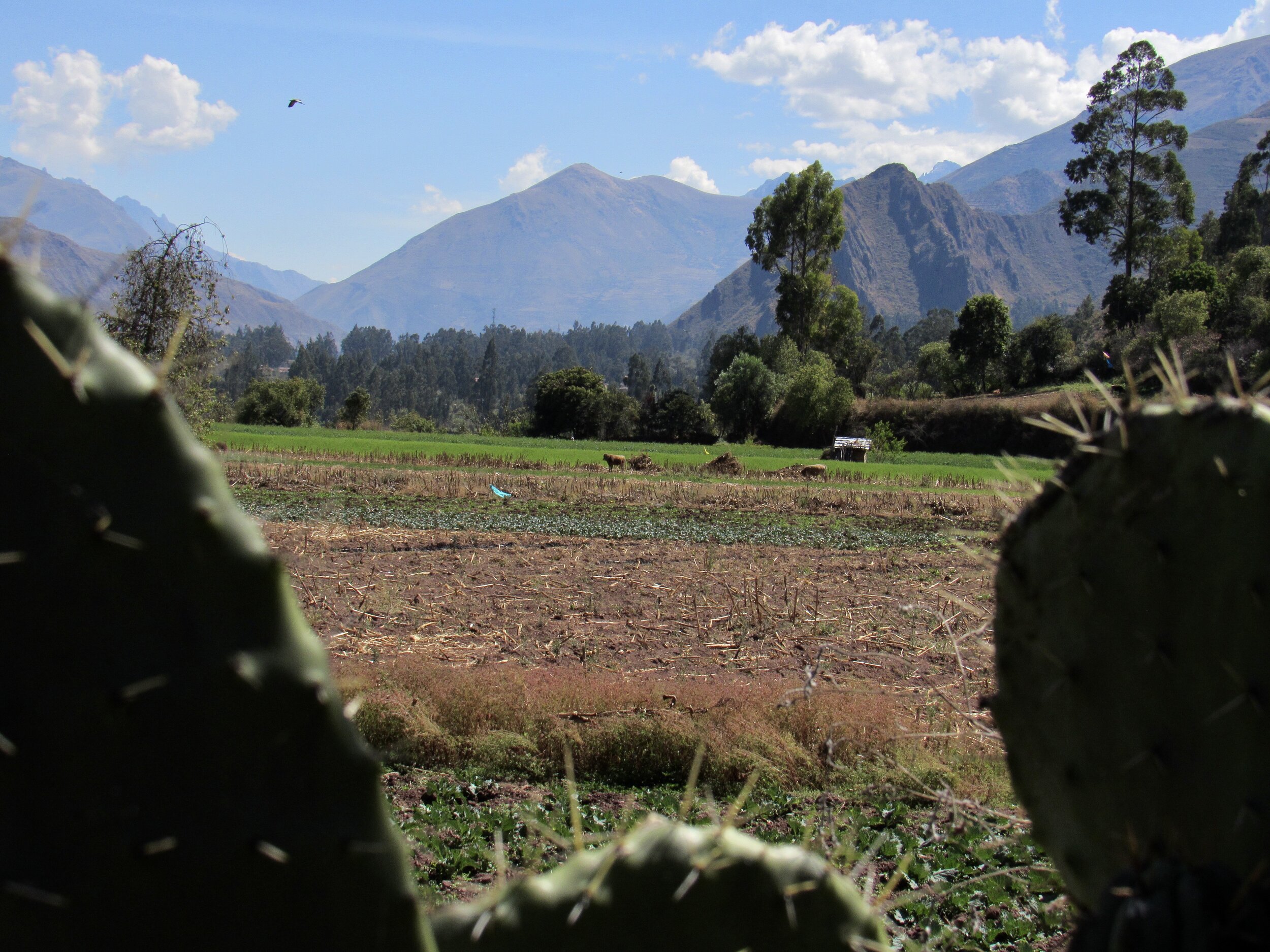
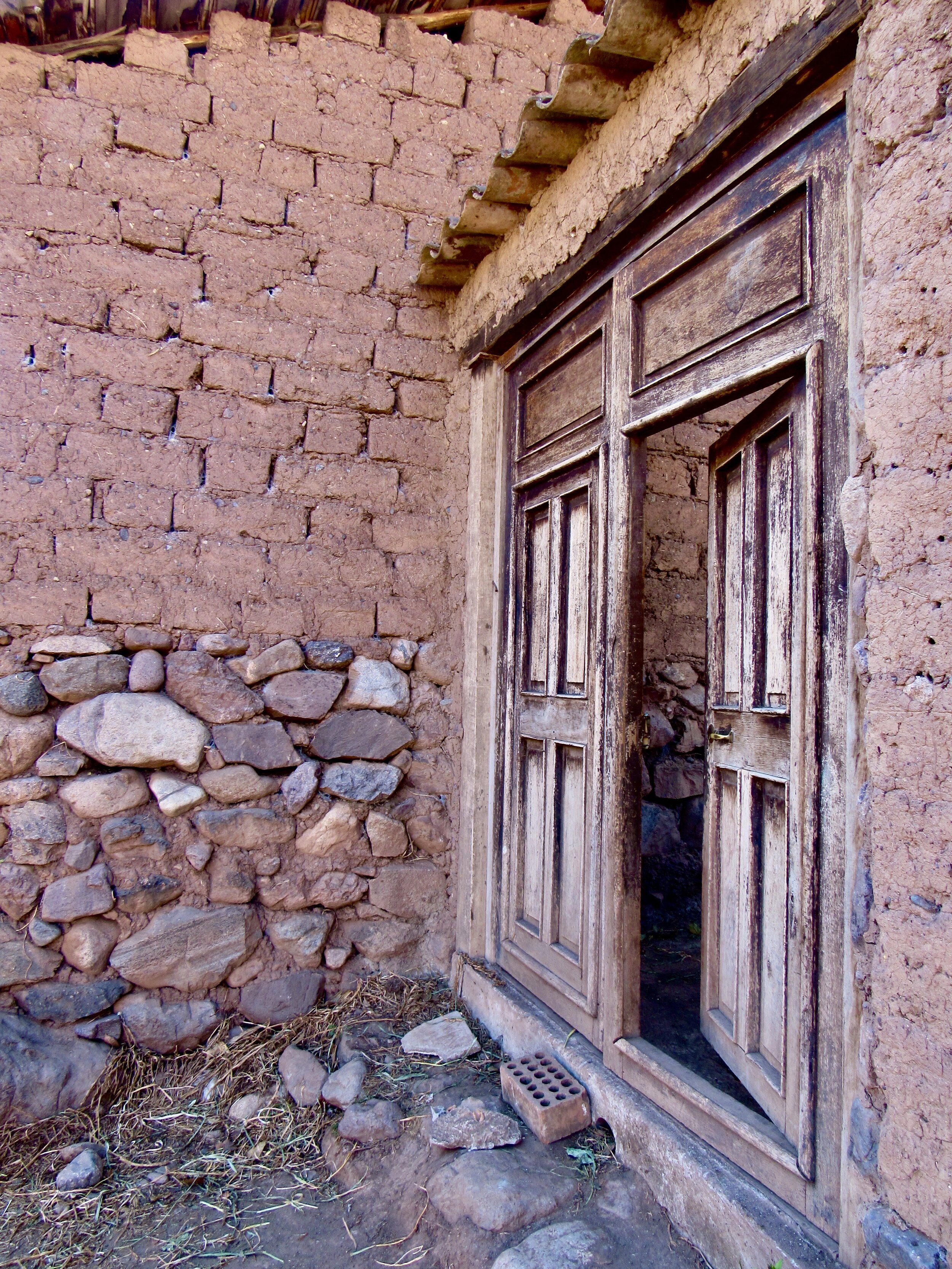
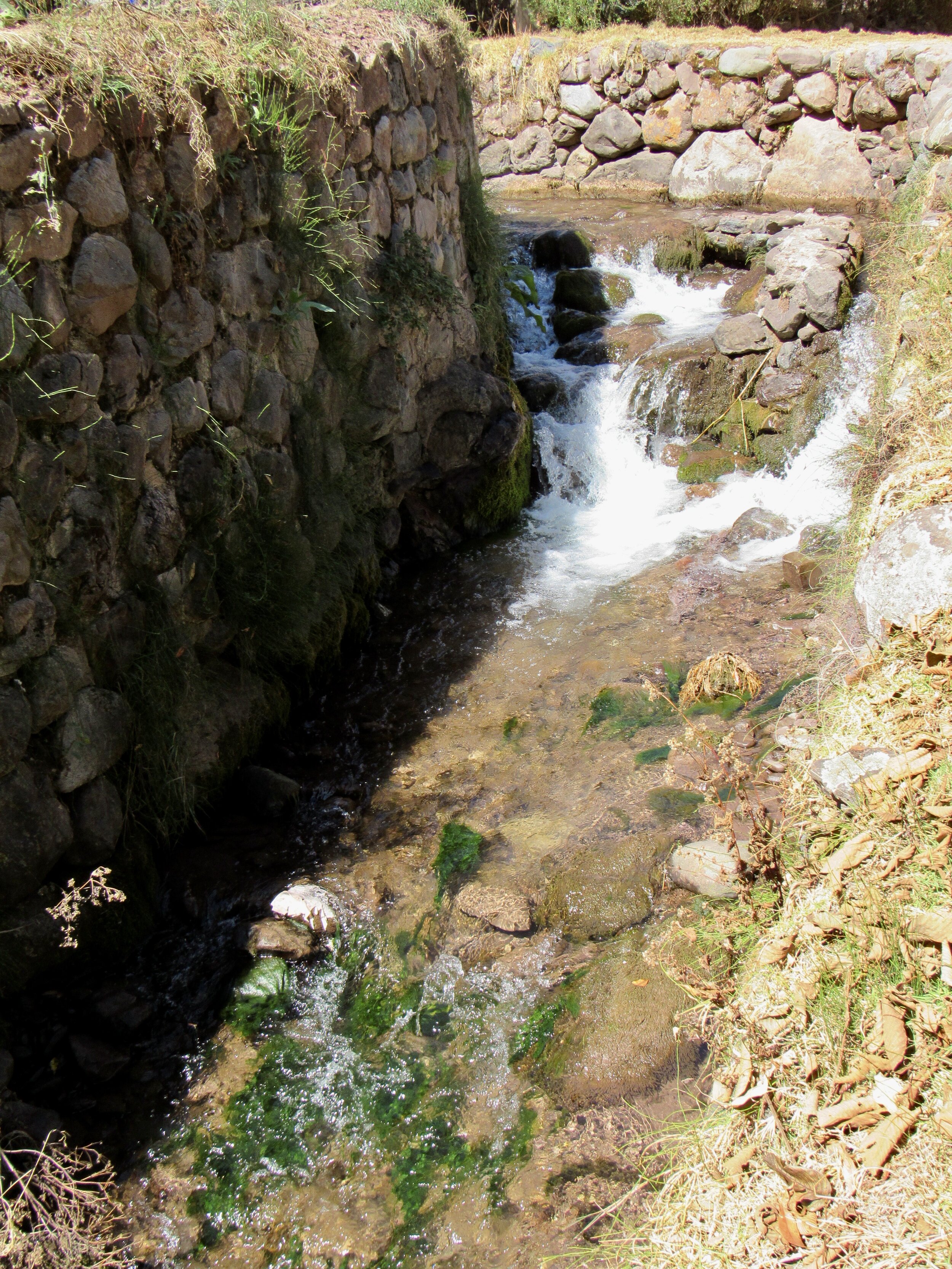
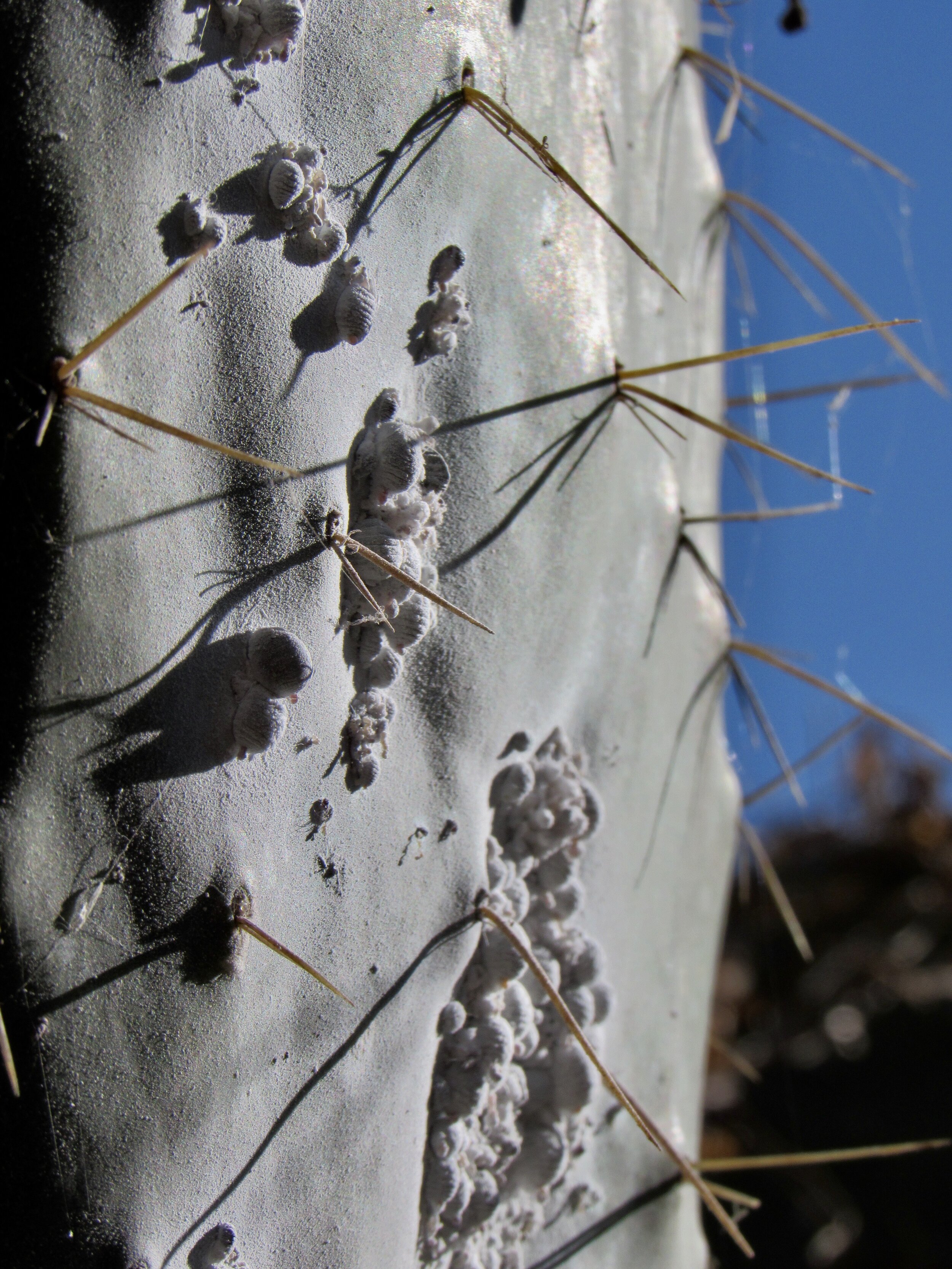
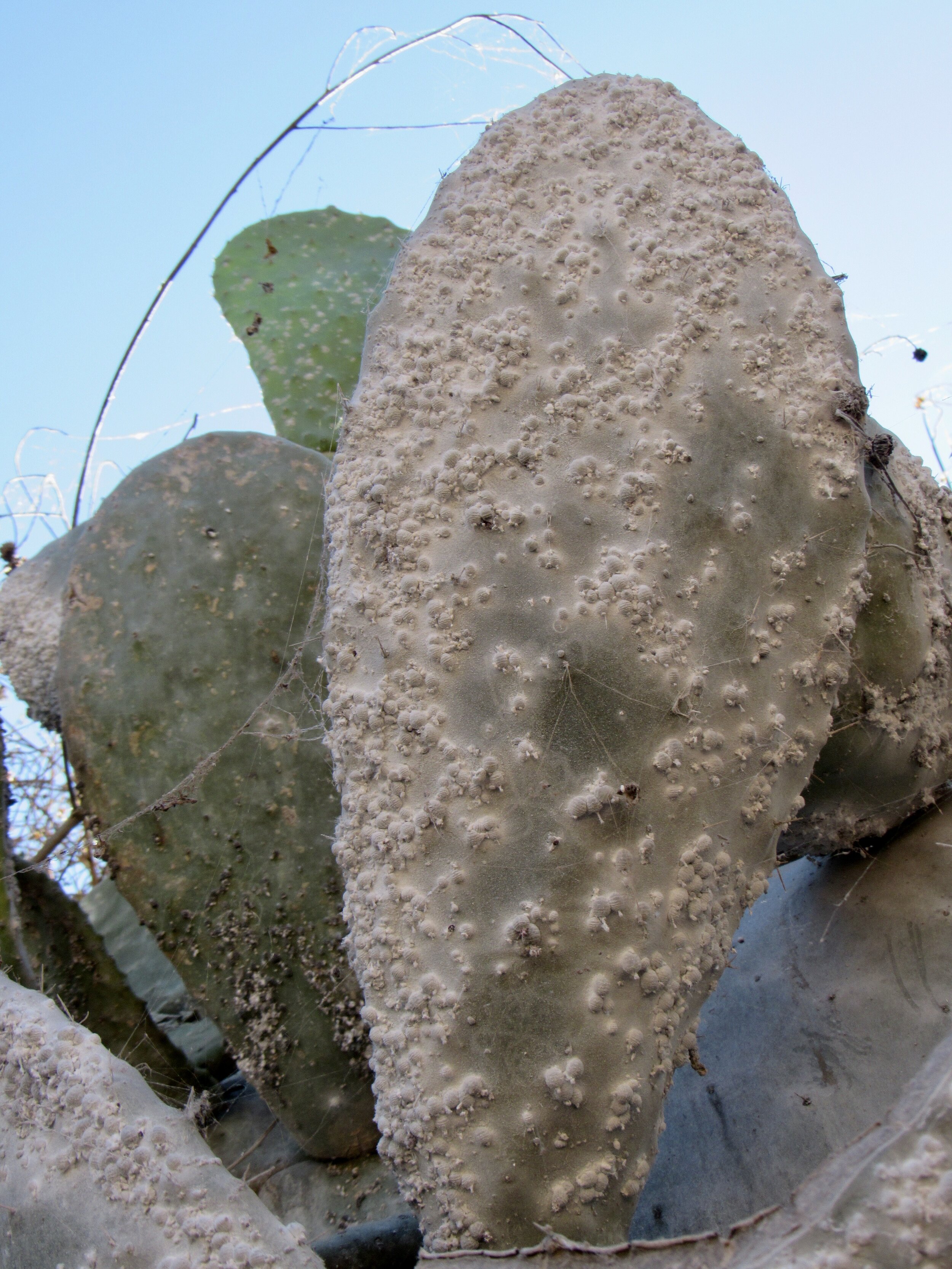
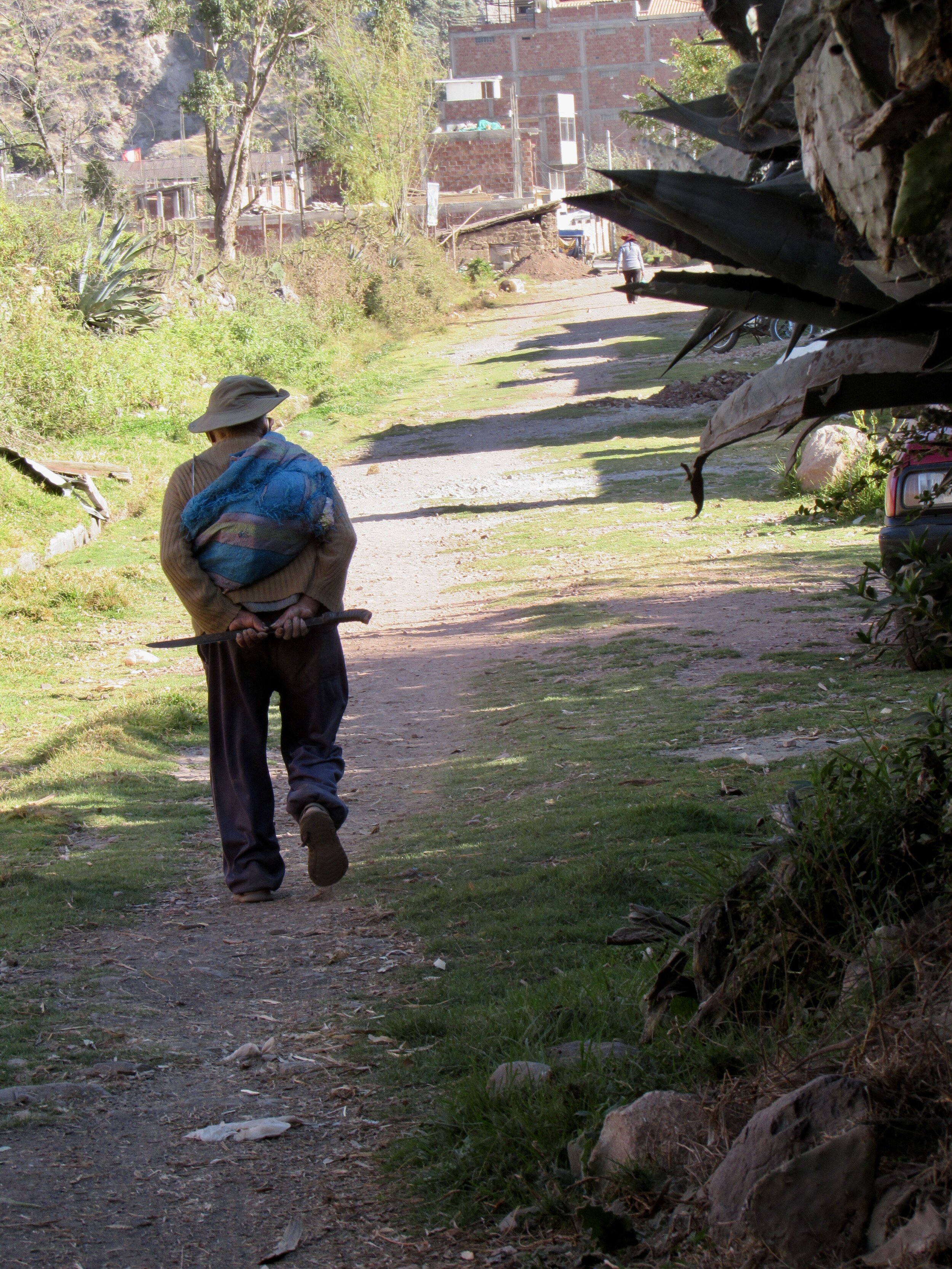
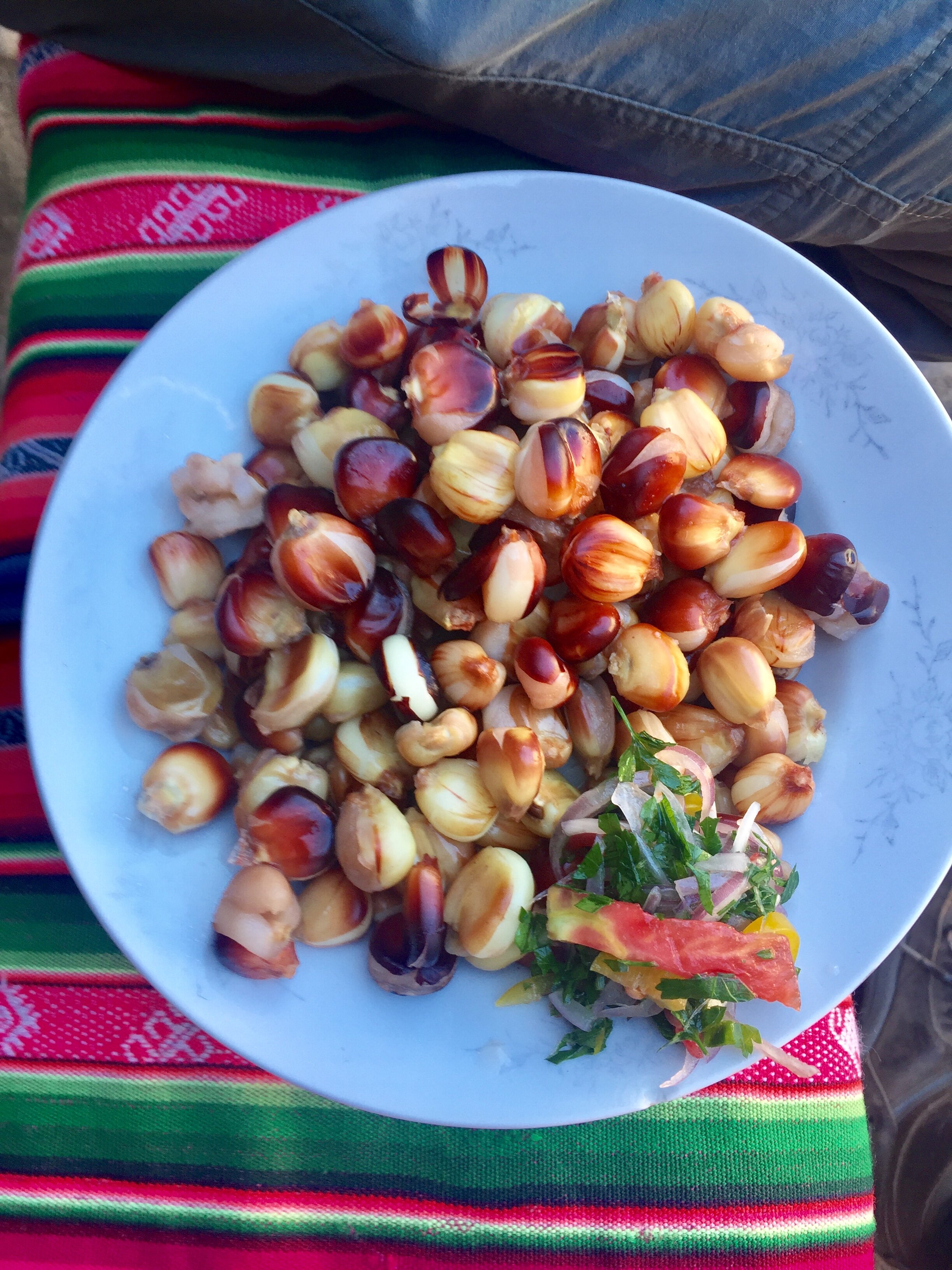
Wednesday, 22 July, 2020
Today, since I don’t have any classes, I went to Urubamba to go hiking with a friend who lives there. Transportation between towns is now allowed, but still very different from normal. Rather than busses, there are something like shuttle vans that go between the towns up and down the Sacred Valley. Now, those vans have half of the seats marked with a big red X, so nobody actually has to sit next to anybody else.
Under the current rules, all transportation can run at maximum 50% of capacity. Less than 50% is preferable. Obviously, this has also changed the price of transportation. The busses that go through Cusco used to be s/.80 but now cost s/2. Yes, that’s more than double. The longer distance vans have not quite doubled their price, but it used to cost s/6 from Cusco to Urubamba and it’s now s/10. Taxi fare has not changed, although the maximum number of people in a taxi now is two. It used to be normal to have one person up front with the driver and three (or more) in back.
It’s about an hour from Cusco to Urubamba and the hike we had planned leaves right from town. We walked up the valley that goes towards San Juan Mountain. This is parallel the valley that we went up to meet the families of Sut’uc-Pacchaq on June 6th. (Go back to the blog from week 12 or to heatherjasper.com to read about that event).
Before you even leave town, you go by some amazing Inca ruins, which are now part of the cemetery. It’s the former palace for the Inca Huayna Capac. The palace used to be a vast complex. Now, part of it has modern houses, part has been converted to farming terraces and part is the town cemetery.
Leaving town, you skirt around some fields, on a trail that goes towards the town of Yucay. When you hit the Inca canal, follow it uphill. You’ll know when you hit the Inca canal. The walls are obviously Inca construction and it’s obviously a channel made for irrigation. Keep following it uphill for about an hour and you will get to a spot that used to be a mill. It’s a wide spot in the canal with a pourover dam and two large canals leading off from each side of the main canal.
The mill itself is no longer there, having been destroyed by the Spanish over 500 years ago. I am still working on getting a good description or drawing of what this mill was like. So much was lost during the colonial period that it’s hard to find any aspect of Inca history, culture or even architecture that all archeologists and historians agree on. There are multiple versions of what each Inca monument or temple or city was for, when it was built, by whom and for whom. Of course, some parts of Inca history and culture are widely accepted by most archeologists and historians. Still, we lost so much during the destruction of conquest and then the cultural oppression of colonialism that it’s impossible to know much of anything for sure.
Back to the beautiful hike, leaving the brutal legacy of colonialism aside, this is definitely the best day hike I’ve been on during the dry season. So many trails in the Cusco region are just so dusty and hot and don’t have any shade. They’re more pleasant in April or September, but in July it’s just too dry and too sunny. This trail follows the canal, which not only provides a beautiful babbling brook sound, it is also lined with trees. The cooling effect of the water and the shade from the trees makes this the most comfortably pleasant hike I’ve been on in the Sacred Valley.
Plus, you’re walking along the top of walls built by the Inca, passing terraces that have been farmed for more than 500 years. We passed fields of lettuce, broccoli, fava beans, fruit trees, wheat and corn. In many of the fields, the people working stopped a moment to call out a greeting in Quechua. Sometimes we stopped to chat for a moment but mostly we just called out a greeting back in Quechua and kept walking. Out away from town, nobody was wearing a mask. If we were going to be walking close to somebody I put my mask on, but didn’t expect them to always have one.
Like so many rural communities in the Cusco region, there are no cases of Covid in the area. I don’t have anything to fear from them, but they certainly should be afraid of me. I came from Cusco this morning. Not only is the number of cases starting to rise steeply in Cusco, I was in a public van from Cusco to Urubamba. We all know now that traveling, even just a little, puts us at much higher risk of exposure than just staying home.
From the water mill, we walked up a bit farther to a little meadow for our picnic lunch. Instead of following the canal back down, we walked along the base of the hills towards Yucay. There are paths between each terrace and each chacra, so it’s easy to find somewhere to walk. We had a general idea of the direction we wanted to go, so there was no worry about being on the right path or not.
A chacra is like a tiny family farm. They can be several contiguous fields or one large field. Some have little sheds for farming tools, but most chacras don’t have any buildings. Around here, they all have to have irrigation rights to be able to grow anything in this season. In the area around Urubamba and Yucay, they are also all on terraces that were built during or before Inca times.
I love living so near to so much history. There are Inca walls less than a hundred yards from my house in Cusco. There are Inca temples and palaces throughout Cusco and the Sacred Valley and many other nearby valleys and mountains. It really reminds me of living in Istanbul. I felt like everytime I turned a corner there was some historical building or fountain or monument from the Ottoman Empire or the reign of Constantine or even earlier. It's something I never really felt in the US. The history of the Native Americans was so much more thoroughly erased that it’s hard to feel their presence as much as the presence of the Inca Empire so completely permeates everything in the Cusco region.
Thursday, 23 July, 2020
El Molino is open! This is a market I have been wanting to go to since April, when I accidentally put my exercise band through the washing machine and it came out a sticky lump. El Molino has several shops in the back that sell exercise equipment, which is where I got my weights and some other things that I was happy to have when I had to make my bedroom into my home gym in late March.
I now have a new exercise band and I even splurged on lunch at a ceviche restaurant. Splurges like this don’t give me any financial regret, since even with my meager income, exercise bands and ceviche are not expensive here. However, they do give me something that I’ll call “contact regret.” In the moment, I’m so happy to be near people and see shops open and looking semi-normal. I’m so happy to eat ceviche and have somebody else not only prepare my food but also do the dishes.
Afterwards, I wonder if I really needed to get that exercise band and if I really needed that ceviche, because I am counting the number of people with whom I came into contact. The most important number now is not how much I spent, but how many opportunities I had to catch Covid from somebody.
All of the alcohol gel and masks in the world will not take away this worry. Yes, they took my temperature when I went into the El Molino market. Yes, I washed my hands with soap and water, dried them, then put on alcohol gel after I touched the money I used to pay for the exercise band. Yes, I kept my mask on. Yes, everybody I saw also had a mask on. Yes, they were washing their hands and getting sprayed with alcohol too. Still. What if?
Friday, 24 July, 2020
This morning, Kerry and I walked up to a grove of eucalyptus trees near the Temple of the Moon where we had a yoga class last week and the week before. Today we sat there, stretching on our yoga mats and chatting for almost an hour before we gave up hope that anybody else would come. It seems a little odd, since last week there were at least ten people and the week before seven or eight.
It was still a beautiful morning to sit under trees, listen to birds and just enjoy being outside. Once we gave up thinking that anybody else was going to show up, we walked up to the Temple of the Moon itself and I showed Kerry the path that I used when I was sneaking out at about 6am back in March and April. That’s when it was illegal to leave the house for anything besides food and medical care.
Those first fifteen weeks of quarantine were so hard! Partly because it was such a shock to go from normal life to such a hardcore shutdown. Here in Peru, there was a 6pm curfew and only pharmacies or grocery stores were allowed to be open and only Monday to Saturday. For seventeen weeks in a row, nobody was allowed to leave home on Sunday, except for emergency medical services.
Police and military patrolled the streets and really did arrest people for being out after curfew, on Sunday, or for not having a reason to be outside. When I was sneaking out to hike, I always carried with me my Peruvian ID, some cash, my phone and an empty ibuprofen box. I never took a camera or water bottle, since those are signs that I’m out for a walk, rather than a quick trip to the pharmacy to get more ibuprofen. I really was scared of being arrested.
Now, leaving the house doesn’t feel risky in terms of being arrested. The heavy police presence has diminished and the military have vanished from the streets of Cusco. They still work the checkpoints that I go through everytime I leave or reenter Cusco, but I never see the military in my neighborhood anymore.
Leaving home still feels very risky in terms of coming into contact with somebody who has Covid. Walking the trails in the hills above town, like going to the Temple of the Moon with Kerry, doesn’t feel risky. I feel safe outside, staying 20 to 50 yards away from anybody but Kerry. Even if they’re not wearing their mask, it just doesn’t feel at all dangerous to me.
What I’m really starting to rethink, what I’m having “contact regret” over, are my trips out of and back into Cusco.
On Wednesday, I took public transportation from Cusco to Urubamba. I bought a face shield for the first time, to wear over my mask in the van. Nobody else in the van had a face shield on, but of course everybody was wearing a mask. In the afternoon, I took a van from Yucay, through Calca and Pisac, back to Cusco. People were constantly getting into and out of the van at multiple stops along the way between Yucay and Cusco. They were all wearing masks, and half of the seats were marked with a big red X, so that nobody would sit next to another person. I didn’t hear anybody cough and several windows were open the whole time. Still. What if?
Saturday, 25 July, 2020
Next Tuesday is Peruvian Independence Day, but Tuesday is a terrible day for a party, so Kerry organized one for today. There were only six people invited and we planned to have the party on the roof, with lots of other considerations made for some kind of social distancing. We didn’t ask anybody to wear masks, since we’ll be eating and drinking.
I feel like we are taking some calculated risks that I am okay with. Kerry took everything that we’ll need from the kitchen up to the roof, so that nobody would be in our kitchen. We opened one of the empty rooms in the house, so that our guests could use a bathroom that nobody uses normally. We gave everybody a handful of alcohol gel when they came in the door.
I spent some time in the morning building a bbq grill out of things found on our roof. We have a flat cement roof, which mostly looks like an abandoned construction zone. I picked out a brick, three cinder blocks, a piece of corrugated metal, two broken tiles and a pile of rocks. It really worked out much better than I expected and by the time the guests had appeared and were starting to get hungry, the coals were just perfect. I had gathered some sticks from around the park across the street and Kerry bought a bag of charcoal.
I grabbed the grill from the oven, balanced it on the bricks and we cooked veggie kebabs and chicken kebabs, then sausages, then bananas with chocolate inside. The coals were hot enough to cook with for more than four hours. It was my best DIY success so far!
However, we did get some bad news today. There is another woman named Kerry in San Blas, who was diagnosed Thursday with Covid. Maybe that’s why nobody was at yoga yesterday. Had word spread amongst the yoga community of San Blas that we should all stay away from each other? After hearing that, I wasn’t sure that all of the measures we had taken for the party were enough. The good news is that I have never met this person and as far as I know, nobody that I know has ever actually met her. Still, it’s a tight knit community of expats in San Blas, especially those who do yoga.
Should I stay home for the rest of this week? I will be avoiding the San Blas market and all San Blas restaurants for at least couple weeks. Next Saturday, in just one week, I will be going with the Covid Relief Project to another rural community to take them food. I definitely need to be much more careful, if I want to continue to go to rural communities in good conscience. It would be so, so terrible if I ended up taking Covid to one of these communities.
I think that this week, leading up to taking food next Saturday, I should go back to the quarantine rules of April and May. At least this time, I can just enforce it on myself, without the risk of arrest if I do go for a walk. I will keep my mask on and stay away from people. I cannot let myself catch Covid if I want to keep being part of the Covid Relief Project. I cannot let our efforts to help end up being the death of somebody in any of these rural communities. It’s time to take myself back to the space station.
Covid in Cusco: Week 18
The number of cases of Covid in Cusco is going up and I try to go camping again.
Sunday, 12 July, 2020
Day 123 of Covid in Cusco
The stats, the numbers, everything just keeps going up. How many cases of Covid in Cusco, in Peru, in the world? How many people have died? How many people have lost their jobs? How many people have slipped back below the poverty line after recently working their way out of poverty? How long have we been dealing with this virus? Are there any numbers, anywhere, that are going down?
What questions do I have to ask to get numbers that are going down? What questions do I have to ask to find some positive news? I keep going back to air pollution, with so many flights cancelled and so many people staying home. That’s definitely been good news for a while now. Is there any other positive news in the world?
I don’t even know if the Covid Relief Project is positive news anymore. There are just so many families in need. Yes, we are helping a lot of people and yesterday we took food to a hundred families. Most of those families will be able to feed themselves for a week or two with what they received yesterday. Still, the longer the borders are closed and the longer people don’t have work, the more families will need our support. The Peruvian government hasn’t sent any help lately and every mayor we contact gives us the name of several communities that haven’t received any help, even from the government.
Can we really keep this up for all of 2020? Can we actually get enough donations to keep this going until tourism returns and stabilizes? Am I going to be working on this in 2021? How do I not get burned out?
Yesterday, taking food to families in Taray and Picol was beautiful and like the previous times, I felt energized and optimistic when we were actually in the communities, distributing aid. Also, like the previous times, I feel exhausted, overwhelmed and a little depressed the next day. The need is just so great.
It reminds me a lot of living in Bangladesh. The biggest contrast is that here I do get the days of optimism, when I feel like I really can help and that what I’m doing actually does make a difference. The days of feeling optimistic and helpful in Cusco far outweigh the days of feeling overwhelmed and helpless. In my two years in Bangladesh I had very few days of feeling optimistic or helpful, while almost every day I felt overwhelmed and helpless. (See my blog from December 21st, 2014).
I honestly don’t believe that it’s at all possible for the situation in Cusco, in terms of poverty and hunger, to ever be as bad as what I saw in Bangladesh. Still, it’s bad enough and I really don’t want to see it get any worse. Considering the questions that I keep coming back to, I just don’t see it getting any better anytime soon.
Monday, 13 July, 2020
This morning I walked over to see if the Alianza Francesa had opened yet. Of course, the doors were closed and the gate locked. I didn’t really think it would be open yet, but it was worth walking over to find out. The café next to the Alianza was open, so I went in to see if they had any more information.
The Alianza has been doing all of their French classes online since the quarantine was announced on March 15th. Apparently the demand dropped so much that they have had to lay off a bunch of staff and aren’t looking for new teachers. I’ll have to keep checking in, since going back to teaching French is what I’m counting on if I can’t get any work in tourism by September.
I’m still not tempted to go back to the US this year. If I wanted to teach for the 2020-2021 academic year, I would have to be doing interviews now and probably go back in the next couple weeks. Considering that borders here are still closed, I don’t see how that would be possible. Plus, the numbers of Covid-19 cases are soaring in the US and I also don’t see how schools will be able to open safely in September.
At the beginning of this pandemic, back in March, I thought it was terrible timing to leave the security of education to go into tourism. In March it was already obvious that tourism in Cusco was going to be dead for most, if not all of 2020. I was holding out hope for some tourism to resume in August or September, but now don’t have any hope for any tourists to come here until the Christmas-New Year’s holidays, at the earliest.
Now, I am actually glad that I chose this time to take a break from education. I would still have a monthly income if I were teaching, but I would also be stressed out about how exactly I could teach in the current conditions. I would have had a very stressful end of the school year for all of March, April and May. I would have been trying to teach online, which all teachers know is infinitely more difficult than teaching in person.
Teaching at any point in 2020 would be so difficult and my heart goes out to all of the educators who are trying to make it work. Like all of the teachers I know in the US, I am worried about how prepared or unprepared schools will be when they are supposed to open at the end of August or beginning of September. How many teachers will catch the virus from their students? How many students will catch the virus from each other? How can schools possibly make teaching and learning safe this year?
The other bit of intel I got from the French café owner is that the Alianza Francesa in Arequipa is doing better than the one in Cusco. Arequipa has a lot more Covid cases than Cusco and they are still in a very restrictive quarantine, so currently Arequipa isn’t a better place to be than Cusco. However, Arequipa will recover first economically because it has other industries besides tourism. Cusco is completely dependent on tourism, but Arequipa has other options and therefore will have more opportunities for work before tourism recovers in Cusco.
I don’t really want to move to Arequipa though. I moved to Cusco last year because I want to live in Cusco. I moved here without a job, prepared to live off my savings until I found work. I suppose that means I can also live here for a while on my savings while I look for work again.
The uncertainty into which this pandemic has plunged the world is so complicated for all of us. How long do I hold out hope for work in Cusco? Do I continue to think of July as vacation and devote my time to the Covid Relief Project and any hiking or camping trips I can go on? Do I start now to find work, any work, in Cusco? Searching for work and applying for jobs is a full time job. Do I really have to do that right now? Can I take a couple more weeks in good conscience to enjoy my new ability to leave the house and even to leave Cusco? After so many weeks cooped up in the house, working online, I really want to go camping and hiking and just be outside and not on the computer. Am I being irresponsible by pretending that I’m on vacation in July, rather than laid off? Can I really spend my time hiking and camping, rather than job hunting?
Tuesday, 14 July, 2020
Things are looking up today! One of the women I met last Friday at yoga has put the word out to her friends in Australia about the Covid Relief Project. One of her friends started a fundraising campaign and has already raised half of what we need for August 1st! This is amazing! Just when I was hitting another low, feeling overwhelmed with fundraising and how many families are depending on me to come up with another $1000 USD, I got some much needed help. Much needed and much appreciated. If a group of Australians who have never been to Peru can come up with $500 USD, I have to be able to match that with my other fundraising sources.
What I’m increasingly trying to rely on are the guides in Cusco reaching out to people they know who have come to Cusco as tourists in the past. I really want to be getting donations from people who have been here, gone on treks through the mountains here and seen what the conditions are in these isolated mountain communities. People were poor and situations were precarious before the pandemic. Obviously, like the rest of the world, people who were already struggling here are in dire straits now.
And yet, Peru continues to open back up, slowly. National flights are supposed to start again tomorrow - after a full four months of all airports in the whole country being closed. For four months, there hasn’t been one flight in or out of the Lima airport. All evacuation or repatriation flights leaving Peru have been from the air force base in Callao. I’m trying to imagine any airport in the US closing for four months.
Peru is a very centralized country and almost all flights are to or from Lima. There are no direct flights from Cusco to Arequipa or Piura or Cajamarca or Ayacucho. Everything goes through Lima and most of the Covid cases in the country are in Lima. I don’t know a single person in Cusco who thinks it’s a good idea to let flights from Lima land here. I also can’t imagine that any other city in Peru is looking forward to allowing people from Lima to land there. I can’t even imagine how many more cases of Covid we will have in Cusco if we start allowing people from Lima to come here.
Wednesday, 15 July, 2020
Today I tried to go camping again. If I’m going to pretend that I’m on vacation, rather than unemployed, and if I want to get outside while the quarantine restrictions have been lifted, then I have to leave the house.
I naively thought that I would be able to go see the Perolniyoc waterfall and archeological area. On June 27th I had taken food there with the Covid Relief Project and while there was a community-run checkpoint from the main road to the road up to the community, they were happy to let us through then. Today, with national flights starting and many more restrictions being lifted, surely they will have opened up.
I was very wrong. Even though the two people at the checkpoint recognized me and remembered that I had taken food to them just over two weeks ago, they absolutely would not let me pass. A half an hour of chatting and being friendly and dropping every name I could think of did nothing. There was no way they were going to open the gate for me and let me walk up the road towards the waterfall. There is no cell service there, so I couldn’t call either of the people who had worked with me to organize taking food to the families of Perolniyoc. I caught a ride back to Urubamba to come up with another plan.
From Urubamba I went to Calca, to try to find a ride to Lares. I had hiked the Lares valley a few months ago (blog date January 11, 2020) and most of the trails didn’t go through any communities. Surely, they would be open. Plus, I had heard that the Lares hot springs would be opening today, along with airports and a long list of other places.
From the main bus/taxi terminal in Calca I got a ride to Lares, arriving close to dark. On the way I watched the sunset on Mt. Terijuay. At the entrance for the hot springs, there were several other cars and about a dozen people waiting. The gates were locked, but a few people went into town to ask at the Lares town hall if we could camp there overnight and if the hot springs would be open tomorrow. The responses were no and no.
The hot springs will not be opening in July, and if the community has its way, they will not be opening in 2020. On the one hand, this is frustrating because I really wanted to go for a hike today and camp out. On the other hand, I applaud these communities for banding together to keep out people coming from other communities, who could be bringing the virus with them.
This is one of the biggest reasons that I want to take food to isolated mountain communities. Besides them being out of work because tourism is dead, they also shouldn’t be going to Cusco or any other city to look for work. They should not risk leaving an isolated community that doesn’t have any Covid cases to go to a town or city that does have confirmed Covid cases. They should not risk taking the virus with them back up to their villages, which do not have access to a hospital, clinic or even a pharmacy.
That night, in Lares, I was told that I was not allowed to camp there. The other people who had been waiting to get in the hot springs were told that there would be nowhere for them in Lares and they decided to drive back to Calca. I still wanted to go hiking tomorrow, so I asked around until somebody agreed to rent me a room. They did ask me to be discreet, since the community had decided to not let in any outsiders. They asked me to peek out the door before I left and make sure that nobody saw me entering or exiting their place. Everybody was clearly suspicious of a foreigner and my assurance that I lived in Cusco wasn’t much of an improvement. There are still no cases of Covid in Lares while Cusco has had about 2,000.
To recap, today I took a van from Cusco to Urubamba, a shared taxi from Urubamba to Pacchar, another shared taxi from Pacchar to the checkpoint gate for Perolniyoc, a shared taxi back to Pacchar, another shared taxi back to Urubamba, a van from Urubamba to Calca, and a shared taxi from Calca to Lares.
I would have been so nervous about being in so many cars and around so many people back in March. Now, with all the research about how people catch the virus mostly from being in closed spaces, breathing in droplets, I’m much less worried about riding in cars or vans with all of the windows open. Everybody here wears masks and everybody gets their temperature taken when they enter the bus terminal. There are hand washing stations everywhere and people sprayed my hands with alcohol every time I got in a car or van. It doesn’t seem that dangerous anymore.

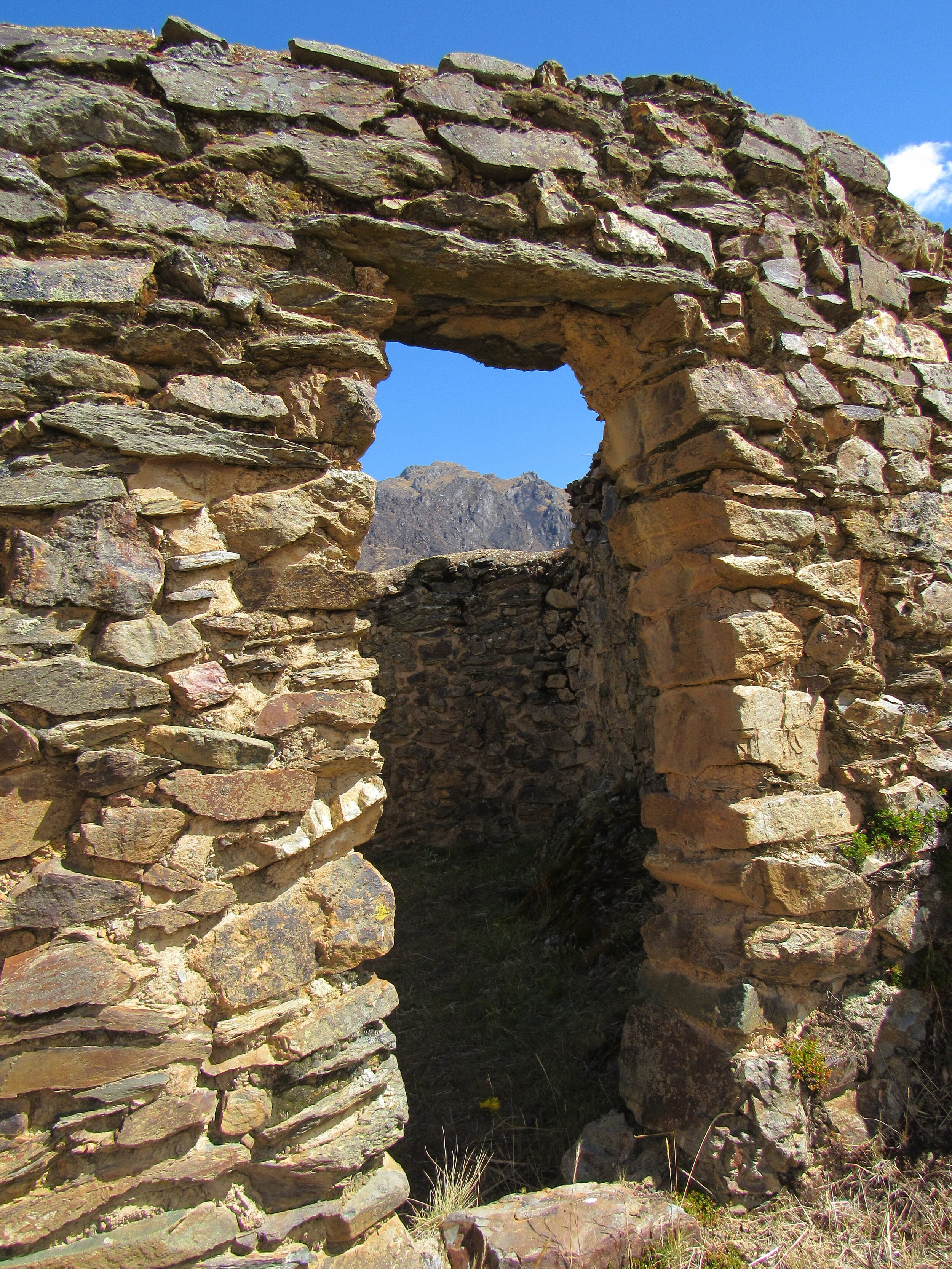

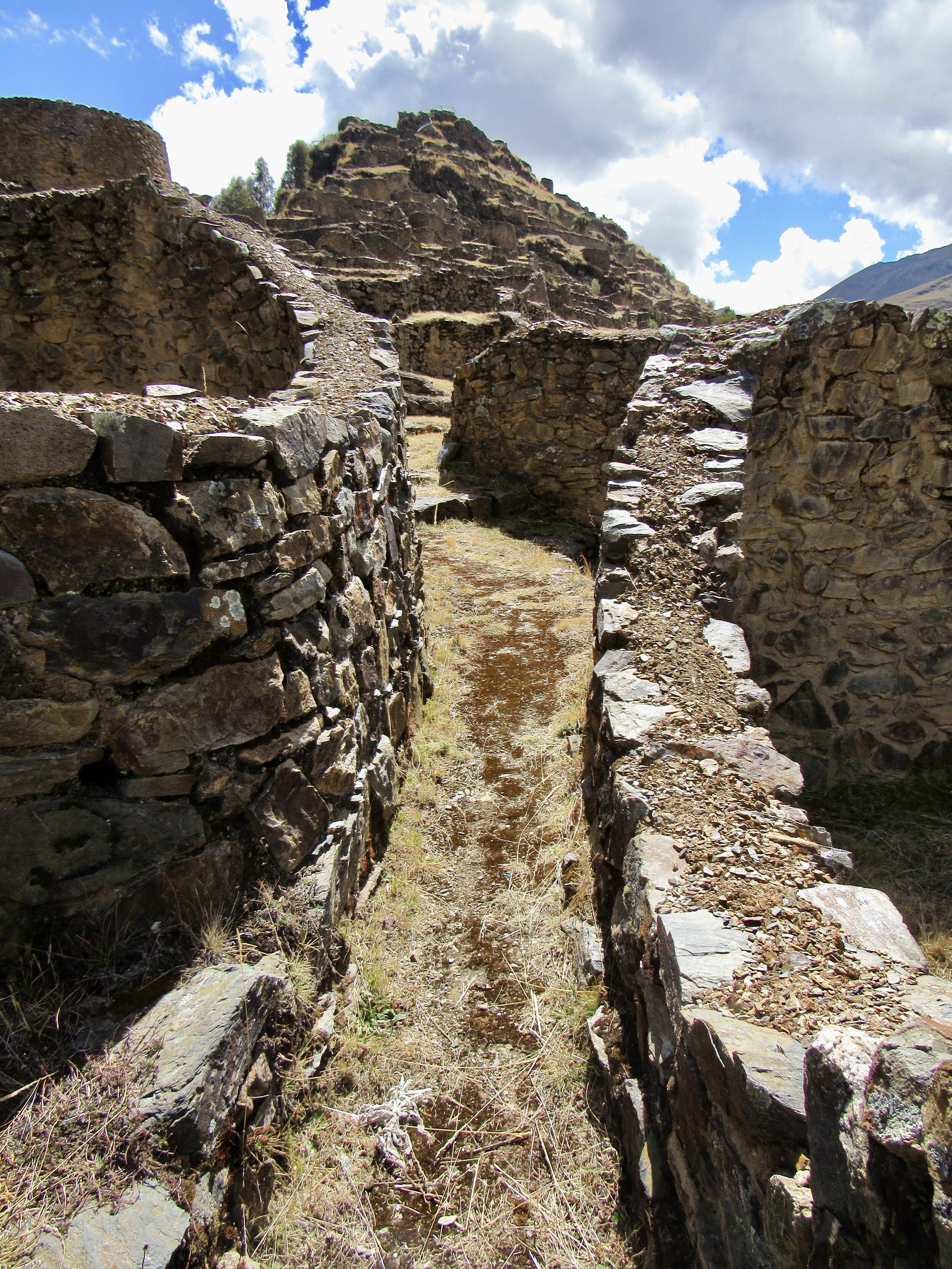
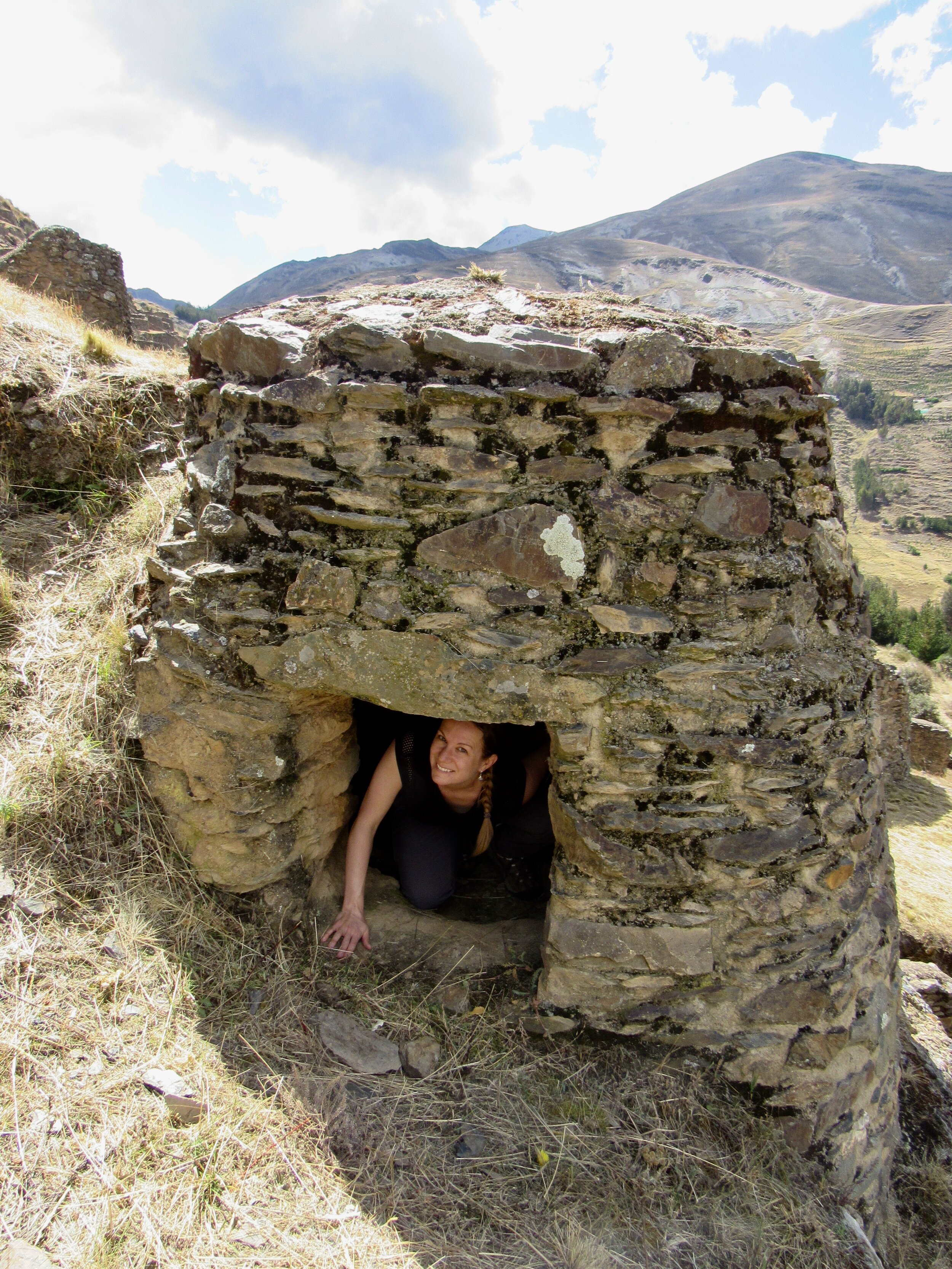
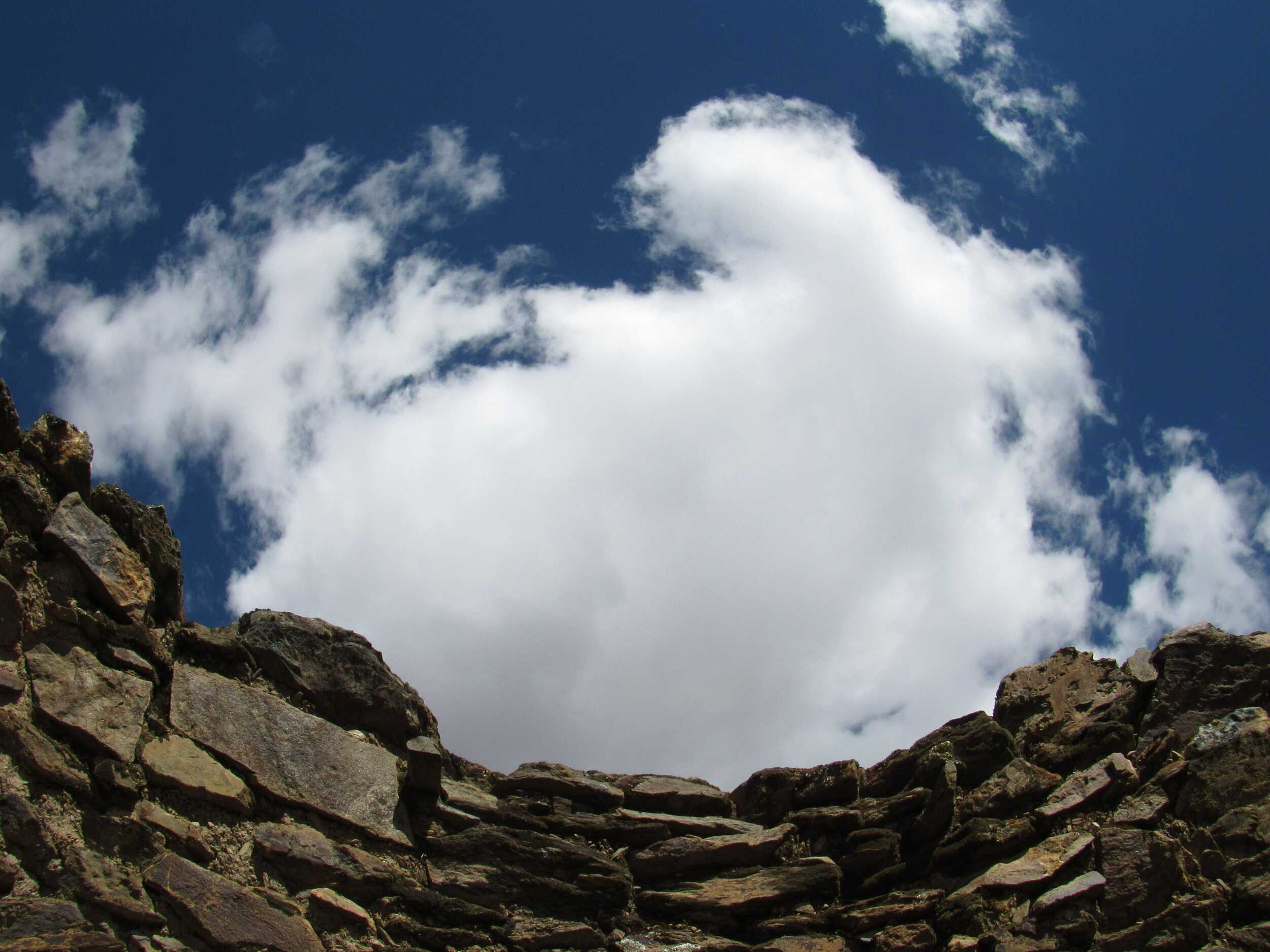


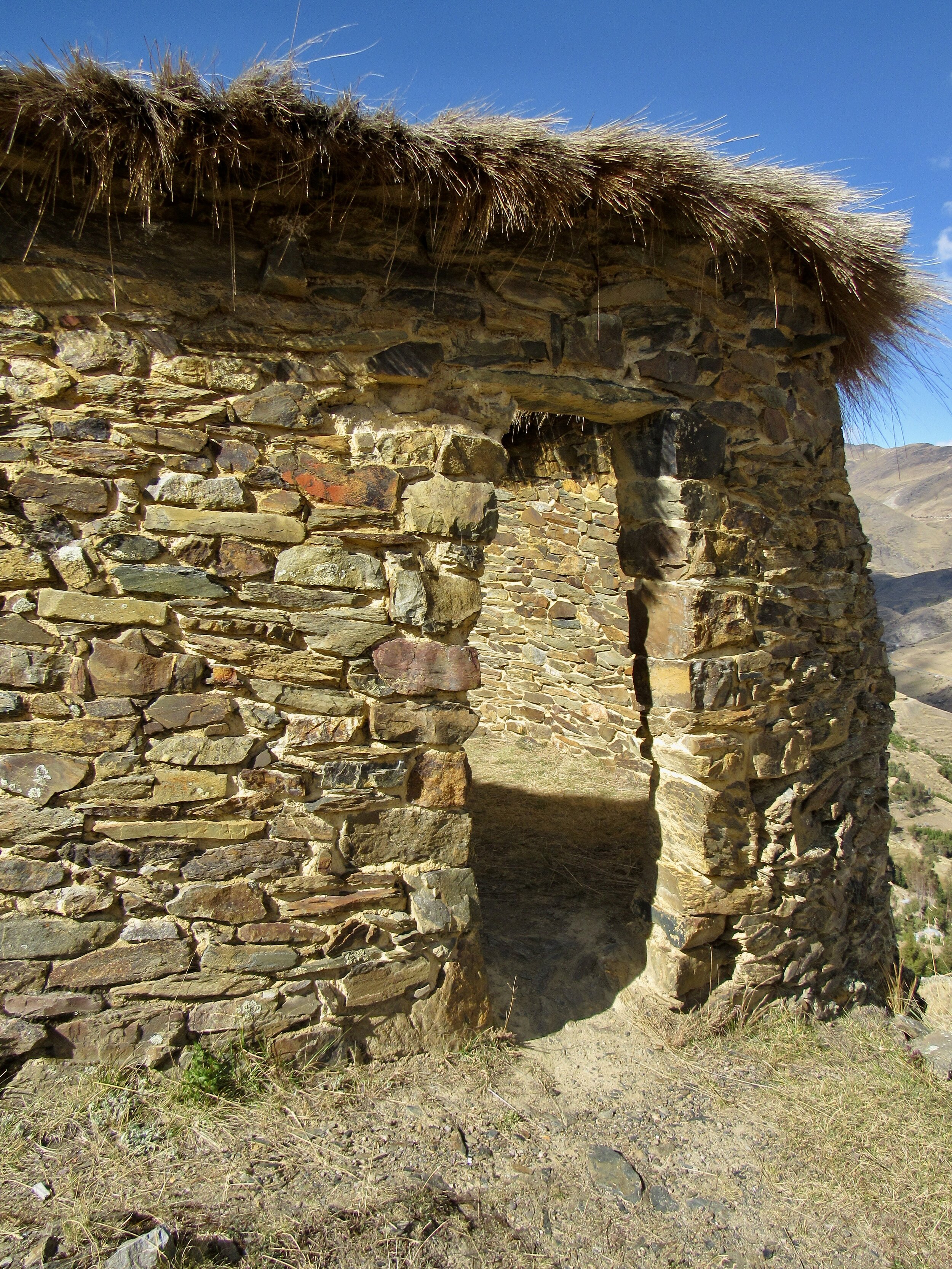

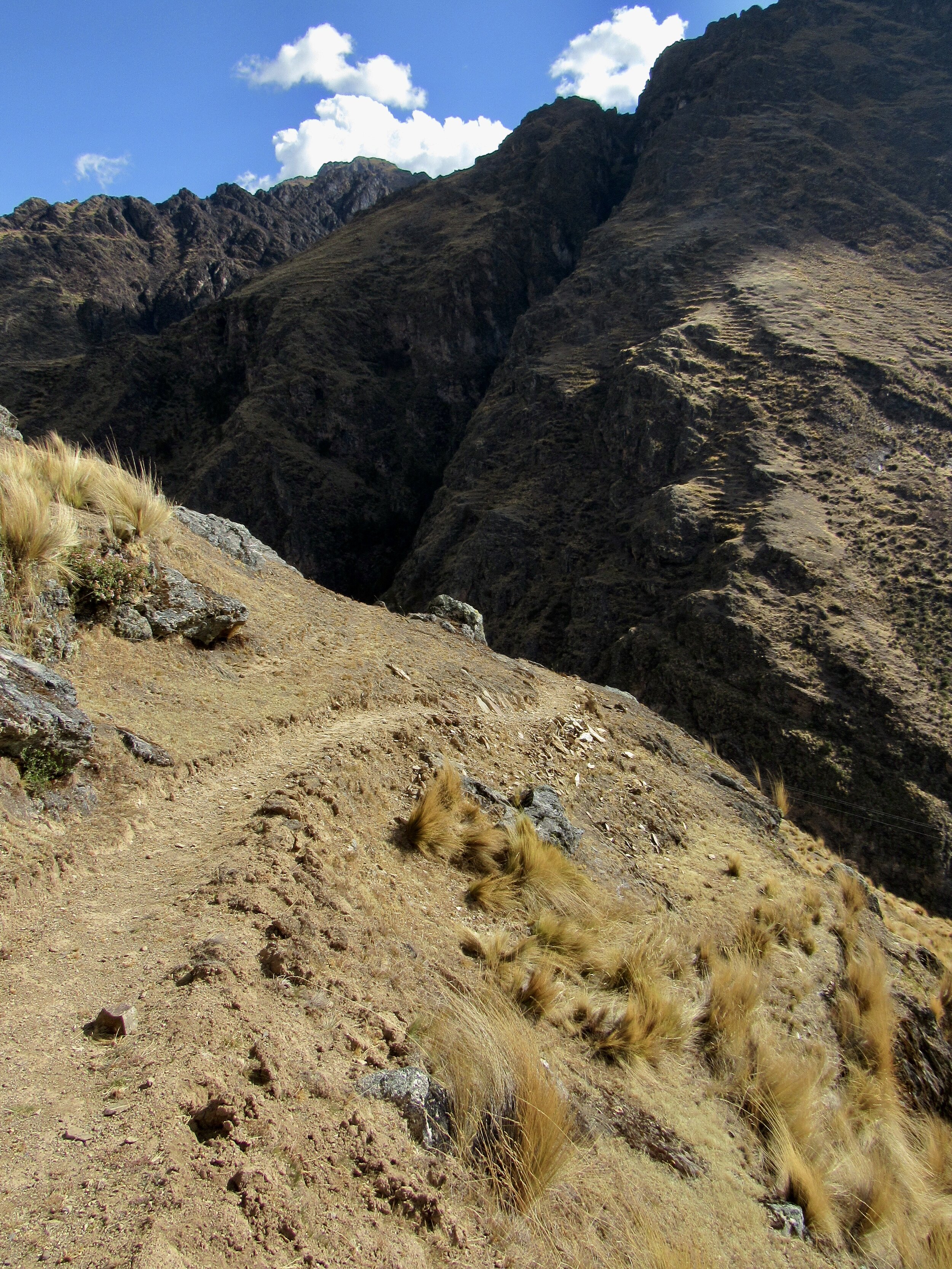
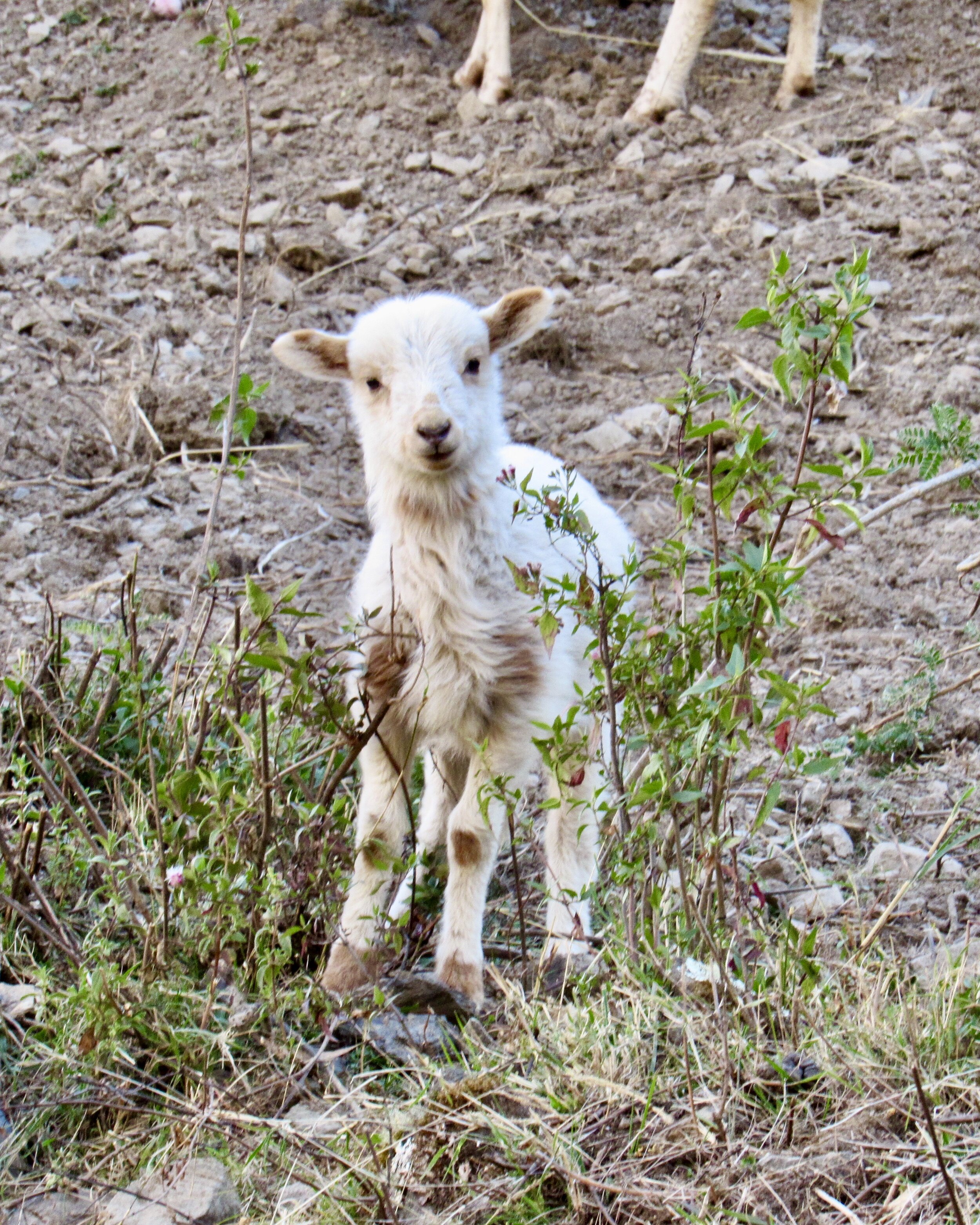

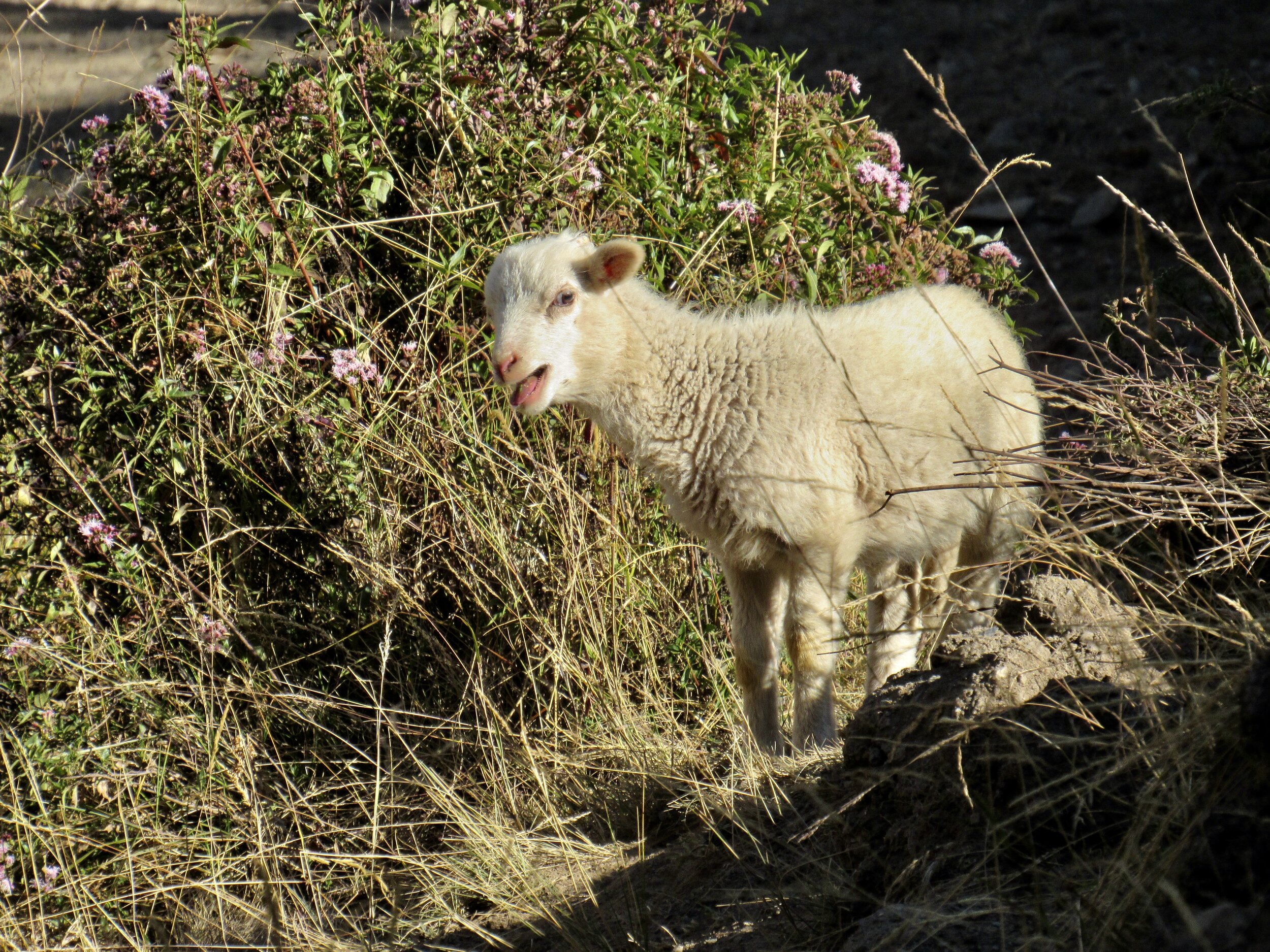
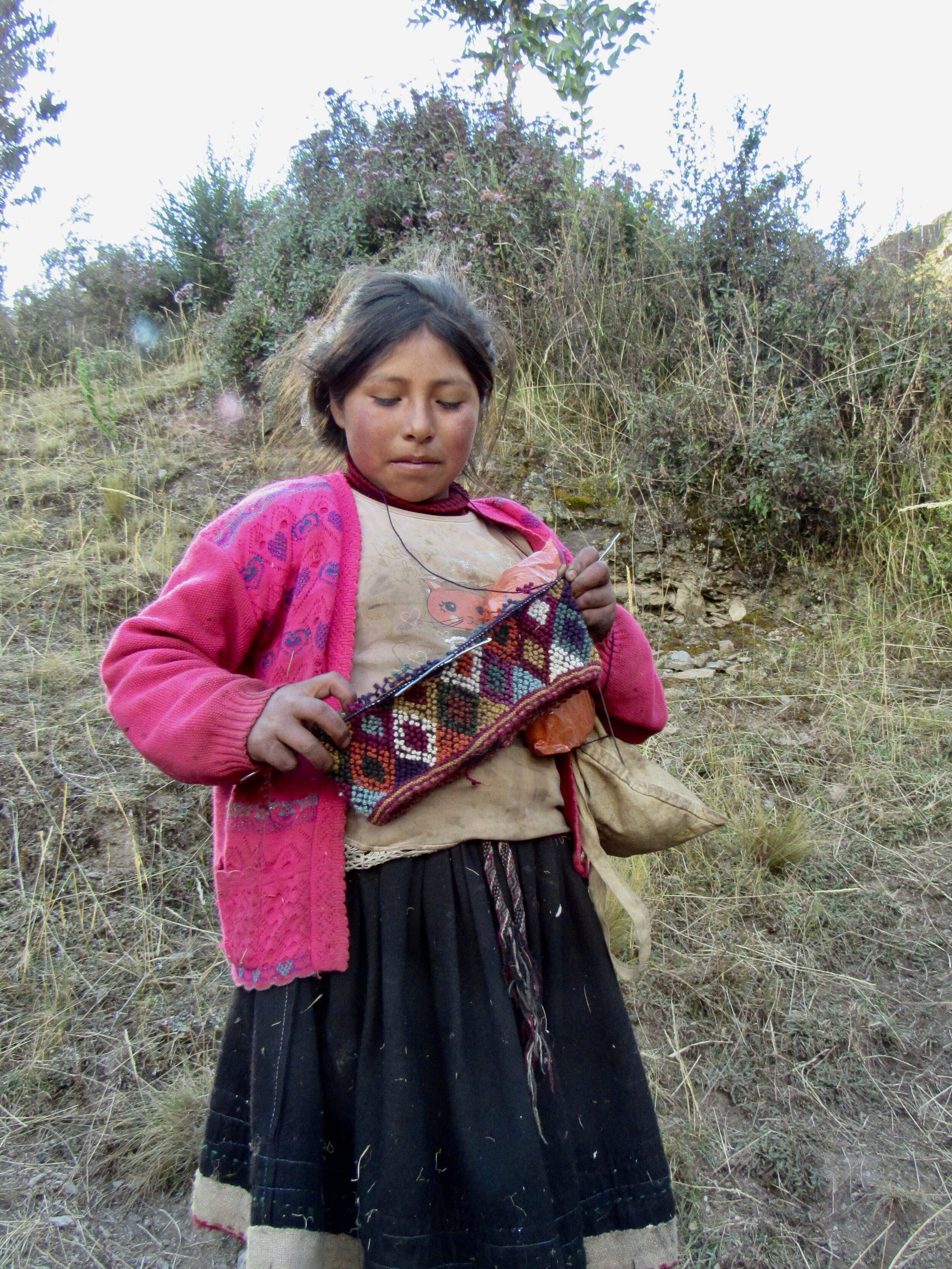
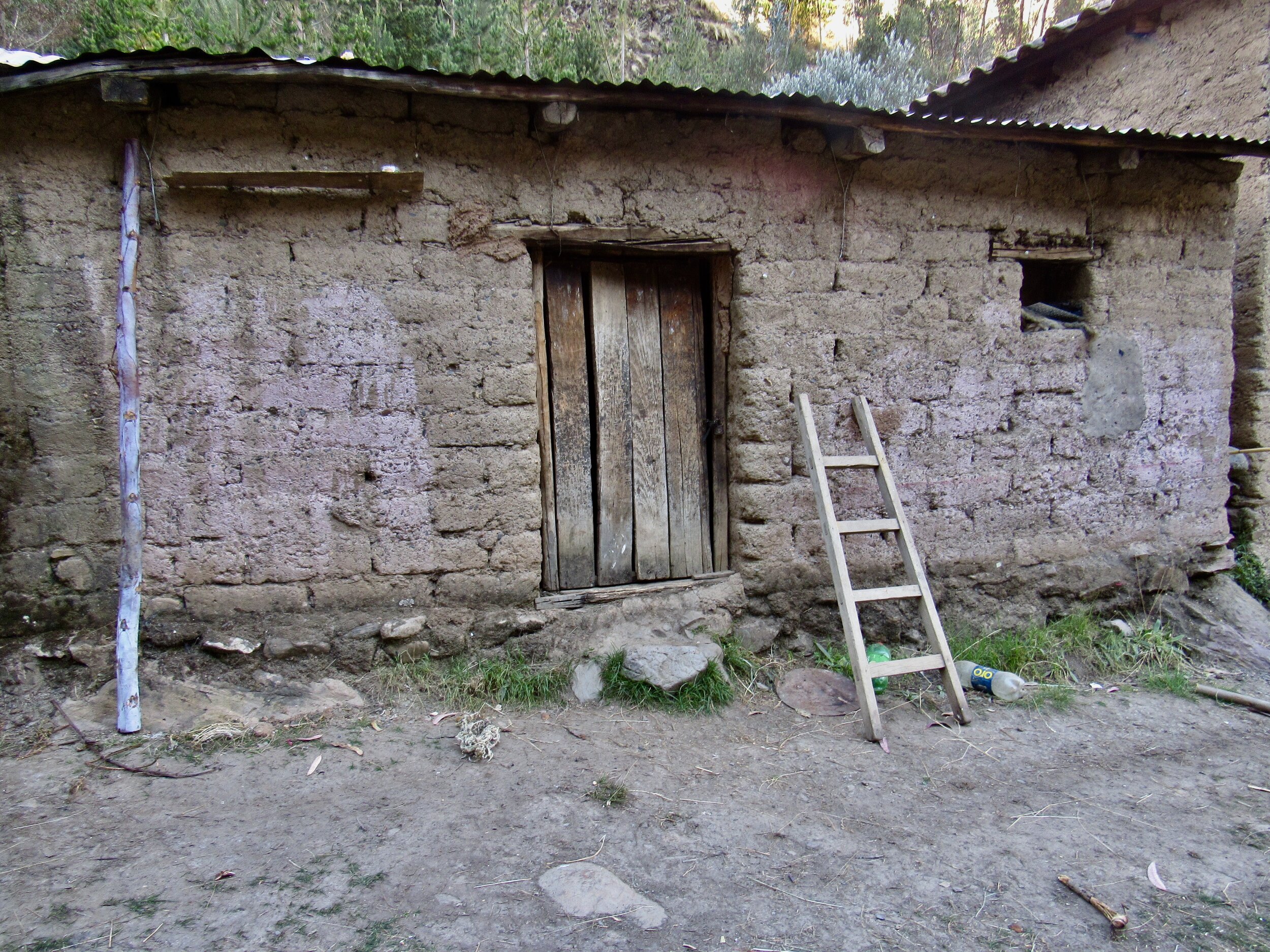
Thursday, 16 July, 2020
This morning I tried to find a place where I could go hiking. Talking with the taxi drivers, I asked about hiking from Cuncani or Quiswarani or anywhere else I could think of. I was informed that each place had a “ronda campesina.”
This is exactly what is protecting Perolniyoc. I don’t have an exact translation of ronda campesina, but basically it’s a security detail for a group of communities who have banded together to keep their communities quarantined. It’s kind of like an unarmed militia. They take turns working checkpoints to keep people out. I applaud their efforts and agree with the necessity of protecting isolated communities even though that means I didn’t get to camp last night and don’t get to hike anywhere today.
Eventually, I asked about going back to Calca. There is one archeological site near the road between Lares and Calca that isn’t near any community, so I asked if that might be protected by a ronda campesina. The drivers agreed that nobody was there and nobody would care, so I asked to be dropped off there.
Ankasmarka is a pre-Inca site, on the Calca side of the pass between Calca and Lares. It seemed reasonable to get dropped off there and then walk back down to Calca. The place really is amazing and I would highly recommend it to anybody interested in pre-Inca architecture and history. There are no homes nearby and I didn’t see any people in the area, so it seemed safe enough. I spent a couple hours there, before walking down towards Calca. The whole time, I didn’t see anybody.
The walk down to Calca is steep, but it was beautiful and I was just happy to be able to walk somewhere. About halfway down I went through the community of Totora, which seemed apocalyptically deserted.
Friday, 17 July, 2020
One benefit of not working online today from 9am to 1pm is that I can go to yoga again at the Temple of the Moon. Last Friday Sonia, who has been teaching yoga online, decided to offer an in person, outdoor yoga class. It was such a success that she has now decided to make it a weekly thing.
It is so nice to have this weekly bit of normalcy. Sure, we’re wearing masks on our walk up to the Temple of the Moon, but it seems so natural to spread out under the eucalyptus trees that it’s easy to be ten feet apart so we can take our masks off. For that hour, I can focus on breathing and moving and not worry about the pandemic.
Unfortunately, when I got home I made the mistake of checking the news. CNN reported that yesterday was a new record high of the number of cases reported in the US. The numbers are skyrocketing and outbreaks seem to be popping up all over the country. As worried as people are in Cusco about our numbers going up as restaurants and malls are allowed to open, I really hope it doesn’t get as bad as it is getting in the US.
So far, Cusco still feels like a relatively safe place to be. The department of Cusco, with a population of 1.2 million people, so far has 2,536 confirmed cases and 30 deaths. That seems pretty good to me compared with Idaho’s 1.75 million people and 13,261 cases with 118 deaths. That’s 21 out of 1,000 people in Cusco with Covid-19 and 75 out of 1,000 people in Idaho with Covid-19. Washington state is even worse. I’m getting these numbers from Google, so forgive me if they’re not exact. Really, I’m just trying to reassure myself that being in Cusco is still safer than going back to the US.
Of course, anywhere on the planet, staying put and staying inside is safer than traveling. If I actually wanted to go back to the US now I’d have to travel to Lima, which has had a terrible and uncontrollable outbreak going on for months now. From Lima, there are few evacuation flights that allow US citizens to leave Peru and most of those go to Miami. Florida doesn’t look too good right now and I have no idea how that is affecting the Miami airport or what a flight leaving Miami to go back to Seattle or Boise would be like.
Regardless, I should just stay home, in my current home, wear a mask and avoid contact with other people as much as possible. That probably means no more attempted camping trips.
Saturday, 18 July, 2020
Today I texted back and forth with my landlord about the two empty rooms in my house. This is a four bedroom house, but Viviana went home to Switzerland on a repatriation flight at the end of March and Andrea went to live with her brother in Lima on June 5th. Kerry and I haven’t worried much about trying to find new housemates because the market is flooded in Cusco with empty AirBnbs and apartments that people can’t afford to live in.
All of the Peruvians I know here have either moved in with family in Cusco or left Cusco entirely to stay with family in smaller towns that are more affordable. So many people are in Andrea’s situation of knowing that there won’t be work for them in Cusco at least for the rest of 2020. Andrea worked in the best restaurant in town, the kind of restaurant that gets reviewed in the New York Times. The owners closed down March 15th and told employees that they might reopen in March, 2021.
Restaurant and hotel workers are in the same boat. There’s no work now and no work likely in 2020. The few restaurants that are opening up for delivery are employing family and friends. People who worked in the service industry, which is such a big part of the tourism industry, have all fled Cusco.
So, when we heard that somebody might be moving into one of the two empty rooms in the house, Kerry and I were curious. Who is moving to Cusco these days? Our landlord herself is tight lipped, but her niece let the cat out of the bag: somebody fleeing Lima.
I am not comfortable with somebody from Lima moving into my house. May 31st was the worst in Lima, with 8,805 new cases confirmed. Yesterday Lima had 3,951 new cases, so it has gotten better, but that’s still a very high number and I still don’t want somebody coming from Lima to share my kitchen with me.
Of course, with two empty bedrooms in the house, it’s inevitable that eventually the landlord will find somebody to move in. Perhaps now is the time for me to start looking at the AirBnbs that have flooded the rental market here in Cusco. Even though I was so thankful to have housemates during the fifteen weeks of quarantine, maybe I would feel safer living on my own now. Kerry and Andrea saved my sanity those fifteen weeks, but now with things opening up, maybe I don’t need housemates to save my sanity. Maybe I’ll actually feel more sane if I live alone.
Covid in Cusco: Week 17
This week I manage to both donate blood and go with the Covid Relief Project for the fourth donation day. We took food to families in need in the communities of Taray and Picol, at the request of the mayor of Pisac, who said that these two communities have been hit the hardest by the pandemic.
Sunday, 5 July, 2020
Today I woke up in a tent, in the middle of the Huchuy Qosqo Inca archeological site. Last night was a full moon and it really was a magical experience to see such an important Inca site lit up by moonlight as if it were daytime.
For breakfast today, the same kid from a nearby farm brought over boiled potatoes, hard boiled eggs and a thermos of hot water. The Inca didn’t have chicken eggs, or anything like the cheese that we had brought with us, but they certainly ate boiled potatoes here. The family had sent a mix of several varieties, each potato about the size of a golf ball. Some were yellow, some a deep purple, some white with a pink center and several other varieties and color variations.
Dinner had been exactly the same: eggs, potatoes and cheese. Partly, it was easier to buy food from nearby farms than to carry our own. Partly, we wanted to support local families in any way that we could. Times are very hard here and even though we don’t have enough donations to have a Covid Relief Project event every weekend, I do want to find a way to help out whenever possible.
After exploring the ruins some more, we headed down to Lamay. The trail from Patabamba the day before had been mostly downhill, with some gentle uphill parts. Today, the trail was a solid downhill and some parts were pretty steep.
Huchuy Qosqo was much easier to get to, and much closer to Cusco, than I had expected. I’ll write a separate blog about the hike with more information about how to find the trail and get to and from Cusco. It’ll be with my other Peru blogs on heatherjasper.com
Monday, 6 July, 2020
This is the first Monday in a long time that I haven’t gotten up for work. I’m considering July vacation, since I got laid off last week and there really aren’t many job options for me now. I’ll start looking for work to start in August, but for now, I can focus on the Covid Relief Project and enjoy not having to work online four hours every day.
I slept in, then finished unpacking my backpack and put all my dusty clothes in the laundry. The dry season is perfect for clear nights of full moon and sunny days, but it also makes every trail very dusty. There are so many treks here that I would love to do before I find another job, but I have to be sure that any communities in the area will let us through before I head out.
The Huchuy Qosqo didn’t take me through any communities that have walled themselves off, but many isolated communities have. Like our visit to Perolniyoc on June 27th, many places have roadblocks and checkpoints created by the families that live there, to protect themselves from outsiders.
A week ago, where we met the families of T’astayoc, I saw the glacial stream that every family in the community uses for drinking and washing. None of them have a well, much less tap water in their home. If Covid started to spread in their community, it would be a disaster. They don’t have any access to a hospital, clinic or even a pharmacy. I am sure that some of the places I want to go would be off limits to me, as a person coming from Cusco.
In Cusco, a lot has changed in the past week, since quarantine officially ended. From March 16th to June 30th, we were only allowed to leave our homes to buy food or get medical help. Up to the beginning of June, we had a 6pm curfew, which later changed to 9pm. Also, nobody was allowed to leave their homes on Sunday, except for medical emergencies. The curfew was strictly enforced by both police and military, although the first offense was just a few hours or a day in jail, depending on how badly curfew was broken. My former housemate Andrea was threatened with arrest by several police on patrol when she took the trash out at 11pm. She quickly ran inside and locked the door behind her and thankfully, they didn’t insist. They got what they wanted after all: she never broke curfew again, not even to take the trash to the curb.
For months I always had my Peruvian permanent resident ID card with me and was always ready with a story of where I was going to buy food, where I lived and why I was out of the house. It was nerve wracking but I do appreciate the results. Nobody in Cusco died in April or May. The only Covid-19 deaths in March were tourists who arrived too sick to go home before they passed away. The handful of deaths in June were people who had come to Cusco from Lima.
Technically, there was no transportation during the quarantine, although obviously there must have been some because supply chains stayed open. Despite the strange obsession with toilet paper in the US, I have never seen a store in Cusco run out of toilet paper. It’s been hard to get good coffee and the specialty chocolates that are usually sold to tourists, but we haven’t really had shortages in Cusco. There was a week when nobody had butter or flour, which led me to assume that I wasn’t the only one stress-baking.
Besides transportation of food, they were very, very strict about anybody traveling between towns. When Henry and I took food to Yaurisque on May 16th, the military didn’t want to let us back in Cusco, even though the mayor of Yaurisque himself was driving us and explained that we were doing humanitarian aid. The same happened on June 6th, when Auqui and I took food to the communities of Sut’uc-Pacchaq, even though the Urubamba police were driving us in an official police vehicle and we had permits from the national police to travel from Cusco to Urubamba and back for that day. Transportation was starting to come back when we took food to T’astayoc and Perolniyoc and the mayor of Ollataytambo said that we didn’t need permits from the police to travel to and from Ollantaytambo. We still hid in the back of the truck at the police checkpoints, relieved that the police never checked the cargo.
As stressful as it may have been for me to be so restricted in only being able to go buy food and get medical help, it would have been much more stressful to have lived through a real outbreak. Being nervous in the streets because there is such a heavy police and military presence is definitely not the same as being nervous in the streets because a high percentage of the population has Covid. Cusco has still been relatively unscathed, compared to many cities in the world and even many cities here in Peru.
I still feel safe in Cusco and I am still glad that I stayed here. The US Embassy facilitated lots of repatriation flights between March 20th and April 20th. Since then there are still some flights that US citizens can get on to go back to the US, although they are very restricted and the US Embassy will only grant transit passes to the air base in emergencies. All of the commercial airports closed on March 15th and have not reopened. All humanitarian or repatriation flights in and out of Peru go from the Group 8 Air Force Base in Callo, next to Lima.
Like most people around the world, when we went into quarantine and total lockdown on March 16th, I never expected that it could possibly last this long. The longest I could imagine it perhaps lasting was into May.
Back in March, besides epidemiologists, did anybody in the world think that this would go on so long?
Tuesday, 7 July, 2020
When I was working, I used to check the news, between emails. I have a fairly low tolerance for bad news, so I kept it to a minimum, and only when I had to be on the computer for work anyway. Now that I’m unemployed, I realize that I haven’t checked the news since I was laid off.
Unfortunately, I didn’t find any good news today. Instead, it looks like my country is still falling apart at the seams. I don’t see any reason for the Black Lives Matter movement to slow down on the protests and activism until we see police forces defunded and until we are able to have elections and vote out more racists and vote in more Black and POC leaders. I also don’t see the disaster in DC changing until after the November election and hopefully a different president being sworn in next January.
In the meantime, the current administration in DC is still wrecking havoc both nationally and internationally. “Wrecking havoc” is putting it lightly, but I’m trying to keep this blog at least somewhat G Rated.
What I saw today that scared me the most was that the US is withdrawing from the WHO. How in any alternate universe, could this possibly be a good idea in any way? I don’t care what the criticisms of the WHO are in normal times, or how many different structural changes are needed in the organization. We are in the middle of a global pandemic!
It may be wishful thinking to say that we’re in the middle of a pandemic. It is entirely possible that we are still at the beginning of a global pandemic. I’m trying to imagine communities like T’astayoc managing to not have any virus exposure until a vaccine is not only created, but globally available. If the virus does get to their community before everybody in Peru is vaccinated, how bad will it be? Will the death rate be as low as in many other high altitude communities? Can they keep themselves isolated until Peru has enough doses of vaccine to actually protect them? What will they eat between now and then? How long can they survive on the food that I took to them a week and a half ago and whatever they can grow? Will they have to eat all of their alpacas?
Tourists will come back, eventually. We do have Machu Picchu. The questions is, how long will it take and how will people survive between now and then? Can all of these isolated, indigenous communities high in the Andes go back to subsistence farming and survive with their potatoes, quinoa and alpaca? If they have to eat all of their alpaca, how will they have wool to make alpaca scarves and sweaters to sell to tourists? Will they need all of that wool for themselves, since it will be so dangerous to go down to town to buy clothes?
The problem of everything being so unknown and unknowable is global. The unemployment crisis is global. The travel restrictions and isolation are global. I try not to let all of that overwhelm me. It’s just too much. I try to focus on how I will get myself through and how I can help people here.
I also try to focus on the positives. I really do think that Cusco is the safest place for me now. I do see people banding together and helping their neighbors more than before. I do see some silver linings to the situation that we’re in, here in Cusco. I also see things that I can do to make things at least a little easier for other people here. If I can stay focused on all of that, I’ll be okay.
Wednesday, 8 July, 2020
My cousin Isaac and his girlfriend Jordyn wrote to me last week that they were donating blood. I’ve been asking Isaac for advice as I try to make some videos about the Covid Relief Project. I suppose one of the silver linings of the pandemic is that it has given me the time to teach myself how to build a website and I’m still finding other things I can learn to keep my mind busy. Making videos is the most recent one, with the goal of using them to find more donations for the project.
So, when a friend here in Cusco said that they are looking for O+ or O- blood donors, I quickly volunteered. The transfusions are for a girl named Killary who needs a bone marrow transplant but can’t get to Lima for it.
The hospital that Killary is at is Antonio Lorena, about a half hour walk from my house. This is also the newly set up contingency hospital, devoted entirely to Covid. The blood bank is next to the Covid hospital, so thankfully I don’t have to actually go in an area with Covid cases. It’s crazy how nervous it makes me, to even be next to the Covid hospital. What would it be like to work there? To have to go there every day? What would it be like to have Covid in Cusco and be a patient at what looks to me like a tent hospital. From the outside, it reminds me of the tent hospital on the old TV show M*A*S*H.
At the gate, I say that I’m there to donate blood. The guard gives me a look that either says “You shouldn’t be here” or “I don’t want to let you in here.” After I assure him several times that I do know where the blood bank is and that I am really there to donate blood, he lets me in. I don’t actually know where the blood bank is, but there are enough people around to ask that it’s not hard to find.
All doors along the hallway are closed and all open windows are covered with plastic. I knock on the wall next to the window labeled Banco de Sangre and after a few questions, they open the door and let me in. I’ve given blood before in the US and in France, but the questionnaire here is even more thorough and invasive. Some of it seems antiquated but maybe that’s just my perspective on a Catholic country’s morals.
I got a finger prick so they could verify my claim to be O+ and then they asked me to wash both arms up past the elbows. There was only one other person at the blood bank to donate and she was leaving as I arrived. I asked if they had fewer donors since the pandemic started and they said that it had become a big problem. People are afraid to go to the hospital because it’s next to the new Covid hospital and it’s getting harder and harder to find donors.
The actual process of donating blood was exactly the same as it had been in the US and France. I didn’t expect them to have anything for me to eat or drink afterwards, but I brought a liter of orange juice with me and my housemate Kerry gave me a chocolate bar to take with me. They asked me to sit and rest for ten minutes after the donation process was finished. I enjoyed my chocolate and drank some orange juice and tried to chat a bit with them.
There were three women working at the blood bank and they were all busy with stacks of paperwork and big binders. There was a TV in the room, but no computers. There were only three chairs for donors to sit in and the place felt somewhat forgotten. I asked how soon I could come back to donate again and was told four months. This seems excessive to me, since in the US it’s eight weeks. I wonder how good their paperwork system is and what would happen if I came back to donate again in eight weeks.
I took a cab home, instead of walking. Cabs here are supposed to have a plastic wall separating the driver from those in the backseat. Some have a little flap in the wall so you can pay from the back. Some have a solid plastic wall and you have to pay through the window. The only cab that was waiting outside the hospital had neither. It really did not look like a cab at all and I wouldn’t have bothered to ask if the driver hadn’t waved at me and asked where to.
People are doing what they can to make ends meet and if this guy is using his caras a taxi, I’m not going to complain. There are a lot of ways to help people get through this pandemic. Donating blood and taking food to isolated communities are great, but there are an endless number of small things that we can do to help in other ways.
Thursday, 9 July, 2020
Today I tried to work more on the videos of our visits to T’astayoc and Perolniyoc and also the interviews that I had videoed with community leaders of both communities. I managed to produce a video about the day with the families of Sut’uc-Pacchaq but it was clearly an amateur effort. I have a lot to learn about making videos.
That’s another of the silver linings of this pandemic. I have had the time to learn a lot of things that I wouldn’t have otherwise been able to tackle. I taught myself how to make a website with Square Space and am now trying to teach myself iMovie.
I’ve heard from a lot of people who have found time during the pandemic to work on more creative pursuits. My cousin Betsy has been designing knitting patterns and selling them online. My cousin Isaac has written a screenplay. My friend Amanda reorganized her whole apartment. It’s been interesting hearing about all of the things that my friends and family have time for, now that we can’t go to restaurants or concerts or sporting events. I’m sure this is a global phenomenon - for the upper and middle class.
One of the reasons that the pandemic outbreak is so bad in places like Lima is that there are so many people who used to live with what they made each day. How can you stay inside or social distance when you have to sell fruit or shine shoes on the street every day? How can you avoid crowds when you work at a market? Essential workers and people too poor to stay home really don’t have a choice. That’s a global phenomenon too. Social distancing is for the rich in so many places around the world.
Friday, 10 July, 2020
This morning, after I posted another last minute plea for donations for the Covid Relief Project, Kerry and I went to an in person, real yoga class up at the Temple of the Moon. It was a small group, but the instructor, Sonia, has been teaching online yoga classes for months now and just wanted so badly to see real people. The six of us who came to the class wanted just as badly to have a real yoga class with real people.
We met at the San Blas market and walked up towards the Temple of the Moon, stopping under some of the eucalyptus trees that I walk by on my hikes up there. It’s also the spot where I almost always see kestrels hunting for mice in the grass under the trees. While we were going through the yoga postures, I heard hummingbirds whir by and kestrels screeching up in the trees.
We all had our mats six to ten feet away from each other and I think that everybody took off their masks. It was still such a relief to be able to be outside with people and not worry about arrest or even the virus anymore.
The police are still patrolling just as much as during the quarantine, but the military have vanished from the streets in my part of town. I see them at checkpoints leaving or entering the city when I leave Cusco for the Covid Relief Project, but they are gone from my neighborhood. I am starting to lose that automatic rehearsal of why I have left my house when I see them.
Also, with the research showing that most people catch the virus from close contact with an infected person, not from surfaces, I’m a lot less worried about what I touch. I’m still glad when shop keepers spray my change with alcohol before they give it to me and I’m still glad that masks are required in all of Peru. But I am so much less worried about actually catching the virus that I was in March in April.
Being able to go outside without the fear of arrest or Covid has made a world of difference in my quality of life. I just hope it stays this way, as I see news of other countries going back into quarantine when a second save of infections hits. Fingers crossed!
Saturday, 11 July, 2020
Today was the first time that Kerry joined me and the other volunteers taking people food for the Covid Relief Project. It was a much bigger group than the previous three times, which was really fun. The more the merrier!
Kerry, Henry, Auqui & I met at Wagner’s in the morning, helped load everything into the van that was sent by the mayor of Pisac and hit the road. We drove to the main square of Taray, where we picked up Edy, then drove to a road bordering the fields, where the families were waiting for us. It was a hot and dusty spot, but the people were so grateful that it was more than worth it. Edy is from Taray and put together the list of families who really need help now.
For each family, we had enough donations to buy 5 kilos of rice, 1 carton of UHT milk, 1 liter of vegetable oil for cooking and nine small bags of oatmeal. We tried to get larger bags, so we could give each family one bag of 2 or 3 kilos, but the supply chain just isn’t what it used to be.
After we had distributed the food to all of the families on the list, plus a few extra, one of the community members brought us corn, called paraqay. It was the giant white kernels that are taken from the cob then boiled to make mote. Edy then invited us to his home where his mother served us an early lunch of boiled potatoes and cooked carrots before we left for the second village.
Picol is almost an hour drive from Pisac, up another very dusty road. At the entrance to the village there was a chain across the road, padlocked to a post. We waited for somebody to come let us in and used the handwashing station that they had placed next to the checkpoint. This is another one of those isolated communities that has no cases of Covid in the area and who are doing a good job of staying isolated enough to keep it that way.
We met with the gathered villagers and they brought us boiled potatoes and a spicy green chile sauce to share before we began the distribution. Despite all of the corn and potatoes that I had already eaten that morning, it wasn’t hard to eat a few more. They really are that good.
In Picol most of the assembled villagers were elderly. I was a little worried about them, since the pandemic has been so much more deadly for the elderly. In Taray, most of the people who came to receive their family’s food were in their 20s or 30s. Here, it appeared that all of the younger people were working in the fields.
Before we left, the people still came to give us more hugs than I expected - or than were probably safe. Despite being positive that none of us were sick, it was still a little unnerving to see elderly people from an isolated community come to hug a person from Cusco. Like T’astayoc and Perolniyoc two weeks ago, Picol does not have any access to a hospital, clinic or pharmacy. The community has a primary school, but no other services. If the virus did start to spread through their village, it would be devastating.
Still, I believe that we are doing more good than harm and that we have all been very careful to follow all Covid hygiene protocols. I know that tourists won’t be coming back anytime soon and we will likely be needed throughout 2020, if not partly into 2021. I want to keep taking food to people and hope that we can continue to do it in a way that keeps these isolated mountain villages free from the virus.
Covid in Cusco: Week 16
Peru is finally opening up enough that archeological areas are open! I got laid off this week but am taking advantage of the time off to go camping and backpacking more. My first camping trip was on the 4th of July weekend to Huchuy Qosqo.
Sunday, 28 June, 2020
Day 109 since Covid arrived in Cusco
Today is going to be the last Sunday that nobody is allowed to leave home. I doubt that many businesses will be open next Sunday, but at least leaving the house won’t be cause for arrest. As things start to open up in Cusco, everybody I know is worried about case numbers going up. I think it’s unavoidable. We can’t hide in our homes forever, but any increase in contact between people is going to bring more contagion.
There are a few things that reassure me that a spike in cases won’t be a complete disaster. First, we know a lot more about the virus now. Countries all around the world are studying every aspect of this virus and we know a lot more about how it’s spread and how to treat it. Second, hospitals are much more prepared now than they were in March. When this first started, hospitals were so quickly overwhelmed and hopefully they will be more able now to treat a spike in numbers. Of course, that might not be the case in many parts of Peru. (See my blog last week and my June 23rd description of this article).
The third thing that I’m really holding on to is how different this virus affects people at high altitude. Cusco is at about 11,000 ft / 3,500 m. Studies have shown that people who live over 3,000m are less susceptible to life-threatening complications if we contract the virus and also that the virus itself is less contagious at high altitude. I still think that Cusco is a safe place for me to wait out this pandemic.
Monday, 29 June, 2020
Yesterday I mostly rested after all of the excitement from Friday and Saturday. Friday night was the first time I’ve been able to spend a night away from home since the quarantine started. Actually, it was my first night away from home since Amanda was here to visit in February.
These journeys up into the mountains make me feel both hopeful and hopeless at the same time. I am so thankful to be in a position where I can connect people who want to help with people who need help. I’m also thankful to be in a position where I can actually use all of the donations to buy food. However, the position that some of these families are in is pretty dire. They haven’t had work in months and don’t really have much hope for work this year.
In my fundraising and my personal outlook on these communities, I’ve been focusing mostly on the fact that the hard stop in tourism had taken away their jobs. However, the longer this goes on, and the higher the case numbers get in the rest of Peru, the more I see another side of the difficult situation that they’re in: none of these communities have any Covid cases.
Of course, not having ay Covid cases is a good thing. However, that means that any trip down to town risks bringing the virus back up to the community. As in the case of T’astayoc, some communities don’t even have a well for clean water, much less access to any kind of medical care, or even a pharmacy. Getting up to Perolniyoc involves getting past a checkpoint with a locked metal gate, where community members take turns keeping out unauthorized visitors. It also serves as a checkpoint for anybody leaving the community. Of course, none of them have cars and it’s easy enough to walk around the gate. It still serves as a checkpoint and people have to really think about the risk that they put everybody in if they are exposed to the virus while in town.
Taking food, and now children’s clothes, up to these communities not only helps provide food for hungry families who have no work. It also helps provide food for hungry families who shouldn’t risk going to town to try to find work or buy food.
Tuesday, 30 June, 2020
While dealing with work emails this morning, I got a call from the agency’s accountant. The day that we have been dreading is here. The trekking agency is officially broke and will be filing for bankruptcy. Tomorrow I will be officially unemployed.
The agency owner also has a hotel and some other businesses connections, so maybe I can still get some work through him, even if I’m paid by the hour rather than as a salaried worker with a contract and benefits.
Even though I knew that this was a possibility and even though I have savings, it’s still hard news to get. I’ll get paid tomorrow for June, which will see me through July, before I really have to start in on my savings. At least in the past three months I’ve learned to live on 50% of the salary that I used to live on before.
I’ll never really know what it’s like to be unemployed in Peru, because not only do I have savings, I also have friends and family who would be happy to send me money if I needed it. There is no such thing as unemployment benefits in Peru, so everybody else in the country who has been laid off has been burning through their savings for several months now. The situation is so bad here that I know Venezuelan refugees who are receiving money from relatives in Venezuela. That’s something that’s hard to wrap my head around. People in Venezuela sending money? Inflation is so bad there that filling up a tank of gas is the equivalent of a month’s wages. How do they have any money to send to Peru? The whole point of emigrating to Peru is to be able to find work and send money to family in Venezuela.
Here’s hoping that tomorrow I’ll be offered some kind of work, even if the trekking agency that I’ve been working for is bankrupt.
Wednesday, 1 July, 2020
I got a message at 7:30 this morning from the boss. There is no work. He has nothing for me, but tries to sound optimistic. He reassuringly says that in August people will start booking their treks for 2021 and we will start getting some income as people put down their deposit on their 2021 trip.
I am not reassured. The way that cases are surging in the US, and the way that Europe is opening up tourism just for people to travel within Europe, I don’t see people planning trips to South America anytime soon. I hope that I’m wrong.
I did some math last night and I can definitely get through July without any income. Considering that there are no jobs to be had in Cusco, I’m not going to waste my time trying to find one. I’ll spend July focusing on the Covid Relief Project, working on my Quechua and maybe even going backpacking.
July is the best month for backpacking in the Andes around Cusco. Even with some travel restrictions opening up, it will be a while until there are flights and travel between different regions of Peru. I might as well take this time to see some of the places that I’ve wanted to see in the Cusco region. At the top of my list are Huchuy Q’osqo, Ausungate and Choquiquerao. Considering that most of my friends are also unemployed, it shouldn’t be too hard to find somebody to go with me.
The real irony here is that today the Peruvian government announced that hotels and travel agencies will now be allowed to operate again.
Thursday, 2 July, 2020
Today I went to see Jorge, to let him know that July 11th will be the next big day. I told him that we will be buying for 100 families and that we definitely are planning on the 5kg of rice and 1 liter of vegetable oil per family. I also asked if it’s possible to get any oatmeal this time.
The past few weeks, all stores and wholesalers in Cusco were sold out of oatmeal, so we couldn’t take any to the families of T’astayoc or Perolniyoc.
Oatmeal might not be anything special in the US, but it’s a real treat here. It’s also one of the very few products that are fortified with iron, calcium and vitamins, which makes it something that parents really wish they could afford for their children. Kids here don’t drink milk or get bread made with fortified flour. Especially when families have had to go back to subsistence farming, they only have corn, quinoa and potatoes to feed their kids.
Jorge told me that he is having a big problem with overstock of things that hotels ordered from him, then didn’t pay for when they closed. He has hundreds of bottles of orange juice that expired in March. He gave me a couple bottles for free, to prove to me that the juice is just fine, even if the date has passed.
He said that he would love to give me 100 bottles for families to have, for free, but that he is worried that they would be offended if we gave them expired food. I told him that when we set up to distribute, we line up all of the food with one volunteer handing each item to those who come through the line. What we can do is put the juice at the end of the line, where people can take one, if they want. We just won’t hand them to people directly.
Friday, 3 July, 2020
As long as I’m unemployed, and not tied to wifi for work, I’m going make the most of it. July is perfect backpacking weather, so I might as well plan some camping trips. The two places I want to see the most are Mt. Ausangate and Choquequirao. It still might be a bit soon for those though. Travel in the area is getting easier and police permits are not as necessary as in May and June but I wouldn’t be surprised if the communities I would pass through wouldn’t really want outsiders there.
Last Saturday we had to go through a community checkpoint leaving the main road to go up to Perolniyoc. The woman at the checkpoint was expecting us and unlocked the gate, but I’m sure that Perolniyoc isn’t the only community around here that has decided to protect itself by keeping out strangers. Huchuy Q’osqo is a shorter hike and I bet the communities in the area wouldn’t mind me coming through. The communities that I’ve been bringing food to have been happy enough to see me, so maybe I should take some food to share.
Just to be on the safe side, I walked across town to where you can buy popcorn and other snacks in bulk. I got three kilos of puffed giant corn, which is different from what we call popcorn in the US, and some small bags to make it easier to give out. Back home, three kilos ended up being 53 small bags of puffed corn. If I can’t find 53 kids on a two day backpack trip, then I’ll have plenty of puffed corn to eat on the way home.


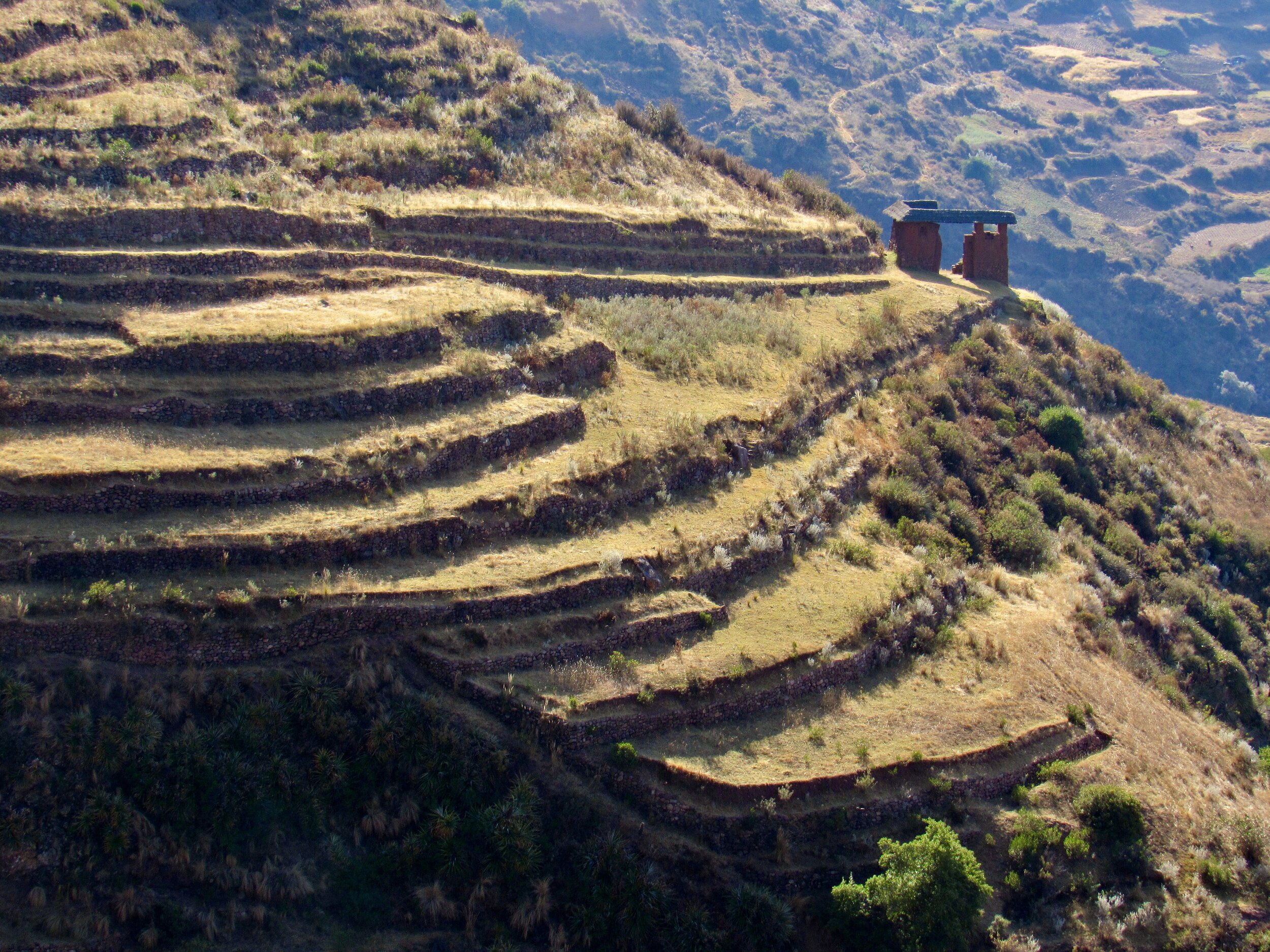

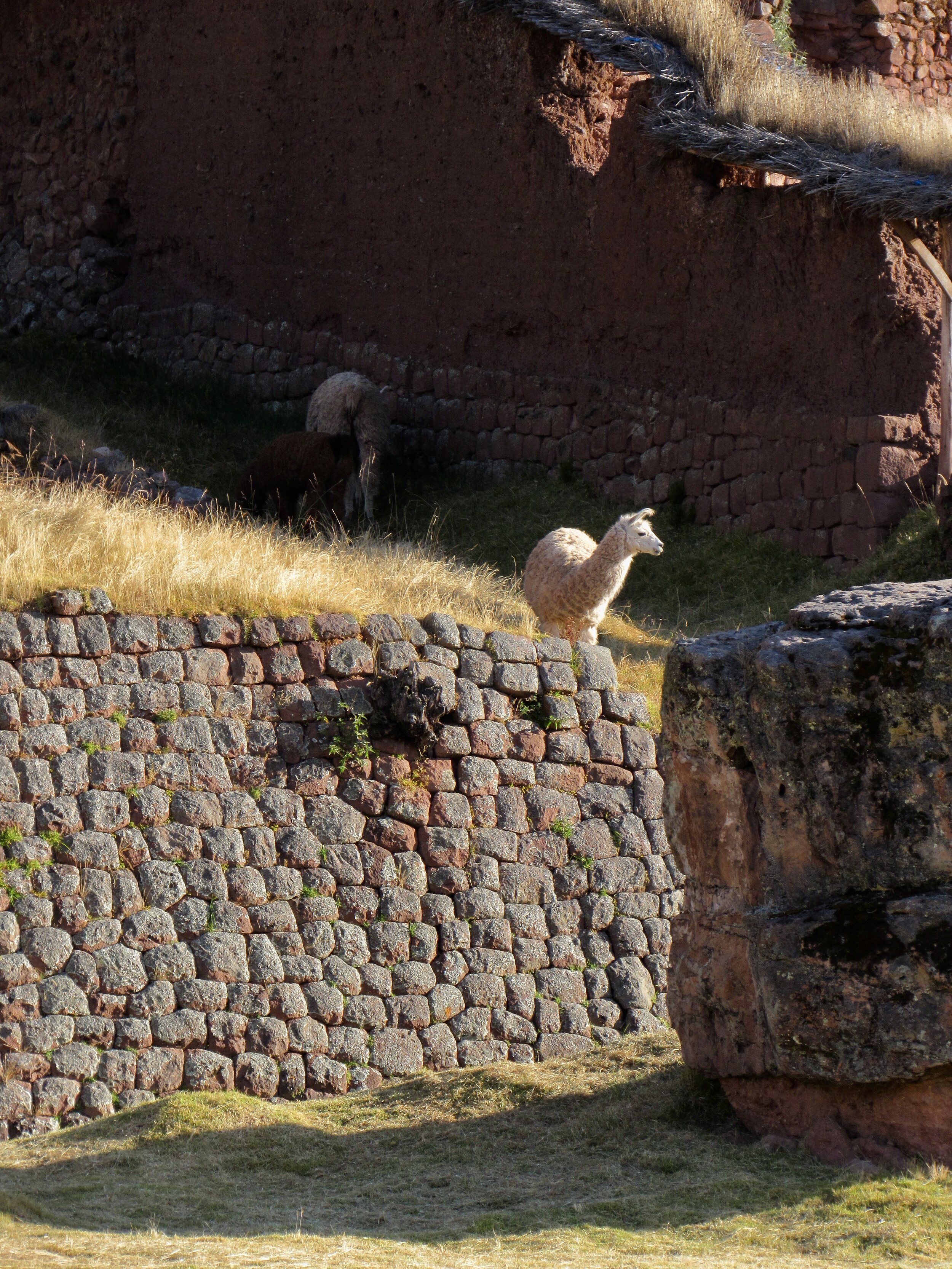

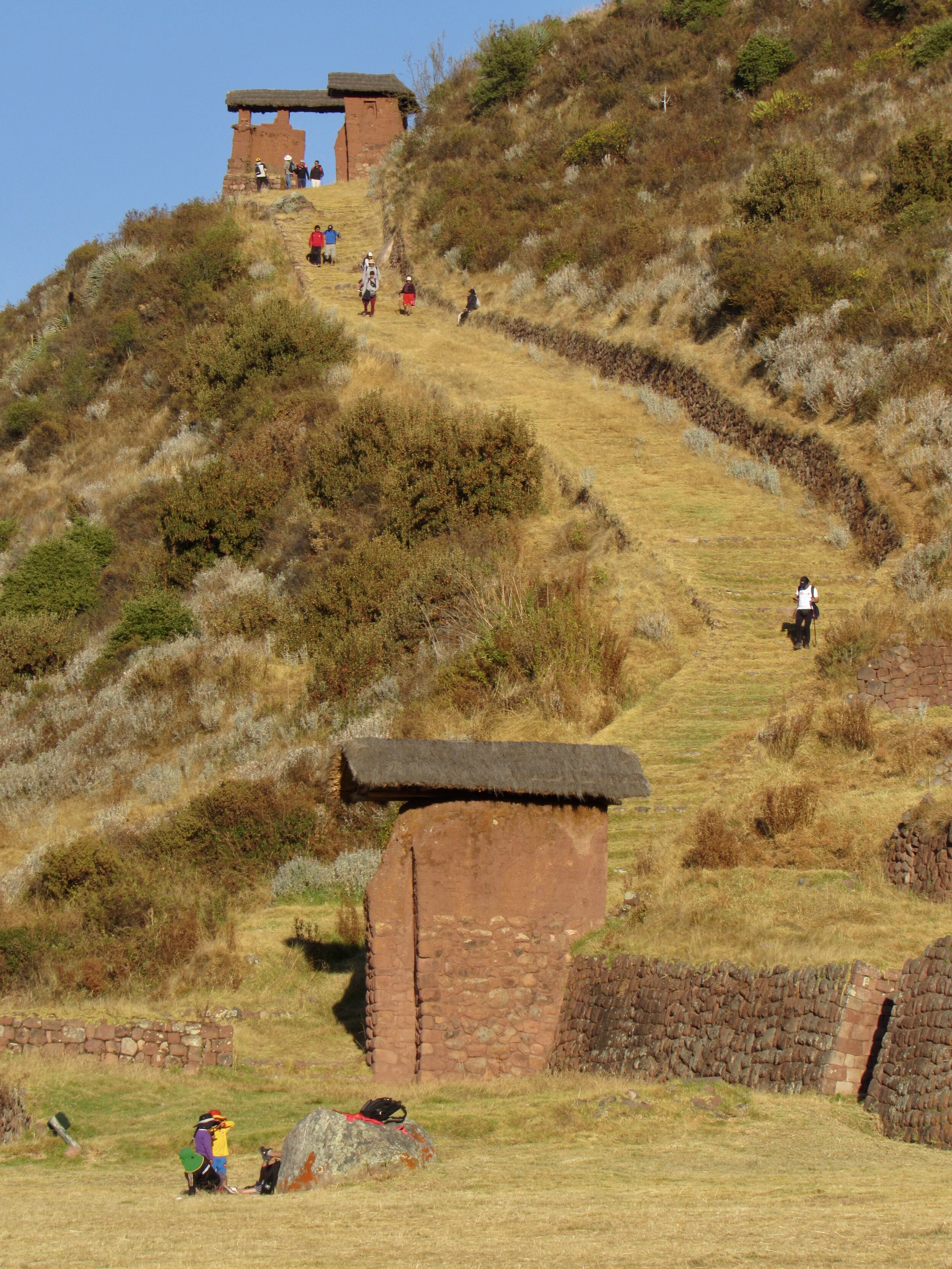
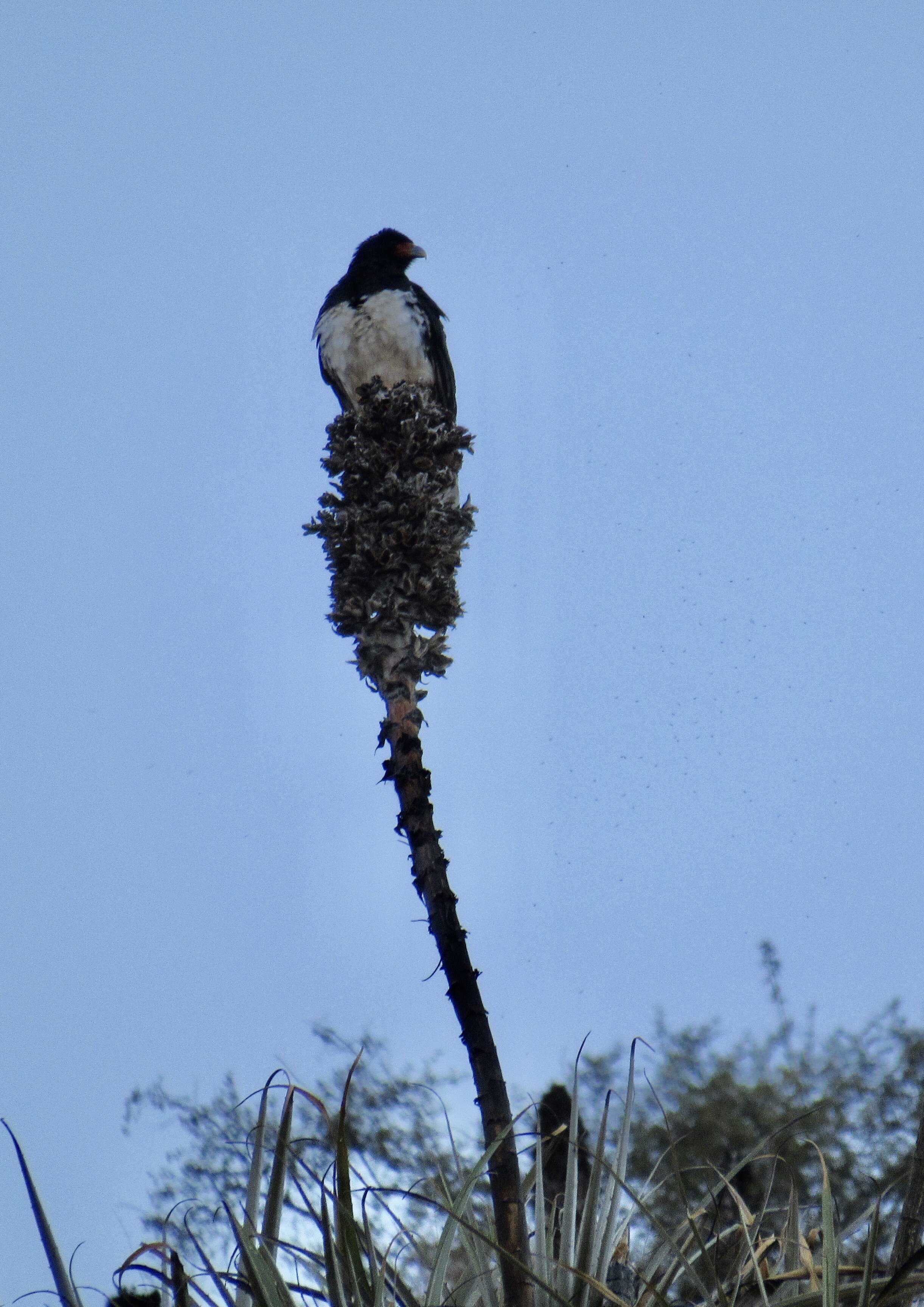
Saturday, 4 July, 2020
Today, for the 4th of July, I did one of the most American things I could think of: I went camping. I will write a blog about the trek itself, mostly to tell people how to get there and find the trail and get back.
My blog used to be only about these sorts of trips. I blogged travels in other countries and weekend trips near where I lived. Many of my blogs were specifically for other travelers to share information on how to get places and what to do when you got to La Paz, México or to Kota Kinabalu, Malaysia.
The pandemic has flipped even my blog on its head. How did I go from writing about trekking the Inca Trail and places to visit in Cusco, to writing about how restrictive the quarantine was in Cusco for three months.
Now that things are opening up, and I can go places again, I hope to get my blog back to normal. Just like we all wish things could go back to normal. Of course, blogging about traveling in Peru and places to see around Cusco will still be full of photos of people with masks on and information about how to follow the Covid rules here. The pandemic is here to stay and nothing will actually feel normal for a very long time. Still, the more that I can get out of the house again and enjoy living in Peru, the more that I will feel that at least my blog can get back to normal.
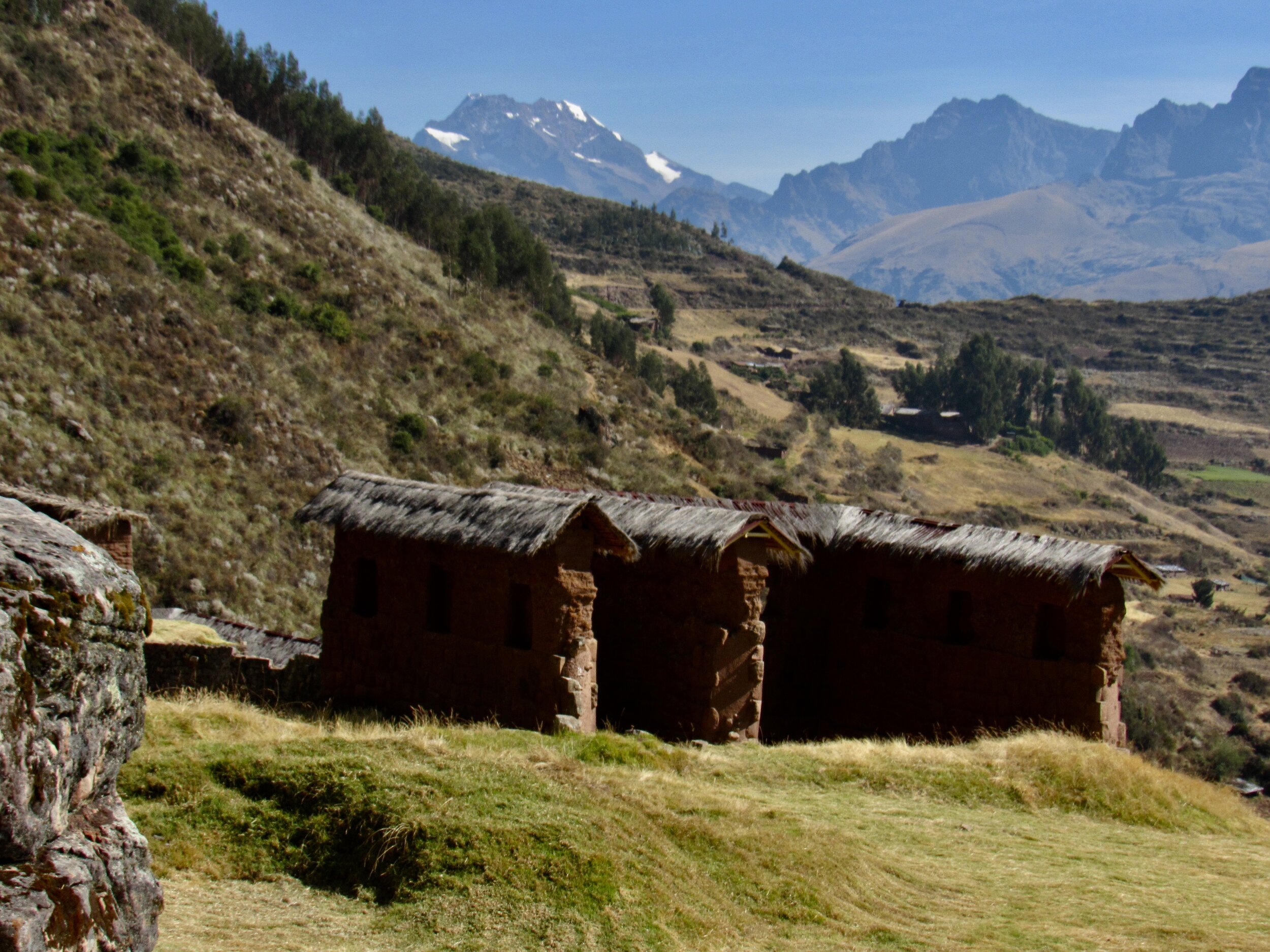

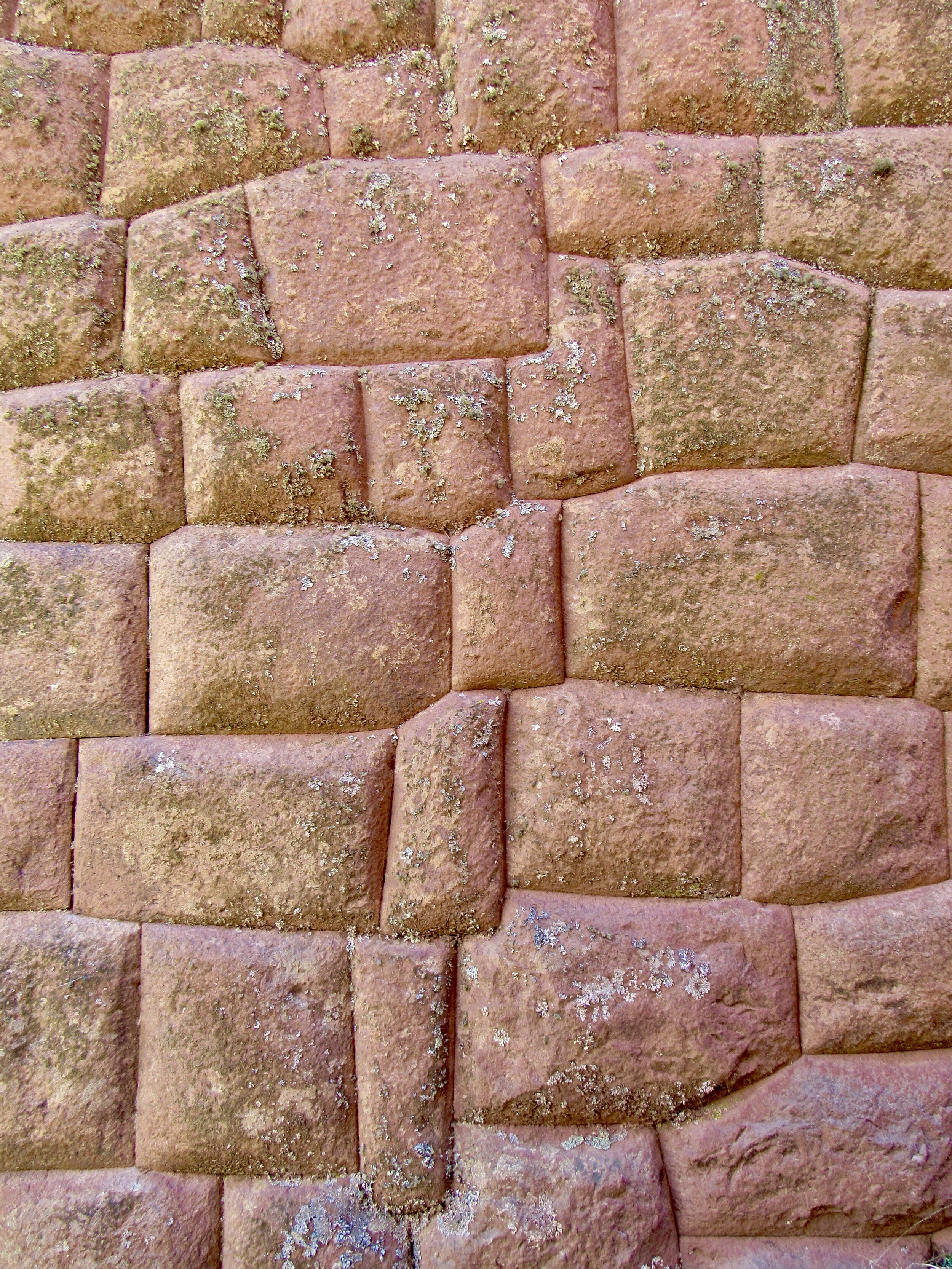
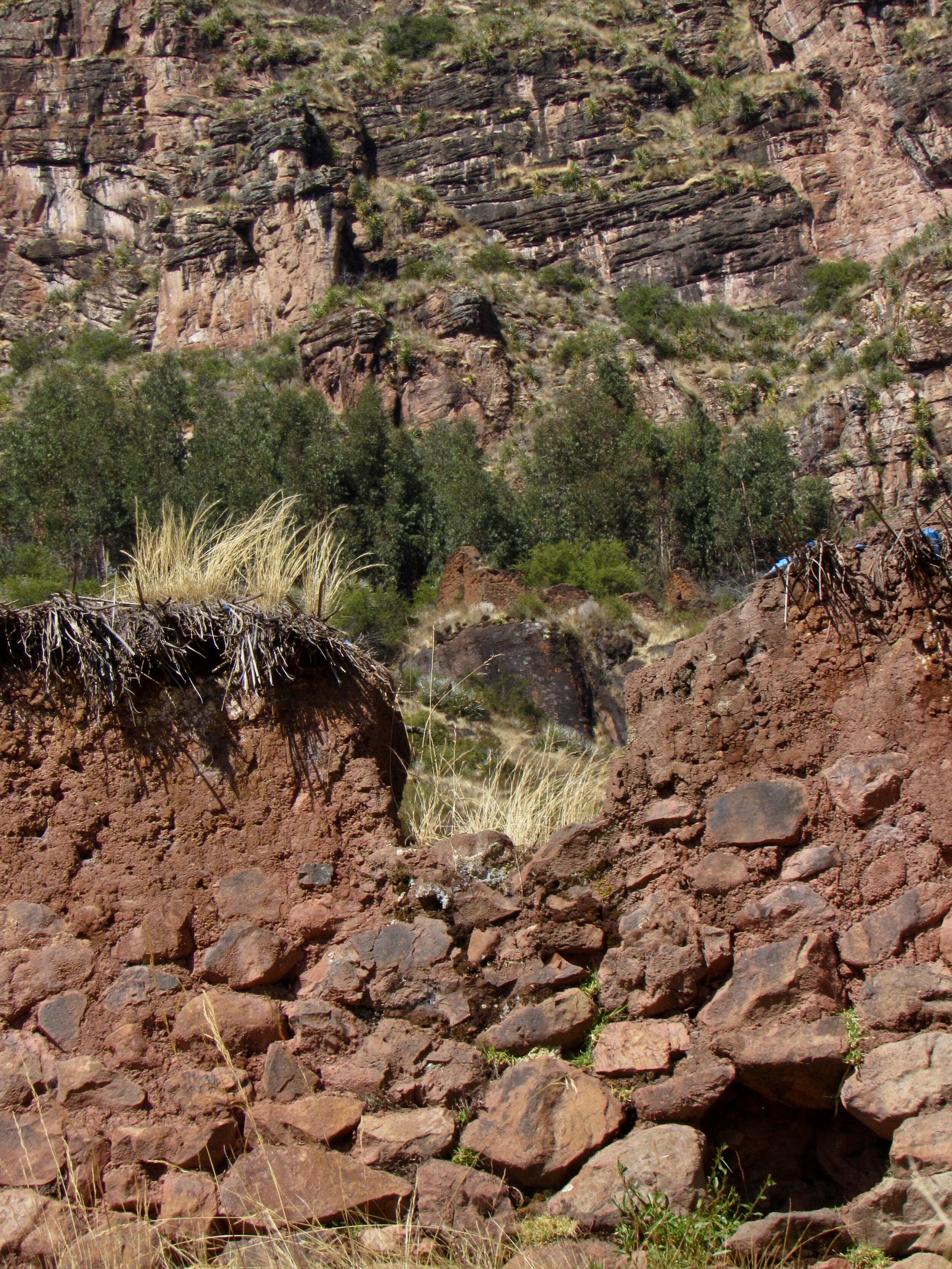
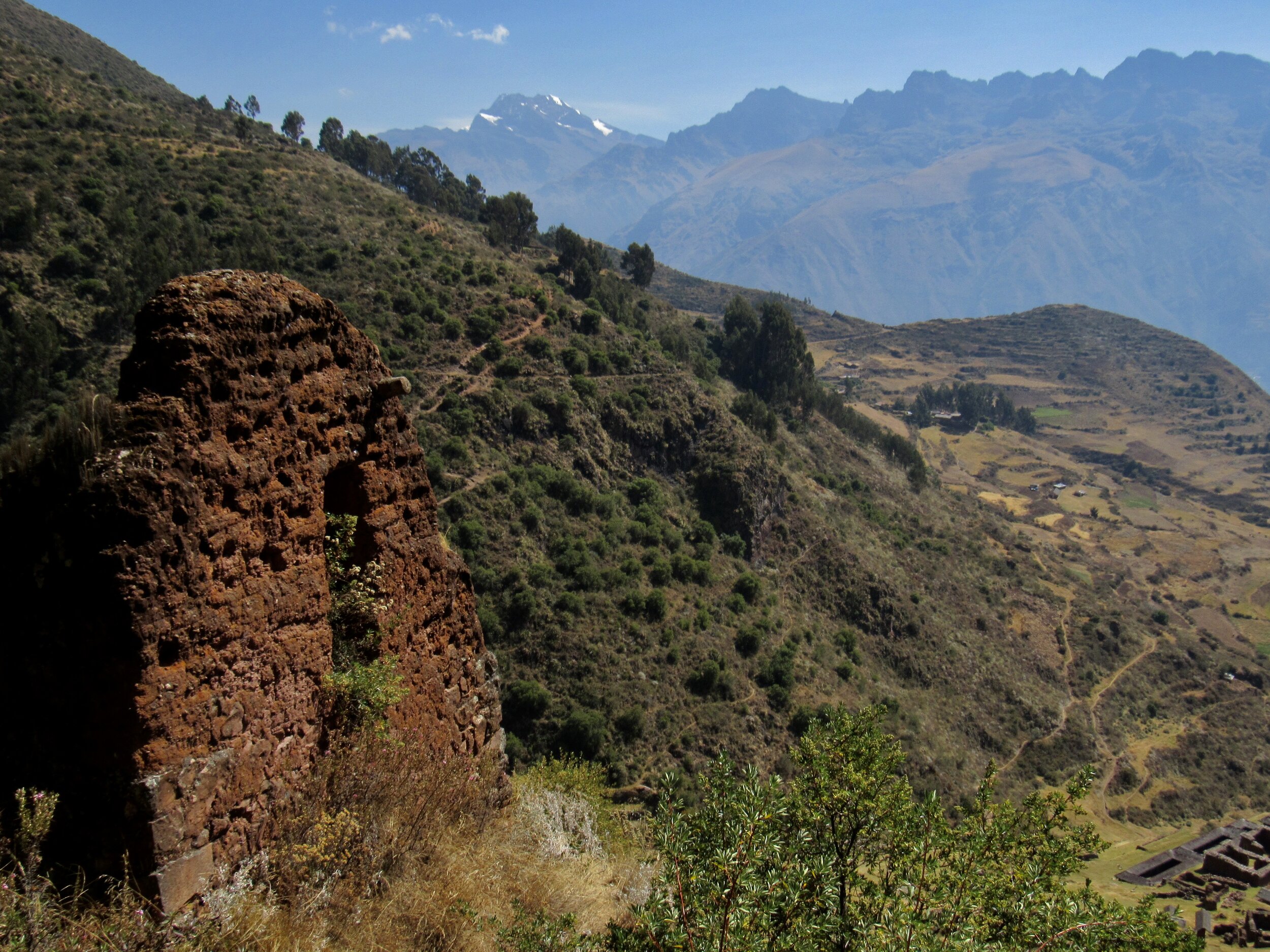

Covid in Cusco: Week 15
The Covid Relief Project went to help the families of T’astayoc and Perolniyoc, with the help of the mayor of Ollantaytambo.
Sunday, 21 June, 2020
Day 99 of quarantine, 9 days to go
Like last week, I’m at a loss as to what exactly I am counting down to. With case numbers surging around the world and a vaccine still a distant dream, what’s the point of counting down? Should I be counting up?
Once quarantine is over, I’m going to have to switch to counting up from the day that the first case of Covid-19 was officially diagnosed in Cusco. That was Friday, March 13th. I hadn’t actually realized that it was Friday the 13th until I wrote that just now. Cusqueñians are superstitious about a lot of things, but Friday the 13th isn’t one of them, which is probably why I didn’t even notice at the time.
That was a great day, as Fridays go. Back when I worked in an office with real people face to face, I had a Friday Happy Hour tradition. Drinking in the office is technically against the rules but the boss tolerated me educating my coworkers on the “American cultural practice” of having a beer at 5pm every Friday. Obviously, not all Americans drink, and not all have a beer at 5pm on Friday, but I like to mark the end of the work week. It was very artificial, since we worked till 7pm on week days and every Saturday morning. Still, it was the principal of the thing.
That Friday, since it had been announced in the morning that Covid-19 had officially arrived in Cusco, I switched my usual beer from Cusqueña Dorada to Corona. I made little labels for each bottle that said Vaccine/Vacuna right below the Corona label. So, I gave each of my coworkers a bottle that said: Corona Extra Vaccine. It was funny at the time.
It has been 102 days since that Friday. My Day 99 count is from the declaration of quarantine for all of Peru that followed the Monday after Cusco had its first case of Covid.
So much has changed. So much here in Cusco, in Peru and in the whole world. I had no idea, when this began, how bad it would get, how long it would drag on and how far-reaching the consequences would be.
The news is full of the negative consequences, although I try to focus on the positive environmental impacts and the ingenuity that has been required from all of us. We’ve had to get creative to cope, to survive even. I’ve certainly been creating something that never would have existed, if not for the need forced on us by the pandemic. The name alone makes it obvious that if we had a normal 2020, the Covid Relief Project would not exist.
Back home, close to Seattle, the town of Tenino has drawn on a lot of local ingenuity to create a way to support local businesses. Following their own tradition of printing wooden money in the Great Depression, they are using the same printing press they used in 1931 to print wooden money again. Community members who can show that they are experiencing economic hardship caused by the pandemic, can receive up to $300 in wooden money per month. The money is only good locally, but local businesses who accept it can trade the wooden money in for regular cash at City Hall.
I think this is a brilliant idea! Local people who need help get up to $300 per month and local businesses who need help can take these wooden dollars to be exchanged for regular money. It’s also cool in the historic sense, since they’re using the same 1890s newspaper press that they used in 1931 to print wooden money.
Think global, act local, right? How could this idea of wooden money help Cusco? Is there anything I could do to get an idea like this going to help local businesses? Does it work so well in Tenino precisely because it’s a town of about 2,000 people? Could it work in a city of 430,000?
I wonder what the population of Cusco is now anyway. It’s certainly less than it was six months ago. Most of the people I know have left town and are living with relatives in less expensive and much smaller towns. If any of my readers has an idea for how this kind of initiative could benefit Cusco, please let me know!
Monday, 22 June, 2020
After work today I went to the bank to withdraw some of the Covid Relief Project donations, then went to talk with Jorge, the wholesaler that I worked with that last time we took food to families in need. The place was still closed for lunch when I arrived, but that gave me some time to chat with the two guys who do all the heavy lifting for Jorge.
The last time I bought from Jorge, these two guys had loaded up a bus with 50 bags of 5 kilos of rice, 50 bags of 5 kilos of oatmeal, 50 bags of 5 kilos of sugar, 50 bottles of vegetable oil and 50 panettones. This Saturday we won’t have the same variety, but it will be 100 of each item. I think I should at least know their names and make sure I’m on their good side.
Both have been in Cusco for about a year and both are refugees from Venezuela. One worked in Lima for a few months before coming here. He said Lima was a much harder place to live. Prejudice against Venezuelans may seem prevalent in Cusco, but he said it’s much, much worse in Lima. I wonder if the touristy nature of Cusco makes people more welcoming to foreigners here.
I asked if either of them had gotten to see any of the sights, before the pandemic. One said he is only here to work and hasn’t seen anything outside of Cusco. The other took his mother to Rainbow Mountain when she came to visit, but it snowed and all they saw was White Mountain. I wonder if there is any way I can help them see Machu Picchu, or at least the Sacred Valley, after the pandemic ends and those places open up again.
Tonight on El Sonido, Chilly put a spotlight on LGTBQ artists. I was so caught up in Solstice being this past weekend that I had almost forgotten that it was Pride weekend. Or, it should have been Pride weekend. Pride parades across the world were canceled for fear of making the pandemic worse. And yet, there are all kinds of protests happening in the US and other countries, protesting systemic racism. It seems to me that in 2020, with marriage equality and some actual legal protections for LGTBQ workers, needing Pride parades to celebrate and advance the equality of all LGTBQ people seems a little less urgent.
The Black Lives Matter movement is very urgent and really can’t wait, despite the pandemic. Or because of the pandemic? Because of how systemic racism is killing Black Americans with Covid at a much higher rate than anybody else?
Somehow, I can justify to myself canceling Pride parades but still supporting the BLM protests.
Tuesday, 23 June, 2020
I try to limit my news intake to just a half hour or so in the morning, scanning the headlines on CNN or NPR or the BBC. Today, an article about a village where 80% of the population has Covid jumped out at me. I continue to be thankful to happen to be in Cusco, while we ride out this global pandemic. It feels like a safe place to wait while we try to get the pandemic under control, which could take another two or three years.
However, this village is also in Peru. The village of Caimito is in the central part of the Peruvian Amazon jungle, an eight hour boat ride to the nearest hospital. The two nurses that are trying to care for the whole community are out of the medicines supplied by the government. To make matters worse, “when the virus first struck, the government-appointed doctor left Caimito as his contract had expired.” These nurses have also tested positive for Covid-19, but have to continue working because there is nobody else.
The Peruvian Ministry of Health did not respond to a request from the journalist to comment on the situation. How can this be the same government that I have been so impressed with? Although, the more I think about it, the more I realize that what I have been impressed with wouldn’t truly help rural or indigenous communities.
I have been impressed with the compassion that I have heard in the speeches from the president and other government officials. I have been impressed with how quickly and decisively the government acts. I have been impressed with their efforts to get financial aid to families in need. All of these things are great for Cusco, and probably good for Lima too. What about an indigenous community deep in the Amazon jungle? A community eight hours from the nearest hospital? A community that does not have a bank or any way to receive financial assistance? A community where few people speak Spanish?
Just as terrifying as the situation is for the people in Caimito, the description of the only hospital that they have access to is worse. That is, if they can survive the 8 hour boat ride to get there. At this hospital “workers have had to clear away bodies of people who died outside the doors. Inside, there are not enough staff to care for the sick.” This sounds like an absolute nightmare to me. This is worse than the worst days in New York City, right? It might be worse than the nightmare they had in Guayaquil, Ecuador last month.
This is not the Peru that I have been so proud of. The Peru that I thought was handling the pandemic so well. True, in Cusco we’re doing very well, compared to most places across the planet. Still, there are clearly places in Peru that are in much, much worse shape than Cusco. Will the government come through for communities like Caimito? What will it take to slow the spread in these remote communities? Are the isolated, indigenous communities of the Amazon being sacrificed as the government spends so much energy and money on slowing the spread of the virus in Lima?
This has definitely shaken my confidence that the Peruvian government has a handle on the situation.
Wednesday, 24 June, 2020
Today is Inti Raymi, the most important holiday for Cusco and for all those who follow ancient Andean traditions and religion. Sadly, just like Pride and so many other important holidays, gatherings and parades, Inti Raymi is cancelled. All we got was reruns from last year’s Inti Raymi celebrations on tv.
The most important event is a reenactment of the Inca celebrations thanking the Inti (sun) and Pachamama (mother earth + nature + the cosmos). I was in the right place at the right time in 2013 to see the ceremony in person, which happens in a field next to the Inca site of Sacsayhuaman. There was a massive circle of people, with hundreds more watching from outside the circle. Most of the people in the circle were dressed up in very elaborate traditional costumes. Like many historical reenactments, the actors have certain lines for each part of the ceremony.
I asked a friend here for more information about the ceremony, since I obviously didn’t get to go see it this year. He said that the actors change every few years and that each person actually signs a contract with the Ministry of Culture. They are chosen mostly for physical characteristics, but the Inca must also have a lot of charisma, since he has a lot more speaking parts than the other actors. All of the actors should have long, straight black hair and have very dark skin. Like the royalty over 500 years ago, they should be very tall, physically fit and speak Quechua. Besides the Inca himself, important roles also include the neustas who usually play the same role for 2 or 3 years, until they no longer look like teenagers.
One famous actor who played the Inca for eight years in a row was Nivardo Carillo. He is actually the actor that I saw when I was here in 2013. He studied anthropology and Andean mysticism and was also a talented musician. Besides acting as the Inca in the Cusco Inti Raymi celebrations, he was also the Inca for an Inti Raymi in Lima.
His story is complicated, but I think it’s pretty interesting. He could have continued longer than eight years as the Inca, because he was so popular. Unfortunately, he was under contract with Ministry of Culture to only represent the Inca for their events. A contract which he violated by participating in a ceremony in another country. When he returned, he was banned from representing the Inca in Peru.
Normally, the actor who plays the Inca represents Inca Pachecutec, who ruled between 1438 and 1471. Before the reign of Pachecutec, the Inti (sun) was worshiped in many different places, at numerous temples in the Cusco area. Pachecutec made the temple of the Qorikancha in Cusco the main sun temple. He centralized power and made both the festival of Inti Raymi and Cusco more important than the previous Inca. Nivardo Carillo always represented Pachecutec.
Another popular actor was Carlos Belarte, who wanted to portray Tupac Inca Yupanqui, who ruled immediately after Pachecutec, from 1471 to 1493. Most Americans are familiar with the name Tupac, although I bet most don’t know that the rapper from NewYork was actually named after the Inca ruler Tupac. Between 1471 and 1493, the Inca empire expanded significantly, from present day Ecuador to halfway down the Chilean Andes past modern Santiago.
Sadly, nobody got to be the Inca this year. The Academia Mayor de la Lengua Quechua in Cusco held a small ceremony in town, since all archeological areas, including Sacsayhuaman are closed. They did a small representation of Inti Raymi at the Ovalo Pachacutec monument, with offerings to the Pachamama but only 10 people were allowed to attend.
There’s no use spending too much time mourning the loss of the 2020 Pride festivals and Inti Raymi. On a more positive note, this afternoon I accompanied my housemate Kerry to her appointment with a tattoo artist. She has been in communication with a guy named Malqui for months now, but obviously he was unable to open his studio at all. She has had her design and plan of exactly what she wants since February, but didn’t manage to get an appointment before quarantine closed up all tattoo studios.
Malqui did a fantastic job of putting a compass in thin black pencil lines over her design of the globe in sepia. She wanted it to look like the old maps that were on parchment paper from the 1700s. Afterwards I asked him about my plan for a hummingbird tattoo. We didn’t have much time, so I have an appointment to go see him next Wednesday to discuss design. I haven’t gotten a tattoo in almost 20 years, so maybe it’s time to finally get the one I’ve been thinking about for the past few years.
Tattoos are very common in Cusco. Most people in their 20s and 30s that I know have at least one. Most Cusqueñian men have bold black tattoos of Inca designs and symbols. They’re nothing like what I would want, but they do look good on Quechua people of Inca descent.
Thursday, 25 June 2020
Today after work, I went to get my first haircut since before quarantine started. Barber shops and hair salons are allowed to open, with a long list of new regulations. Everything is by appointment only, and only one customer can be in the salon at a time. Everybody has to wear masks and when customers enter they have to stand on a bleach pad for 10 seconds and have their temperature taken. Besides all that, it was a pretty normal haircut experience.
After the haircut, I walked back to see Jorge again. When we had spoken on Monday, he was unsure about being able to get oatmeal by this Friday. On the way from the salon to Jorge’s, I asked at a few other wholesalers if they had any oatmeal in stock. Every single one of them said that they couldn't get it because it’s an imported product and they were all out of imported products.
Last time I had bought the 3 Ositos brand (3 Little Bears), which is the most popular brand. Today, nobody had any oatmeal of any brand. It really is considered a treat here and I’m so fortunate that I was able to buy 5 kilos each for the families of Sut’uc-Pacchaq.
I wasn’t optimistic when I got to Jorge’s and he gave me the same line as all of the other wholesalers that I had asked: they can’t get any imported products anymore. Apparently, the Peruvian stock of oatmeal is completely exhausted. In some ways it’s probably good to be forced to buy only Peruvian products, but still, I did want to buy oatmeal.
I don’t have enough donations to buy the large tin of powdered milk that we got for the June 6th event, but after some negotiations, we settled on two cans of condensed milk per family. As long as some more donations come in tonight, I will definitely be able to pay for two cans of milk for a hundred families.
I also needed to warn Jorge that Ollantaytambo was sending a truck to pick up the food tomorrow, rather than Saturday morning. The drive to where we met the families of Sut’uc-Pacchaq was only about two and a half hours. This Saturday, we were going to drive over three hours. Also, the community is more spread out, so we will be stopping in two different places to distribute the aid. Jorge opens at 8:30 on Saturday, but we need to already be past Ollantaytambo by 8:30.
We will have to load up everything on Friday night so that we can leave Cusco at about 6am on Saturday. The mayor’s office of Ollantaytambo has promised to pay for the transportation, so we will see if they can also pay for the truck driver to stay in a hostel. If not, I do have empty bedrooms here, since both Viviana and Andrea have left.
These families live so much farther away that logistics have been a lot more difficult. I’m sure it will all work out in the end, but getting there and back in one day will be a stretch.
Friday, 26 June, 2020
We were informed by the mayor’s office in Ollantaytambo today that they will not allow their driver or truck to spend the night in Cusco. We have to spend the night in Ollantaytambo, since there is no way that we will be able to get to Ollantaytambo by 7am tomorrow, even if we try to leave Cusco at 5am. Transportation here is just too complicated, unreliable and restricted during the quarantine and State of Emergency.
Auqui and I won’t have any trouble spending the night in Ollantaytambo, but Henry has too many obligations here in Cusco. He can spare all day Saturday for the project, but not overnight. His new baby’s and wife's health are just too delicate for him to be gone that much. He has an energetic 6 year old daughter to take care of as well.
I was so looking forward to having both Henry and Edy be there with me this Saturday. Now, I’m afraid that neither will be able to join me. Auqui is very helpful and I know that we can manage with just the two of us. Still, I did want to get photos of a new person helping out. I want to show that we have broader support besides just the three of us.
This afternoon, Henry and Auqui met me at Jorge’s to load up the truck sent from Ollantaytambo. Enough donations came in overnight to be able to buy everything on the list, plus a few extra bags of rice, for those we see who need help but aren’t on the list. Extra bags of rice were very helpful for the first two events, and I don’t see this being any different.
Much to my surprise and delight, Henry said that he would be able to join us! His sister is going to spend the night with his wife and new baby to help out while he’s gone.
The mayor of Ollantaytambo had sent us a big truck but unfortunately no official police passes. We were told that transportation had fewer restrictions now and that we wouldn’t need them. None of us really believed that, so instead of sitting up front with the driver, we all got in the back of the truck with the bags of rice and sugar and boxes of cooking oil and milk. At the police checkpoints we laid down and pulled a tarp over us. Thankfully, the police never looked in the back and the driver had proper paperwork for himself and the truck.
Also in the back of the truck with us was a giant bag of donated children’s clothes from Henry’s sister and a box of animal crackers. It was two kilos of animal crackers in one box, so Henry brought a roll of smaller plastic bags so we could divide them into smaller portions to give out to children. The last two times I had wished that we had something to give to children and this time Henry did a great job making sure that we did.
We didn’t leave Cusco until about 5pm and since it gets dark around 6pm here, the stars started to come out as we drove through the last section of canyon to Ollantaytambo. The Southern Cross was the first to appear, followed quickly by the whole Milky Way. At this altitude, during the dry season, the sky is perfectly clear and every star just jumps out at you.
It felt so great to be headed out on an adventure with two friends, almost like a summer roadtrip. The back of the truck was cold, but got warmer as we descended into the Sacred Valley.
When we got to Ollantaytambo, we unloaded all of the cargo into Town Hall, then the mayor took us out for dinner. There is a little restaurant hidden back behind several shops, just across the street from Town Hall. Technically, restaurants in Peru are only allowed to operate for take out and delivery. However, Town Hall employees and the local police have an arrangement with this restaurant, which is still not open to the public.
After dinner we were taken to a hostel nearby. Walking through the main square, and along the streets leading from it, was a surreal experience. I’ve gotten used to Cusco’s empty streets, but I had never before seen Ollantaytambo during quarantine. It felt as eerie as the first time I ventured out into the empty Cusco streets back in March.
Ollantaytambo is a very touristy town also. It’s the gateway between the Sacred Valley and Machu Picchu, so it obviously gets a lot of traffic. The mayor said it’s been unnaturally quiet the past three and a half months and they can’t wait until tourism revives.
All hotels are closed, but like the restaurant, there is a hostel open for government business. Since the whole place was empty, we each got to pick our room. I slept like a rock.
Saturday, 27 June, 2020
We had breakfast this morning at the same restaurant, accompanied by a couple tables of police. Afterwards we packed up food for 35 families in the back of a pickup and set off for the community of T’astayoc. It was beautiful and the full description of the day will be posted on the blog on https://heatherjasper.com/covid-relief-project-blog
After T’astayoc, we went back to Ollantaytambo and loaded up the rest of the food in the back of two pickups and drove to the community of Perolniyoc. After distributing the food and the last of the animal crackers and clothes, we were invited to a house that is also a chicheria, where chicha is brewed from corn. This was the most popular drink during Incan times and something that I have definitely developed a taste for.
After a refreshing cup of chicha, sitting outside in the shade, we were invited into the house for lunch. We were served plates piled high with rice and stir fried vegetables, with a fried egg on top. It was delicious and we got back in the truck, exhausted and full.
For the third event of the Covid Relief Project, this was such an amazing day. More details of the day and many more photos are on the link above.
Covid in Cusco: Week 14
The new rules of the Covid quarantine allow me more time outside and the Covid Relief Project gets another boost.
Sunday, 14 June, 2020
92 days of quarantine down, 16 to go … and then …
What exactly do I think will happen? With the State of Emergency extended into September and the hope of a vaccine still in the distant future, what can I expect to happen in 16 days? I’m hoping that the all day Sunday “curfew” will end and that there will be more transportation options, although I certainly don’t want anybody from Lima coming near Cusco. I do hope that it will be easier for me to travel to small villages to take emergency food aid to people who really need it.
I don’t actually think anything will change 16 days from now but maybe I should look for a new title for these blogs. What comes after quarantine? Post-quarantine? Extreme Social Distancing? Covid Recovery? The shit show?
One of the most difficult things about this pandemic, since it started to hit international news in February, is the crushing uncertainty. We have no idea what is going to happen. We have no idea what will happen when restrictions here lift. Although, if Peruvians follow the lead of every other country that has eased restrictions, we’ll have another rise in cases and maybe even a full outbreak.
Maybe the only certainty that we have is that this will not be over anytime soon. We will be dealing with an ebb and flow of waves of outbreaks across the world until we not only have a vaccine, but are able to administer it to 7.8 billion people. With that in mind, I decide to spend the afternoon working on the Covid Relief Project. It will be a while before tourism resumes enough here for porters to have jobs again.
I’m trying to expand the network of people who know about the project. Besides my own personal contacts, I’ve been reaching out to guides in Cusco. First, I ask them to spread the world among all of the guides in the area, then I ask each of them to contact any tourists that they have worked with and still have contact information for. Still, the bigger the network, the better.
I’ve also been messaging with a person that I will call Maria in this blog. She has worked with porters here in Peru and also with porters in Tibet and Kenya. The Inca Trail, Mt. Everest and Kilamonjaro are apparently the three places in the world where trekkers almost always have porters. They are also three places in the world where workers’ rights and indigenous people’s rights are easily ignored in the quest for profit. You can probably imagine that a person who is working directly against the interests of the majority of the tourism industry is going to make enemies.
Maria called tonight to talk with me about the Covid Relief Project. She’s not in Peru during the quarantine and is unsure when she’ll be able to come back. I had messaged her to ask for her help in reaching out to people. I know that she has a giant network around the world and I thought that if she promoted the project, we would get a lot more visibility and hopefully more support from people who care about the welfare of the porters here.
She said that she was interested in the project and would quietly reach out to a few people, but that her name should not be at all associated with the project. Apparently the enemies she made here are still quite angry and she is afraid that if she is publicly part of the project, then her enemies will become my enemies and then they will take down the project. It sounds extreme and perhaps ludicrous to people who don’t know much about tourism in Peru. I absolutely understand what she is worried about.
Tourism is 80% of the economy here. There are a few international trekking agencies that have a strong presence in Cusco and on the Inca Trail. There are also several national companies that are big enough to have a pretty big piece of the pie here.
Online shopping being what it is, with people so used to Amazon’s model of undercutting the competition by a few pennies, people are very used to price comparisons now. All of these companies try to offer the same services, for just a little less than the competition. When they cut a little off the price, it doesn’t take from the food budget, or the transportation, or the permit prices for the Inca Trail and Machu Picchu. It generally goes off the salary of the porters.
The low end of the daily wage for porters on the Inca Trail is pathetically low: 50 soles per day ($14). The good companies pay twice that, but for the work they do, it’s still tragically low. One thing that Maria has done is also expose the treatment of the porters: How most don't have their own tents, sleeping bags or sleeping pads when they’re working the trail. That there is no healthcare or protection for them if they’re hurt on the job. Considering the massive loads that they’re required to carry every day, most end up injured at some point.
When I first heard about Maria, and her project, last October, I was shocked at the information that she was exposing - but not because I didn’t know about the dark side of the Inca Trail. I was shocked that she was getting away with producing a documentary about this and that porters were showing their faces in the trailer for the documentary. (It’s really easy to figure out who Maria is, if you do a little bit of research).
I am not at all surprised that she has enemies here, that she hesitates to come back to Cusco and that she’s worried that her enemies will try to take me down. I’m glad that she warned me, because I really don’t want any enemies here.
Monday, 15 June, 2020.
Today’s day 93 of the State of Emergency conference started with President Vizcarra’s plea to Peruvians to care for themselves as a way to care for their families, their neighbors and their coworkers. He said that starting with the president, who will not let his guard down, it is the responsibility of every Peruvian to not let their guard down until we have defeated this virus. He read out exactly how many people who have tested positive 232,992 and how many have passed away, but also how many have recovered and gone home healthy from the hospital. After outlining some plans for economic recovery, he took questions that were obviously prepared ahead of time, because all of the ministers who responded were reading prepared statements. What I was impressed with was the nature of the first question that they addressed.
The question that President Vizcarra took first was: “There is a sector of the population that is politically disenfranchised, socially denied, epidemiologically in danger and economically devastated. Does the Peruvian government have a specific plan for the relocation and social and economic recovery for the more than 100,000 sex workers who will have difficulties returning to work without danger of contagion?”
The Minister of Health answered first, saying that in the Peruvian constitution, health is considered a basic right and that it’s the government’s responsibility to care for the health of every Peruvian. He continued that sex workers are considered a particularly vulnerable population for the Ministry of Health because of the special health risks inherent in their work. Work, which he notes, could be forced or voluntary. Regardless, the government is still responsible for their health. As they have been provided special health care to help prevent HIV and tuberculosis, they will also receive special consideration in the fight against the Coronavirus.
The Minister of Labor, Silvia Cáceres, next took the mike and said that “through the department for the protection of women and children, a budget has been designated and is being distributed through organized collectives for sex workers. For the Ministry of Labor, this is a serious worry for the economic recovery of sex workers who have lost income. Like all vulnerable workers, they have received financial assistance from the government. In the recovery plan that the President has outlined for us today, the Ministry of Labor has the responsibility to promote job opportunities for all sectors of the population. The Ministry is designating resources for these and all workers as we work to recover the economy.”
Regardless for how well or how poorly you think the Peruvian government is responding to the pandemic, I’m happy to hear them address not only the special health risks of sex workers, but also to hear them talk about sex work as work. Obviously many governments around the world (including my own) do not treat sex workers as workers. Many presidents would not take that question during a presidential address and even if they did, it probably wouldn’t be the first question they took.
Score one more for Vizcarra on my personal presidential approval rating.
Tonight while listening to El Sonido I was trying to figure out how many Peruvian artists I first heard on KEXP. Definitely Novalima, Dengue Dengue Dengue, Kill Amigo, Quechuaboi, Los Mirlos, Fracaso Band, Comité Pokofló and more. Chilly recommended a playlist to me once which introduced me to Gala Briê, La Nueva Invasión, Menores, Santa Madero and Rivière (which sounds French but is Peruvian). I do hope that outdoor concerts and some other “safe” ways to enjoy live music will return soon.
Tuesday, 16 June, 2020
I am determined to not let anybody politicize the Covid Relief Project and one way to ensure that is for me to stay out of politics. Still, my motivation for this project is knowing how unprotected porters are. They get paid by the day and none have what I could consider to be a contract with a company, guaranteeing them employment or wages.
There is no unemployment system to give them any kind of income during the pandemic. I have a couple friends and relatives drawing unemployment in the US. More than one of them is actually getting more per month on unemployment that they were when they were working. That is not the case in Peru.
I hope that, when things return to something close to normal, or at least when some tourists return to Cusco, my project will no longer be needed. I’m not trying to start an NGO or a big charity. I just want to help people during the pandemic when there is absolutely no possibility that anybody will be able to work with tourists.
Still, maybe when tourism resumes, I will be able to be a part of the major structural change that “Maria” is working towards. Maybe by then I will know so many small communities through the work that I’m doing for the Covid Relief Project, that I’ll have a better idea of how I could help improve working conditions for porters on the Inca Trail.
For now, I’m just going to keep my head down, protect the project from being hijacked by trekking agencies who want to use me for marketing and from people who might want to use it for political reasons. I have plenty of time on my hands. I am confident that I can raise enough money to help a few more communities while the need is so great. I don’t need to ask for help from other organizations who might want to politicize or monetize my humble little project.
Wednesday, 17 June 2020
Today after work it was finally nice enough to go for a walk up to the Temple of the Moon. The past few days it was windy and cloudy in the afternoons but today was beautiful! I walked past the Temple, crossed the stream by the sign for Inkilltambo and walked up the trail to a spot I’ve been scoping out for watching hummingbirds. It’s a hillside covered with wildflowers and I found a good rock in the shade for my stakeout.
It didn’t take long. After only a few minutes the hummingbird that has claimed this hillside was flitting around near me. I watched it perch in trees in the sun, chase off other birds from its flowers and perch near flowers in the shade where it was difficult to get a good shot. It’s a Sparkling Violetear, the most common hummingbird around here. Almost all of my hummingbird shots from my living room windows are a Sparkling Violetear. They’re loud and flashy and very territorial.
After my hike, I went back to see Jorge, the wholesaler that I worked with to buy food for Sut’uc-Pacchaq. I told him that on the 27th we will be taking food to 100 families and that my budget per family is 35 soles. The first time we did the project my budget was 18 soles per family. The second time it was a fabulous 88 soles per family.
With 35 soles, I negotiated 5 kilos of rice, 2 kilos of oatmeal, 2 kilos of sugar and 1 liter of vegetable oil. We won’t be able to afford panettone this time, but that seemed like such a miracle last time that I didn’t actually expect to be able to repeat that.
This evening I got another taste of normalcy. My friend Juanita invited me over for a game night with her roommate and two other friends. It was a gathering of just five people, but they were five people that I haven’t been quarantined with! Scandalous!
Juanita had seen somebody selling Monopoly sets on the street and splurged. It definitely looked like somebody had made it in their living room, but we still had a fantastic time. She had a beautiful spread of appetizers and wine. I stayed out till the 9pm curfew, then ran the two blocks home because it was 9:05. Kerry was worried about me when I got home, but I was just so happy to have had such a normal afternoon.
Thursday, 18 June 2020
While I am starting to find a little normalcy here, hiking, and visiting friends, I have still been following news in the US. The past several weeks it has been grim. The murders of George Floyd, Breonna Taylor, Atatiana Jefferson, Stephon Clark, Botham Jean, and far too many more is devastating. However, there has been some good news coming from the US and I am always on the lookout for any good news.
Today was a proud day for immigrant rights in the US, as the Supreme Court upheld DACA in direct opposition to Trump’s attempts to destroy any recent improvements in US immigration law. I am so thankful that something is going right!
Earlier this week the Supreme Court also ruled in favor of protections for LGTBQ workers. This is probably the biggest news for LGTBQ rights since marriage equality.
I’m not brushing aside all of the tragedy happening around us, but it’s so comforting to see good news is still possible too.
Friday, 19 June 2020
Today after work both Henry and Auqui came over for our first face to face meeting about the Covid Relief Project. Our first order of business was the destination for the 27th. Initially, Maria had asked us to go to Huilloc Alto, where she worked with porters on her project. Since she hasn’t been able to get back to Peru during the pandemic border closures, she has had a hard time getting news about how her friends here are doing.
She gave me the phone number of the main community leaders she had been working with and Auqui has been in communication with both him and the mayor of Ollantaytambo. As with the first two events, we need the mayor’s office of the closest town to arrange both transportation and police permission for us to leave Cusco.
Auqui went to Ollantaytambo to meet in person with the mayor and was told that tomorrow the trekking agency Alpaca Expeditions will be taking aid to Huilloc Alto. They also told Auqui that an NGO associated with Lima Tours had already taken aid there. The mayor asked us to change our location and suggested Perolniyoc, which has yet to receive any aid.
Henry and I were all for the change and we moved on to talking about how to spread the world, how to involve other guides and when we should start saving for Christmas. We are very aware that even if the borders open in a month or two, very few people will get any work at any point in 2020. We want to help until tourism really gets going again and people can find jobs. Christmas is going to be very bleak for a lot of families, so we decided that on September 1st we will announce a separate campaign to start saving to take food, clothes and perhaps even toys to some of the communities who need it most.
Henry had a great idea about inviting a new guide along with us at each event. I already have lots of photos of both Henry and Auqui helping people. Tourists who have done treks with these two are already donating to the project. They see a face that they know and trust helping, and they feel good about donating. The more guides who participate, the more trusted faces people will see supporting the project. We called around and found a guide named Edy who is willing to go with us on the 27th.
Saturday, 20 June 2020
Today is winter solstice. Growing up, Winter Solstice in Boise was a big deal in my family. It was a cause for celebration as the shortest day of the year, not because it was a short day, but because every day afterwards would be longer. It was always a day of hope for me, knowing that every day would be longer and that eventually the long summer days would be back.
Here in Cusco, today is the shortest day of the year. So close to the equator, today is only an hour and 36 minutes shorter than the December Solstice. It’s certainly not as noticeable as the 8:25 minute difference in Seattle between June and December Solstices. Still, it’s a very sacred day for the Quechua people, many of whom still follow traditional Andean ceremonies, which have changed little since Inca times.
The normal festivals have all been cancelled, as have gatherings of all kinds all around the world. Covid has ruined the famous Inti Raymi festival of Cusco. Still, I was hoping that there would be a way I could still celebrate Solstice.
Yesterday I stocked up on fruit, cookies and coca leaves, hoping that Auqui would let me participate in a traditional Solstice ceremony. We packed up all the food, plus some other items like white paper and white thread, and hiked up past the Temple of the Moon, to a cave that I had in mind. Every time I have been by this cave, I’ve seen piles of coca leaves stuffed in crevices or burned in clay dishes. I thought it would be a good place and Auqui said it was perfect.
Besides the coca leaves, nothing we had in our ceremony was ever used by the Inca. We included mandarin oranges, bananas, oreo cookies and several other sweets. We didn’t have corn or quinoa or potatoes or chicha. Still, Auqui led me through thanking the Pachamama and several steps of praying before we wrapped up all of the food and coca leaves in the paper, tied it with the white thread and buried it at the food of a nearby tree.
Afterwards, we sat under the tree, near our buried offering, to eat the late picnic lunch we had brought with us. Hummingbirds surrounded us as we sat until it was almost dusk. We sat still as they flew so close we could feel the wind from their wings. In Mexico the hummingbird was traditionally revered as a messenger from the gods. It was so magical to have the birds so close to us, it felt to me like the Pachamama was sending us messages. Perhaps she liked our offering or wanted to tell us that she’ll answer our prayers. I certainly don’t know enough about traditional Andean beliefs to have any idea what a hummingbird is saying to me. Still, it was a beautiful moment and felt like a very special Solstice.
Quarantine in Cusco: Week 13
I continue to work on spreading the word about the Covid Relief Project and attend my first live music concert since February! People in Cusco are so done with quarantine.
The Tawantinsuyu flag of the Incario has flown at half-mast since the first Covid deaths in Peru, in March.
Sunday, 7 June, 2020
85 days of quarantine down, 23 to go
Yesterday was an incredible success! If you missed last week or want to see the photos of the second event of the Covid Relief Project, check here. https://heatherjasper.com
Another Sunday means another day at home. This is the twelfth Sunday of quarantine, when nobody is allowed to leave their home except for emergency medical services. Only hospitals and clinics are open, no pharmacies, no grocery stores or any of the handful of other businesses that are allowed to be open. That leaves me with birdwatching, reading The Hummingbird’s Daughter by Luis Alberto Urrea, blogging and working on a video about yesterday.
I had asked a few friends for tips on fundraising and was advised to make a video of this second event. I took hundreds of photos of the first event on May 16th, but no video. It honestly didn’t occur to me. I’m so used to still photos for the blog and website that I hardly ever shoot video. As my first video, this will probably take me a while.
The same Blue and Yellow Tanagers, Black Throated Flower-Piercers, Sparkling Violetear hummingbirds, sparrows, thrushes, doves and pigeons are here to entertain me. They have been faithful companions these past thirteen weeks. I can still hardly believe that I’ve been sitting on this couch, watching these same birds, for thirteen weeks. Did any of us imagine that Peru’s quarantine could possibly go on this long? Anyone who’s not an epidemiologist, that is?
I am certainly not alone in spending so much time birdwatching out my window, even if most people around the world don’t have an all day Sunday curfew. This article from the Cornell Lab’s All About Birds starts with the sad tale of a birder stuck in his hotel room in Iquitos, Peru. He came here planning to add more than 100 birds to his life list in the Peruvian Amazon.
He and I are not the only ones doing all of our birding out our windows, the article notes that in many places “reporting rates doubled or even tripled for suburban species.” I am certainly learning a lot about the birds that I can see out my windows and I hope that if that birder is still in Iquitos, that he has trees out his windows.
It is quite unlikely that he is still in Peru. Commercial flights in and out of Peru stopped on March 15th, but many embassies worked hard to get permission for “humanitarian” flights to repatriate their citizens. That evacuated a lot of people from Peru, tourists and temporary residents like my friend Viviana who went home to Switzerland. However, those repatriation fights ended on April 20th.
Since then, I continue to get emails from the US Embassy in Lima about commercial companies who occasionally get permission from the Peruvian government to fly out of the Group 8 Airforce base near Lima. Commercial airports are all closed, but the US Embassy is still facilitating US citizens and permanent residents return to the US. These are still very restricted flights and there are only a few per month. They are always sold out.
My housemate Kerry is still here with me, sticking out the pandemic in Cusco because as a British citizen she wouldn’t be able to fly to the US, where she had a job waiting for her that started June 1st. As long as she hasn’t found a job back in England, there’s no hurry to leave and Cusco is clearly a safer place during the pandemic anyway.
Monday, 8 June 2020
I am so thankful to all the donors who made last Saturday possible, but just like after the May 16th event, I feel a bit of a let down. Something I worked so hard for, for weeks, is over. I took yesterday off, and did very little besides birdwatching and blogging, but today I need to concentrate again.
I’m working on the video from Saturday and plan to also video interviews of both Henry and Auqui. Hopefully, with those on Facebook, Instagram and the website, we will get more donations for the next event. For May 16th, we had seven donors but for June 6th we had 21! My goal for the third event is 30 donors. If we can add another 10 donors to each event, it will make my ask of $10 or $20 more genuine. Of course, every person who donated $10 to last Saturday made a big difference, but I was honestly so relieved when a few $100 donations came in. Even with a threefold increase in donors, $10 each would have been only $210. Saturday was wildly successful because we got a total of $1211 in donations.
With that much money, we were able to buy more than just the basics. The rice, sugar and vegetable oil are what people get from most charities. With so much in donations, we were also able to give expensive items like powdered milk, oatmeal and panettone. Panettone is very popular here over the holidays and a must from every employer at Christmas. Rice is a handout, but panettone is a gift. The event felt festive and celebratory, partly because we were bringing gifts, not just handouts.
Tuesday, 9 June 2020
After work today I got to start my new job! Working part time for the trekking agency, from 9am to 1pm, has given me more time in the afternoon than I can fill with birdwatching and finding donors for the Covid Relief Project. I’ve been casting around for new work to both fill the time and supplement my income.
I’m barely breaking even each month, which isn’t too worrisome, since I do have some savings. Still, comfortably breaking even would be much better. I would like to not have to calculate whether or not I can afford the good coffee or if I have to go with the cheap coffee. The coffee in Peru is just too good to drink the cheap stuff.
I’ve put the word out to friends in Cusco that I’m available for one on one tutoring in French, English or Spanish. There are a few foreigners here who have expressed interest in Spanish tutoring, but my first lesson today was English, for the owner of a local coffee shop. He spent at least half an hour explaining about the different coffee brewing methods used in his shop, along with an explanation of the holy triangle of time, temperature and ground which can give you the “gold cup” as he said.
I learned a lot about coffee and got a good feel for what he needs to work on. We settled on one hour every Tuesday afternoon and I have a good list of topics for future lessons. His coffee shop, like all coffee shops in Cusco, is closed. He is still selling coffee as either whole bean or already ground, but nothing else.
Very few people in Cusco have any income anymore. Everybody I know used to work directly in tourism as guides, drivers, porters on the Inca Trail and in hotels and restaurants. Not one of them has had a job since March 15th.
Obviously, I can’t charge much per hour here and almost hesitated to ask for s/20 an hour. (s/ is the symbol for soles, the Peruvian currency).That’s less than $6. Last year, when I was living in Seattle, one on one tutoring in French or Spanish could easily go for $40 or $50 an hour. Nobody in Cusco could afford that, even when things were normal. The sky high unemployment in Cusco now makes me hesitate to ask for s/20, so we’ll see how many people take me up on the offer.
An interesting result in the hard stop in tourism here has been the availability of AirBnbs as monthly rentals. Places that used to go for $50 a night are now offering monthly rates as low as s/200 (about $58). A friend of mine just moved into one, and my price estimates come from his house hunting. I would be very tempted, if I hadn’t signed a year lease, and if I actually wanted to move. For now, I’m content with my location so close to the San Blas market and with the birds I can see out my windows.
Wednesday, 10 June 2020
Today the presidential decree of an extended State of Emergency begins, for another 90 days. Reading the fine print, this does not extend the quarantine as it is now. However, it does give the president the power to reinstate the quarantine or curfews, as needed.
Currently, besides a 9pm curfew and all day Sunday curfew (is it a curfew if it’s all day?) I don’t feel very restricted in how I move around Cusco. Most businesses are still closed, but we are allowed to be outside for an hour to exercise, as long as we stay within 500 meters of our homes. The Temple of the Moon is about 2 kilometers away, but still worth the risk.
I always carry an empty ibuprofen box in my pocket, along with some cash and my ID and phone. Hopefully, the story of going to the pharmacy to buy ibuprofen is believable. My Peruvian permanent resident card doesn’t have my current address on it, which could be a problem or could be an advantage. It all depends on the humor of the police or military who stop me in the street.
This afternoon, a guide I know came over for some help with a visa application for Canada. He was contacted by a company offering to facilitate applications for a 6 month guest worker visa. Thankfully, he was suspicious when they asked for over $2,000 up front, with another $2,000 when he arrived.
He showed me the emails they had sent and described his phone call with them last week. We looked at their website, which looked pretty normal to me. Then we checked the Canadian Better Business Bureau. The company was founded in 2015 and has been under investigation by the BBB since 2016, though never approved. That was enough for me to tell him that this doesn’t look like a good idea.
Next, we checked the Canadian government immigration website. On their fraud alert page, we read through the list of what to look for when suspecting a scam. On the lists of what they will write in emails and what they will say in phone calls, we checked every box.
I was sad, because people here need work so badly and the prospect of work in Canada, even for only six months, is so tempting. I was also relieved that he knew to come to me, when it started to seem odd to him. Mostly though, I was angry that there are people so willing to take advantage of Peruvians who are desperate and who don’t understand legalese in English.
All of the guides I know here dream of international travel. Temporary work visas are the easiest way to afford that travel. One of my friends here, Gaspar, has traveled to the US (including Seattle), England, France, Spain, Argentina, Chile, Bolivia, Ecuador, Panama, Ecuador and every region of Peru. He is one of the lucky few.
Most guides never have the opportunity to travel internationally, although they spend their days with people who come from all over the world. Tourists tell them about their homes, cities and countries. They also hear innumerable stories about the other countries that these tourists have visited. It’s like working in an ice cream shop but not being allowed to ever taste even one flavor.
Thursday
I am so proud of Seattle! The Capitol Hill Autonomous Zone (Chaz) has made national news! Seattle is in the news for more than the Twitter war between the Seattle Mayor, the Governor of Washington and Trump. They have created a new mini-society within the city where cops are prohibited, movies and food are free and those who have been there told me that it feels like a street fair. What a wonderful and constructive part of the Black Lives Matter movement!
Full of optimism, I walked up to the Temple of the Moon in the bright sunshine that we can count on for all of June, July and August. Cusco is emerging from our pandemic scare and every time I go outside, life looks a little more normal. Today I saw a couple with a slackline between two eucalyptus trees, several families picnicking and helped an elderly woman look for her keys, which had fallen from her apron pocket when she had taken her sheep out to graze.
On the way back down I shared the trail with a few people with obvious American accents. It’s a small enough community of expats that I was a little surprised to find people I hadn't met before. One is just waiting for flights to resume so that she can leave, but the other has plans to live here, even after travel is allowed again. We swapped numbers and I went home even more full of optimism.
Friday
Today I am trying to finish the video about last Saturday. (Check out the finished version here.) One difficulty to recording sound for a video is how noisy my neighborhood is. It’s normally one of the quietest neighborhoods in the city, but the whole town has recently been flooded with people selling things from their cars. Home delivery is now allowed, which means that people are selling just about anything you can imagine from their cars. Food is by far the most common and people have megaphones, calling out what they’re selling. It would be convenient, if I didn’t find it so annoying. They start early in the morning, selling fresh trout and eggs, fruit, vegetables, cheese, milk and more. Those selling milk have an incredibly annoying recording of a cow mooing, as loud as you could get with a cheap car stereo.
I waited till night, went in my housemate’s room, which has fewer windows than my own, and sat with my computer under the blankets, hoping that her down comforter would muffel any dogs barking, fireworks and people selling milk. In the evening there are fewer sellers, as most have a long way to get home before the 9pm curfew.
Rewatching video clips, as I tried to splice them together into something that makes sense, I kept going back to the clips of the older women in the group. When we were leaving, at the end of the day, several of them came up to give me a hug before we left. It was so heartwarming and reminded me how much we need human touch. There is a great article on how we need physical touch, which is another thing that has made this pandemic so difficult for everybody. When we’re stressed out from all of the uncertainty and danger of a pandemic, we’re not supposed to turn to hugs for any kind of reassurance or comfort. I was so thankful that these grandmothers were not afraid of us bringing the virus from Cusco. They clearly were happy to meet us and sad to see us go.
In the afternoon, when I had done all I could for the video before nightfall, Kerry and I went back to Jorge, who runs the wholesale store where we bought all of the food for the families of Sut’uc-Pacchaq. He had been so generous in lowering prices for us, and so interested in the project, that I wanted to show him photos of the event. We also wanted to buy some wine. He was very enthusiastic about the photos and even gave us one of the bottles of wine for free. We will definitely go back to him for the next event!
Saturday
Today after work I met two friends at the park across the street and we walked to a neighbor's who had organized a rooftop party! Sure, we were breaking all kinds of Covid rules. There were about 30 of us up on the roof, eating and drinking and smoking. We had a live band and somebody was selling ceviche and somebody else had beer and somebody else had made the most delicious lemon pie, all for sale at neighborly prices. It felt so wonderfully normal!
The musicians mostly sang covers, but they were great. One had a guitar, the other had a beatbox and a microphone. It just felt like the most normal thing.
People from the buildings nearby all gathered on their rooftops and listened over the edge. We waved them over, inviting everybody to join. Like most concerts I’ve been to the past couple years, the musicians turned their backs to us at one point for a selfie with the crowd behind them. I’ve been in these photos at a lot of concerts in Seattle (the best one was Las Cafeteras!) but this was the first time that the musicians turned back around to us and said “this is for the police.” They were joking, of course.
I asked somebody if they were worried about troubles with the police, but they brushed it off. Apparently on Friday there were celebrations for Corpus Christi in several places around Cusco. The cops didn’t break any of those up, so we’re following suit.
In March I would never have dared go. Or in April, for that matter. By May, I had read enough about Covid at high altitude, and was so encouraged by there being not a single death in Cusco in all of April or May. By the end of May I was feeling very done with quarantine. I am still scared of the police, but not scared of getting Covid anymore. I’m ready to start getting back to normal and my neighbors obviously are too.
Quarantine in Cusco: Week 12
The second event of the Covid Relief Project is a huge success! We were able to bring so much food to the people of the Sut’uc-Pacchaq communities, who walked two hours down to the nearest road to meet us.
Sunday, 31 May, 2020
78 days of quarantine down, 30 to go
Today I got the wonderful news that Canoe Island French Camp directors Meg & Ben had their baby last Wednesday and will bring her back to the island today. I spent a fair amount of time on Canoe Island when I was a baby and am so happy that there will be a baby living on the island full time. As sad as they were to cancel camp this year due to Covid, the silver lining is that they will have more time to spend with baby Odette during her first year.
Also born last week, Miriam and Henry had Samin on Tuesday! His name means lucky and blessed in Quechua. Unsure how much time he would have for the Covid Relief Project, last week our friend Auqui took over for Henry in the organization of this Saturday’s delivery of food aid. Auqui found the next community and has been working with community leaders on arranging transportation. I just heard from Henry today that he thinks that he’ll be able to leave for a day in a week, so we’re hoping that he can join us on Saturday.
Today my aunt Laura sent a Seattle Times article on exactly what I’ve been hoping that people will see! From the Andes to Tibet, the coronavirus seems to be sparing populations at high altitudes
The article starts out with “When tourists from Mexico, China and Britain became the first covid-19 fatalities in Cusco, Peru, it seemed as if the onetime capital of the Inca Empire might be headed for a significant outbreak. … Yet since those three deaths, between March 23 and April 3, at the start of Peru’s strict national lockdown, there has not been another covid-19 fatality in the entire Cusco region, even as the disease has claimed more than 4,000 lives nationally.” The article also cites the study published by the National Institutes for Health that I’ve been quoting for weeks now.
Monday, 1 June, 2020
One week ago today, George Floyd was murdered by Minneapolis police. How can this still be happening? Why have we not been able to eradicate racism, at least in the people who are meant to protect and serve us?
I understand that racism is a pervasive and entrenched part of American culture that will take a lot of work to actually eradicate. But with the increasingly high profile of the cases of police killing black people in the past few years, why haven’t police forces done the necessary work to educate cops on implicit bias and white privilege and fired any cops who demonstrate that they 200% understand the problem and will actively work to eradicate racism in police forces? Why is my country still so racist?
Trevor Noah released an insightful video about what he calls the dominoes of Ahmaud Arbery, Amy Cooper, George Floyd, the protests in reaction to George Floyd’s murder, against the backdrop of this pandemic hitting Black Americans so much harder than whites. He said a lot of profound things, but this is one quote I have to repeat. It’s a bit long, but bear with me.
“There’s no right way to protest, because that’s what protest is. It cannot be right because you are protesting against something that is stopping you. I think what a lot of people don’t realize, is the same way you might have experienced even more anger, and more just visceral disdain watching those people loot that Target, think to yourself, or maybe it would help you if you think about that unease that you felt, watching that Target being looted, try to imagine, how it must feel for Black Americans when they watch themselves being looted every single day. Because that’s fundamentally what’s happening in America. Police in America are looting Black bodies. I know someone might think that’s an extreme phrase, but it’s not. Here’s the thing that I think a lot of people don’t realize. George Floyd died. That is part of the reason the story became so big because he died. But how many George Floyds are there that don’t die? How many men are having knees put on their necks? How many Sandra Blands are out there being tossed around? It doesn’t make the news because it’s not grim enough. It doesn’t even get us enough anymore. It’s only the deaths, the gruesome deaths that stick out, but imagine to yourself, if you grew up in a community where every day someone had their knee on your neck, where every day there was someone out there oppressing you. Every single day. You tell me what that does to you as a society, as a community, as a group of people. When you know that this is happening because of the color of your skin. Not because the people are saying that it’s happening because of the color of your skin, but rather because it’s only happening to you and you’re the only people who have that skin color.”
The whole video is worth watching and I hope that if you haven’t seen it already, that you’ll watch it. If you don’t know who Sandra Bland was, look her up, too.
The murder of George Floyd has overshadowed the case of Amy Cooper, a white woman, who threatened a black man who was birding in New York’s Central Park. She was letting her dog run loose in an area of the park reserved for birding, with strict leash rules. After he asked her to leash her dog, she said that she was going to call the cops and tell them that an African American man was threatening her life. The cruelty and blatant racism of that statement is so terrible that I bet lots of people wouldn’t even believe that she had said that if he didn’t have her on video saying it to his face.
She clearly demonstrated her awareness of police brutality towards black people, especially black men. She also clearly demonstrated that she was willing to exploit that police bias against black men in response to a birder asking her to leash her dog. Her fear, faked or real, also clearly shows that she has learned and believed that black men are dangerous. The incident is so crushing and needlessly dangerous for a person who is trying to watch birds.
In response, Corina Newsome, a biology graduate student at Georgia Southern University launched Black Birders’ Week. Day Scott, an incredibly talented wildlife photographer who I met at a NOLS Wilderness First Responders training, has been using her platform on Instagram to promote what Newsome started. Follow her at wilderness_goddess and follow #blackBirdersWeek to see some of her most recent posts.
Tuesday, 2 June, 2020
Today is BlackOut Tuesday and while many people are well-intentioned in their Instagram posts with the hashtag Black Lives Matter, I’ve read that it’s drowning out the messages that need to be seen with the BLM tag. There are so many ways to respond to the current protest on racism in the US, that I think it’s inevitable that some will be misguided or somehow miss the mark that they’re trying to hit. There is an infinite number of opinions and viewpoints on all of the protests that I can’t possibly cover them all, especially on a blog that is really about the Covid pandemic in Cusco.
But if you’ll allow me just one more example of the responses to the murder of George Floyd, there is a vigil tonight in Boise, which my mother is going to. The organizers have asked people to come and stand silently on the steps of the State Capitol building. The only signs allowed are the names of people killed in police custody. Every 30 seconds one of the organizers will read out the name of a Black person killed by the police. Just like the opinions and viewpoints, there are an infinite number of ways to respond to the racism crisis in the US and I am glad that people are working to organize protests that are both peaceful and profound. I am also glad to see in the news how many police around the country are joining these protests, taking a knee and working with organizers to help people get their voices heard. A big part of these protests is just that, people trying to get their voices heard in a country that has stifled their voices for centuries.
Wednesday, 3 June, 2020
Coming back to my life here in Cusco, and my attempt to organize assistance for those put out of work by the Covid pandemic, I have been overwhelmed by the outpouring of donations that came in just today. Despite the focus on protests and riots in the US, many teachers from the school I used to work at in Redmond, Washington, have responded to my plea for more donations for the people of the Comunidad Campesina de Sut’uc-Pacchaq.
I am so, so thankful to my friend Kelli, who blasted out information about the project to the staff and faculty of Overlake. I brought Overlake students to Cusco to hike the Inca Trail in March of 2017 and 2019. It was last year’s trip with students that was the final catalyst for me to move here. I was only back in the US for four months after hiking the Inca Trail, before I up and moved to Cusco. So, I have Overlake to thank in part for me moving here, which obviously led to me working on the Covid Relief Project.
Besides the project, the other big event happening this week is that my housemate Andrea finally found transportation to Lima. She has been unemployed since the restaurant where she worked at closed on March 15th. The owners have decided to open up again next March. With no other job prospects in Cusco, the best option for her is to move in with her brother, who lives in Lima. He has been working from home, so at least she won’t have to pay rent while she looks for another job. As hard as it might be to find a job in Lima, it will be much easier than finding anything in Cusco. 80% of jobs in Cusco are directly tourism related, with the other 20% more loosely tourism related. There are no jobs here.
Since transportation is technically still illegal (I need police clearance for the project this Saturday) we were a bit suspicious of this offer for a bus to Lima. Knowing that she was trying to get to her brother’s place, her boss called on Monday to say that her lawyer knew somebody who could help get her to Lima. Andrea called the lawyer, who gave her the phone number for Jorge, the manager of the Inka Express bus company. Jorge said that he would let her know if there was any transportation. Today she got a message at 6am from Jorge. He said to go get a Covid test asap. If it’s negative, she should deposit s/300 (Peruvian Soles) in a bank account as payment for the bus, about three times the normal price. She was given an account number and code but not a name.
Even though it seemed sketchy to me, she went for it. She has been trying for almost three months to get to Lima and this was the first opportunity that presented itself.
Covid tests here aren’t that hard to get, which surprised me. Jorge told her to go to the public hospital or one of the main clinics in town. At the hospital she was turned away (which didn’t surprise me), so she went to Clinica Pardo. It cost her s/150, cash only,which is expensive, but not surprising. After a pile of bureaucratic paperwork, she got a pinprick to get a drop of blood from her finger and was told to wait for 20 minutes. Only 25 minutes later, she walked out the door with a very official document proclaiming her free from any Covid.
Considering what I’ve heard about how hard it is to get a Covid test in the US, I was very impressed with both the process of how she got a test and how fast she got her results.
The next step was depositing s/300 in somebody’s bank account. Again, she had been given an account number, but not a name. There’s no way to know if it’s the company’s account, Jorge’s personal account or some other account. She went to stand in line for an ATM, which refused to accept the deposit. Even though she had waited over half an hour for the ATM, she had to get in the back of the line to see a teller for the deposit.
While waiting in line again, a line that stretched around the block, she saw a woman across the street confronting a group of four police officers. She couldn’t hear what the woman was saying, but everybody in line gawked at the spectacle. More and more cops joined the scene while Andrea strained to hear what was happening.
The police in Peru do not have a good reputation. It’s definitely not as bad as how cops in the US have a reputation for failing to protect and serve Black people, but it’s still not good. From what my Peruvian friends have told me, the Peruvian police have a reputation as corrupt, abusive and flat out unhelpful.
While those waiting in line at the bank stared, a police vehicle drove up next to the woman. Andrea said that it took eight officers to get her in the vehicle, screaming all the while. They drove off, leaving everybody at the bank wondering why they had taken her away, and what they were going to do to her.
Having such a strong police and military presence in the streets during quarantine has been unnerving for a lot of people. There are so many more reasons now for being arrested that it does open up more opportunities for corruption and abuse. I haven’t heard of anybody I know feeling that the cops have abused their extra power during quarantine and curfew, but there are probably a lot of stories that I’m not aware of.
Coming back to Andrea’s saga, she managed to deposit the s/300 and messaged Jorge that she had paid. He told her the next part of the plan for tomorrow, which is for her to go to the bus station at 11am, for the 18 hours bus ride to Lima. She is allowed to take 25 kilos of luggage, which should be enough for everything she owns. She is planning to move indefinitely to Lima to life with her brother, so there’s no reason to leave anything behind.
Since transportation is still illegal without police authorization, I’m a bit doubtful about the plan. However, for her sake, I really do hope that it works!
Thursday, 4 June, 2020
This morning, Kerry helped Andrea take all of her stuff to the bus station, then waited with her until 11am, when the bus was supposed to leave. There were only three other people there, for a double decker bus. At noon, they told her to go have lunch, then come back in an hour. She and Kerry came home, unsure if this was actually going to work. They left all of Andrea’s stuff at the bus station, hoping that it would be fine, especially since there were only three other people there.
After work, with Andrea back at the bus station, I walked back to the wholesaler who is supplying the food aid for this Saturday. Last time, with Henry and I buying for 200 families, we bought the rice and vegetable oil at Economax, which is like Costco or Sam’s Club. It worked really well, but I wanted to support a small, local business this time. There are five wholesalers on a street only a 10 minute walk from my house and I went around to all of them last Friday, looking for one who would be willing to work with me. Economax does not allow me to negotiate prices, or care at all that what I’m buying is a donation.
Jorge, (not the same one Andrea is dealing with) owner of Wagner’s Licoreria, definitely was both willing to negotiate prices with me and support the Covid Relief Project. I had negotiated with him for prices on rice, oatmeal, powdered milk and vegetable oil last week. With the donations that have come in already, I had enough to pay for all of that and also negotiate for some sugar. We struck a deal for everything to be ready Saturday morning when the transportation from Urubamba arrived and I also negotiated for sugar for each family, which I would be able to pay for on Saturday.
After my negotiations with Jorge, I went to withdraw more money from the bank, trying to get the last of the donations. Unfortunately, my atm card was refused by bank after bank. I had to go home with only half as much as I needed. I spent about an hour on hold with my bank before we got it all sorted out and I was assured that I would be able to use it tomorrow.
When I got home, I was surprised to find that Andrea was back, having been told that the bus company had been unable to get the final permission required from the police. They apparently had permission to leave Cusco, and permission to arrive in Lima, but not permission to get through all of the checkpoints in between.
At least she gets one more night in her own room. She has been informed that once the bus arrives in Lima, she will be taken to a hotel where she will be in solitary quarantine for two weeks. Even if they do get the final police permission tomorrow, arriving in Lima will be far from the end of her journey.
Friday, 5 June, 2020
Andrea had one last relaxing morning at home and made arepas for Kerry and I for breakfast. I loved Andrea’s arepas and will miss her cooking after she’s gone. Arepas are a very traditional food in Venezuela, made of white corn masa. They’re basically round, flat corn cakes, but salty and much thicker than Mexican tortillas.
After work today, I went for a walk back up to the Temple of the Moon. Last week I walked up there four times, but this week I have been so busy either going to the bank after work or going to negotiate with Jorge the wholesaler, that I haven’t had any time to go for a walk.
I said goodbye to Andrea again, since she was supposed to be back at the bus station at 3:00 this afternoon and I wouldn’t be back from my hike yet.
It was a cloudy, cold day, which is very unusual for June. It’s normally cold and sunny from May through most of September. We have the cold alright, but not the normal sun. This is anything but a normal year, so somehow the unusual weather isn’t that surprising.
Andrea messaged Kerry and I throughout the afternoon, updating us on the continued delays for departure. Finally, the bus that was supposed to leave at 11am on Thursday, then 3pm today, actually left at around 6pm. I’m keeping my fingers crossed that they actually get through all of the checkpoints between here and Lima. I’m also very curious about what the hotel will be like when she eventually does get to Lima.
Saturday, 6 June, 2020
Today was the big day! Wagner’s Licoreria opened at 8:30 and the vehicle from Urubamba arrived just after 8:30. Three weeks ago, the mayor of Yaurisque sent a truck, but all Urubamba had to send today is a bus. The guys who work for Jorge, the driver from Urubamba and Auqui started loading all of the rice, oatmeal, sugar, vegetable oil and powdered milk while I did some last minute negotiations with Jorge. We received a couple last minute donations last night and I had another s/600 to work with.
We went through several options. I was most interested in pasta or another bottle of vegetable oil per family. We looked at what he already had in stock in the quantity we needed. Besides the pasta and oil, he also showed me options for hot chocolate and several other things that he already had on sale and could give us at a greatly reduced price. I had been wishing that we could take something festive, something that would really make people smile. Rice and oatmeal and vegetable oil are basic necessities that we knew were not available to the people in the villages of Sut’uc or Pacchaq, but I wanted to also bring something that would feel like a present, not just a donation for desperate families.
Jorge finally agreed to drastically lower the price on panettone for us. Normally, a panettone is about s/30. He had them on sale for s/23 and I bargained him down to s/12. Next, I asked Auqui to talk to him. Auqui has been filling in for Henry, since Henry and his wife Miriam had their second baby on Tuesday of last week.
Earlier this week, Henry had said that he would be able to join us today. However, he texted me around midnight last night, saying that Miriam was not feeling well and that he wouldn’t be able to join us today. I was worried about Miriam, and glad that Henry had decided to stay with her today. Besides, Auqui did a great job communicating with the mayor of Urubamba, and finding a community that really does need help now. They can’t wait for the government to pass another assistance package and get around to sending help to people.
Auqui spoke to Jorge some more, telling him more about the community that we were taking the food to today. He got the price down to s/10 per panettone and I told Jorge that we would take 50 panettone, plus an extra 5 bags of rice. Last time, it was really helpful to have extra bags of rice, for people who weren’t on the list, but who needed food anyway.
With the bus seats and aisle stacked with bags of rice, oatmeal, and sugar, and boxes of vegetable oil, tins of powdered milk and panettone, we set off. The driver, also named Henry, got us through the checkpoints leaving Cusco and arriving in Urubamba. It’s about an hour and a half from Cusco to Urubamba.
Leaving Urubamba on a small road, headed north, we drove about another hour to the end of the road, at the Inca archeological site of Chupani. We were met by the mayor of Urubamba, who was just leaving. Since the communities of Sut’uc and Pacchaq are a two hour walk from Chupani, he took the opportunity to have a community meeting while they waited for us to arrive.
The community had gathered in a beautiful glade about 10 minutes walk from where we could get the bus. Several community members helped carry everything from the bus up to the glade, where Auqui and I were offered lunch before we started the distribution. Lunch was boiled potatoes with a delicious spicy pepper sauce, thinly sliced purple onion and mint leaves. I wasn’t particularly hungry, but knew that we likely wouldn’t get anything else to eat all day and gratefully accepted their offer.
I love sharing food with people here and honestly do love boiled potatoes. June is potato harvest time and the fresh potatoes that we were served today were delicious. The fresh potatoes here, compared to what you buy in stores are like the difference between fresh garden tomatoes and what you buy in stores. Or perhaps like the difference between home baked bread and store bought bread. The beautiful mountain valley, festive mood of the gathered villagers and speeches by the community leader Valerio, made me feel truly wecomed. I felt like they were happy to have Auqui and I there, regardless of what we had brought with us.
The actual distribution went quickly. Like the mayor of Yaurisque, Valerio had a list of the 50 families who he had chosen as the most in need. He got a few others to help with distribution and one woman to call out the names from the list. Valerio and two other guys handed out the 5 kilo bags of rice, oatmeal and sugar. Auqui balanced a tin of powdered milk, bottle of vegetable oil and panettone on top of the three 5 kilo bags.
Some people had brought lengths of cloth to tie everything to their back for the 2 hour hike back up to their homes. Some took the larger sacks that had contained the bags of rice, oatmeal and sugar, as they were emptied. Others took the boxes from the oil, powdered milk and panettone. Nothing was wasted and none of the packaging was considered trash. One of the reasons I had been so insistent on a tin of milk, rather than a bag, is that I know how useful those tins are. They’re like the big tins that people used to buy Folgers coffee in. Outside of Seattle, people probably still buy Folgers coffee.
The day involved a lot more speeches than I had expected. Since the rural areas outside of Yaurisque were so spread out, Henry and I made five different stops along the road to distribute aid. This time, everybody had come to us, in the same place. Valerio and Auqui spoke in Quechua and I added a bit in Spanish, before we distributed the food. Afterwards there was another round of speeches.
Valerio talked about various initiatives to improve the lives of the villagers and thanked Auqui and I for bringing so much food. Auqui explained about the project, who we were, why we were doing this and where the donations came from. I thanked them for allowing me to take photos of them. Many traditional Quechua people here are shy about having their photo taken. I explained that they had the people of Yaurisque to thank, in part, for the food that they were receiving today. It was easier to raise funds for today because donors saw photos of the people of Yaurisque receiving aid last time. Allowing me to take photos today would help raise funds for the next community. The concept of Ayni, usually translated as “today for you, tomorrow for me” is a very important part of traditional Quechua culture. Everybody understood exactly what I meant about the people of Yaurisque helping them, and how they can help the next community.
It was a beautiful day, and Henry drove Auqui and I back to Urubamba in the empty bus. It seemed silly to us to drive us back all the way to Cusco in an empty bus, so we stopped at the main Urubamba police station to see if there was a smaller vehicle that we could use. Since the Urubamba town hall had gotten police permission for the bus to go back and forth to Cusco, we would have to get police permission for another vehicle, if we didn’t want to go back in the bus. The police said that it would take too long, or be too complicated, to get permission for another vehicle. However, they offered to drive us back in a police vehicle.
Auqui and I sat in the back seats of a pick up with an extended cab, our two police escorts sitting up front. We actually did get hassled by the national police at the checkpoint entering Cusco. They said that local police forces had to get permission from the national police to move between two towns. Eventually, they let us go, saying that they were going to call the mayor of Urubamba and warn him to get the proper authorization next time.
I was so grateful that the police drove us right to my house in the gathering dark. I was so happy at how successful the day had been. Good news on top of good news, I got a message from Andrea, saying that she had arrived safely. Not only is she safely in Lima, upon arrival her temperature was taken and she was allowed to go directly to her brother’s place. Kerry was surprised that she didn’t have to be in a 2 week quarantine, but I thought it made more sense to let her go home. She just tested negative for the virus and shared a double decker bus with only seven other people on a bus ride to Lima.
Nobody should be worried about Covid getting imported to Lima from Cusco. While Lima continues to be a disaster, we still haven’t had any deaths since the three tourists in March. I feel very safe in Cusco, with our low case count and practically zero percent mortality. I am still so thankful to be in Cusco while we wait out Covid-19.
Quarantine in Cusco: Week 11
The modified quarantine now allows us to go outside for more than groceries and medical help. I happily resume my hikes in the hills above town and visit wholesalers to prepare for the next big day for the Covid Relief Project.
Sunday, 24 May, 2020
70 days down, 37 to go
Today, like the past nine Sundays, nobody is allowed to leave their home, except for emergency medical care. Friday President Vizcarra announced that there would be some modifications starting Monday, with more businesses allowed to open. Still, let’s be clear, Peru is still under a State of Emergency, with mandatory quarantine, restricted movement and curfew.
Tomorrow the rules of the game will change yet again and I am so very happy about the allowance for people to go outside for something other than food and pharmacy. Businesses like veterinarians and dentists will be allowed to open, as well as plumbing and hardware stores. People will now be allowed to drive their own cars to the grocery store. From what I hear, all of these are allowed in the US, even in states where people were under strict orders to stay home. I have no need for a veterinarian or dentist, but I will use any relaxation of the rules to find a way to go hiking in the hills above town.
For the past eight weeks, my ability to sit outside in the sun with a book has been restricted to my roof. It should be ten weeks, but I was cheating the first two weeks by sneaking out of the house so early in the morning that it was still dark. My plan was always to go for a hike and get back home so early that nobody noticed. That worked for two weeks, until the police noticed me. Here’s hoping that tomorrow I can go for a walk after work, and that if the police see me, they won’t care.
Monday, 25 May, 2020
I haven’t been this anxious for 1pm to roll around in a very long time. All morning, while working, sitting on my couch as I have been the past ten weeks, I keep checking the time. It reminds me of every Calvin & Hobbes when Calvin is at school, watching the clock, waiting for the day to be over.
Leaving the house, I can’t help feeling that I’m doing something scandalous, dangerous even. However, only a few minutes from home I’m already seeing more people than usual. Apparently I’m not the only one who has had it with quarantine. I still take the back stairs and hidden paths behind people’s homes, avoiding the roads. I am still only exposed to any passing vehicles of police or military at one road crossing, and I still can’t help standing behind a tree, listening to be sure that no vehicles are coming before I cross the road.
I soon realize that I really don’t have to be that cautious. The higher I climb into the hills, the more people I see. Some of them aren’t even wearing the required masks. (gasp!) I didn’t even consider inviting anybody to go hiking with me, assuming that being alone I would attract less attention. Only 20 minutes out of town, I see whole families picnicking and groups of teenagers walking with their dogs. I finally let my guard down and relax a bit.
Except for the families picnicking with small children, everybody is pretty spread out. The hills are probably the safest place I could be. It is very easy to be not only ten feet from the next person, it's easy to be over a hundred feet from them. The ancient Inca road that I follow is at least ten feet wide and everybody automatically walks as far as possible from anybody they pass. The Inca trail leads me out of town, up into the hills, past the Temple of the Moon, over a stream, then farther east, following the ridge above Cusco towards Ausangate. I’ve only seen the great Apu from town for almost three months. It was always hidden by clouds during my early morning walks during the rainy month of March.
Approaching the Temple of the Moon, I see a man with one of the official Ministry of Culture vests, just like those who monitor all archeological sites. Even though he waves me back to the trail, saying that the Temple is closed, I am happy to see him. Archeological sites, Machu Picchu included, are closed until July 1st. Sending somebody out to protect the Temple is proof to me that the Ministry of Culture is employing people again. Starting today, there are a lot more people back at work and therefore a lot more people with some income.
I wave back to him and happily continue on the trail, over the stream and up through groves of trees. I see an elderly woman with a herd that’s half lambs, cute and clumsy, tripping over each other as they scamper after their mothers. At several points along the trail I see Sparkling Violetear hummingbirds. I can now hear them, before I see them. After ten weeks of sitting on the couch, typing on this computer or reading, I have learned to recognize the calls of the birds who pass by my windows. I don’t always look up when the tanagers or pigeons come through, but at the sound of a hummingbird I drop the book and grab my camera. There are two species who come by my windows every day and their calls sound as distinct to me as the voices of my housemates Kerry and Andrea. The call of the Sparkling Violetear is a sharp squeak, almost like a mouse. The Giant hummingbird (Patagona gigus) has a much louder and shriller squeak, bordering on a screech.
As much as I have enjoyed my little photo studio, which is the top of my neighbor’s pear tree, it is so wonderful to see them in the great outdoors again. No adobe walls in the background of the photo, just wildflowers and leaves starting to turn yellow with the arrival of the dry season.
Tuesday, 26 May, 2020
Damn. The media are on to us. I was hoping they would stick with Brazil. Yesterday this article was hidden on a back page, but today it’s front and center. Peru is a Covid-19 hotspot.
This is really not what I want tourists to see. There are stats in this article that are totally valid, and explain a lot about why Peru has skyrocketing numbers of Covid: “only 49% of Peruvian households own a refrigerator or freezer ... only about 38% of adults have a bank account … more than 30% of households in Peru live in overcrowded conditions, with four or more people sleeping in the same room … more than 72% work in the informal economy.”
Basically, only 49% of Peruvians can buy food for more than two or three days at a time. Only 38% of adults can receive government assistance without bunching up at a bank and violating social distancing rules. More than 30% of Peruvians are completely unable to follow any social distancing rules. More than 72% cannot stay home for 11 weeks like I can, because they have to earn something every day, in order to be able to buy any food.
What I really wish was in this article, was the percentage of Covid cases that are in Lima: 70%
Actually, what I really wish, was that this article started with a big disclaimer that the label “Covid-19 hotspot” applies to Lima, but not Cusco, and that tourists shouldn’t be worried about visiting Machu Picchu or flying into Cusco. And that they shouldn’t cancel any trek that they have scheduled with my company.
The problem in Peru is pretty similar to what I have been reading about New York City. People are too poor to follow the rules in several well documented zip codes in NYC. The people in the Bronx and certain low income communities are not that different from the population in Lima. They can’t stay home and work online. They work in “essential” jobs, which put them at high risk for contagion and live in more crowded conditions than those in Manhattan. They have more untreated, chronic health conditions that put them at higher risk of dying of Covid.
It’s so disheartening. It’s hard to not worry about when the tourists will come back, when the guides and porters will have any work. I understand that news is not the best place to look for something to cheer me up, but today I did find some fantastic news to help me forget that CNN has labeled Peru a Covid hotspot: Costa Rica legalized same sex marriage! That is some good news that I can get excited about! I remember arriving in the Chicago airport (from either Turkey or Bangladesh) and seeing the newspaper headlines that the US Supreme Court had finally ruled in favor of marriage equality. The image on the front page was a drawing of the blindfolded Lady Justice, holding a document reading DOMA Ruling, jumping into the arms of a smiling Statue of Liberty. (Drawn by Paul Ingraham). Arriving back in the US on that day, June 27th, 2015, made me so proud to be an American. I hope that Costa Ricans are equally proud today to be the first country in Central America to have marriage equality.
Wednesday, 27 May, 2020
Today I got some bad news about my father’s health. He’s stable and has great care, with a team led by a doctor that has worked with him before. The rational part of my brain knows that he’ll be fine, but the irrational part immediately started catastrophizing. This quickly brought the realization that I probably couldn’t go home, even if I wanted to, even if I was needed there.
If I wanted to go be with my parents now, I would have to get on a list with the US Embassy in Lima. Regular repatriation flights ended April 20th, but they are still able to help people in emergencies, on a case by case basis. Today I got an email from the Embassy stating: “The U.S. Embassy is working diligently to confirm additional repatriation flight options. As of today, we have not received flight permissions for next week. We will share new and pertinent information as soon as it becomes available.”
Assuming that I could get on a flight in the next week or two, I would still have to figure out how to get to Lima. My housemate Andrea has been trying to get to Lima for two months, without any success. This was included in the same email from the Embassy quoted above: “The U.S. Embassy provides transit letters to the organizing airline or travel agency for use by ticket holders in the Lima area. Ticketed passengers in Lima should contact the airline or travel provider to receive a transit letter. Travelers coming from outside Lima should complete our Transit Letter Request Form (https://tinyurl.com/ya77klfg) after purchasing a ticket on a repatriation flight. Please submit your request at least 24 hours prior to traveling to Lima. For additional information, email PeruRepatriations@state.gov.” Transit letters are key, since it’s illegal to travel. Without official permission, I would be arrested.
Assuming that I could get to Lima, the flights are very expensive and would only get me as far as Miami. I would have to piece together flights from Miami to somewhere like Chicago or Denver or Salt Lake City, for a connecting flight to Boise. That would that be both complicated and expensive, considering how few flights are currently operating.
Assuming I could get flights all the way to Boise, I would have gone through three major airports on the way: Lima, Miami and at least one other, if not two. All that exposure to people and their germs would make me very cautious who I got near upon arrival to Boise. I might have to isolate myself in a hotel room for two weeks and find a way to get tested for Covid, before I got to actually hug my Mom in person.
That is probably a month or so, all told. So, if today I wanted to go to Boise to be with my parents, I might be able to get there by mid-June and perhaps be able to actually see my parents in late June.
That not only sounds like it would take so long as to not be worth it, also, the expense and risk of exposure to the virus makes it even less worth it.
Thursday, 28 May, 2020
I went for another walk today. My housemates asked if I was going to walk anywhere different, since I already went up to the Temple of the Moon on Monday and Tuesday this week. There are other places I could go, but they’re not such a direct route up to the hills from my house. If you go almost directly uphill, and a bit to the right, from my house, you will get to the Temple of the Moon. Any other hike would require me to walk along roads or through other neighborhoods.
Covid has made me just a bit of an anthrophobic, which I expect is a pretty common experience around the world these days. I would rather go on the same hike every day, if I know that I will be going by as few houses, streets and people as possible.
Today, the black dog that joined me on my Tuesday hike wasn’t in his usual spot. I usually carry a little bag of dog food in my pocket, to reward whichever dog sticks with me to the end of the hike. Today, nobody was there, but I found them higher up the trail, napping in the shade. Perhaps they have been hiking with other people, since there are now more people out on the trails. I pour a little pile of dog food by each one’s head as I walk by. There’s no sense carrying it around with me, even if these guys aren’t hiking with me. They all seemed happy to wake up from their siesta to a snack right under their muzzle.
The other highlight of this hike was the kestrel. I saw it glide down and grab something out of the tall grass, then fly up to the top of a eucalyptus tree. I assumed it was a mouse and managed to follow it with my eyes up to the perch, where it promptly turned its back to me so I couldn’t see exactly what it was eating. After a bit, it turned around and I got a few great photos of it. Just as I was about to finish my walk back home, a family with four small children walked by, heading uphill. I showed the children the photos on my camera, but couldn’t for the life of me remember the word for kestrel in either Spanish or Quechua.
I have been intending to spend more time learning Quechua, but after almost eleven weeks I have probably only learned about a dozen more words than I knew before quarantine. Today’s word of the day, Quilichu, is embarrassingly more than I learned all last week. So much for making the most of quarantine.
Friday, 29 May, 2020
Today I actually went to a grocery store. I’ve managed to do this only once per month, since most things I can get at the market. However, the grocery store is better for olive oil, vinegar, milk and shampoo - basically the heavy stuff. I take a backpack for the grocery store trips because it’s almost a mile and very much downhill - which makes coming home with a heavy backpack all uphill.
There wasn’t a line at the grocery store, which was really nice. Like most countries around the world, all stores in Peru have to minimize the number of people inside at any given time. So, no line means that the store really doesn’t have many people in it.
The past two months I have had to wear a mask, get my hands sprayed with alcohol and get my temperature taken with one of those laser thermometers that they can hold about a foot away from my forehead. Every time they say my temperature out loud and for some reason it’s always just a little under normal. Maybe because it’s now winter and I’m cold almost all the time. (As I write, sitting on the couch, I am wearing fleece pants over my pajama pants, a fleece jacket over my pajama top and a down vest, with a wool poncho as a lap blanket.)
A couple weeks ago, they added the requirement to wear gloves. I happened to already have some, which I bought expecting that to become a requirement at the San Blas market. The market still has a handwashing station with liquid soap and a police officer watching that you count to 20 while you wash your hands. Before I entered the grocery store to get my temperature taken, I put on the gloves, which they sprayed with alcohol. I figured that was protocol, so I didn’t bother saying that they were new and therefore already clean.
Cusco has had a butter shortage for the past week or two, so when I saw a box of butter I figured that I could stock up for the three of us at home. I might be the only one who uses butter in apple pie crust, but we all use it on popcorn and toast. Unfortunately, I didn’t bother to read the box until I got home: 84 units of 10 grams each. I brought home a box of 84 of the little butter pats that you find on restaurant tables, in little plastic tubs. All three of us were dismayed by the massive waste in packaging, but it really was the only option. I suppose that products made for restaurants will be more available than the usual products made for consumers. We can have butter packages for restaurants, or no butter.
Just for the record, today, like every day since we went into lockdown on March 16th, there was plenty of toilet paper at the store. Every little shop, market and grocery store I have seen in the past three months has plenty of toilet paper. If travel wasn’t so impossible, I would tell my friends and family in the US to do their shopping here. I will trade toilet paper for butter!
Another result of quarantine is that I’ve definitely learned to run all my errands at the same time, minimizing the number of times I have to be around people. So, today I went by some wholesalers, conveniently located right on the road I walk from my house to the grocery store.
I was comparing prices for next week’s big purchase of supplies for the Covid Relief Project. We will be delivering food to families in the community of Sut’uc, which is located about a two hour walk from the nearest road. The families are all farmers, so they have corn and quinoa and potatoes, but that’s about it.
The only people in Sut’uc who used to have jobs outside of the community were porters on the Inca Trail. As I’ve explained in previous blogs, the last time most porters had any work was the holiday season. Tourism normally picks back up in early March and porters can expect to work back to back trips throughout May and June, sometimes also in July and August. They have not worked in about five months, and the way things are going, might not work at all in 2020.
They can survive on corn, quinoa and potatoes, but can’t we do better than just survive? Even in the midst of a global pandemic? I want to bring 5 kilos of rice and a bottle of cooking oil, like we did on May 16th, but also a kilo of powdered milk and 5 kilos of oatmeal for the kids. Oatmeal fortified with calcium, iron and vitamins is a very common meal for little kids here, and it’s obviously even better if you add powdered milk. The best price I got for those quantities of rice, oats, oil and milk is s/63.97. (s/ stands for Peruvian Soles, the way that $ stands for US dollars). Rounded up to s/64, that comes to $19 with our current exchange rate and I need to raise $950 for 50 families.
We only have a week, so I deleted the powdered milk from the list, just in case we don’t make $950. Without the milk it’s s/39.37. Round that up to s/40 and that’s $12 and I need to raise $600 to bring rice, oats and oil to 50 families. That seems like a good back up, in case we don’t get to $950 by next Friday.
Just like last time, the community has promised to provide transportation. So, just like last time, we should be able to spend all of the money donated on food, without any being spent on transportation or other expenses.
I am elated! This is all so exciting! Day before yesterday I was crying over realizing that I couldn’t actually get to Boise if my parents needed me. Yesterday, when I asked Mom what I could do to help, she replied “Help some villages in the mountains who don’t have enough food.” So, here I am, throwing all my energy back into the Covid Relief Project.
Saturday, 30 May, 2020
76 days down, 31 to go
How to get to Sut’uc and also protect them from us. Covid in Cusco.
People shouldn't get the lowest quality, just because they’re getting a free handout. The rice and oil are medium quality. The milk and oats on my list are the most popular brands. It would be nice if I could take some sugar too. I know how comforting my stress-baking is. They deserve to be able to make something sweet just as much as I do. Maybe more.
I wonder, how much would they be earning each week if this had been a normal May? During May and June, they should be able to get work every day, if they want it. Guides and porters sometimes take off only two or three days a month from May through August. They rarely get more than two or three days of work a month from November through February, so it all evens out. Well, it would even out, if 2020 was remotely normal. Unfortunately, that is not the reality that we all are facing right now.
Any yet - people used to say “Don’t let the bastards grind you down.” Now it’s something like “Don’t let the virus grind us down.” So, we decided to throw another 3 person party in my house. Kerry bought roses and a pink sparkling wine. We ordered burgers to be delivered, since delivery is now legal. We watched a comedy and celebrated our 76th anniversary of being locked up together, and still getting along!
Quarantine in Cusco: Week 10
I’m feeling the let down after last week’s successful Covid Relief Project and the quarantine is extended another 35 days.
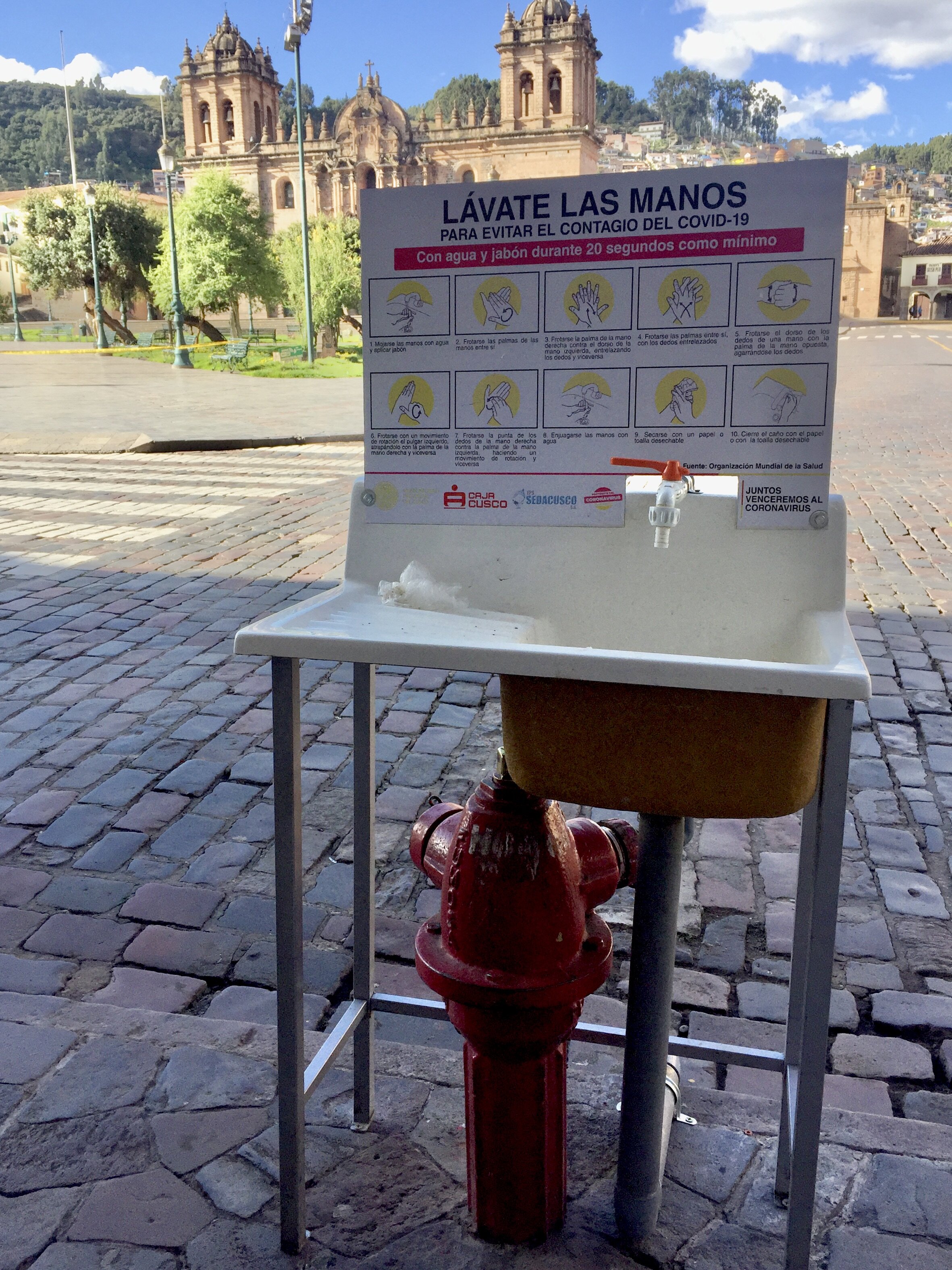
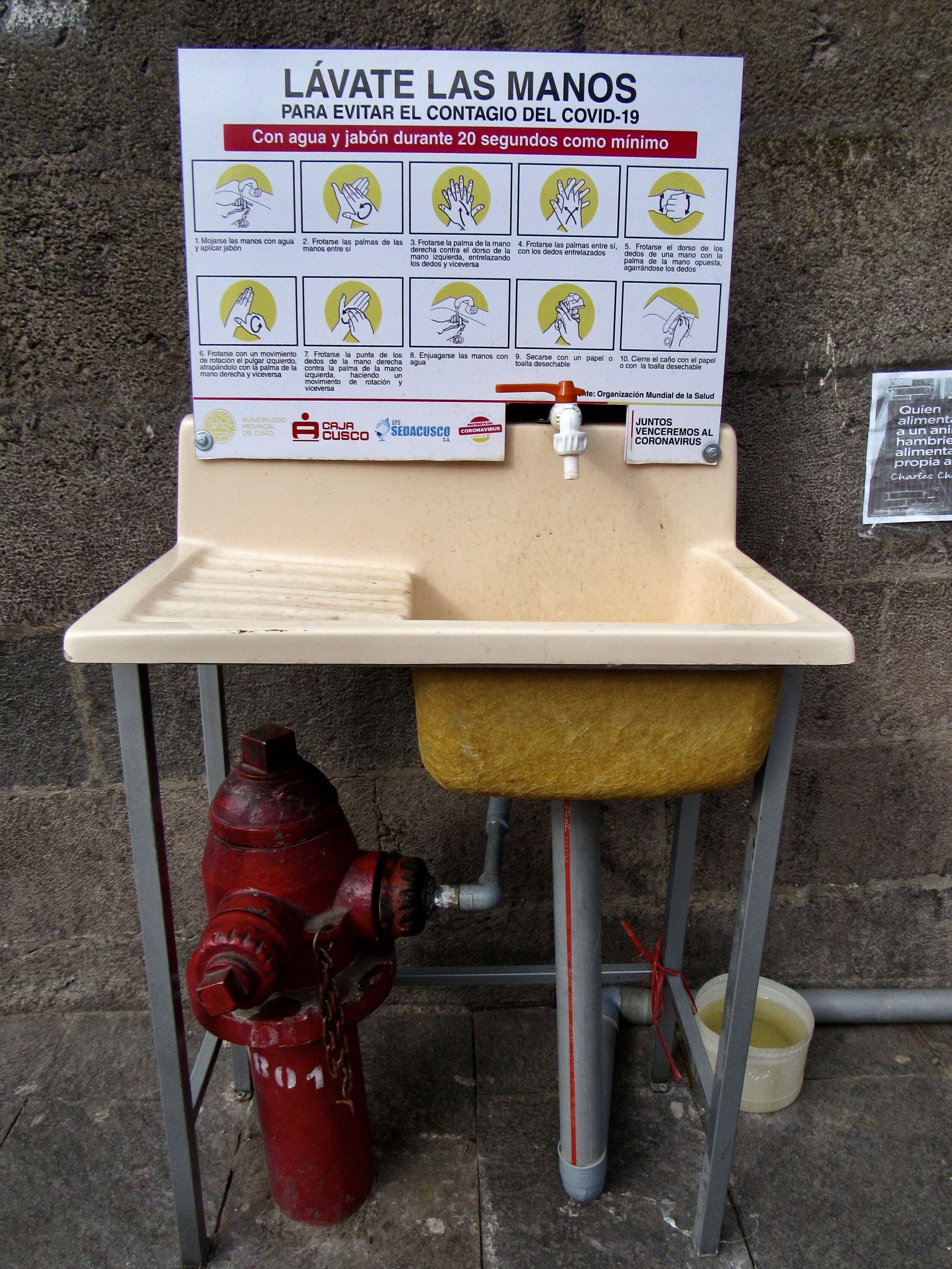
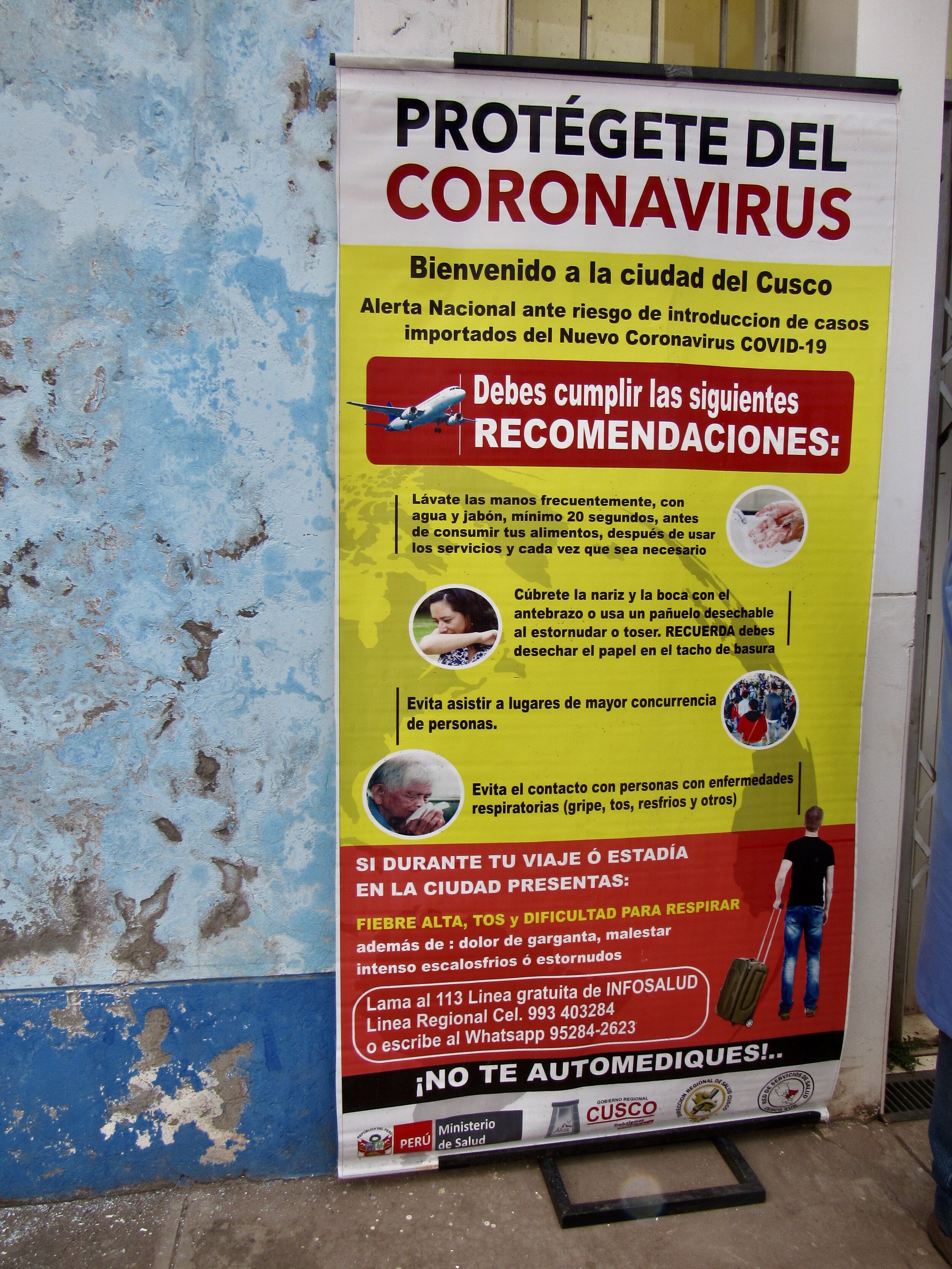
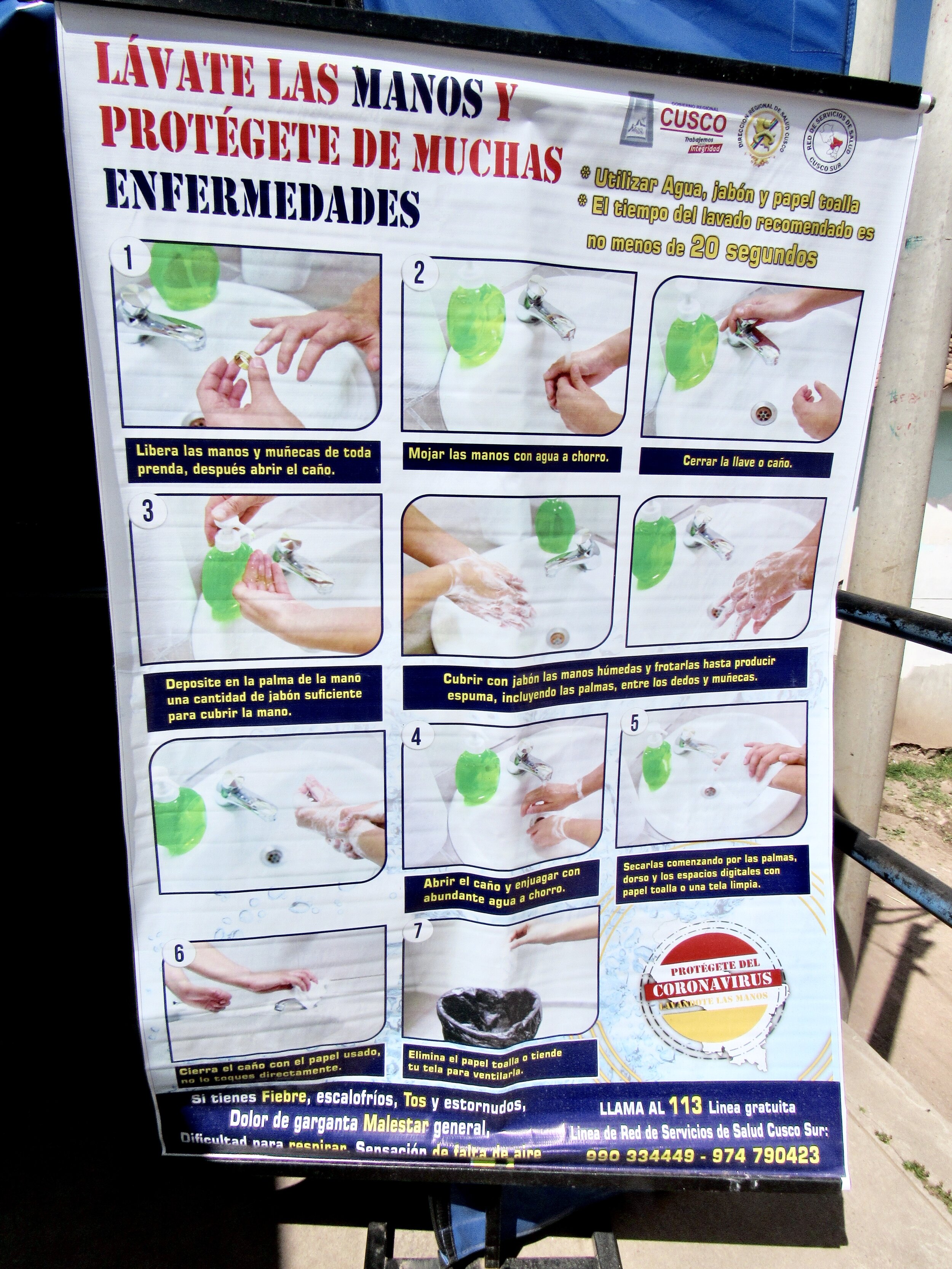
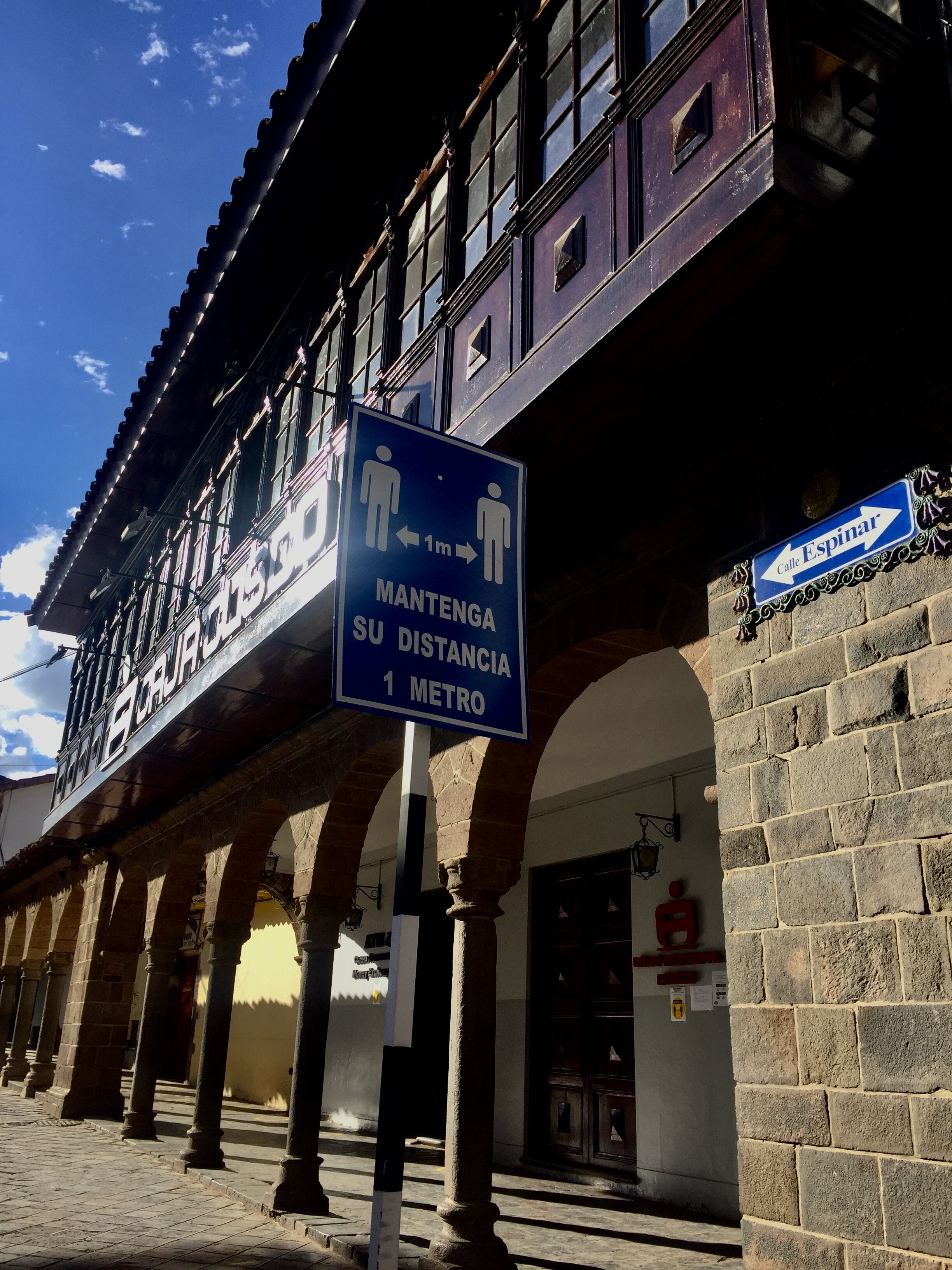


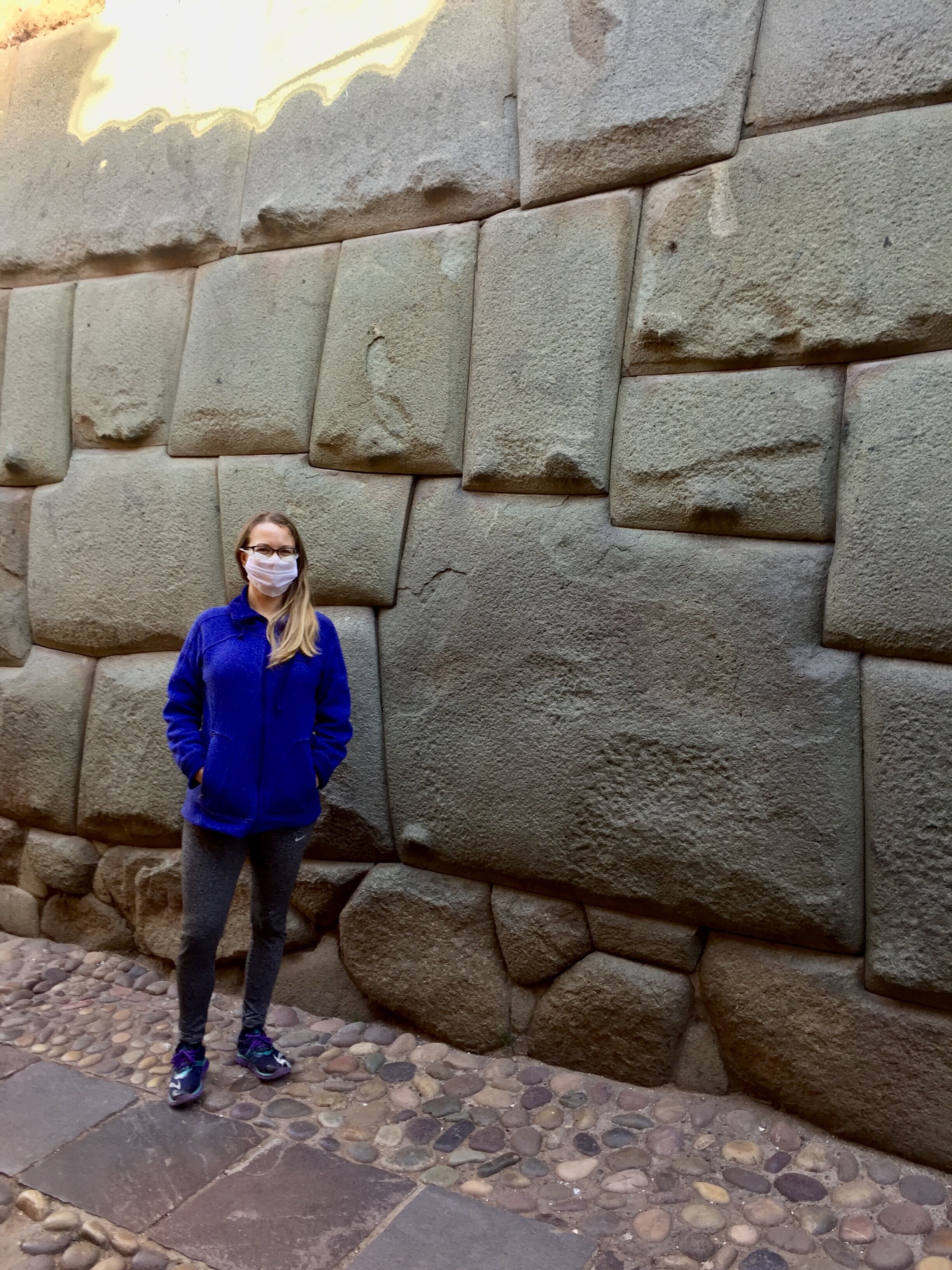
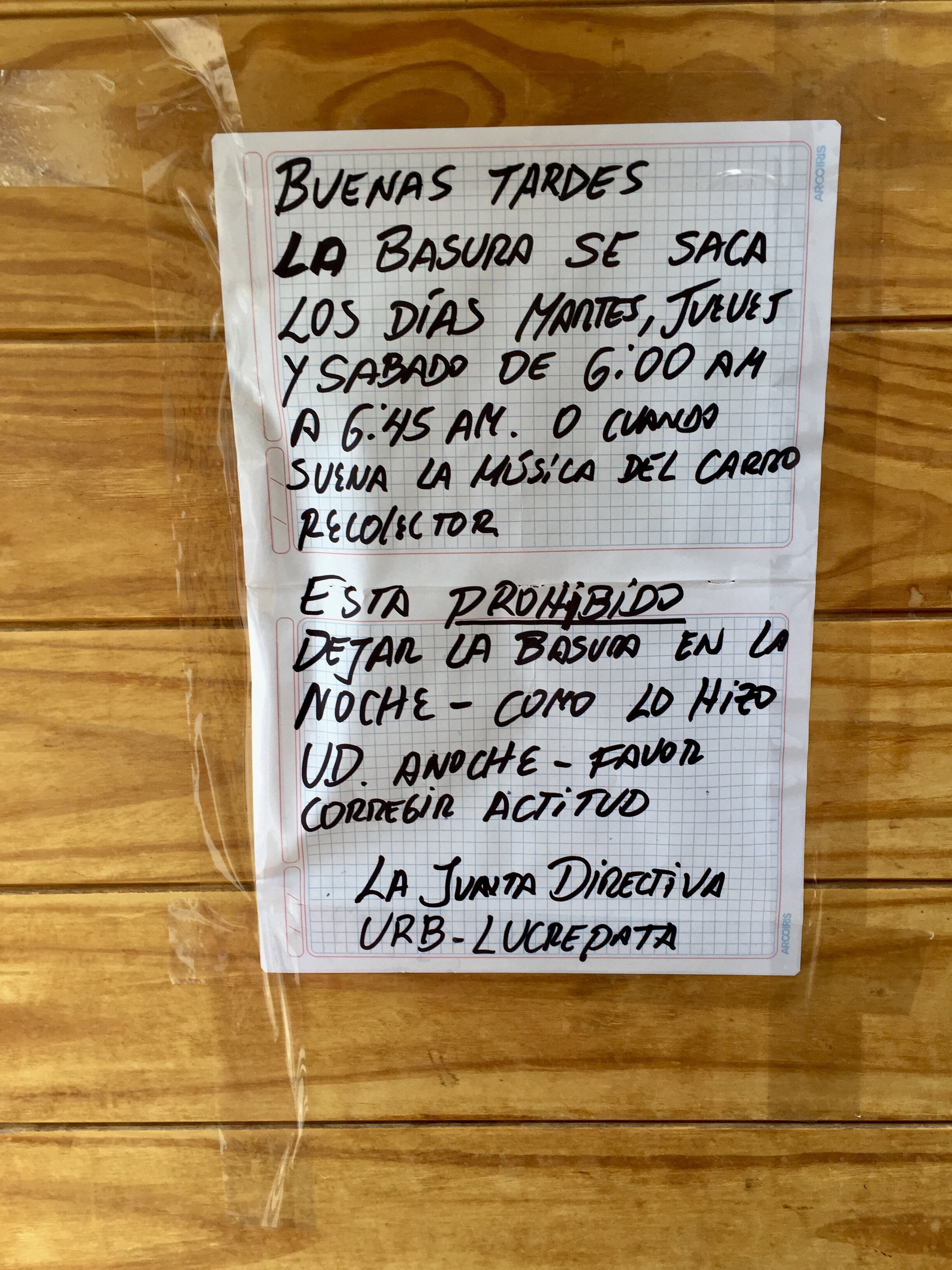
Sunday, 17 May, 2020
63 days down, 7 to go
Yesterday was so much excitement with taking food to the rural communities outside of Yaurisque that I’m exhausted today. After nine weeks of sitting on the couch, getting up early to go to the equivalent of Sam’s Club or Costco, then driving with the mayor of Yaurisque almost two hours from Cusco, then giving out food to over 200 families, then coming all the way back to Cusco, was way more action than I’ve had in nine weeks combined. It was immensely satisfying and truly a privilege to be able to distribute aid to so many people. Tomorrow I’ll start the fundraising for the next village. Today I’m going to watch birds out the windows and maybe sit up on the roof with my book, if the sun comes out later.
Monday, 18 May, 2020
Today I’m feeling the post Saturday let down. After the buildup to, and excitement of, taking so much food to so many people, I feel listless and my morale is down. I know that I need to pull myself together and start fundraising again, but I’ve just lost my energy. It’s hard to even convince myself that people are counting on me. Until Henry has found another village or community in need of immediate assistance, I’m having a hard time convincing myself that anything I do today really matters.
I did make myself go to the market after work, since I’m almost entirely out of food. It’s the same handwashing station at the entrance, the same few vendors who brave exposing themselves to the germs of all the customers and the same yellow circles painted on the ground, showing you where you can stand, to be sure that you’re at least a meter from the next customer. The fruit and vegetables are still fresh, so that supply chain is still okay. However, the woman I buy chocolate and coffee from hasn’t gotten any new supply since March. The coffee I buy has an expiration date of January, 2020 and she doesn’t have any new chocolate. All that’s left are the same bars of milk chocolate that I’ve picked over for two months, looking for the last few bars of dark chocolate.
Still, I know that feeling sorry for myself is ludicrous compared to the true desperation I saw on Saturday. I have both a job and savings, while there are plenty of people who no longer have either.
I make an apple pie to cheer myself up and listen to El Sonido. Chilly always has an upbeat mix for a solo dance party in the kitchen.
I’ve been sitting on my roof to get sun for ten weeks now. Apparently I’ve only been looking at the birds and the mountains, since I only now noticed this goat skull on my neighbor’s roof.
Tuesday, 19 May, 2020
Today after work I went out with a friend for lunch. That would have been such a boring statement two months ago. Definitely nothing to write about. Now it feels scandalous. He told me where to meet him, but when I got there, I didn’t see anything. No restaurant signs, no open doors, no signs of life. After a minute of standing there puzzled, I heard voices in one of the buildings. I knocked on an unmarked door, which opened just a crack, and a guy with tattoos on his face asked me what I wanted. I told him I was looking for Steve and the door opened wide.
Inside was a tiny restaurant with only two tables. One table was occupied by a neighbor of mine, who had contributed to the Covid Relief Project and lent me a couple books last week. The restaurant owner seemed surprised that we knew each other, but I’m starting to get the impression that there are so few foreigners left in Cusco that we all know each other. Besides all of the foreign tourists leaving, lots of foreign residents left on the repatriation flights that the Peruvian government allowed up to April 21st.
I found myself in a secret ceviche restaurant that does not currently serve ceviche. Supply chains are apparently only partly working and the menu is now maki. I ordered a California roll and a veggie roll, which were both delicious. I was just so happy to be eating something besides my own cooking for the first time in two months.
Phase 1 of Peru’s plan for economic recovery was supposed to allow for restaurants to open for take out and delivery, although that hasn’t really happened yet. Any restaurants operating on any level are not yet legal. There are still lots of police and military on patrol, but enforcement seems to have relaxed.
Rather than go directly home, I walked across the Plaza de Armas, with the excuse of going to my bank for an atm run. New, since my last time going to the bank, is a handwashing station built over a fire hydrant. I’ve seen a couple of these around town now. Not all are built over fire hydrants, but all have directions on how to wash your hands. Also new, outside my bank, is a sign telling people to keep a distance of one meter between each other. When we finally are allowed out of our homes, we are going to find a whole new world out there.
Wednesday, 20 May, 2020
I’ve heard from my friends who are guides that the government will be opening Machu Picchu and other tourist attractions starting July 1st. I hope that they’ll stick to this date, even if they haven’t stuck to what they promised for Phase 1 in May.
Today, after work emails, I did a little research on the details of this plan. Not only Machu Picchu, but dozens of archeological sites, museums and nature reserves will be free. Children under 18, seniors over 65 and public servants will all get free entry through the end of 2020 - regardless of nationality. That’s good news for Peruvians who want to see these places and for those of us who hope that foreign tourists will come back. All of the archeological sites on the normal Sacred Valley tour will be free, as will all of the museums in Cusco.
Those places are already free for me, as a legal resident of Cusco. I didn’t actually know about this added benefit of being officially Cusqueña until my friend Amanda visited in February. I could hardly believe that I was allowed entrance to all of the government owned places in the Sacred Valley for free. I still had to pay for Machu Picchu, although I got the reduced rate for locals. Not only was it an unexpected financial benefit, it also made me feel even more like I belong here.
I moved to Cusco because I love the city and want to live here. Getting a job and having an address make me feel like I belong, but not as much as realizing that I get free entrance to all museums and archeological areas. Not every Peruvian gets that benefit, only residents of the region of Cusco - including me!
Thursday, 21 May, 2020
My fundraising skills need a lot of work. I have been posting on the Facebook page and Instagram account for the Covid Relief Project, but only have received two donations this week. I need to pull myself together and figure out how to pull in more donations.
The hurry is not that we need to get this done before the quarantine ends. The economic disaster here will be all of 2020, because we are so dependent on international tourism in the Cusco region and tourists will not be traveling internationally this year. Or very few. It won’t be enough to employ all of the people here who are out of work.
The hurry is that people are running out of savings.
The government has announced a new financial assistance package which will give s/760 per family. The first financial assistance was almost two months ago, was only s/380 and fewer families were eligible. The new s/760 per family sounds like it will go to more families than the first s/380.
This will certainly help, but it won’t last until the tourists come back.
Friday, 22 May
I unplugged as much as possible this week. Except for the emails and website editing for work every morning, I have stayed offline and haven’t even checked CNN all week. However, today was another Presidential address, which I watched live streamed on Youtube.
Every two weeks our quarantine gets extended, but considering the 4 phase plan announced two weeks ago, I was really expecting the president to expand on how these phases would be carried out. I was expecting an explanation of why Phase 1, which was slated for May, had not really started yet. Instead, what I heard was that the quarantine is extended through the end of June. We didn’t get the usual two week extension. We got a 35 day extension this time.
The president did promise some modifications, starting Monday. He said that curfew for most of the country has now been pushed back to 9pm. The full list of modifications and explanations will be released tomorrow.
Saturday, 23 May
69 days down, 36 to go
The salvation, rather than the devil, is in the details today. News stations have published the short and sweet of the lengthy legalese of yesterday’s decree. The news I have been hoping for is finally out! I can go for a walk by myself, as long as I am wearing a mask and am alone. I am honestly so relieved. I can’t wait for Monday so I can go for a walk up to the Temple of the Moon!
There are also more businesses allowed to open: hair salons, laundromats, plumbing and hardware shops. There will also be home delivery of all sorts of things. Some of that has already started. Every day now I hear people in the streets selling food, announcing what they have on cheap megaphones. On the list of allowed delivery, besides food, is now clothes, shoes, electronics, and books.
More important for many Peruvians is that professional soccer will be allowed again. Normal people still can’t play team sports, but at least we’ll be able to watch the pros on tv again. I’m not a big soccer fan, but exercise is allowed again and that’s all I really care about at this point.
Quarantine in Cusco: Week 9
After only one week of planning and fundraising, Henry and I were able to take food aid to over 200 families.
Sunday, 10 May, 2020
56 days down, 14 to go
I started today by calling my Mom for Mother’s Day. As with the birthday call, it’s hard to have any conversation without it turning to the pandemic at some point. It sounds like in Idaho people are starting to go out a bit and more stores are opening up. There are lots of people in parks and on the hiking trails near town. Her county hasn’t had any new cases in a couple days, so maybe I shouldn’t worry so much about things opening up there.
I’ve been checking in with friends around the world and no matter who I call, they say something similar.
From a friend in Lima: People here aren’t respecting the quarantine. Peruvians just won’t let the government tell them what to do. People in Lima never follow the rules.
From a friend in Paris: Parisians don’t let anybody tell them what to do. They’re going out all the time and not respecting the order to stay home. The French just don’t follow rules.
From a friend in Seattle: There are so many people in the parks! They’re walking too close to each other and not respecting the 6 feet rule. Americans just won’t let the government tell them what to do.
From a friend in Morocco: People here are still going out walking in the streets with their friends. They’re not respecting the quarantine at all. Moroccans are terrible at following rules.
From my parents: The Lieutenant Governor of Idaho went to a bar that is open illegally! The state is threatening to revoke its liquor license. The Lt. Governor is not following the rules set by the Governor. The bar was full! Idahoans are not following the rules.
At some point we are going to have to drop the nationalities from our complaints: People don’t want the government telling them what to do. Human beings don’t like to follow the rules.
I will concede that my friend in Shanghai did not say the same thing as everybody else. Apparently in China at least some people are following the rules.
Monday, 11 May, 2020
My morale is down as I start the work week. It’s the same cancelations and postponed trips, the same disappointment at not getting to see Machu Picchu this year. A few ask me if they can reschedule for this July or August. I don’t have the heart to tell them that I don’t think Peru will allow international flights to land until September. If the airlines won’t let them rebook their flights, then I don’t have to be the one to cancel their trip. If by some miracle they can get to Peru, we will take them on a trek. I can figure that out, but I don’t see the government opening Machu Picchu or the trains running again until international flights are back.
The worst news this morning is that my housemate Kerry lost the job that she was supposed to start June 1st. She was hired as the director of a summer camp in California and has spent months hiring counselors on Skype and Zoom, getting ready for camp to start. Even if summer camps in the US are able to run this summer, she can’t get a visa. The US Embassy in Lima is closed for everything except repatriation and emergencies. Getting her a work visa doesn’t qualify as an emergency.
After several calls to the hospital in Cusco, I find out that I’m not an emergency either. Buying medication I take regularly is not an emergency. When I answered no to questions about fever, difficulty breathing or exposure to a person with Covid, they just about hung up on me. When asked, they did say that I could come in if I was having a heart attack, but that’s about it. I have a friend who has been able to get to see a doctor every two days since his dog almost bit his hand in half. So, I know it is possible to get into the hospital for something other than Covid. I’ll just have to keep trying.
Thankfully, I got some good news tonight! Henry has been in contact with several mayors in the Cusco region about us taking food donations to families in need. One village has 180 families and are in a desperate situation, according to their mayor.
Last Friday, when Henry and I brainstormed up how we can help people during the pandemic, I was imagining fundraising for 15 to 20 families every couple weeks. I had no idea our first project would be for 180 families! We got a $500 donation today, which seems like a great way to start our fundraising. Maybe we will actually be able to bring enough food to make a difference, even if we’re trying to make a difference for 180 families.
Tuesday, 12 May, 2020
There were very few emails this morning, so I started working on the subtitles for a video that my manager made about them taking food aid to the village where my employer hires their porters for the Inca Trail. Our company owner contributed some money and we had donations from two people who contacted the company, wanting to know how they can help the porters. Those are the kinds of emails that I love to answer! I’m glad they were able to do that last Friday, even if I’m a little disappointed that I wasn't invited to go along.
The disappointment just fuels me for my own project with Henry this Saturday. He has settled on the village of 180 families and the mayor said that they would provide transportation. That’s really the kicker. Henry and I can buy food. That’s easy, and legal. Going from Cusco to any nearby village is illegal. Henry and I have no way to get there on our own. The mayor said that they can get permission from the police and also provide transportation. I’m just going to trust Henry on this one. If he says we can do it, then I’m in.
After finishing the video subtitles and emails I still haven’t worked my full 4 hour shift. I edit the company website for a while, then take a peek at the news on CNN. It looks like Peru has hit another jackpot in terms of Covid. (Last week’s blog includes a link to a study about why the virus is weaker at high altitude, which is a jackpot for me, living at 11,000 feet). Some researchers in Belgium are studying how antibodies in llama’s blood can help vaccines, specifically a Covid vaccine. Peru has both high altitude and llamas in spades. If both of those things are truly helpful in this pandemic, I am more and more happy to be here now.
Of course, that’s only looking at the public health of Peruvians - which is absolutely the most important issue right now. However, bringing tourism back is also a very important issue. As many countries around the world are wondering where the line is between letting people make a living and keeping them from dying from the virus. Most people can’t work from home or work online the way I can. Granted, I’m now part time on 50% pay, but I do have a job. One article that made my heart drop is the idea of a 2 week quarantine upon arrival to another country. Even people who still have jobs and have the money and nerve to travel this summer, do they want to be in a hotel quarantined for two weeks before they can come to Cusco to see Machu Picchu? If those people exist, I bet there aren’t very many of them.
Another article on the future of tourism floats the idea of immunity passports as a way to cross international borders. It also goes into the idea of travel bubbles between countries, like the proposed travel bubble between Australia and New Zealand. Like last week, the only nearby countries with small enough outbreaks that I would be comfortable having in a Peruvian travel bubble are Chile and Argentina. However, even if things are going well in Cusco, Lima is still a disaster. I highly doubt anybody will want flights going in or out of Lima for a while. I wonder if we can get international flights to land directly in Cusco. Before the pandemic, I believe the only international flights from Cusco were to Colombia and Bolivia. I just don’t see the international tourists coming back at all this year. I’m afraid to say that to any of the guides I know here and really hope that I’m wrong. I just don’t know what we're going to do in Cusco without tourism.
Wednesday, 13 May 2020
Today started with some fantastic news! Two more people want to donate to the Covid Relief Project! We actually have enough now to buy something for all 180 families. With a little more, we could do better, of course. Still, we can at least take 3 kilos of rice for each family. Depending on how you stretch it, that can get a small family through a week.
After a flurry of thank you emails and discussions with Henry about how much he can get with the money we have, I take a minute to look at the news, hoping for another article about miraculous antibodies in llama blood. Instead, I find 2020 is a catastrophe for the tourism business. Yes, thank you, I am very aware of that.
The article claims to know “what the industry needs to get back on its feet.” Unfortunately, the answer is not llamas. Or alpacas. It’s domestic tourism. That is very unlikely to do much for Cusco. The only domestic tourists we used to get were from Lima, which is currently such a disastrous outbreak that I’m worried the international news will pick it up as the next Guyaquil. One reason I scan the international news is to reassure myself that Lima hasn’t been called out as the next New York or something terrible like that.
After the hopeful start to the day with the new donations, I got bad news from home. Dad went fishing and fell on the slippery rocks at the side of the river, causing a big bruise on his left hip. Yesterday, he could walk. Today, the swelling is so much worse that he can’t walk and Mom took him to the ER. Under the new Covid rules, she wasn’t allowed to go in with him. She just had to leave him there. The nurse promised to call every hour with an update. It’s late enough here that I’m not going to try to wait up to hear what happens. I’ll just hope for good news tomorrow morning.
Thursday, 14 May
Good news it is! Dad is home with a terrible bruise and terrible swelling, but no broken bones. The cure is rest, hydration and a good diet. I am so relieved!
My poor housemate Kerry has been posting on Facebook to try to find a new charger for her laptop. She has gotten some legit responses and some people who tell her that she can get it fixed just about anywhere. One person actually told her to just go look for open doors, after Kerry pointed out that most shops are closed due to the pandemic. I am having a hard time imagining a pharmacy offering to repair a broken charging cord. After all the ridiculous responses that she got, I was very doubtful about somebody who replied to her that he had a cord and would sell it for 100 Soles.
Nevertheless, now that she lost her job in California, she has had to double down on teaching English online. Obviously, if she can’t charge her laptop, she will lose that job too. So, we set off to find this person in the hopes that they really had a cord that would work for her computer. I was enlisted in the operation as the Spanish speaker.
Of course, today has to be the day that they have made new rules about public transportation. Now it’s only from 6am to 9am then from 3pm to 6pm. Yes, busses are still running in Cusco. It sounds scandalous to me too, but they are at less than half capacity, with every other seat marked as off limits. After lots of busses passing us by because there were already ten people in the bus, then the wrong bus, which eventually turned out to be the right bus, we got to the corner that the guy had sent as his location. We texted him and he said he would be there in ten minutes, then wrote back again to ask us to walk down the street, cross a bridge and wait for him in front of a hardware store. I was starting to feel like this was a wild goose chase. Did this person even exist?
Eventually, a guy came out of a nearby alley and waved to us. Despite being almost the only people in the street, I wasn’t sure that he was waving to us. He called out “para el cargador” so we followed him. He went in an unmarked door and asked us to wait. A few minutes later he emerged with gloves on and a spray bottle of alcohol. He sprayed our hands and the soles of our shoes, then led us into what could have been a car repair shop or a bar. It seemed to have everything for both. Then he went into a little side door, down a dark hallway. It was the sort of place that I would hesitate to go alone.
All of a sudden, we were in a video arcade. There were lots of new computers for gaming, but also some old arcade games that looked like they belong in a museum. He went through boxes of cables and chargers, none of which worked. Finally, he pulled the cable off his printer. Jackpot! Then I had to convince him that we had come all that way and he was going to have to sell us his printer cable.
Mission accomplished and the right bus found for the way back, we were walking up the hill to our neighborhood when I noticed the sky getting a little pink. That had taken all afternoon but at least we were getting home before dark. Looking down the valley towards Mt. Ausangate, I was surprised to see the snow covered peak with sun still on the very top. It has been so cloudy for the past couple weeks that I haven’t seen Ausangate in a while. It was beautiful.
After dinner I got more good news. A friend here in Cusco told me that the results of the study I’ve been so excited about the past two weeks finally broke on the local news. All the local news stations were talking about how the Covid virus is weaker at higher altitude and how those who live at higher altitude are also less susceptible. This is better than the miraculous llama blood story.
Friday, 15 May
Henry just sent me a copy of the document that will allow us to leave Cusco tomorrow - leave and come back! It looks super official with the name of the community we are going to and our names at the bottom. It is also for the Covid Relief Proyect, which is close enough to Project that I’m going to let it slide.
Unfortunately, back in Boise things are not so great. My Mom told me this morning that she had to call an ambulance to take Dad to the hospital because the pain is so much worse that he can no longer sit or stand. Considering that right after the fall on Tuesday, he could walk, albeit with a limp, he is definitely getting worse. Mom wasn’t able to go with him because of Covid, but she is getting regular phone calls and promised to update me as the day goes on.
Here in Cusco, things are going really well. I made the last ATM run to get another s/700 from three donations that came in yesterday, which added up to $200. Withdrawing s/700 from the ATM took $207.48 from my account, but that will even out another donation. Wednesday I took s/1000 from the ATM for a donation of $300. It took only $298.88 from my account, so I have a couple dollars here and there to even it all out. I am so thankful that my credit union refunds all atm fees and foreign exchange fees, so I can actually receive donations without losing any of it to fees.
Also, one of my housemates and one of my neighbors donated in cash soles also, which brings us to a grand total of s/3550 to spend on food tomorrow morning! Henry and I are going to a wholesale place and I am going to bring out my Moroccan bargaining skills to see how much we can get for that s/3550. At a minimum, I am sure we can get 5 kilos of rice per family.
I called Henry to talk logistics and he mentioned that we would be passing isolated homes on the way to the village. He has been calling mayors, getting information about the needs of various communities. However, there are people who live out in the country and don’t really have a community or mayor to advocate for them. When he suggested giving food to people we pass on the way, I was quick to agree. We are expected to buy food for 180 families, but if we can help 200 or more, that would be incredible.
The late afternoon news from Boise isn’t great, but also not the worst possible scenario. My Dad will have to stay in the hospital over the weekend, since he can’t sit or stand. By Monday the blood thinner that he takes for a heart condition will have worn off, so they’ll be able to operate. He didn’t take it today, so with Saturday and Sunday also, the blood thinner won’t complicate the surgery on Monday. The worst part is that because of Covid, Mom can’t even go visit him. Tonight she took him a book and homemade cinnamon roll, but she has to leave it with the nurses.
As sad as it is for my Dad to be alone in the hospital, he is healthy besides this one injury. He is not dying alone like so many thousands of people around the world who are dying of Covid. I still wish Mom could go see him. She tucked a note from me in the book, but she can’t give him a hug for me. As sad as this is, I can’t even imagine how frantic I would be if something really terrible happened now. I don’t think it’s possible for me to get there if I wanted to.
I mentally send hugs to Dad, roughly 5,000 miles away, then start packing a backpack for tomorrow. It is going to be a very big day!
Saturday, 16 May, 2020
Today was amazing! You can see a lot of what Henry and I accomplished today in the photos of this blog. We started early with the shopping, buying 210 bags of rice and 180 bottles of vegetable oil for cooking. It was almost a 2 hour drive to get to the rural area where we distributed the donations, which made for a very long day. Especially after sitting on the couch for about nine weeks, it was exhausting. I’ll post more information and photos on this page of my website.
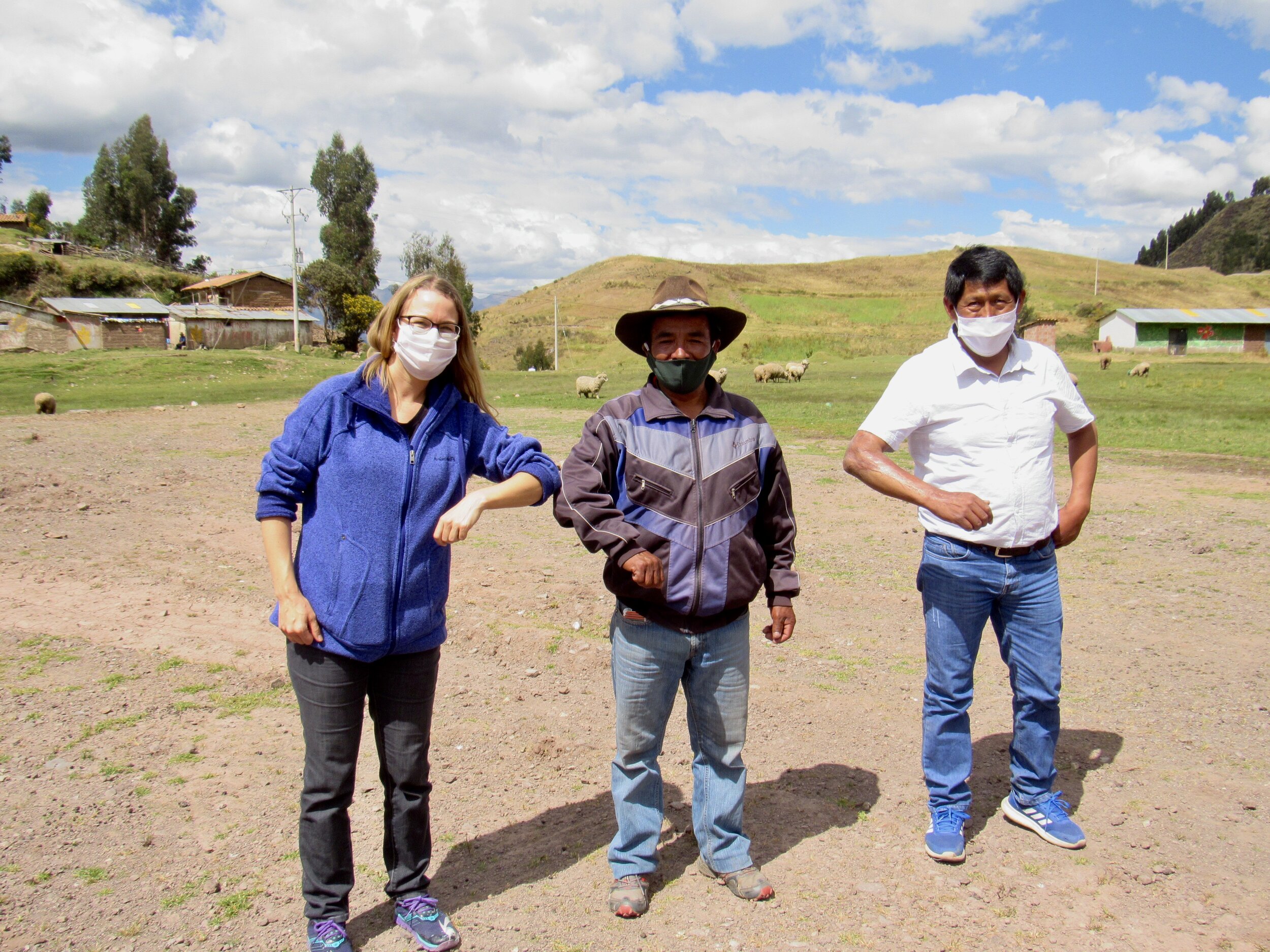

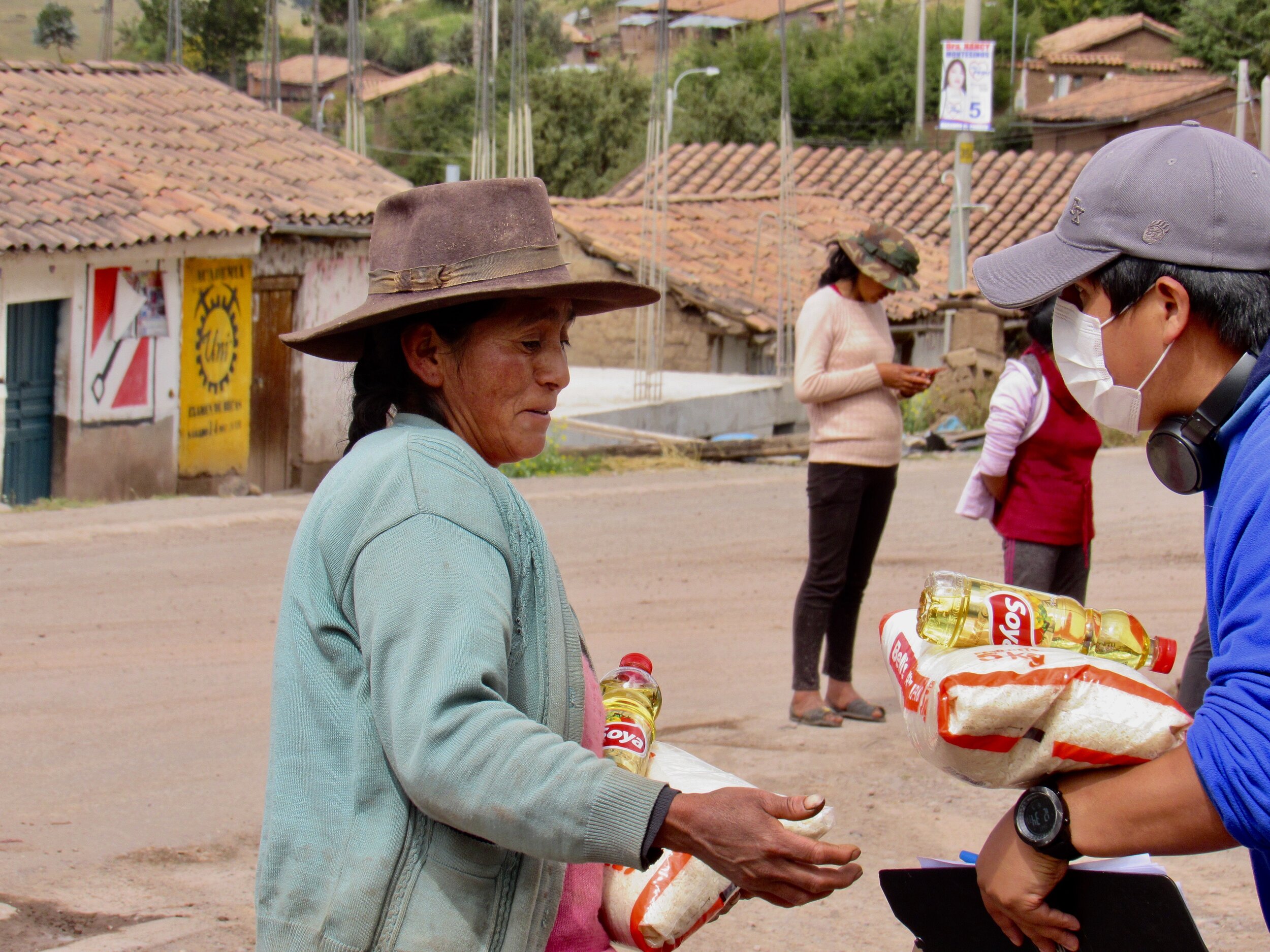
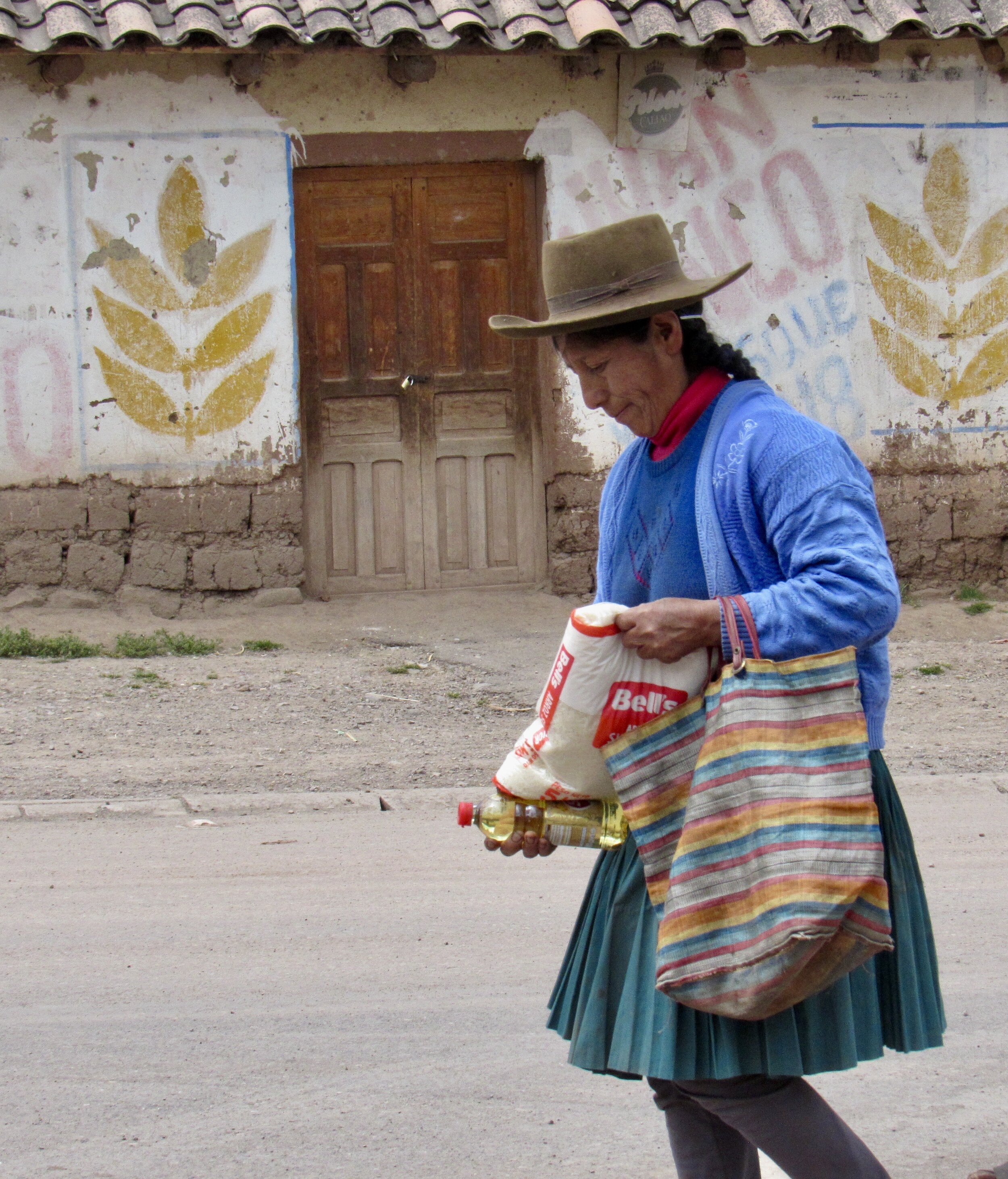
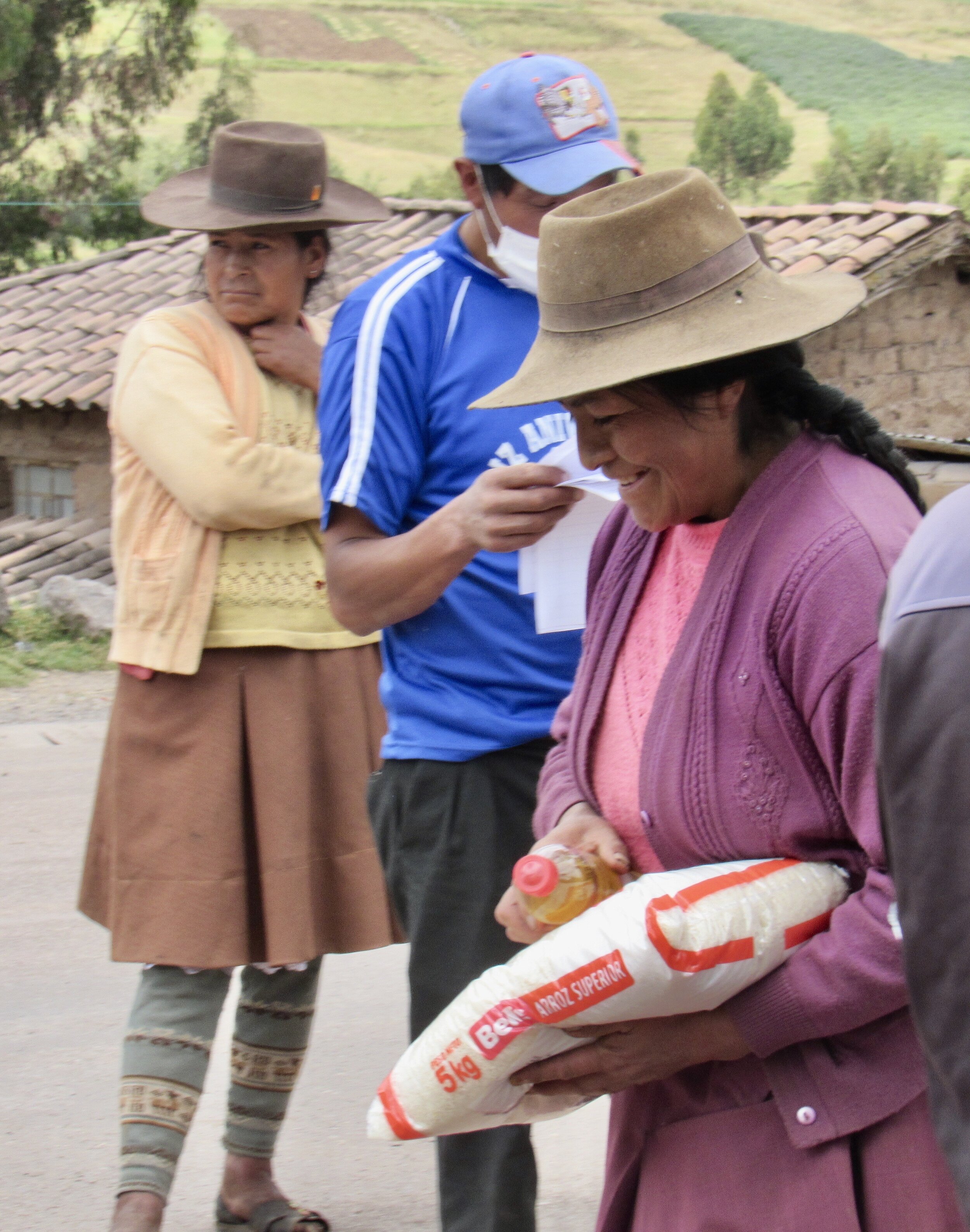
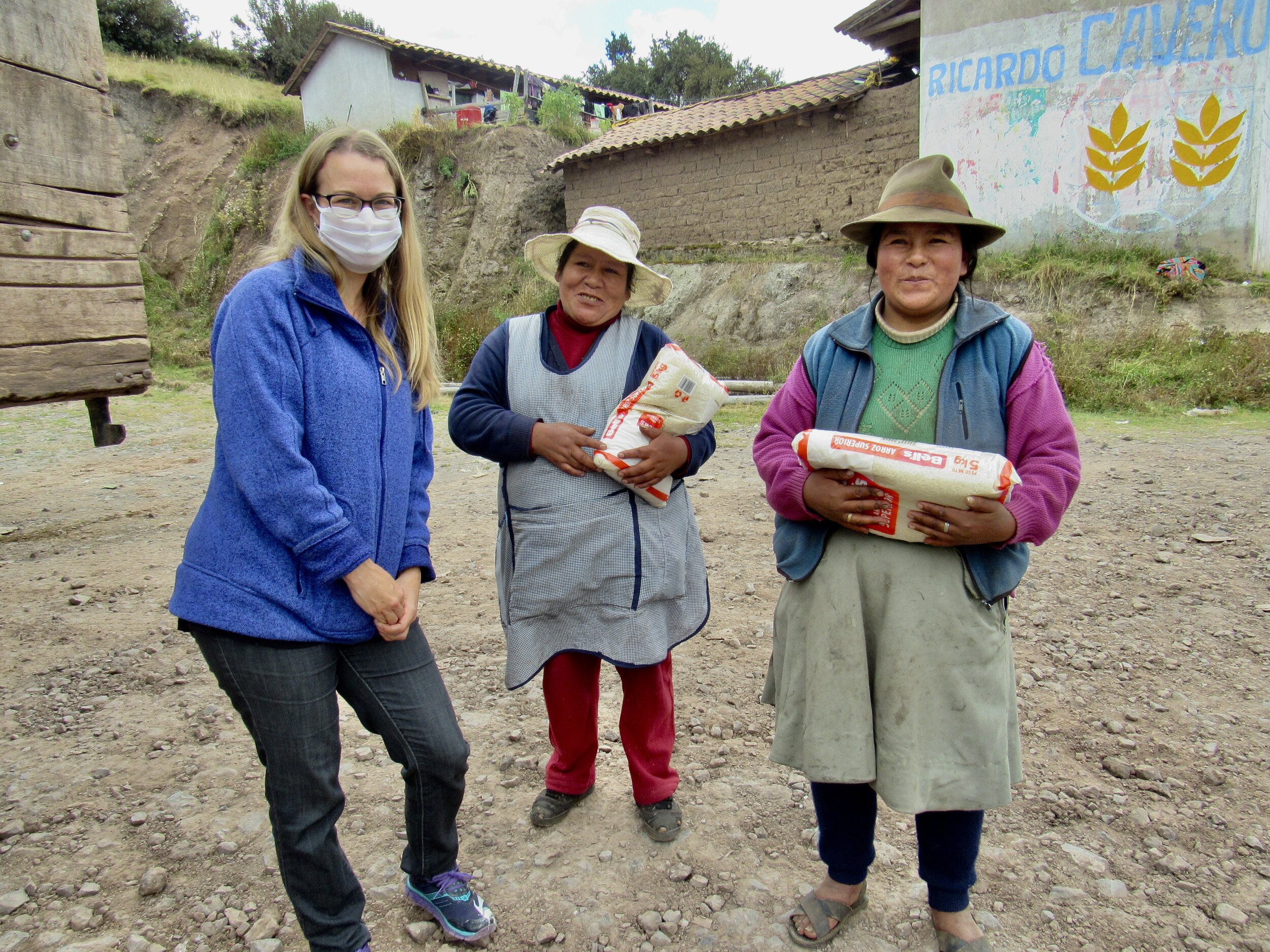

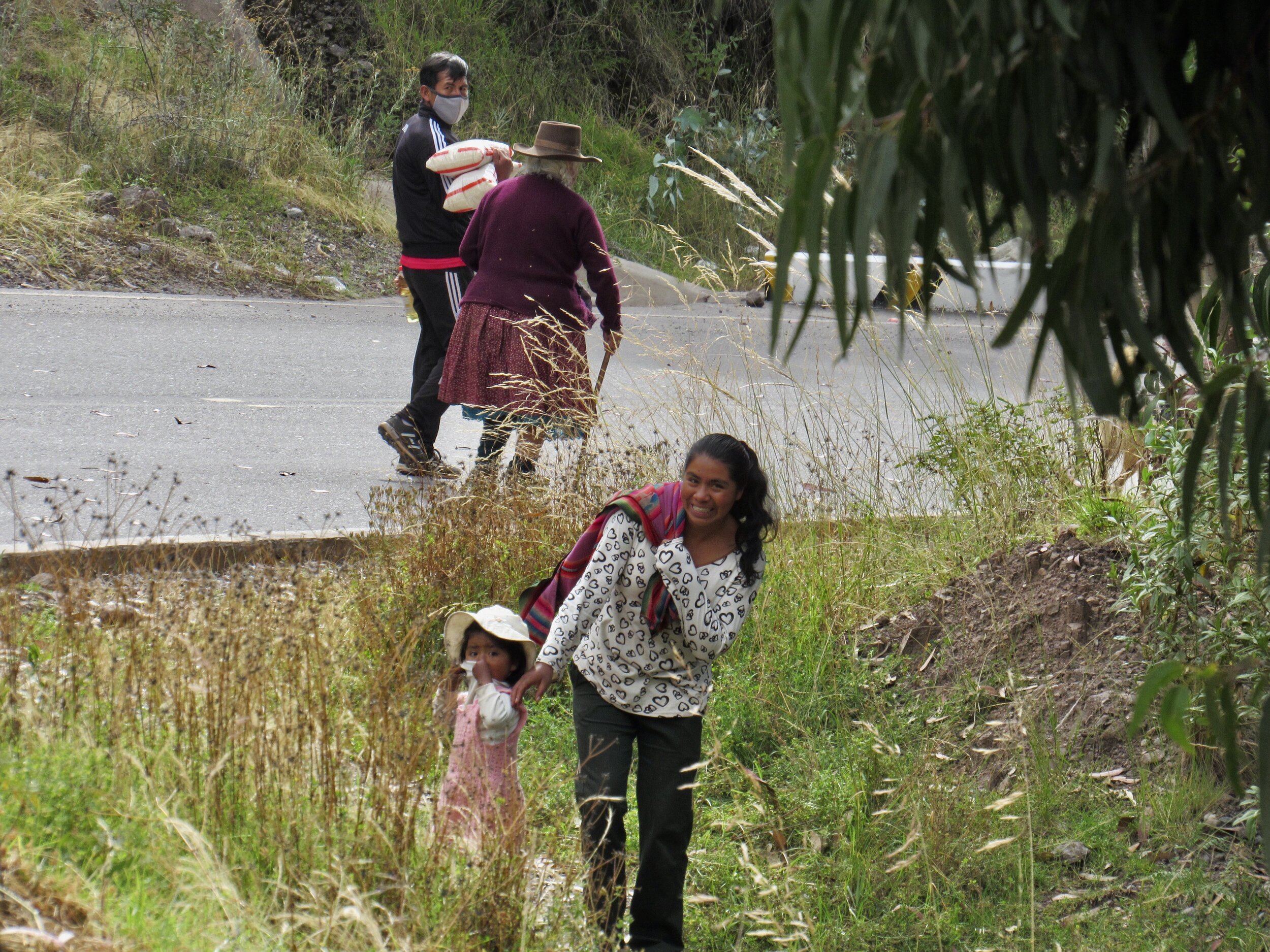
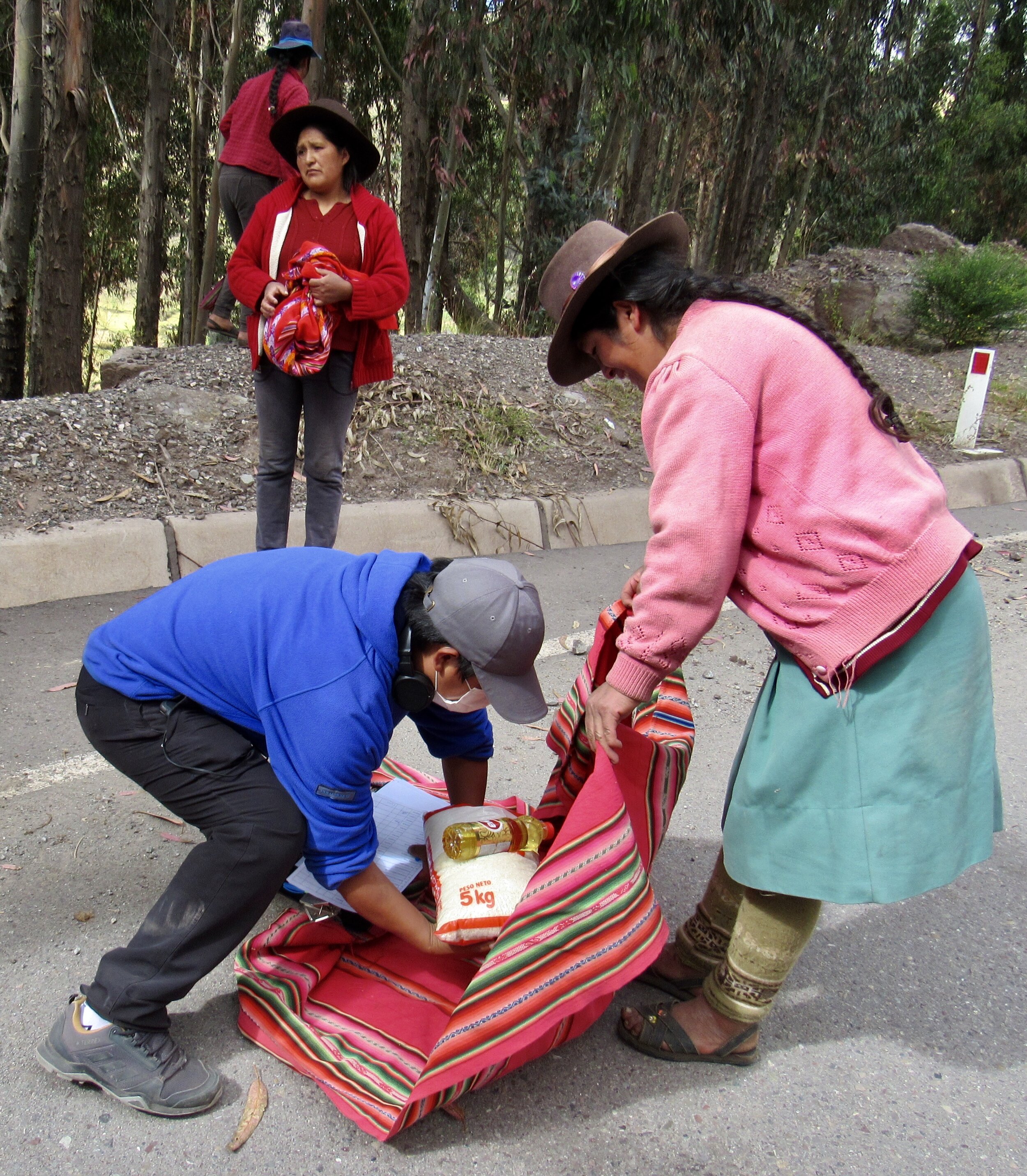
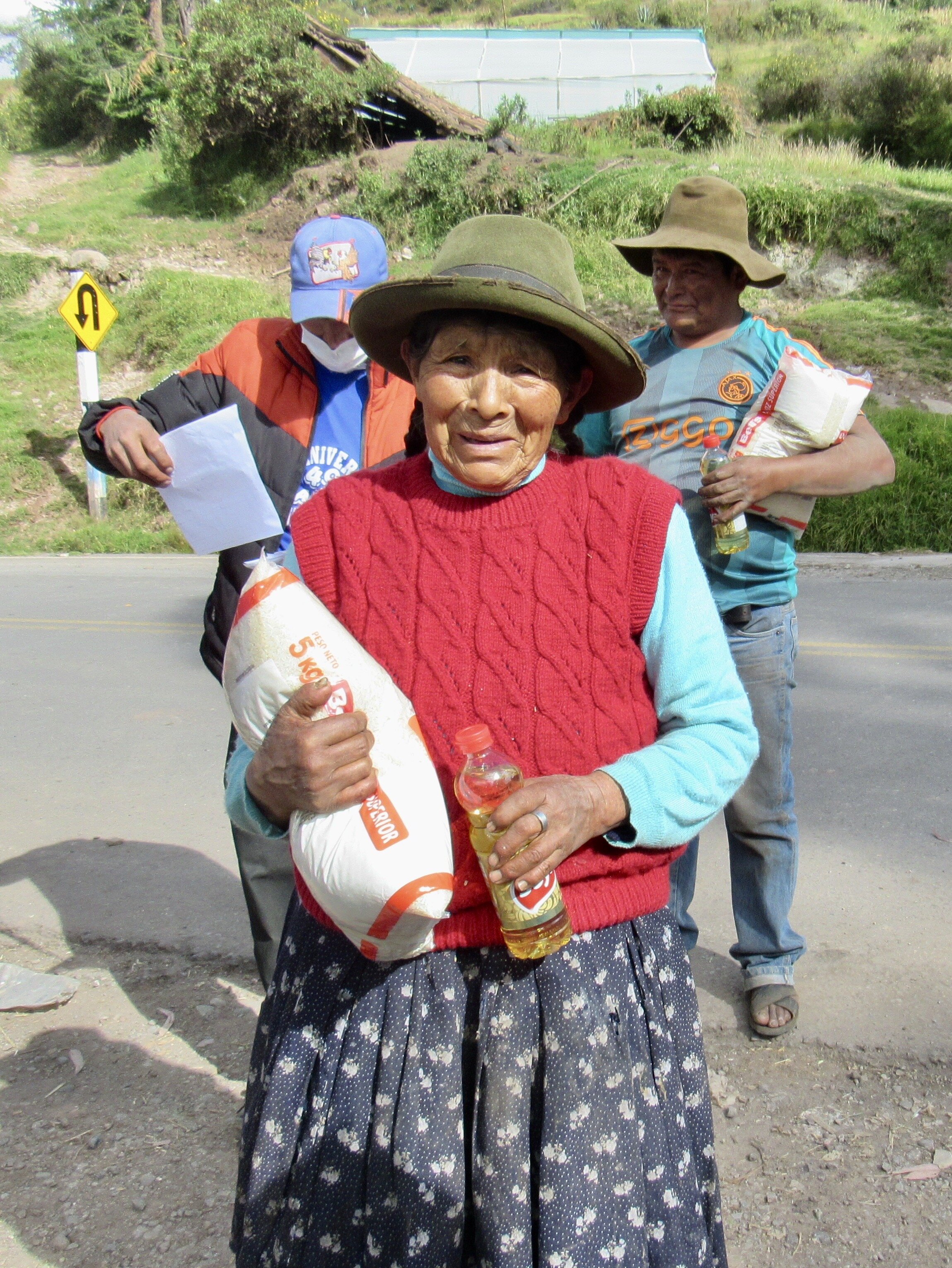
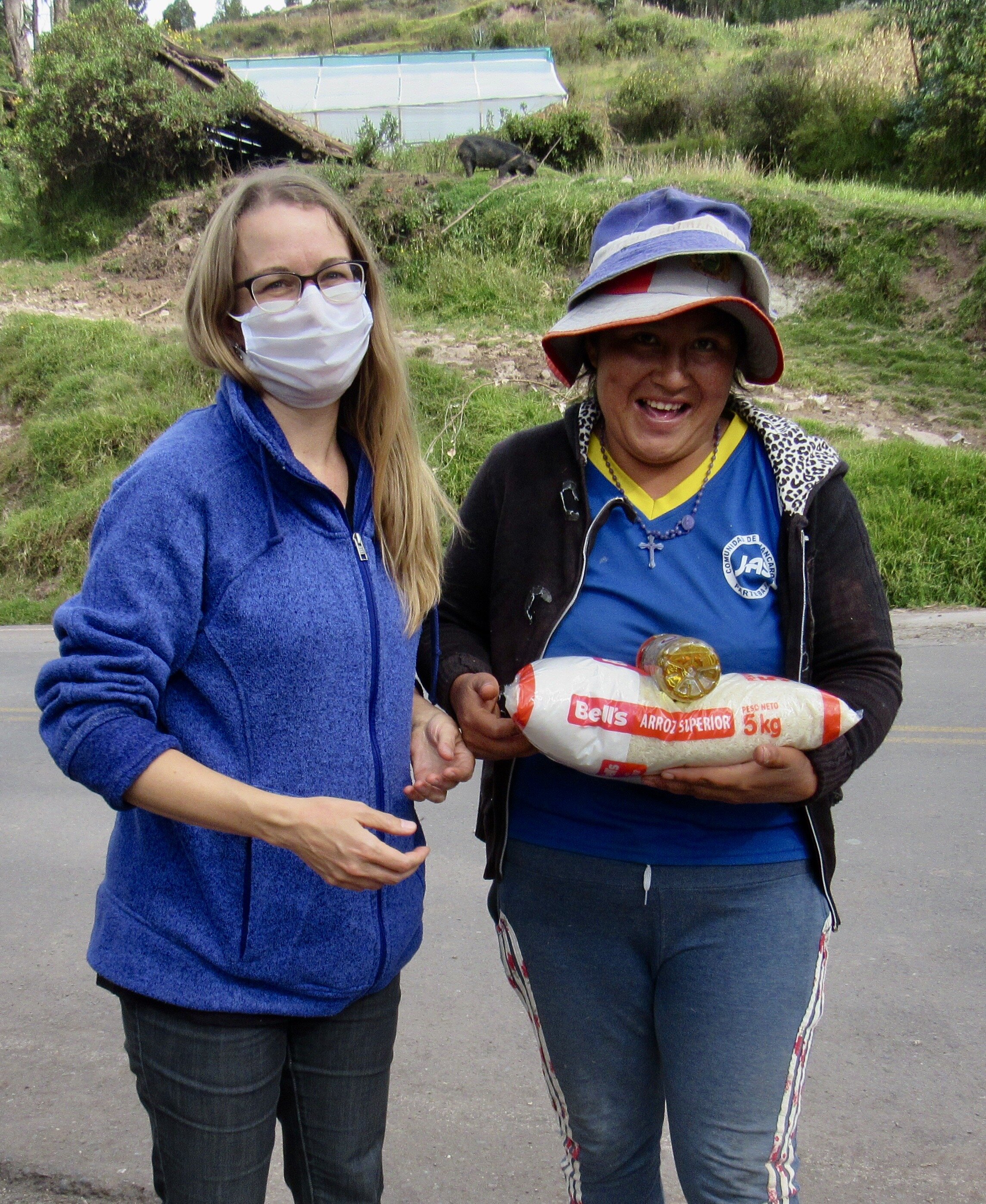
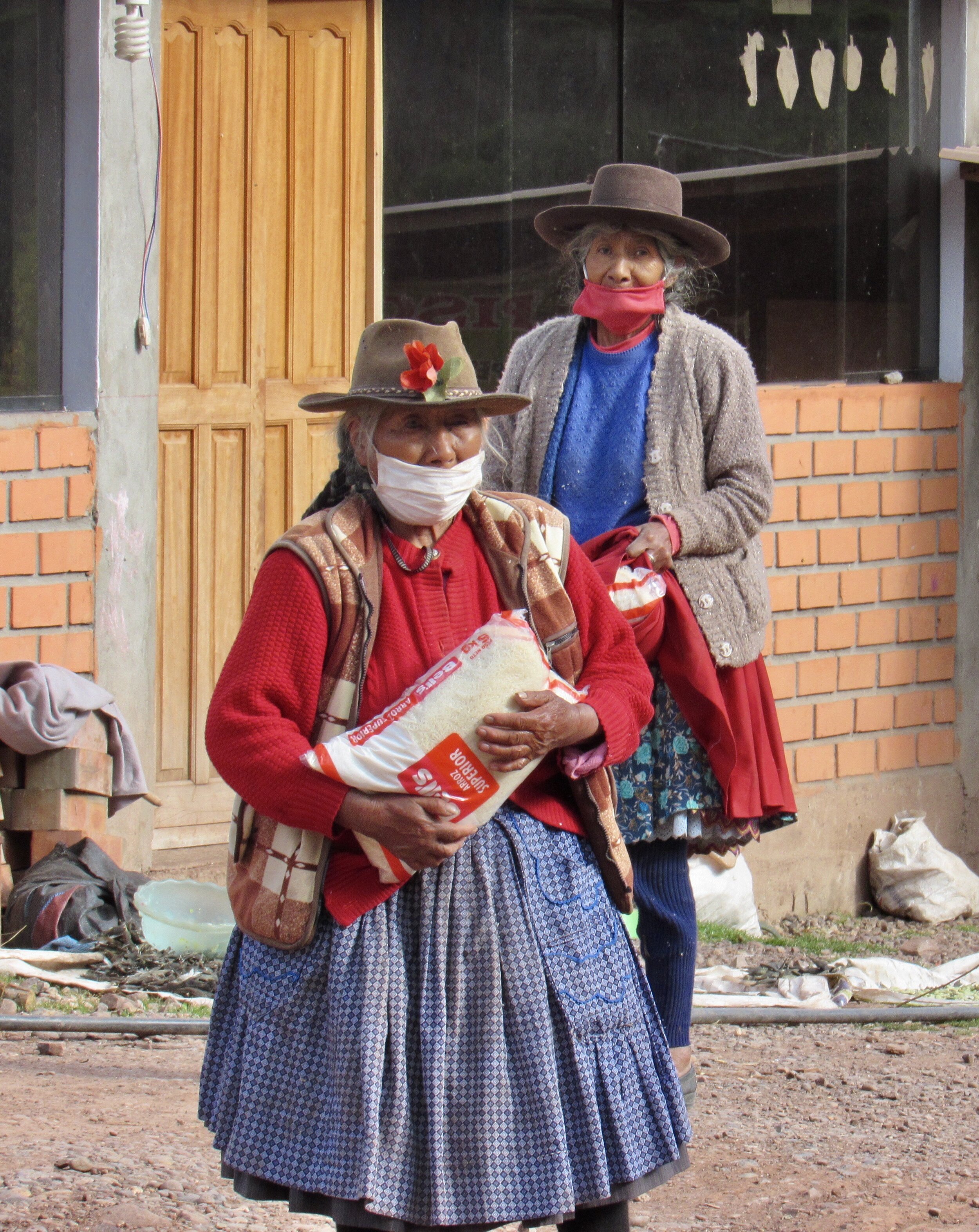
Quarantine in Cusco: Week 8
The quarantine is extended for a fourth time and I fight despair by creating the Covid Relief Project to bring food and supplies to remote communities in the Cusco region.
Sunday, 3 May, 2020
49 days down, 7 more to go (I hope)
Today I made my website live! As with any piece of writing, I wouldn’t call it done, but I had to set myself a deadline to be done enough at some point. It’s been a good creative project to keep me busy and I’ll continue to work on it, especially since I have at least another week of sitting at home. This time, surely, they’ll relax some of the restrictions next Monday. I’ve thought that before. I hate getting my hopes up every time.
Back to the uplifting environmental news, in Peru we have recorded the biggest drop in air pollution. I try to focus on the Pachamama getting a fresh breath of air. I’m trying so hard to stay positive. Even trying to focus on the improvements in air quality doesn’t get me that far. Environmental mitigation efforts and endangered species tracking and reintroduction are on hold, which sets so many projects back months or years. I know I’m not the only person who is vacillating between trying to stay positive and going down the wormhole of all the tragic news of the terrible things happening around the world.
Coronavirus didn’t make the news focus on the negative. I understand that we had already gone there long before most of us had ever heard of Wuhan. Still, the endless articles about how the world is falling apart in the same way is a new phenomenon. We all used to be falling apart for wildly different reasons - usually to do with the disparity of wealth by country. Measles in the US because of rich, white, suburban anti-vaxxers but tuberculosis in India because of overcrowded living conditions in slums. Global warming causes ski resorts in the US to have to rely on summer activities like mountain biking for income, while it causes homelessness in the Maldives as their homes get swept away by rising sea levels.
Now the news is COVID in the US, India, the Maldives and every other country in the world.
I used to read about travel because I like to travel. Now I read everything I can about the predictions for travel because I want to know if I or my friends in Cusco will have any work anytime soon. From what I’ve read, the answer is no. Even Afar, which is all about international travel, predicts that the future is road trips. The article is mostly focused on people who live in the US. Cusco isn’t very accessible by road. It only takes an hour to fly from Lima to Cusco, but about 18 hours to drive. One of my favorite things about Cusco, that it’s surrounded by mountains, makes it very impractical for any kind of road trip destination.
As I read about a proposed “travel bubble” between New Zealand and Australia, I wonder if maybe we could get tourists from Chile or Argentina before Peru will allow planes to land from North America, Europe or Asia. Why is it that the countries most of our tourists come from are the ones hit the worst? Maybe we’ll be able to get tourists from New Zealand and Australia ...
Monday, 4 May, 2020
Yesterday the government published their plan for reopening Peru in four stages and I’m still going through all of it. Of course, there are no firm dates on any of this, because getting to the next phase will depend on continued decreases in infection rates. In general, each phase is supposed to take about a month. So, Phase 1 is slated for May, which should get us to Phase 4 in August. Of course, Phase 1 will only start on May 11th and even then not everything allowed in Phase 1 will actually start that day.
Phase 1 will permit a few specific activities related to service and tourism. You can read more details (in Spanish) in this article published on larepublics.pe
Nowhere in this list is there anything that will help me, the company I work for, or any of the guides, cooks or porters that I know. Phase 1 has nothing for us. Phase 3 includes “transporte internaciónal aéreo” and Phase 4 includes “transporte naciónal e international en general.”
Assuming that we do have tourists by the first week of September, that will have been eight months without income for most porters and guides. I don’t even know if my boss can keep me on at half time through August. Even if I’m his only employee, will he be able to pay me for another four months before the tourists come back?
Tuesday, 5 May, 2020
I moved here the first week of August 2019, intending to be here for at least a few months, but maybe up to a year. I still want to be here, but I also want the option to leave, if I need to. Considering current travel bans, leaving is not an option. The US Embassy in Lima repatriated over 8,000 Americans while the Peruvian government was allowing “humanitarian” flights through April 21st. After April 21st, repatriation is being considered on a case-by-case, emergency only basis.
I currently don’t qualify as any kind of emergency, but I finally have to face the fact that the supply of medications that I brought from the US is running out. I have tried going to pharmacies near my house, but none of them carry either of my medications. Today I gathered my courage and went to a clinic to try to get some more information. Clinica Pardo on Avenida la Cultura is the closest to home, so I decided to try there first.
At first there was some confusion with the receptionist when I tried to explain that I didn’t need an examination, just help finding medication that is already prescribed to me. She turned me over to an administrator who was very helpful and found me a doctor who not only wrote me prescriptions for free, but also took my phone to show me how to look up which pharmacies carry them.
Since I work until 1:00, by the time I got to the clinic, got the prescription and figured out where I can buy the meds, it was too late. I wouldn’t have had time to walk there and also get home before curfew at 6:00. I will have to try getting to the pharmacy tomorrow. For now, all the doors in Cusco are closed in my face.
Wednesday, 6 May
I limit my news intake, since it’s so rarely good news. Still, sometimes I need a breather between answering emails from frustrated, angry and sad tourists who really had their hearts set on seeing Machu Picchu this year. So, I was looking for something positive on CNN and came across an interview about a “best case” scenario.
Best case sounded positive to me, but when I listened to Anderson Cooper interview Laurie Garrett, it did not sound at all like good news. She said that there are several “miraculous” events that have to happen in her best case scenario.
In the next ten months (by next February) we have found a vaccine that is safe and works. It would have to go into large scale clinical trials before the end of 2020.
The vaccine must require only one dose, no booster, not require refrigeration, and it must not need to be injected. It needs to be a nasal spray, pill or patch so that it can be easily transported to remote communities all around the world without relying on trained medical professionals and a supply of syringes.
Nobody files for a patent, so it can be globally produced, not by just one company. The recipe for making the vaccine must be free for any company, anywhere in the world.
There is a global army of volunteers to administer the vaccine to all 7.5 billion people on the planet, even in the highest mountains and most remote areas of the Amazon.
If all of that transpires, we could wipe out Covid-19 in 36 months. If we miss any of these steps, it will take well over three years before we see the end of this virus.
This best case scenario doesn’t sound promising or likely. Maybe she’s wrong, but her CV is pretty impressive and she has done a lot of research and published books about this kind of pandemic. How we can get a vaccine of any kind to every human on this planet will be its own kind of miracle.
Closer to home, I did manage to buy my medications at a pharmacy today. The doctor yesterday had warned me to expect them to be expensive, but they are still way more expensive here than I could have ever imagined. From the Kaiser mail order pharmacy in Seattle, I paid about $12 per month. Here the price is closer to $200 per month.
My Mom always tells me that I have more options than I think I do, so I started casting around for more ideas. One odd aspect of the quarantine is that time seems to stop and I had to do a double take on the date. It’s May! My four month waiting period after becoming a permanent resident is now over. I received my permanent resident status (carnet de extranjeria) at the end of December, so my waiting period was through the end of April. Now I can go to the public hospital!
This is likely to be its own bureaucratic challenge, but I am positive that it will not cost me $200 per month to buy medications that I’m used to paying $12 for. And from a journalistic perspective, this is likely to be quite an experience.
Thursday, 7 May
Today, while I was replying to an email from a very frustrated traveler, who obviously can’t come to Peru this May, I got a message from a coworker with a letter attached. The letter is from “Econ. Jean Paul Benavente Garcia Gobernador Regional del Cusco.” It’s entitled “ASUNTO: Memo on the city of Cusco entering Phase 3 of the Pandemic of Covid-19.”
It’s not good news.
She circled this part: “Entering in Phase 3 means that we must implement an obligatory social isolation, for which we must extend for two (2) more weeks, the obligatory social isolation in the Region of Cusco (which includes curfew) with special attention in the cities of Cusco, Quillabamba, Yauri, Urcos, Urubamba, Calca, Pisac and Sicuani; the rest of the locations will follow the restrictions of the national social isolation restrictions.” (my translation)
So, I’m not expecting good news from President Vizcarra during his address tomorrow at 1:00pm. My enthusiasm for his leadership has waned as this drags on and the quarantine is extended every time I get my hopes up that the stated end date will be the actual end date.
I’m not saying that I would rather be in the US with the disastrous leadership vacuum in DC. I’m still happy to be in Peru and happier still to be in Cusco. I’m putting a lot of stock in the study I mentioned last week, published by the National Institutes of Health about how COVID is less contagious and less deadly at high altitude. I am still sharing this with everybody I think might be able to read English. The results of the study are still making me optimistic about the odds that we continue to have low numbers of cases and no deaths in Cusco. (I am no longer counting the three tourists who arrived here sick in March and were unable to get home before they died. They didn’t catch the virus here and were not acclimatized to the altitude here). No Cusqueñians have died. For me, that is not only a huge relief, but also a positive sign for an optimistic future here in Cusco.
This afternoon was my weekly trip to the San Blas market to buy food. The same hand washing station is still there. There is still a police officer watching us count to 20 as we wash our hands and step through the bleach. And yet, with the results of that study constantly in my mind, I’m less neurotic about not touching tables and other surfaces at the market. I’m no longer afraid of the foil wrapper on the butter or of touching the bananas. The whole ordeal of shopping is much less nerve wracking than it was the first few weeks of quarantine.
The Giant Hummingbird (Patagona gigas) that I have been watching for eight weeks finally spent enough time in the pear tree that I finally got a few shots of him.
Friday, 8 May
All morning I tried not to think about it too much, but while I was working, I kept wondering what the president would announce today. His address was at 1:00, right when I got done with work.
As predicted yesterday in the letter from the Regional Governor of Cusco, we have another two weeks of quarantine. You can read the details and watch his address here.
Basically, it just means that nothing changes for me. I am still required to be in my home unless I need to buy food or go to a pharmacy or bank. The police or military who patrol the streets can send me home or fine me or arrest me if I leave the house for anything other than those three reasons. We still have a curfew and nobody is allowed to leave their houses at all on Sunday, except for medical emergencies.
Apparently, they haven’t read the study that had me so optimistic about Cusco being more or less okay throughout the pandemic.
Thankfully, my friend Henry came over to meet me in the park, regardless of the legality of us sitting in a park, ten feet away from each other.
We initially had agreed to talk business. He is considering starting his own business and wanted to talk through some of it with me. We did that for about an hour, after which he had a long list of things to do and research before our next conversation. I then turned the conversation to something that I’ve been turning over in my head for the past eight weeks: How can we help the porters who have not worked for months are not likely to get any work at all in 2020?
Two hours later, we had agreed to start a charity organization and Henry and I each had a list of things to accomplish before our next meeting. His list includes things like finding where in Cusco we can get large quantities of basic non-perishable food at bulk prices, which village we will start with and how we will get there. My list includes creating a Facebook page, Instagram account and gmail address. I created the Facebook page for the Covid Relief Project, an Instagram with the same name and the email covidreliefcusco@gmail.com
I’m also in charge of drumming up donations. I raced through those first three online tasks in about an hour. Now I have to focus on how to get donations. That will be a much more time consuming part of the project. Maybe it’s good that I have another two weeks stuck at home.
Saturday, 9 May
55 days of quarantine down, 15 more to go
The resetting of those numbers would be so depressing if I wasn’t so excited about the Covid Relief Project. It’s finally a sunny morning, after a week of cloudy and rainy. Kerry and I take our beach towels up to the roof to read our books in the sun.
I’m constantly jotting down ideas in the notebook that Henry and I were working with yesterday. I’m trying not to add more tasks for each of us, but instead focus on how to accomplish the ones we already agreed on yesterday. Still, I always like having a new project and this one has the potential to be really fantastic. If we can use this first donation that we have to make a real difference for a community or village, then I can take lots of photos and write about the experience, which will hopefully bring in more donations. Since Henry and I still have other sources of income, we can spend all of the money donated on buying food and the transportation to get it there.
The sun feels good and I still haven’t finished the Hemmingway book that Steve lent me last week. I will go back to my Isabel Allende book when I’ve finished Hemmingway, but I don’t want to read too fast until I know that I can find another book to read after these two.
Andrea and Kerry have planned another popcorn and movie night tonight, so I even have something to look forward to after the sun goes down.
If I can fill these next two weeks with the Covid Relief Project, reading a book in the sun on the roof and watching movies with my housemates, I’ll be okay. Earlier this week I was doubting my ability to stay sane during the quarantine, but I’m more confident now that not only can I keep from going crazy, I can actually do something that will help people.
Quarantine in Cusco: Week 7
Seven weeks is a long time to be stuck at home. How many millions of people around the world have been home for seven weeks?
Sunday, 26 April, 2020
42 days down, 14 to go
Today is my mother’s 71st birthday. I called her in the morning and was glad to hear that she has a beautiful sunny day in Boise and plans to go outside. Social distancing rules in Boise, and common sense, still allow her to go for a walk by the river by herself.
It’s hard to have any conversation without talking about COVID, even if my intent is to wish my mom a happy birthday. Yesterday. Mom went to get tested for antibodies, as part of a study from University of Washington. She said that they were very clear with people who sign up, that this is only contributing to a database. This is not for diagnosing people who are currently sick and this is not any kind of medical treatment. Still, I think it’s great that UW is starting to do as much testing as possible, to try to get an idea of who has antibodies and how many people have antibodies but didn’t have any symptoms. Hopefully they are able to extend this all over the country. The more data that we are able to produce, the better we can fight this.
With another two weeks of quarantine to go, I’m trying to recuperate some of the optimism and energy that I had last week. There are going to be a lot of things that we can change and improve when we are allowed to leave our homes and I do want to get back to brainstorming the changes I want to see. Mom sent me a great article about changes that are being proposed in Hawaii. Published by the Lily, the article starts with “Hawaii, the first state to propose a what it’s calling a “feminist economic recovery plan.” Rather than restoring the economy to the old normal, the state is looking to seize the opportunity “to build a system that is capable of delivering gender equality.” I can only hope that Hawaii will be leading the way, with lots of other states and countries copying their very detailed blueprint.
What can we do to promote gender equality in Peru, in Cusco and in tourism? There are so many things that need to change in that regard. It seems easier to tackle getting clean tap water in every home, than to build a system capable of delivering gender equality. Still, that is high on my wish list for the evolution I want to be a part of, as we begin recovery post-COVID.
Monday, 27 April, 2020
Today my boss told me that we are cancelling all tours and treks for all of May. The soonest any of our guides could get work is June 1st, assuming that the borders are open and international flights will be able to land again. I am very fortunate to know that I will still be employed in May, even if it’s half time.
A friend of mine called today from Lima to tell me that he had heard that people at high altitude have a lower mortality rate from COVID. This is the opposite of the speculation I had heard in March. Previously, we had assumed that bodies at higher elevation, which already have stress on the lungs due to having less oxygen available, would be at more risk of negative outcomes if infected with COVID. The abstract for this study suggests that we may be better off up here, based on research done on communities at high altitude in Tibet, Ecuador and Bolivia. I would like to think that Peru wasn’t included in the study because we do not have enough cases at altitude to even study.
I can’t even begin to express how relieved I was to read this study. I have been trying not to worry too much about the possibility of COVID spreading up to the more remote villages in Peru, where there are no medical facilities or even roads to quickly evacuate a person if necessary. This truly made me breathe a very deep sigh of relief: “In conclusion it appears that Covid-19 infection rates at high-altitude regions in Bolivia are approximately three-fold lower than lowlands. … The Bolivian data are totally in line with data reported in Ecuador, a Latin American country that is severely affected by the pandemic.” What is true in Bolivia and Ecuador, our next door neighbors, should hold true for Peru. I hope. In the study, high altitude is defined as 3,000 meters above sea level. Cusco is at 3,500. It seems that the virus itself is weakened by the altitude: “It is clear that, all together, these factors may dramatically reduce the “survival” capacity of the virus at high-altitude, and therefore its virulence.” Even better, the study also shows that the lungs of people who live at high altitude have fewer of the ACE2 cells that the virus binds to. This gives people better outcomes if infected, and let to one city in China having 0% mortality, though 29% of those infected already had cardiovascular or lung disease.
Last Monday, when I started the week with so much hope for how tourism can evolve and improve as we emerge on the other side of COVID. Today I am filled with hope that Cusco will not see a large outbreak like we are seeing in other similar cities around the world, which are at lower altitude. We have not had any deaths in April and the only deaths in March were tourists who arrived here sick and were unable to leave before they died. No Cusqueñians have died of COVID in the whole Cusco region. After reading that study, I don’t think it’s a fluke. High altitude is a safer place to be!
Tonight Chilly somehow filled the first half hour of his show with all my favorite songs. There’s nothing that will get me up and dancing in my living room like Soy Yo by Bomba Estereo. I got to see Bomba Estereo twice in Seattle, once at Neumos in Capitol Hill and once at the ShowBox SoDo. I hope we can find a way to do concerts so I can see live music again. If in Peru we have to wear masks and continue social distancing until there is a vaccine, how are we going to be able to watch live music? For now, I’m enjoying the streaming living room concerts on Instagram and YouTube.
Tuesday 28 April, 2020
Today, after work, I decided to unplug for the rest of the day. I took my book and camera up on the roof to join both Andrea and Kerry. We sunbathed, read our books in the shade and planned to make pizzas together on Friday.
After the sun goes down, it gets cold very quickly here, which drove us into the kitchen as soon as the roof was in shade. We each cook separately, which means that there is almost always one of us in the kitchen. Tonight after our dinners, we made a big pot of popcorn and settled on the couch together to watch Jaws. I really wanted a classic that I had already seen and both Andrea and Kerry wanted action.
Kerry and I complained enthusiastically the whole way through how inaccurate the portrayal of sharks was and how this film tainted popular knowledge about sharks. It was great to be able to complain about something besides quarantine and COVID.
Wednesday, 29 April, 2020
Just like Sunday, Monday and Tuesday this week, I’ve decided to put off going to the market for one more day. I always thought I was good at stretching whatever was in the cupboard or fridge to just a couple more meals, but I’ve made it an art during quarantine. That also means that I haven’t left the house since last Friday.
The great news today is that we may be allowed to leave the house next Monday, although most businesses will remain closed. For me, that means that I might be able to resume my walks in the hills above town. I haven’t been up to the Temple of the Moon in more than a month.
I was so happy today to be able to get photos of two birds that I have seen almost daily. They both come through so fast that I only see a flash, or they fly right into the center of the tree where they are completely hidden by branches, or they come by as it’s starting to get dark and I can’t see more than their movement in and out of the three top. Today I finally got a great shot of a Crowned Chat-Tyrant, which I had previously thought was an Ash-breasted Sierra-Finch. It’s definitely the chat, since the bill is way too small to be the finch. My second mystery bird turned out to be the Golden-billed Saltator. I got a few shots of a Black-throated Flower-piercer, but they weren’t great. Both the Saltator and Flower-piercer come through just as it’s getting dark and my camera isn’t great with low light and fast birds.
Thursday, 30 April, 2020
Last night I got to speak with my aunt Laura for over an hour. Besides getting caught up on family news, she told me about a New Yorker article that she had read about the differences between how Seattle and New York handled the initial stages of the COVID outbreak. As the first city to hit the news with an outbreak of COVID, Seattle took it very seriously and did so very quickly.
Something in the article made me question why the American version of democracy is so different from other democracies. “We’re not China—we can’t order people to stay inside,” Besser said. “Democracy is a great thing, but it means, for something like covid-19, we have to persuade people to coöperate if we want to save their lives.”
Peru is a democracy. President Vizcarra was democratically elected. The current congress was democratically elected in January and includes members of nine different political parties, five of which were new in 2019.
However, on Sunday, March 15, President Vizcarra, sitting with the members of congress, announced to the country that he was declaring a State of Emergency. He was very explicit about this State of Emergency giving the government the power to temporarily take away some constitutional rights. Peru would suspend the right to assemble and enact a curfew starting immediately. All borders were sealed immediately and all airports closed.
The military and police were already in the streets that Sunday night. I didn’t go out, but my colleague Sofia was picked up by the police when she went out to buy rice. They took her home in their patrol vehicle and told her to stay home. I was shocked. I thought they should at least give people a day to get settled, before stopping people from going out to buy food.
President Vizcarra took Peru from 90% to 0 in just a few hours. He had already closed schools four days before, but otherwise had made no other restrictions, before announcing the State of Emergency.
Obviously, the culture of Peru and the culture of the US, along with our history, are very different. Still, you can’t say that because the US is a democracy, the only option is to “persuade people to cooperate.” Democracies can enforce a quarantine, as Peru has now for forty-six long days.
I think that the biggest difference is the culture. Here, when the police roll through the neighborhood at 6pm, sirens wailing, to enforce curfew, people open their windows and applaud. In the US, there are protests against the most basic common sense advice to stay home. I’m only a little surprised by the applause for the police of Cusco, and not at all surprised by the protests in the US. If these are my two options, I am still convinced that I’m so much safer here.
Friday, 1 May, 2020
This morning the fireworks started as I was making coffee. The first few months I lived here I was annoyed by the constant fireworks. Every day there was a neighborhood or school or church celebrating their patron saint with fireworks. They start early in the morning, go all day and well into the night. It was so obnoxious, and yet hearing the fireworks this morning made me smile. It seems like Cusco is starting to get back to normal.
I bet in our desperation for normalcy, many people around the world are missing things that they used to wish would stop. Annoying habits of colleagues that we would happily tolerate again, if it meant that we could get back to work. Exasperating parts of our commutes that we would happily go back to, if it meant that we could leave our homes. I suspect that today, as most countries around the world would be celebrating Labor Day, people feel very differently about work. Even in countries where May 1st is a national holiday, not everybody gets the day off. Around the world, I expect that so many people are forced to stay home today when they would give just about anything to have a normal working day.
Tonight we made the pizzas that we have been planning all week. Kerry made the dough, Andrea made the tomato sauce and I got some toppings together, including fresh basil from my very pampered basil plant. I’m still taking it outside in the morning and moving it around as sun spots and shadows shift throughout the day.
We turned the music up and got out some red wine and had the loudest party we’ve had in months. After the pizza, Kerry taught us several card games and we started planning the real parties that we’ll be able to have, after quarantine restrictions are relaxed.
Saturday, 2 May, 2020
48 days down, 8 more to go
This was a dark and dreary day. It was raining when I woke up and rained straight through till about 4pm, when the sun peeked through just enough that I knew there must be a rainbow out there somewhere. There are a lot of things I love about Cusco, but the rainbows here are very high on that list. They are just spectacular here and so often are double rainbows. I went up on the roof several times, checking for rainbows, before I finally saw one. Actually, it was two. A full half circle double rainbow across the whole valley. I took several photos and videos, then decided that nobody would notice if I climbed up the hill just behind my neighborhood, the first little bit of my old hike up to the Temple of the Moon. If they noticed, I was hoping they wouldn’t care. It felt so good to be running uphill again, racing to get up to the spot I had in mind before the rainbow disappeared.
I didn't make it. By the time I got up there, the rainbow was gone. I stood there for a while anyway, waiting to see if another rainbow would appear. Honestly, I was just so happy to be outside. It smelled fantastic, that fresh smell that you only get right after a heavy rain.
The next miracle was a giant hummingbird, right below me. There is one that comes by outside my windows, but it never holds still for a photo like the Sparkling Violetear. In the past seven weeks, I have only gotten a handful of blurry photos of it. Even without a clear picture to use for identification, it really can only be the Giant Hummingbird. Yes, that is the official name: Giant Hummingbird, Patagona gigas. It is so clearly more than twice the size of the Sparkling Violetear.
I stood up there a while, watching the hummingbird swoop around above me, clearly catching bugs, then heading down to some flowers below me. It stopped a few times, long enough for me to get some great photos. It’s not as colorful as most hummingbirds, but I am just so happy to finally have some good shots of a bird that I see daily, which had so far eluded me.
I was so happy I wanted to skip home, but settled for carefully walking down the slippery stone stairs that lead back down to my neighborhood.
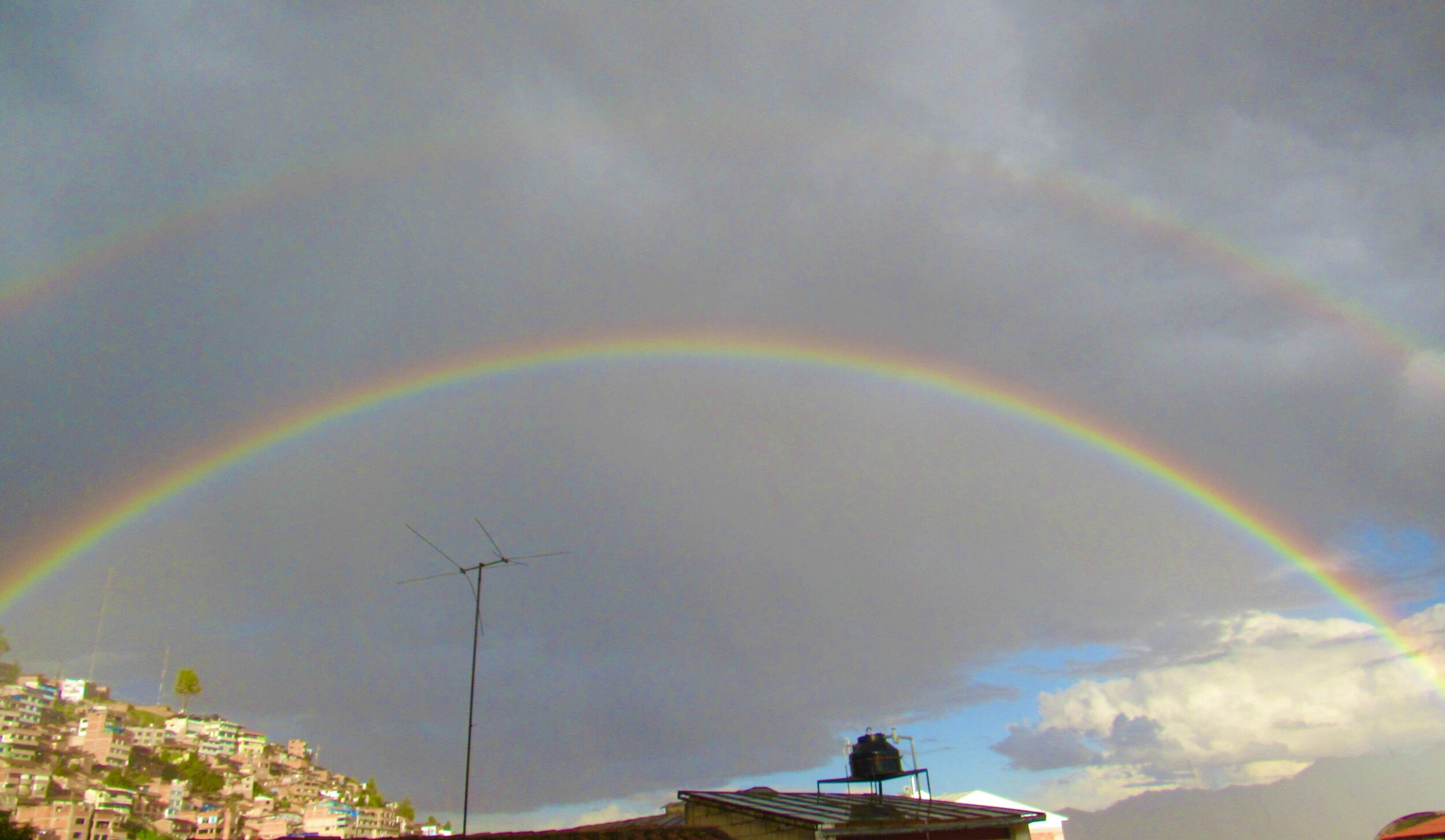
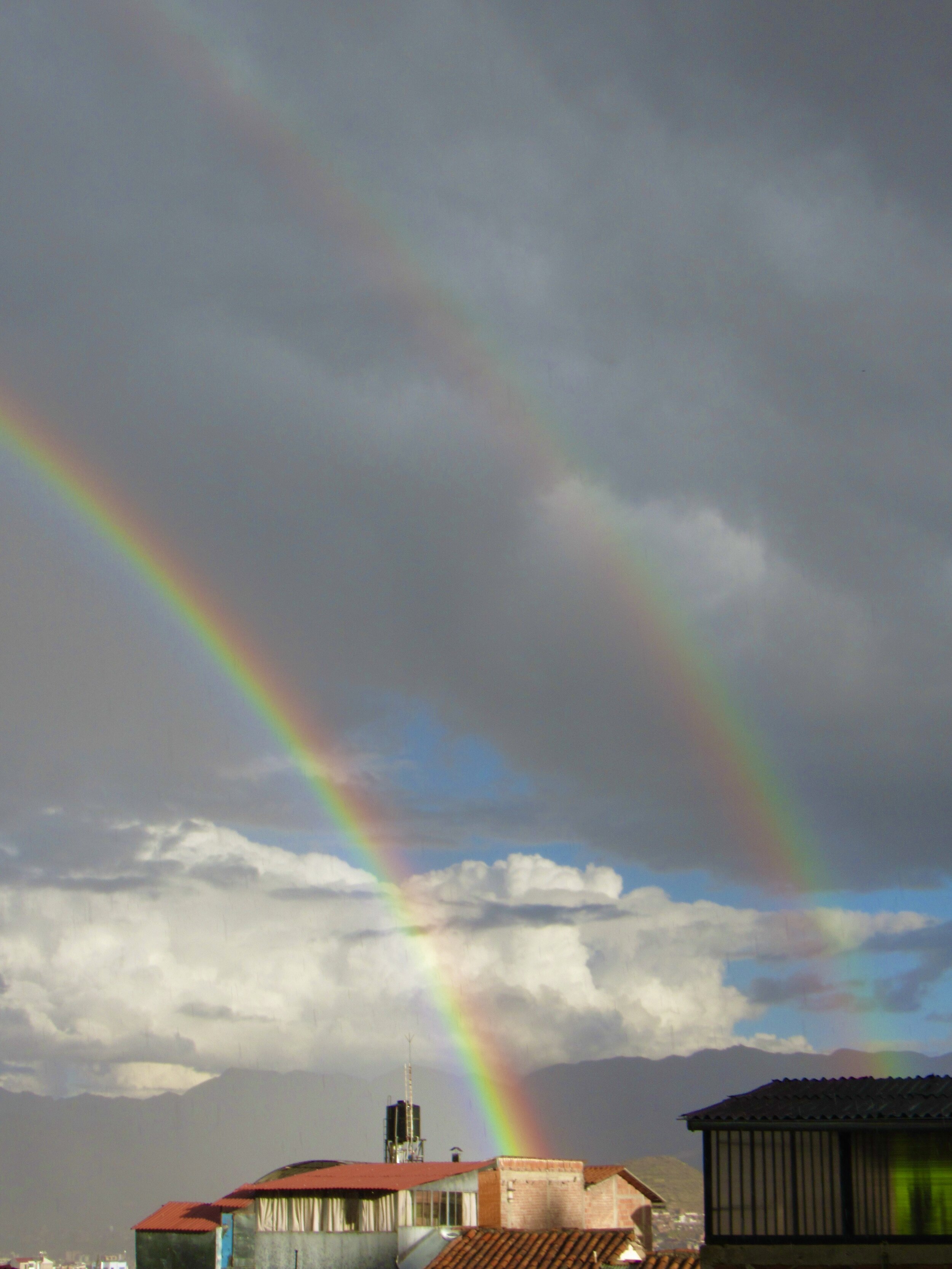

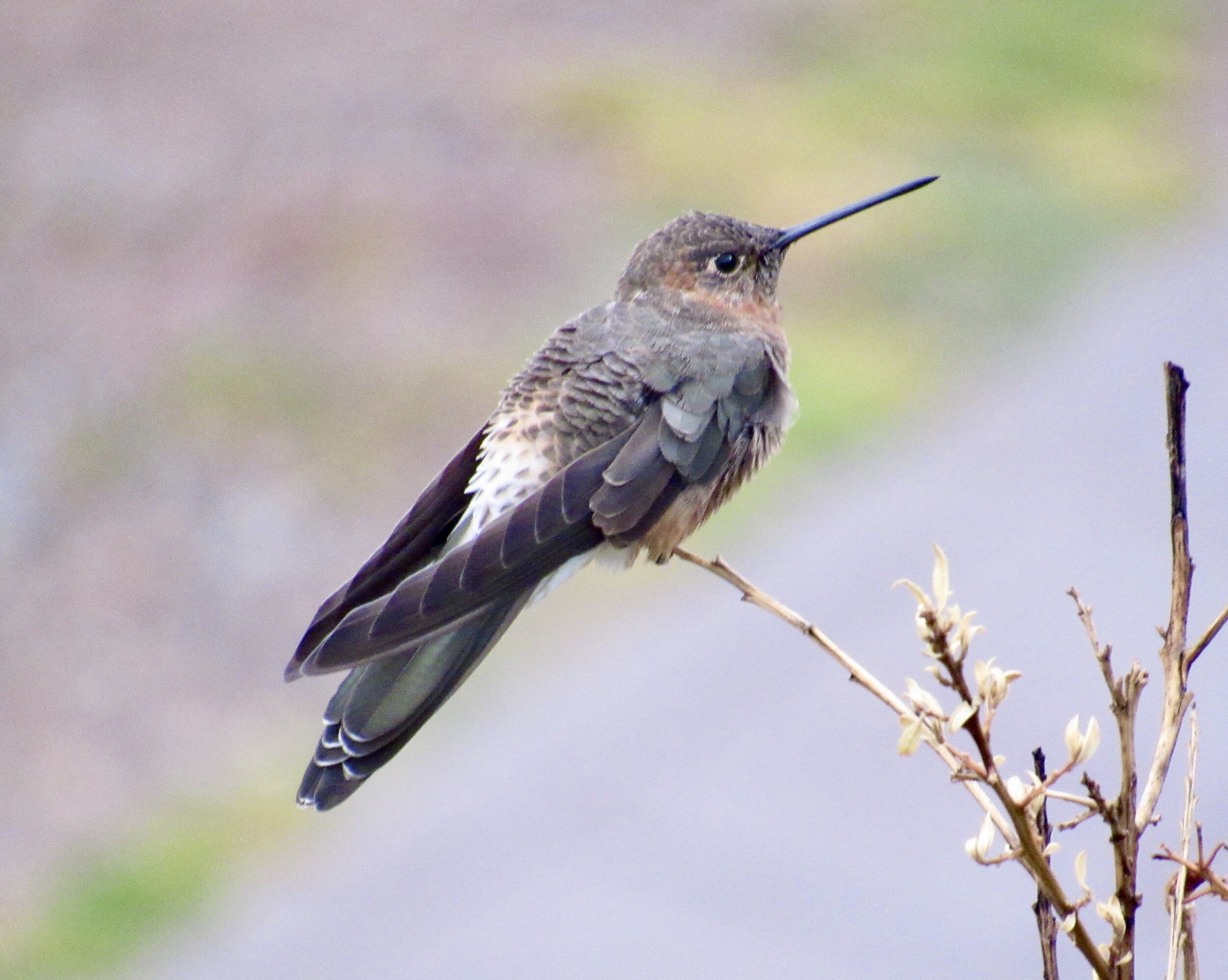

Quarantine in Cusco: Week 6
The quarantine is extended, again, for another two weeks. I start planning for changes to the tourism industry when we all come out of hibernation.
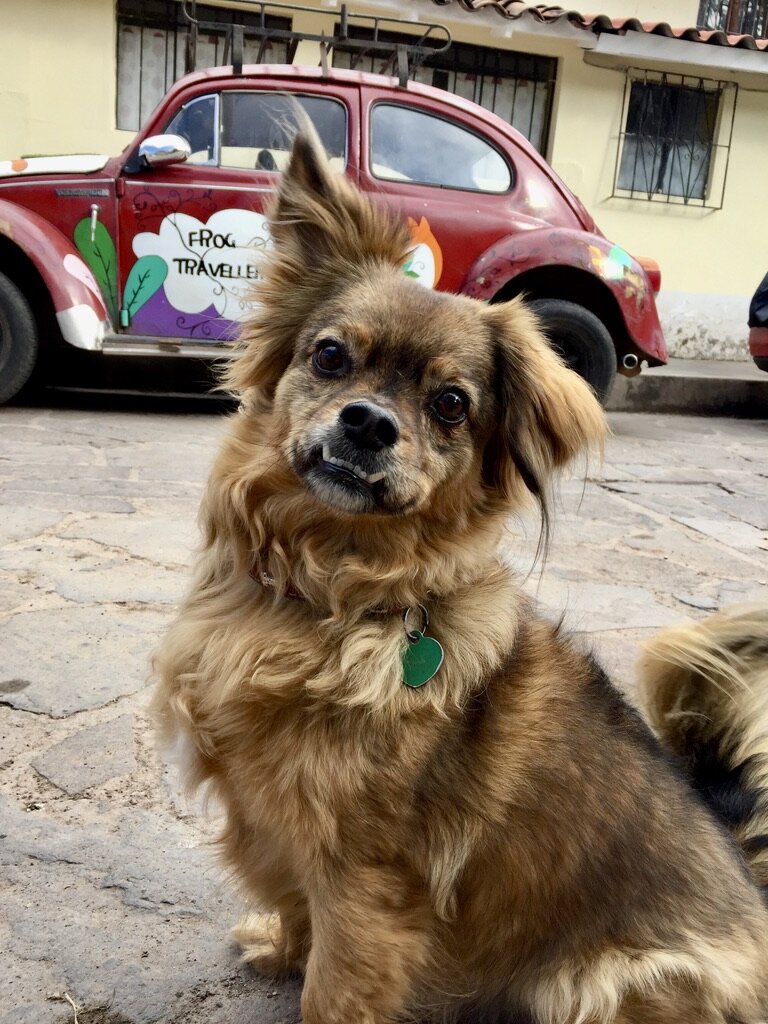

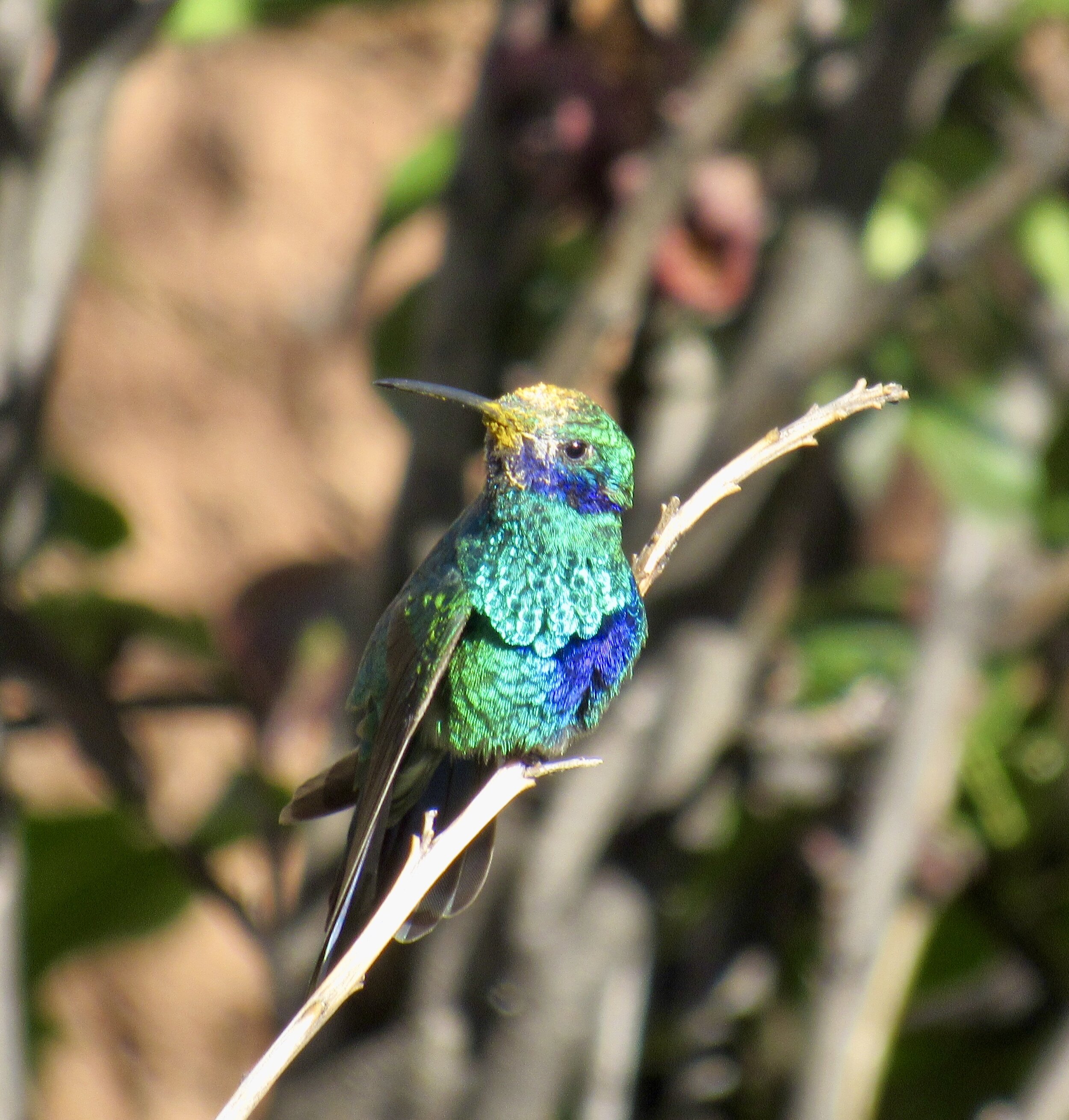

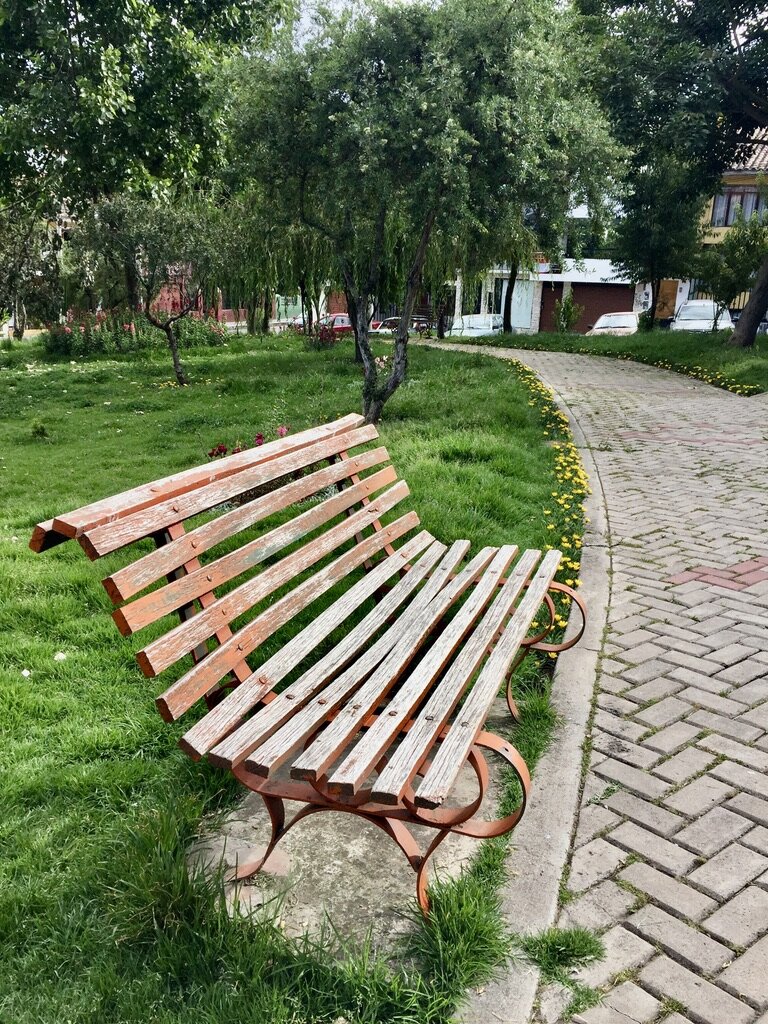

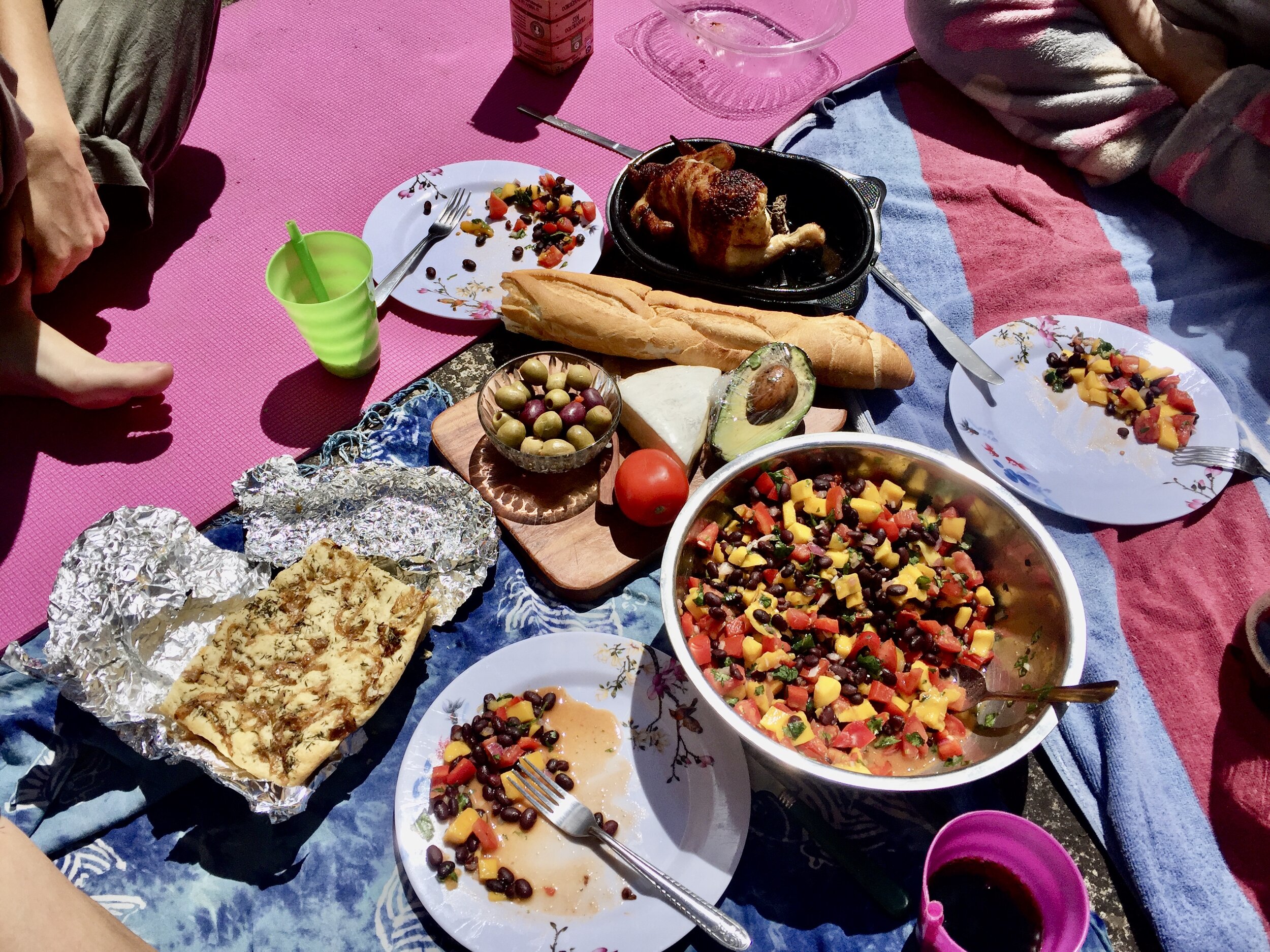
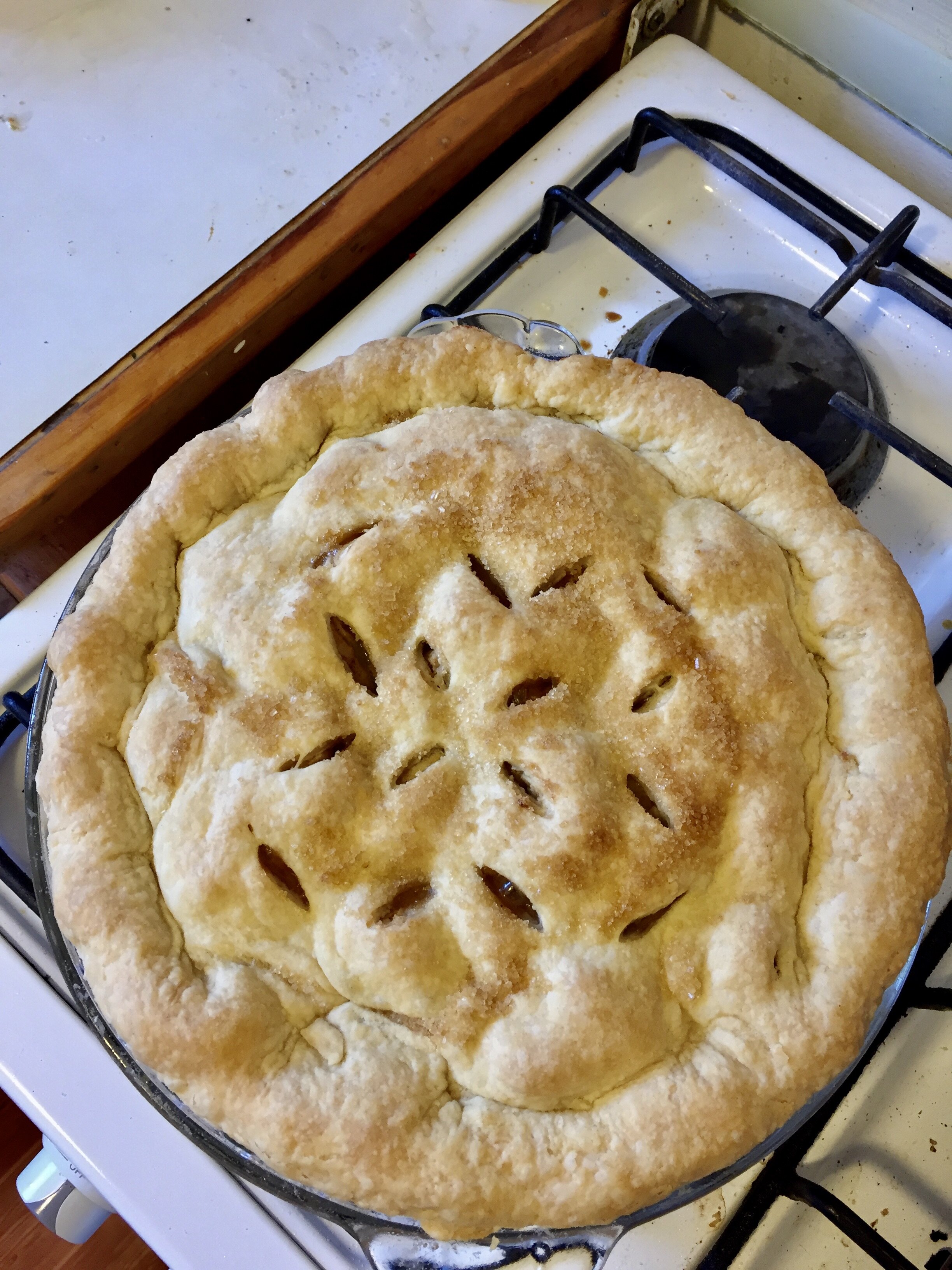

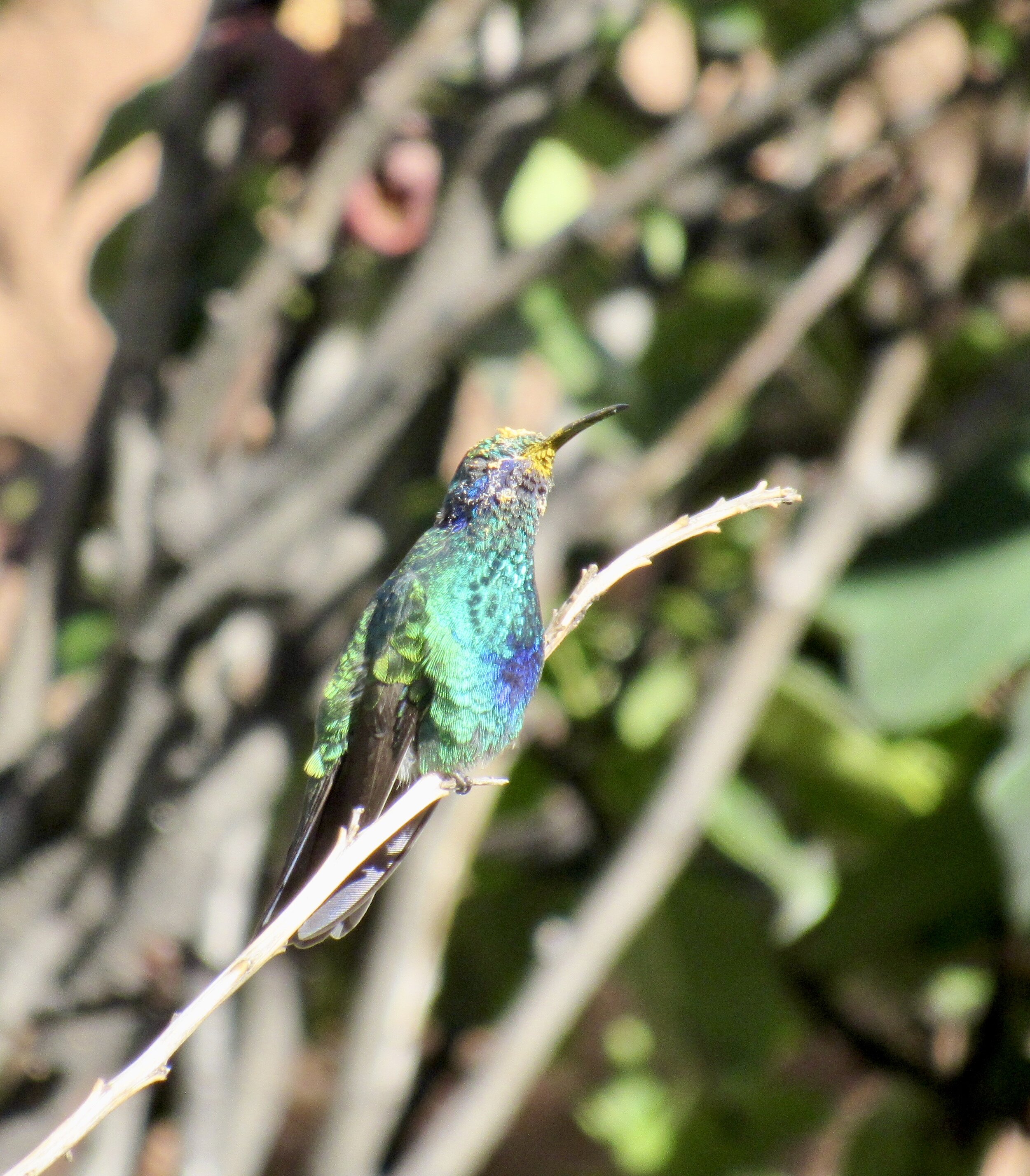
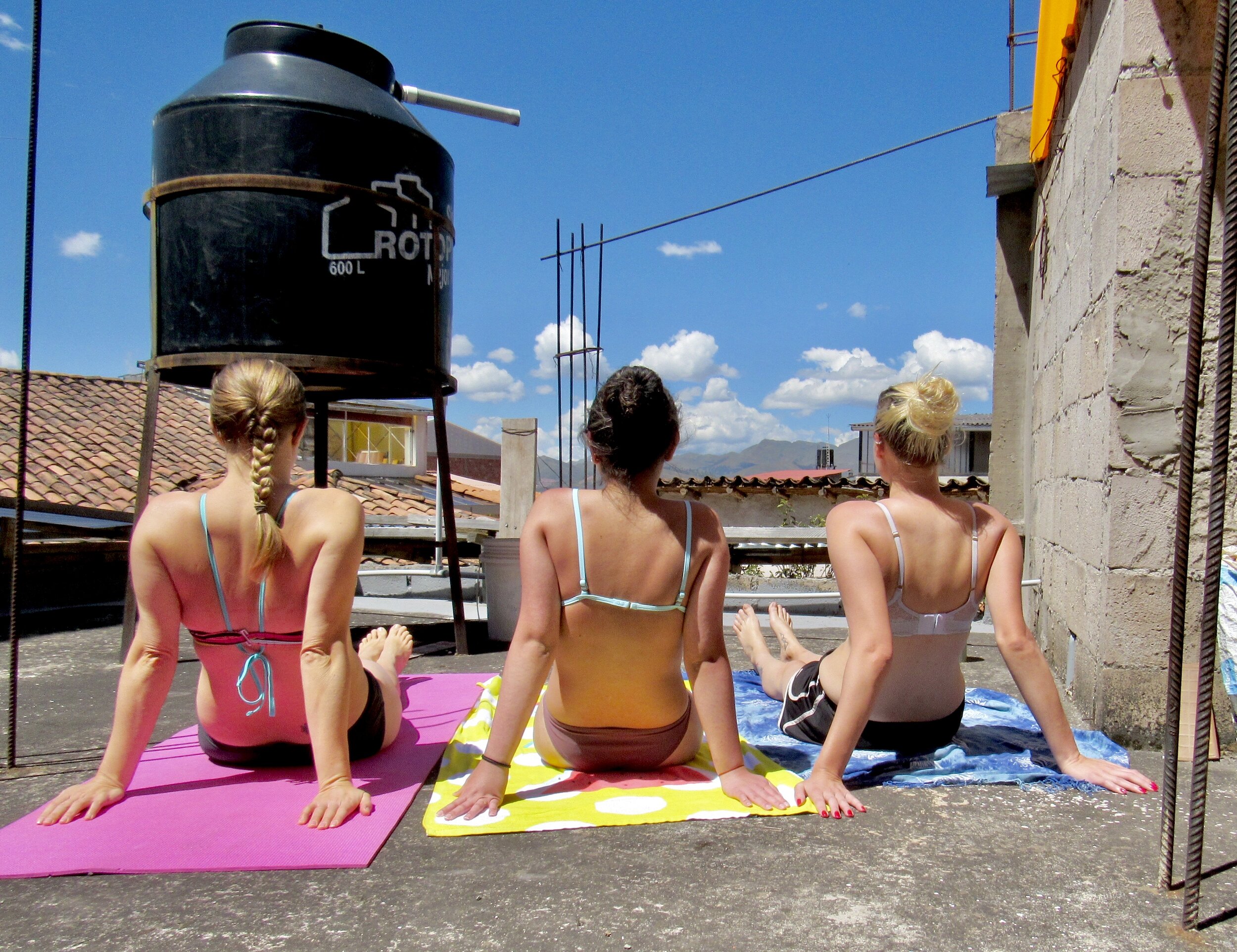
Sunday, 19 April, 2020
I’ve been looking forward to today all week! My housemates and I have been planning a picnic on the roof today. I chose Sunday because we’re not allowed to leave the house and I wanted to have something to look forward to. Yesterday and Friday it rained and hailed, so I was delighted to see bright sunshine this morning.
Both of my housemates went to the mall yesterday to buy picnic treats. They came home with a proper baguette, brie, olives, sparkling wine and a lot more. I bought focaccia from a neighbor who has been baking to supplement her income, beer and made a black bean and mango salad this morning. It wasn’t warm enough to put on swimsuits and pretend that we were at the beach, but we still brought our beach towels up to the roof and spread them out for the picnic. It was so nice! I think that we’ll do that again before quarantine ends. I keep telling myself, some day it will end.
Monday, 20 April, 2020
Today I feel excited to be here in Cusco in a way I haven’t felt for a few months now. Last week my Mom told me that I will have the opportunity to see Cusco rebuild its tourism industry, post COVID. This morning, she sent me an NBC article about how international tourism and travel must change and how we now have the opportunity to do just that.
At the same time, and along the same line of thinking, a friend in Cusco sent me a short book, so short it’s almost a long essay. It’s by the researcher Juan Carlos Machicado Figueroa and was published this month, April 2020. The book is about what we can learn from ancient Andean philosophy and the way that their society was organized, from the perspective of what we can take from these teachings as we confront COVID and rebuild afterwards. “Rescatando la Filosofía Andina para una Nueva Conciencia” starts with an introduction explaining why Andean philosophy can help us create a better society, as we now have such a unique opportunity to make sweeping changes, emerging on the other side of quarantines and devastating outbreaks across the planet.
Later in the evening, my Mom sent another article, mostly about the disaster that is politics in the US, but it comes to a very similar conclusion as the book by Figueroa. The Atlantic article by George Packer, ends with “We can learn from these dreadful days that stupidity and injustice are lethal; that, in a democracy, being a citizen is essential work; that the alternative to solidarity is death.”
Maybe I can be not only a part of rebuilding the tourism industry in Cusco, maybe I can be part of an evolution of the tourism industry here. If people in Cusco are publishing books about this, and mainstream news sources like NBC and The Atlantic are discussing this, maybe it’s actually possible. Idealistic? Yes. Realistic? I hope so!
I call a friend here, so excited about the possibilities. What can we change? How can we change it? We can’t go back to doing exactly what we were doing before. We have such a great opportunity to change things, improve things, evolve.
Two other friends texted me tonight, saying that they are going to create their own trekking agencies, asking if I will help. One asked if I would be a partner in the business, the other asked if I would be part of creating his company. Both are very experienced guides, who I think can be very successful. I told them both that when conditions permit, we should meet because I need to hear more about the plan before I can make any kind of commitment.
Tonight on El Sonido, Chilly did a shoutout to my friend Kelli’s birthday. No matter how much I love Cusco, or how excited I am to be here, it’s still nice to have this link to home.
Tuesday, 21 April
Today the president announced that he’s considering extending the quarantine past the previously announced April 26th. That’s not really news. Of course he’s considering extending. He’s been considering that since he announced it will end the 26th. One of my housemates declares that she couldn’t care less. The other is anxiously waiting for the internal travel ban to end so she can go see her brother in Lima.
We ditched our computers and phones and went back up on the roof today to get some sun. It’s getting much colder at night and the house is cold in the morning, though the sun is really intense on the roof. We all put on sunscreen because, even if you’re there to sunbathe, we’re still very close to the equator and up at over 11,000 feet.
It’s so nice up on the roof. It’s become my little escape. Even after I’d had enough sun, I stayed up on the roof and just moved to the shade with my book and my camera. Today I got the best photos I’ve taken so far of the green violet-ear hummingbird that I see every day. I’ve watched the birds in the pear tree for almost six weeks now and feel like I know each of them as individuals. It kind of reminds me of the guy who got to know each individual parrot in the (true) book The Wild Parrots of Telegraph Hill.
The roof is not just the only place that’s warm in the mornings, it’s also the only place we really hangout together. In the house, we’re either taking turns in the kitchen, since it’s not really big enough for more than one of us to cook at a time, or we’re in our rooms.
Tonight I called another friend here in Cusco to try out my idea of starting a revolution when we’re out of quarantine. I decided I should make a list of all the things I want to change in the world, regardless of how far-fetched they are. I’ll worry about if they’re possible or practical later. I’m just in the brainstorming phase of how we can change things for the better as we emerge on the far side of the pandemic.
Wednesday, 22 April
Today is the 50th anniversary of Earth Day!
What an amazing time this is for our planet! I keep going back to the satellite images of the reduction in global air pollution, the lions napping in the road in South Africa, the jellyfish in the canals in Venice, the bears playing in the streets in Yosemite, the birds on the beaches in Lima and wild goats coming into town in Wales. This is horribly tragic for humanity, but a welcome break for so many other species on Earth.
I have absolutely no expertise that could help Cusco or anywhere else confront COVID, but I plan be of help in the rebuilding afterwards.
I’ve started my brainstorm list of things I want to change or improve afterwards. One centers around a huge difference I’ve seen comparing my travels in Costa Rica and Peru. In Costa Rica, everywhere I traveled with my Mom, the water was safe to drink right out of the tap. Sure, people still bought bottled water, but they didn’t have to. People who couldn’t afford bottled water weren’t spending any time filtering it or boiling it and certainly not any money on filters or electricity or gas to boil water. In Cusco and the surrounding areas, the water is not safe to drink. People spend lots of time and money on making the tap water safe to drink. A friend I spoke to yesterday, who lives near Cusco, said that he was sick on Sunday because he drank some water the day before that he thinks wasn’t clean. If he had a job he could go to now, that would have impacted his work. How many people lose hours or days of work, and therefore income, because the tap water here is unsafe to drink?
Surely, that’s something we could fix here. I have no idea how, but I have plenty of time to try to find out.
This evening I got an email from the US Embassy about a new law in Peru that makes me uneasy. I have celebrated, or at least agreed in theory with, everything else that the Peruvian government has done during this crisis. Cash for struggling families a month ago? Yes! Curfew to keep people out of the streets? I can get behind that. Closing all restaurants and bars? Great idea! Fines for not wearing a mask in public? It’s not a terrible idea.
However, I have now been notified by the US Embassy in Lima that “Health Minister Víctor Zamora announced the executive approval of a legislative decree that gives the Ministry of Health greater control in directing COVID-19 patients to both public and private hospitals. Please be aware that this decree is likely to limit your ability to choose where you receive medical treatment in Peru should you require treatment of any kind.”
The last three words give me pause. This is not just about COVID. Sure, it’s helpful for hospitals and local government to be able to move people around, so that COVID patients are not mixed in with people who have a broken leg. If one hospital is overflowing, they should be able to direct new patients elsewhere. Still, if I need medical treatment of any kind, I would like to be able to choose where that will take place.
Thursday, 23 April, 2020
39 days down, 17 more to go
The president just announced two more weeks.
During the address today, President Vizcarra talked about one of the most dangerous aspects of this pandemic is the people who are asymptomatic, and who spread the virus without knowing it.
Below is my translation from listening, pausing and relistening to the president’s speech on YouTube. It’s long, but I include it because it’s what I wish my friends and family in the US were hearing from the White House. It’s the compassion, commitment and confidence that I wish was coming from D.C.
Today President Vizcarra announced that we have lost 572 people to COVID in Peru. He continued (my translation) “These are statistics that are hard, that hurt, and I send my condolences to each family. … The curve is still rising, we have not yet reached the peak of this rising curve. This pandemic means we cannot let down our guard. We must make all decisions thinking of the best for our country, for our people. The most important thing in this country are its people, the health of each Peruvian and the lives of our population. Therefore, the recommendation that we take again, considering what is best for our people, we have decided to extend the state of emergency for two more weeks. These are sacrifices we each make, the strength we each show, to defeat this virus.
“This sickness obliges us to change our style of life, our customs, our habits. The extension of the state of emergency does not mean that afterwards, we can go back to how things were before. Improved hygiene, hand washing and wearing a mask when you leave home, a minimum of one meter distance between people when in public, will continue to be obligatory after the end of the state of emergency. This will be the case until we have a vaccine. Scientists around the world are working on this. Until we have a vaccine, we must continue to combat this virus. This is why the state of emergency is extended to include Sunday, May 10th, which is Mother’s Day. As we celebrate and thank our mothers, we must continue to protect them, be responsible and to do what is best for their health.
“Remember that if we had not taken the measures that we did, 39 days ago, we would have lost many more lives. We mourn the 572 people who we have lost. We see other countries, who have a health system much more advanced than our own, who have lost thousands of lives. If we did not have the quarantine restrictions in place, we would have lost tens of thousands of lives here in Peru. Our efforts are worth it.
“We recognize that this virus has not only affected the health of Peruvians, but has affected our ability to continue our normal activities and this has impacted the income of every family in Peru. Therefore, we are increasing the number of families who receive financial assistance from the government. We are aware that this is still not enough. We have calculated that 25% of families in Peru have continued to have an adequate monthly income because they work in essential services: agriculture, markets, pharmacies and public services. This means that 75% of Peruvian families have lost part or all of their income. Many of these families have already received financial assistance, but we must immediately help those who have not received anything. We will support these families until we are able to resume our normal economic activities in Peru.
“We must continue this state of emergency two more weeks and we must all be responsible to combat this pandemic. We began our state of emergency at the right time and we must continue to follow the restrictions because the curve is still climbing. In May we will start to resume our economic activities, but it will be measured and calculated to prevent a second wave of infections. Starting tomorrow, there is a new council of representatives from all 25 regions of Peru and representatives from every sector of our economy and labor force. They will work together to assess how and when to open up economic activities in Peru. We are conscious that Lima is not Peru and while Lima is the most affected by the virus, what is necessary in Lima may not be the same in other parts of Peru.
“While schools have been closed, the Ministry of Education is evaluating how to support students who have the fewest resources to study at home. We are evaluating how to have support in place for every student to learn remotely before the schools open up again. We are evaluating how restaurants can open up for delivery, while still protecting the workers and the customers. What we are asking for, from each sector, each region, each Peruvian, is solidarity. We must help each other. At the beginning of this pandemic we asked for lots of support, and we received lots of support. The congress has approved many new laws during the state of emergency to help our population.
“As this pandemic goes on, it is getting harder for each of us. The people on the front lines need more support. If we think that we will win this war with only the front lines, we are wrong. This depends on every Peruvian. Every one of us must commit to fighting this pandemic. This is a marathon and we are in the stage when we need the most endurance, we need endurance from every Peruvian. We need support and solidarity. This is the stage when we need our deepest strength, our love for our country, our love for our family, our love for our society to preserve the country that we all want.
“This will pass. When it passes, we will have the best conditions to continue to work for our futures, but now is the moment when we need to take responsibility and we need the commitment of every Peruvian. I know that we can count on the solidarity of every Peruvian, as we always have in our most difficult moments.”
Again, I include this because it’s what I wish was coming from the White House. I feel very fortunate to be in Peru at this moment in history. Of all of the decades of terrible presidents that have held Peru back, I believe that we got lucky to have right now, an honest president, who began his presidency fighting hard against decades of entrenched corruption. When we need it most, Peru has a strong and compassionate leader who is working hard for the best possible outcome of every Peruvian family. Sadly, I feel that the US is in a very, very different situation.
Friday, 24 April, 2020
I feel like all the enthusiasm and optimism that I felt on Monday just drained out of me yesterday when I heard we have two more weeks. 8 weeks at home is a long time, even if the first two weeks I was cheating by going on walks at 5:30am.
Today I got a work email from somebody whose flights in September were cancelled by United Airlines. September? Really? In November the rains start again. I’m starting to wonder if the tourists will come back at all this year. Is tourism dead until 2021? Are we really losing a whole year? How in the world are people going to have enough money to eat?
In the meantime, I’m still reading about how COVID is being dealt with in other countries, and what researchers are finding. The longer this goes on, the more data there is to analyze. Unfortunately, some of that is downright scary. I read an article today on CNN that people my age, with no pre-existing conditions, are having strokes caused by COVID. Now the WHO is saying that having COVID once does not necessarily mean that you can’t get it again. I really need some good news today. Even the top funniest tweets complied on Huffington Post aren’t helping. The apathy is coming back.
Kerry pulled me out of my funk and said she had to go buy food. I realized that I haven’t left the house since last week. I’m not entirely out of food, but since the market is closed on weekends, I should probably go now. At least it was sunny as we walked the few blocks to the San Blas market. I got almost everything on my list, but none of the vendors had tarwi today. We’re getting plenty of fresh fruits and vegetables, but there are a few products that aren’t making it to Cusco anymore.
In the afternoon, Kerry offered to give me a haircut on the roof. She and I have both been complaining about how we were going to get a haircut right before the quarantine started. That was six weeks ago, so I was relieved to get a bit of a trim.
Saturday, 25 April, 2020
There are only three emails in the company inbox today. It’s hard to pretend that I’m working four hours a day but I really don’t want to be working any less than half time. I go through the website and edit a few things, improving descriptions of hikes and archeological sites. There’s just not much to do anymore. Despite my boss’s optimism in March that May would be fine, I’m starting to wonder what month he thinks will be fine again. I doubt that international flights will be allowed to land in Peru anytime in May. There’s no point in opening any hotels, restaurants, trains or archeological sites until tourists are allowed back in Peru. We’re not going to face famine or some of the other disasters looming around the world, but we are all going to burn through our savings this year.
My mind keeps going back to the terrible timing of this pandemic, in particular for Cusco. The Inca Trail is always closed in February, but was shut down a week early this January, because of a devastating landslide that killed three people. Then, the rains in February were worse than usual and the government announced that they were going to open the Inca Trail two weeks late, on March 16th, rather than the usual March 1st. Bring in the pandemic, and the state of emergency that was announced on March 15th. We are now at the end of April and it has been four to six months since some guides and porters have had steady work. This pandemic shut down Peru right when Cusco needed tourists to come back, right when many families were getting to the end of their savings, as they do at the end of every rainy season. Now they all have to prepare to stretch what little they have for an unknown number of months, until the tourists come back. There are no other employment opportunities in Cusco. We all rely on tourists.
We will not run out of food in Peru, but I don’t know how families in Cusco will be able to buy it.
Quarantine in Cusco: Week 5
The door to the street gets stuck and I decide I don’t want to go out anymore anyway.
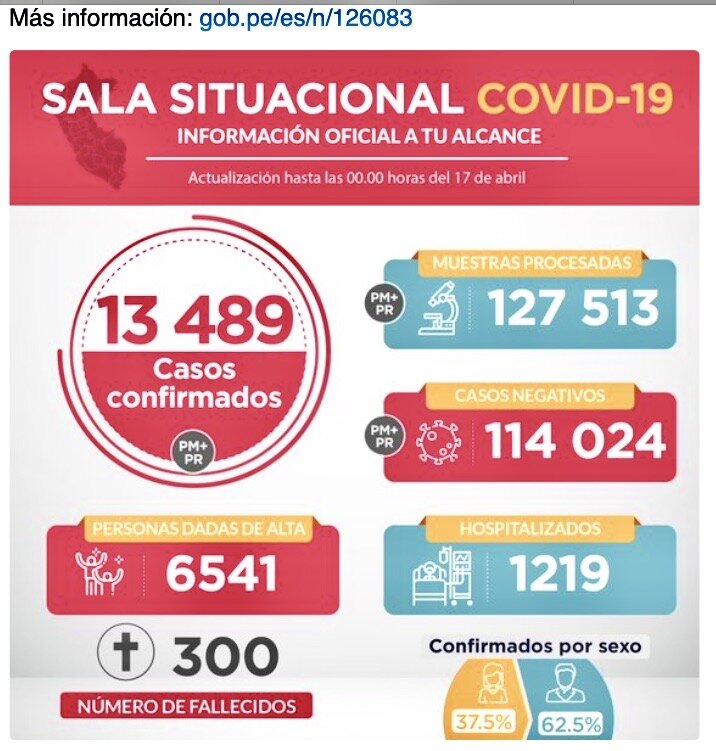
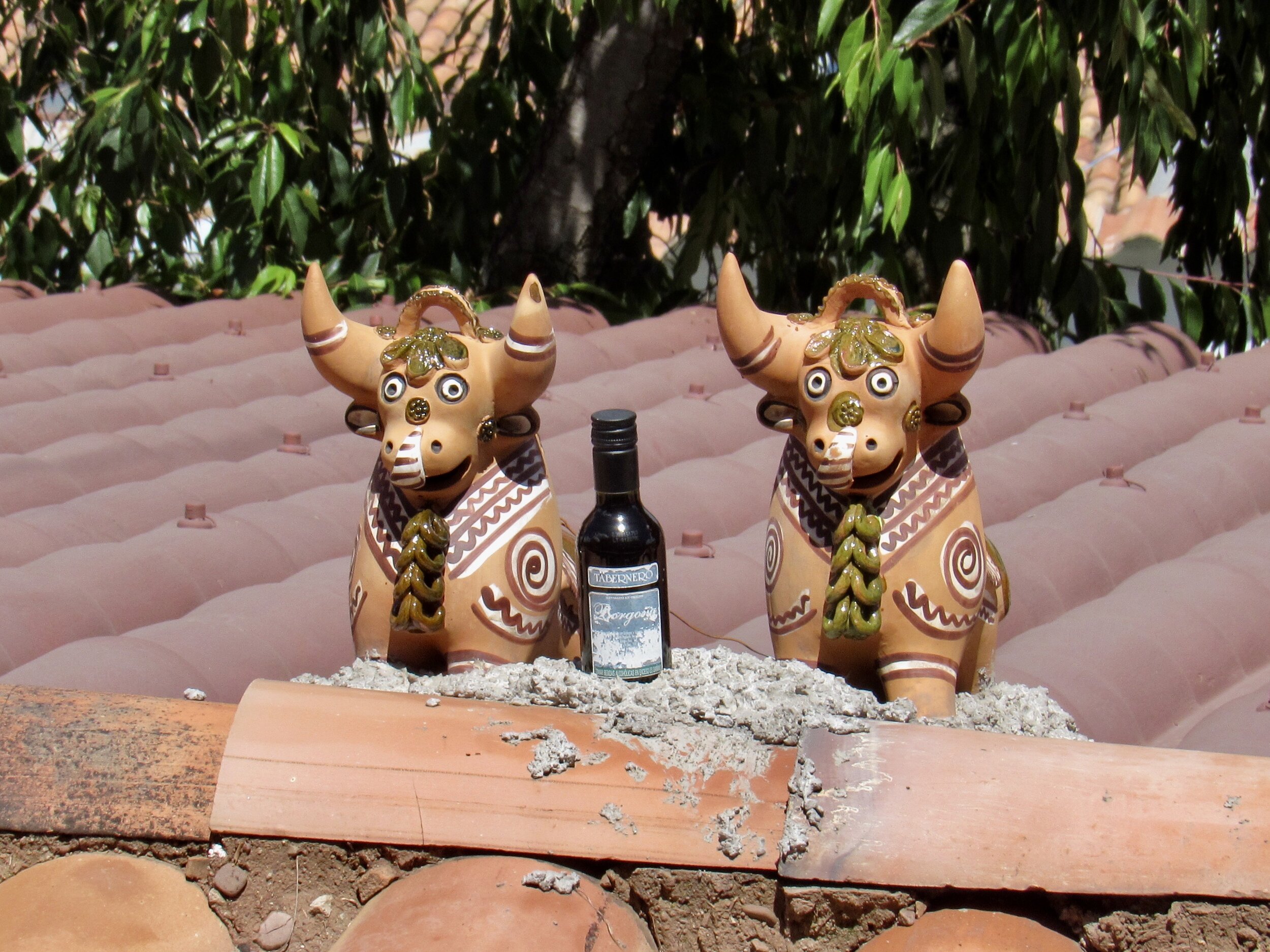
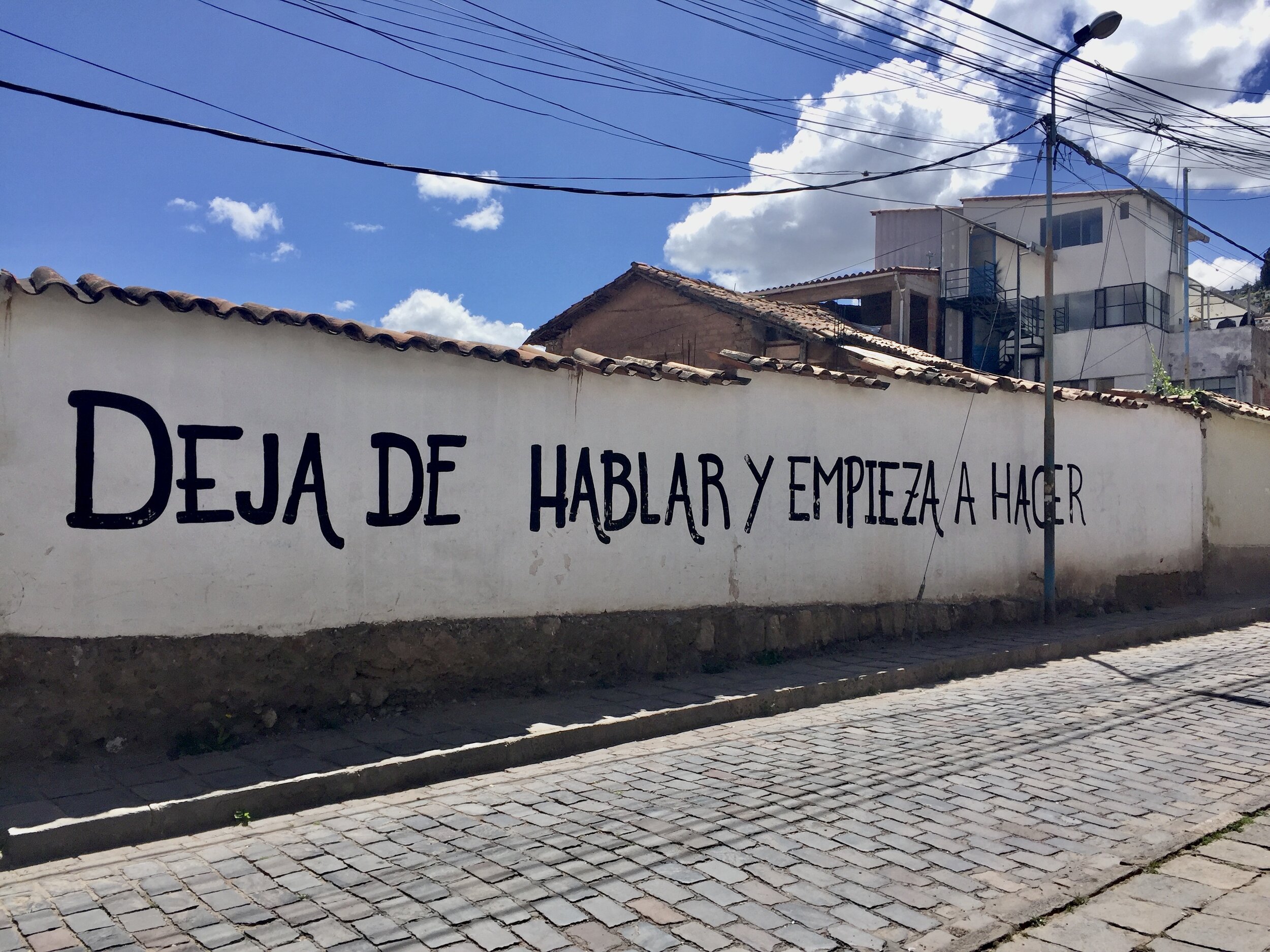
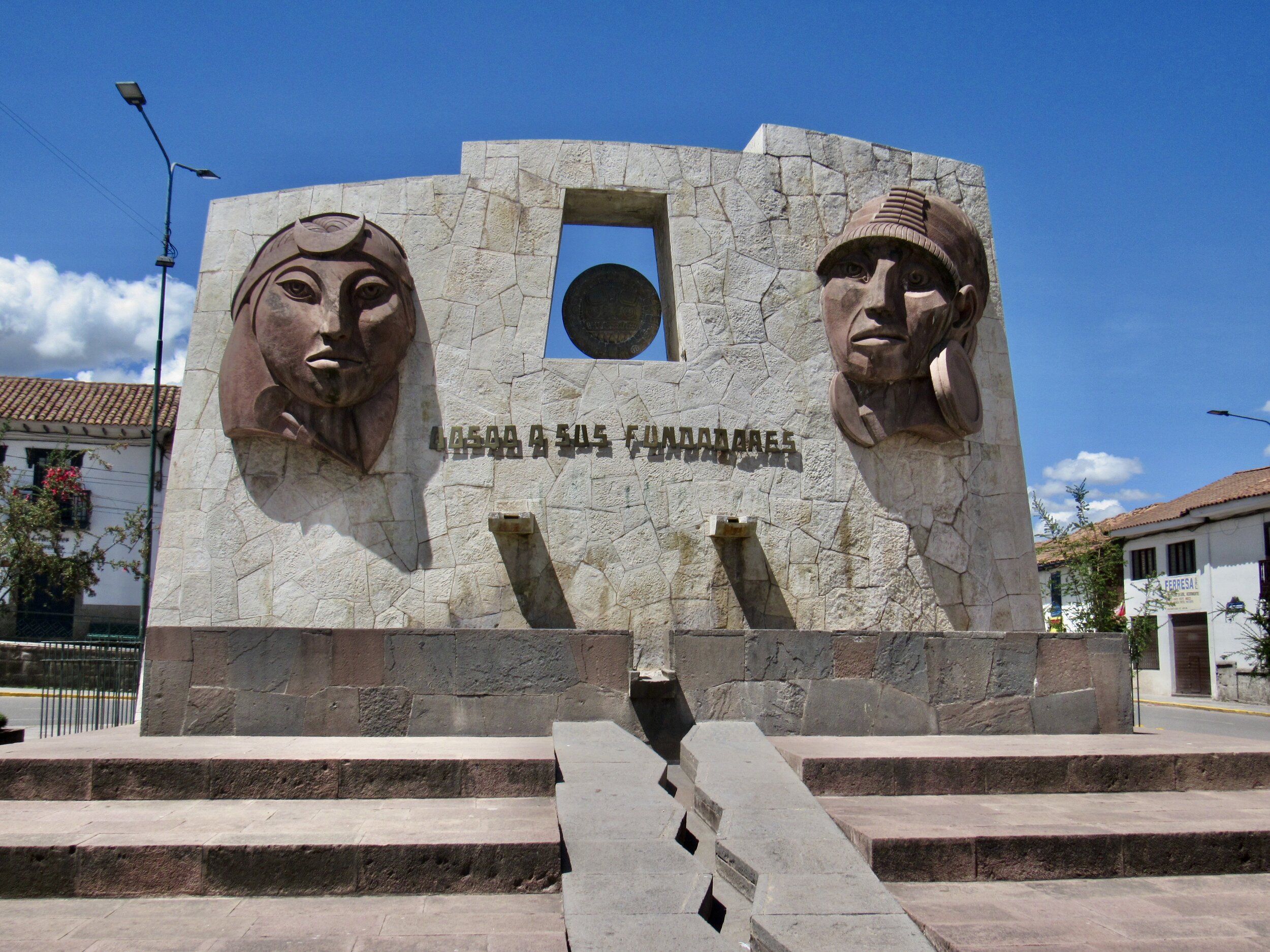
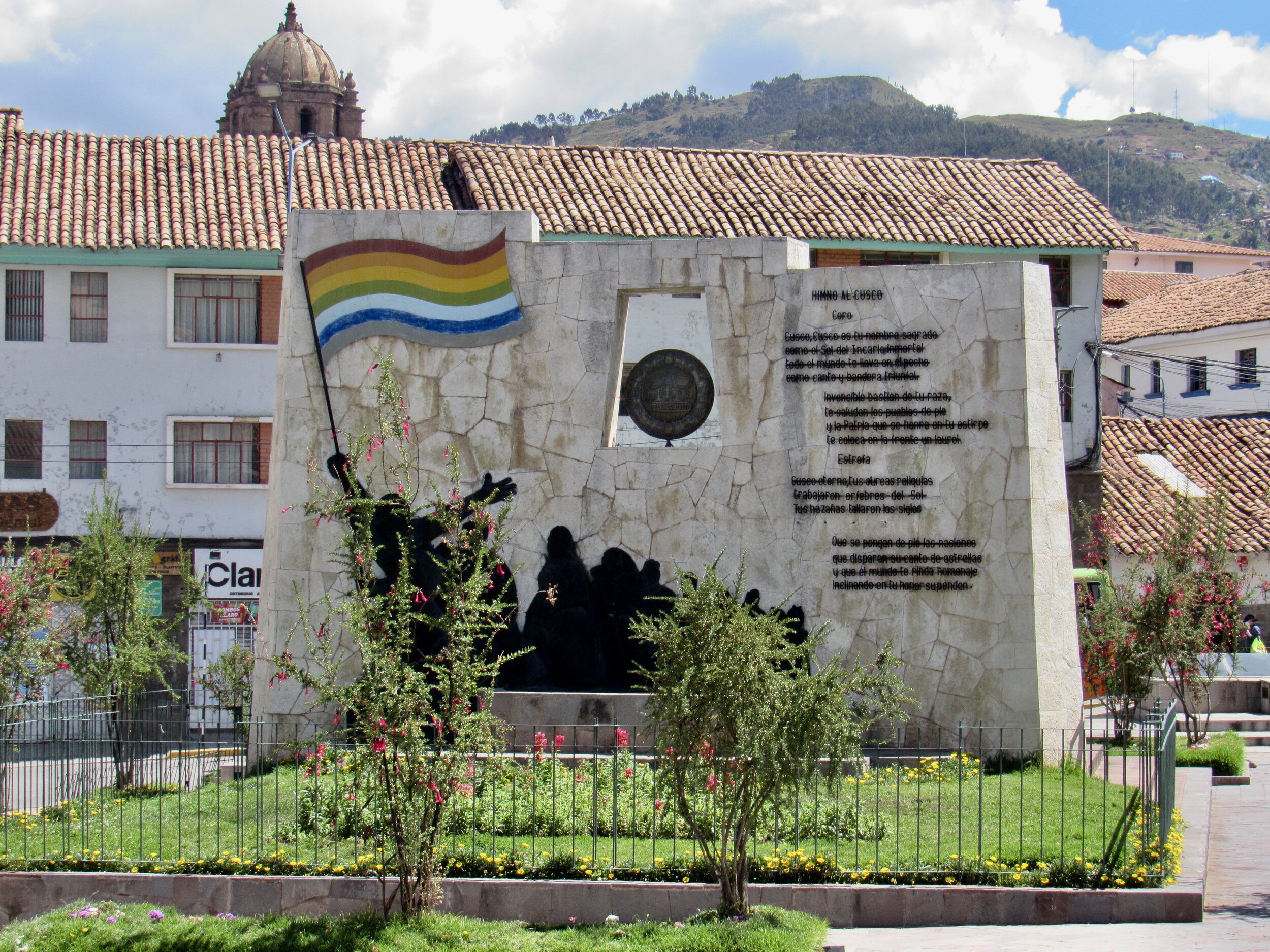




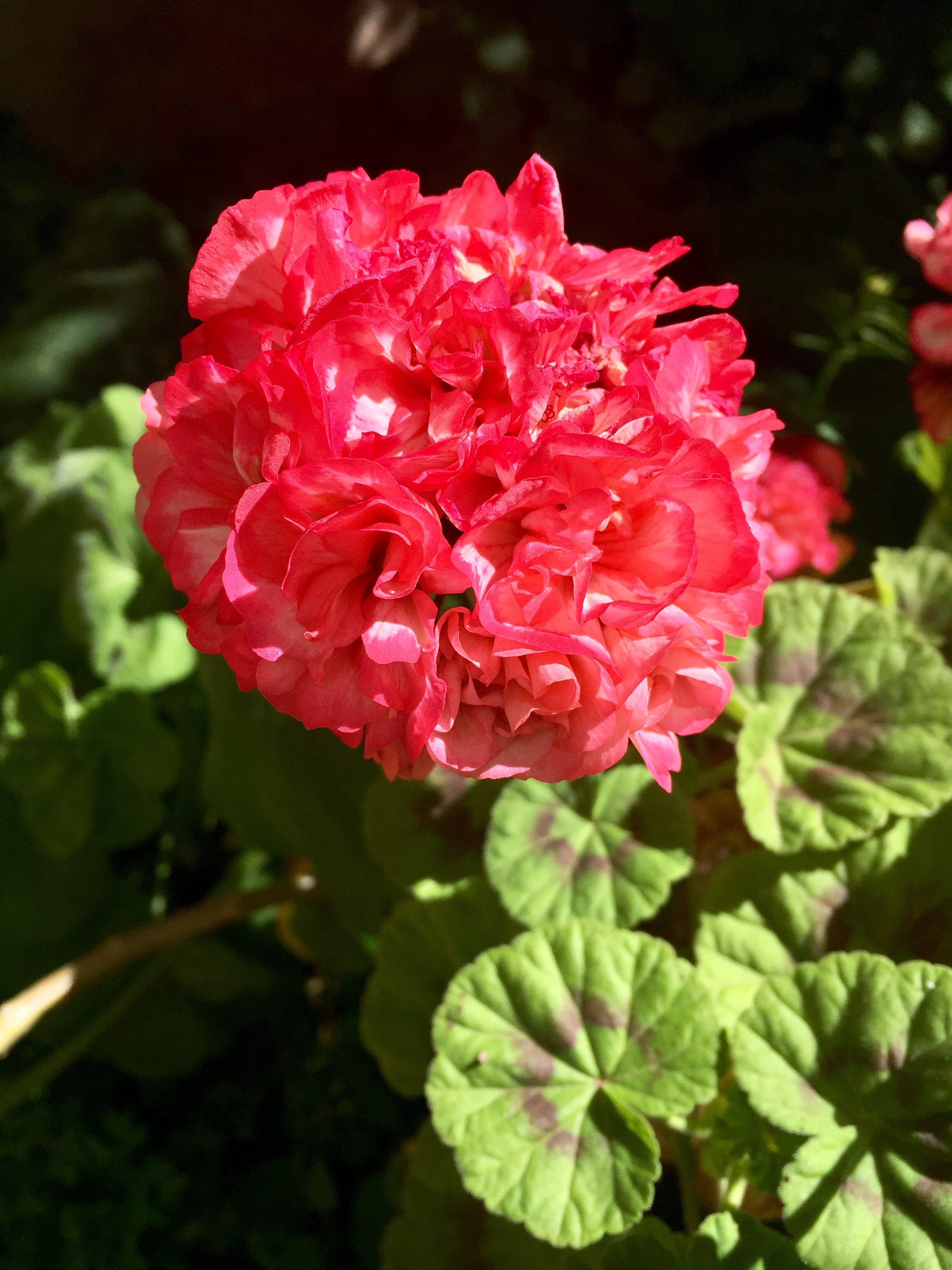
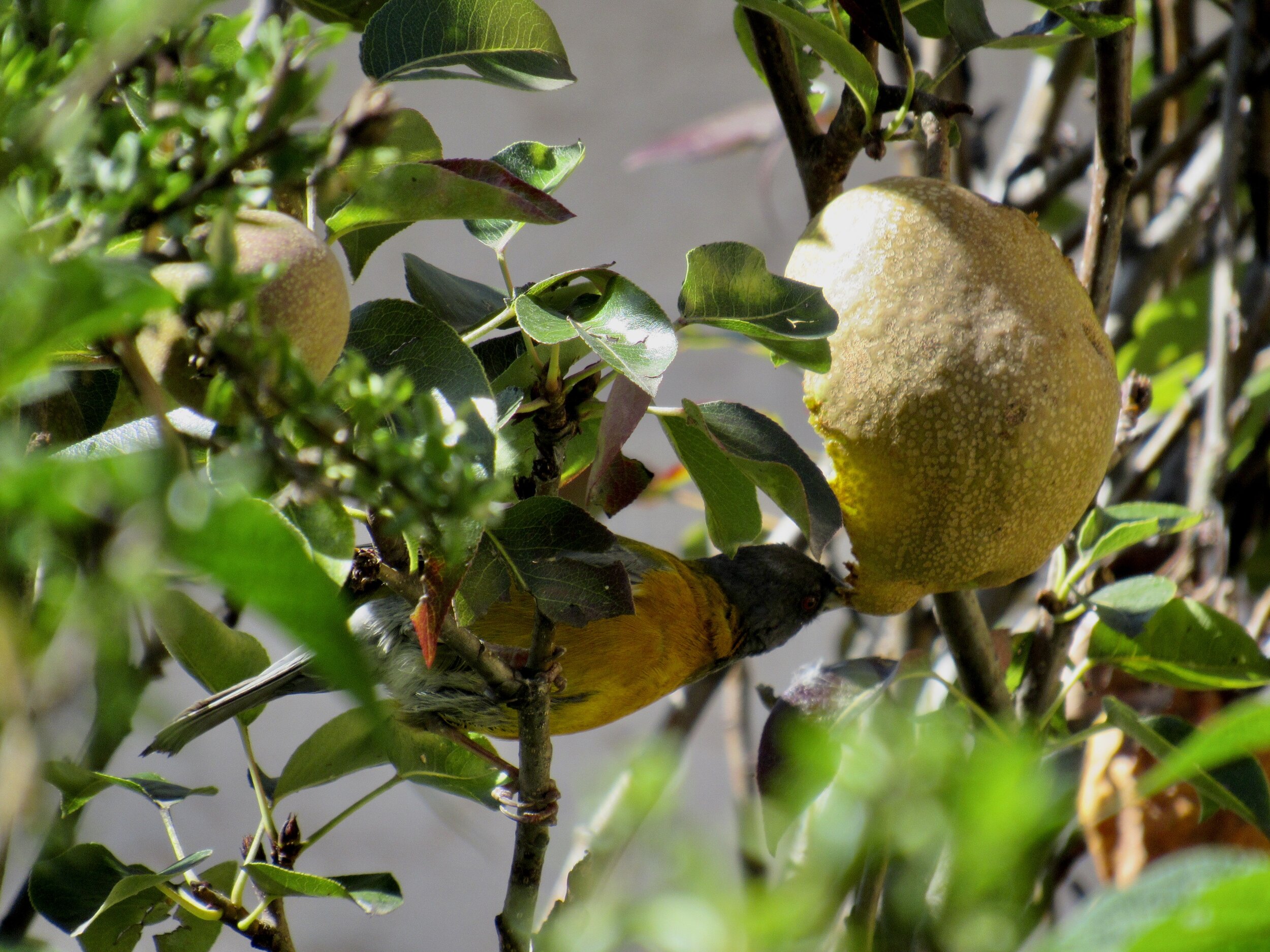
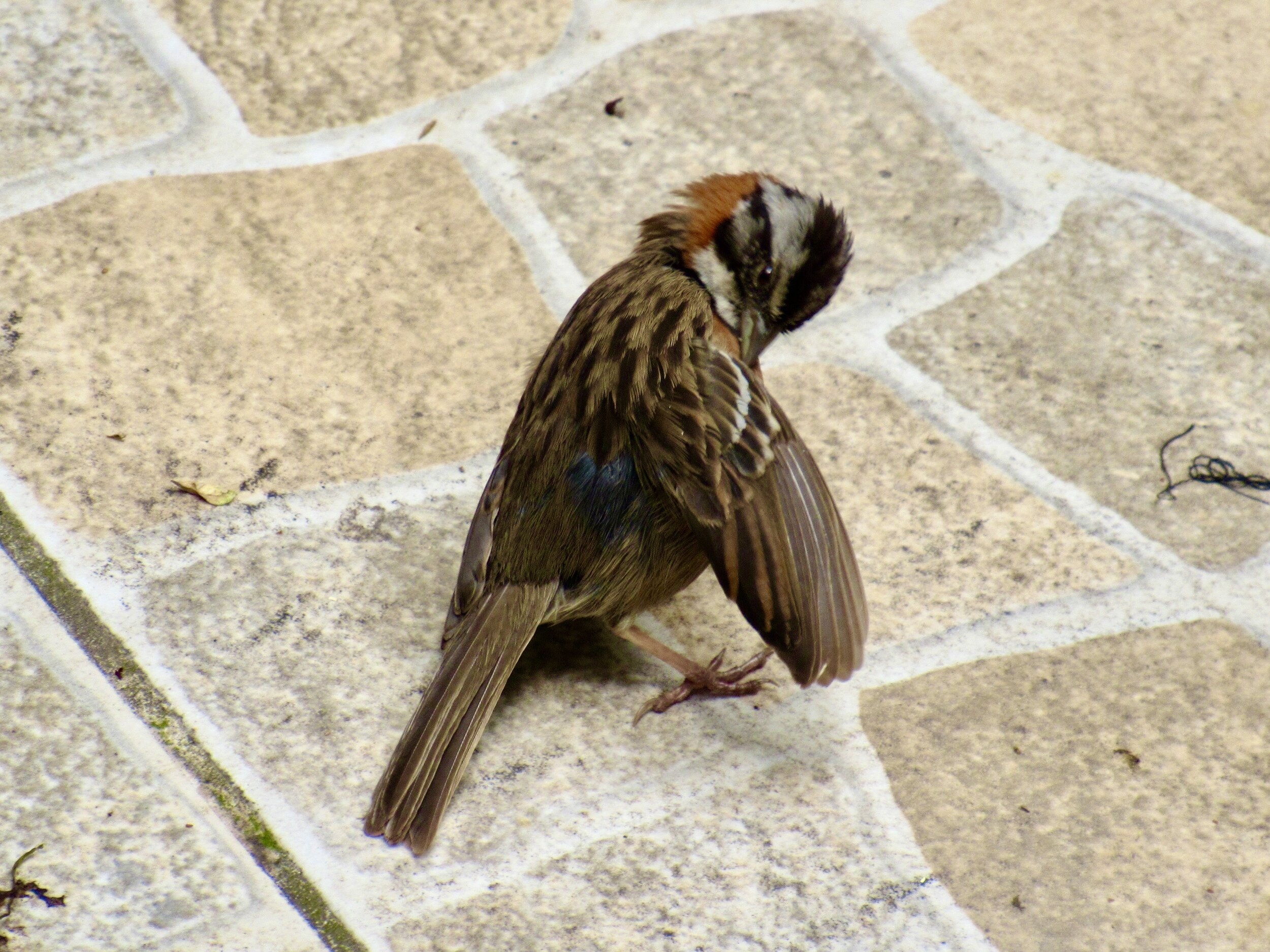

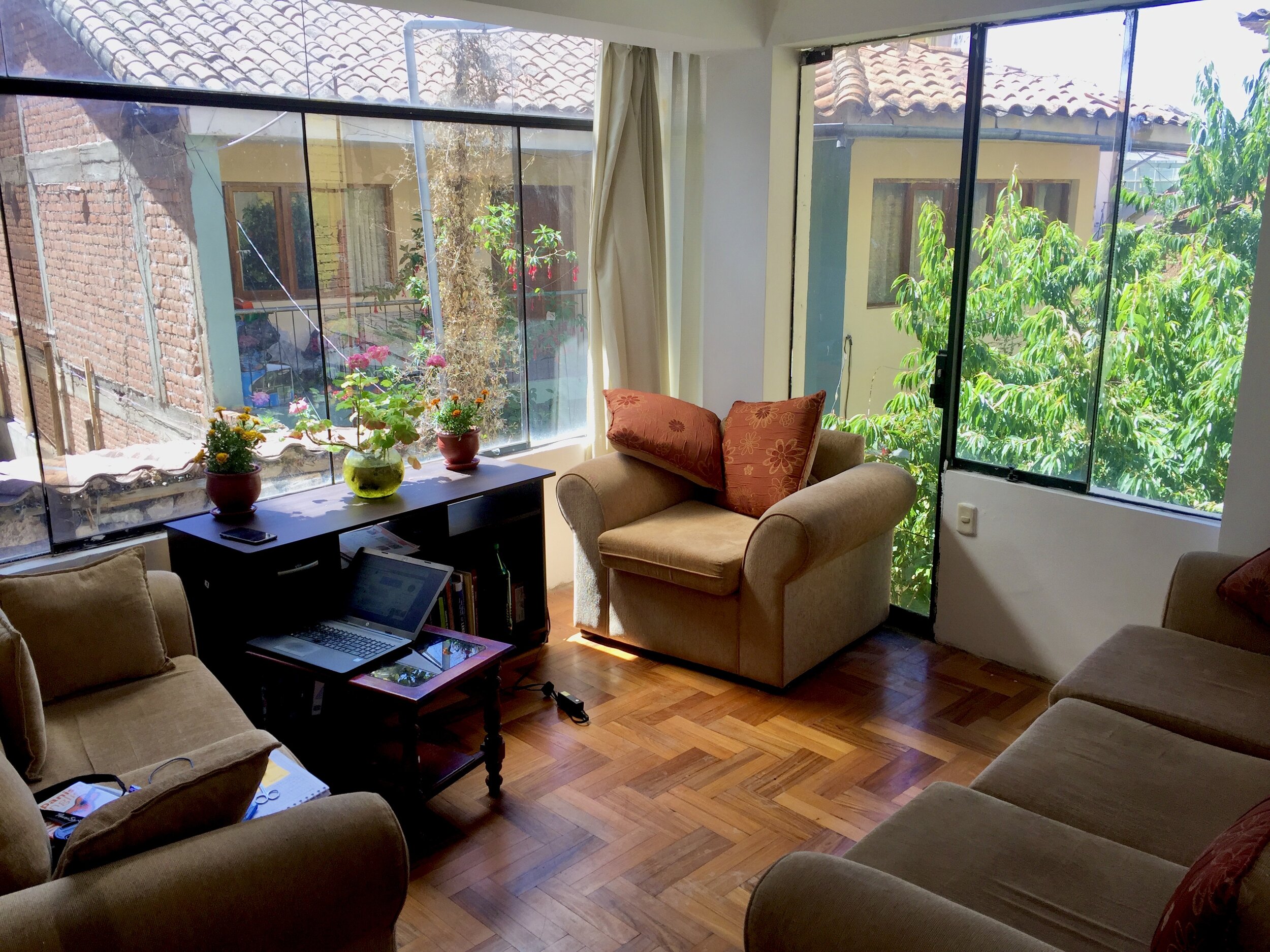


Sunday, 12 April, 2020
28 days of quarantine down, 14 more to go
Like every Sunday in the new world of Peru under quarantine, nobody is allowed to leave their homes today, except for emergency medical services. All grocery stores, pharmacies and banks are closed on Sundays. No other businesses have been open for a month.
I got back to my workout routine today, after skipping yesterday. I had been on an 11 day streak. I need this part of my morning routine. Staying healthy is obviously important when any trip to buy food could expose me to contact with the COVID virus. Having a routine and making myself get up every morning is really good for my mental health. Also, I get to burn off some of the frustration of not being allowed to go outside, to read a book in the park, or to go for a walk in the hills above town.
The hills around Cusco are what made me first fall in love with the city, seven years ago. They look a lot like the foothills above Boise, where my parents live, which made Cusco feel so comforting at a time when I was living in Bangladesh. I love living here and want so desperately to see Cusco back to its normal self, the normal self that made me want to move here seven years ago. Like my struggles with anxiety and apathy, I suspect that my desperation for anything that seems normal is probably a common feeling around the world these days.
Sunday is the only day I don’t work from 9am to 1pm, so I filled the morning with FaceTime with friends and baking an apple pie. I went up to the roof a couple times, just to see the sky and look across the valley to the hills that are even more comforting and familiar than they were seven years ago. When you land in Cusco, the planes fly so low over those hills. The few flights that arrive now are cargo from Lima. There were a few embassies who organized evacuation flights a couple weeks ago from Cusco, but since then repatriation flights have been only from the military base in Lima.
I am sure that those who live near the airport appreciate the silence. Their windows don’t rattle anymore as planes fly close overhead and they’re no longer breathing in the toxic exhaust of jet fuel from flights taking off. I know that the dramatic decrease in air and water pollution, sound and light pollution and even the stop in vibration from all our millions of vehicles around the world has had a wonderful impact on our planet. I just want to be able to go out and appreciate it. I don’t want to drive a car or fly anywhere, I just want to walk alone in the hills that I love even more now that I can just see them from my rooftop, but can’t get any closer.
Monday, 13 April, 2020
Sitting in my home office this morning, looking out the windows that look into my neighbor’s pear tree on the south side and towards the street and park on the east side, I heard a loudspeaker. It was a police vehicle, driving through the neighborhood with a loudspeaker blaring. At first, I could only hear Quechua, then I heard the message repeated in Spanish: Stay home. Do not go outside. I smiled, thinking of this as the Quechua and Spanish translation of Samuel L. Jackson’s new Youtube hit: Stay the Fuck Home. If you haven’t heard it yet, do a quick search online and listen to him read what looks like a kids’ book. It’s hilarious! If I’m going to get through quarantine without going crazy, I’ll need all the humor I can find.
I did have to think twice about what day of the week it was this morning. We are allowed outside on Monday, right? Last week had an awkward gender rotation, which allowed men outside on only Monday, Wednesday and Friday. But last Friday Presiden Vizcarra called that off, saying that the new restriction was only one person per household could leave per day. Basically, you can only be out in the streets alone, and still only for essential errands. Maybe the loudspeaker warning to stay home is a new strategy, much as the police rolling through the streets with sirens blaring at 6pm was the strategy the first few days that our curfew dropped from 8:00 to 6:00. I guess I’ll find out if that is something to expect every morning.
After work, I made lunch and took a chair outside to eat sitting on my neighbor’s back patio, under the pear tree. The tree looks like it has never been pruned and the few pears it produces are high up, on very thin branches. What is out of reach for me is perfectly safe for the birds. After lunch I watch the birds above me and read a few more chapters of my book. By 3pm the shadows on the patio are chilly and I moved up to the rooftop. It’s a beautiful view and the sun feels so good on my back.
I finished my book, which was heading towards a beautifully happy ending, until the last page. Maybe it was predictable, but I didn’t see it coming. I underestimated the author, figuring that a book published in 1889 wouldn’t have a crazy twist at the end. It was so frustrating to have this book end so tragically, when I really needed a happy ending today. Nevertheless, if you are looking for classic literature from Cusco, I highly recommend Clorinda Matto de Turner’s book Aves Sin Nido.
At 5:45 one of my housemates came upstairs to the kitchen in her pajamas to take out the trash. Last week she was threatened with arrest by police patrolling the neighborhood when she took out the trash. They actually told her that they had to take her to the station for going out past curfew, though she was only taking a bag of trash across the street to where it is picked up in the morning.
Today she couldn’t get our door to the street open. She came back to the house to ask me to help. I couldn’t get it open either and we joked about the police blocking people’s doors as a new strategy to keep us inside. Eventually our third housemate came out and managed to get it open. We both watched to make sure the police weren’t around, since it was now after 6pm. Somehow the metal latch has gotten bent and now you have to lift the door as you open it. It really seems like everything is conspiring to keep us home.
Tonight my weekly tradition of listening to El Sonido on KEXP was the comfort I needed to steel myself for another week feeling like I’m under house arrest.
Tuesday, 14 April, 2020
I woke up this morning with one of the songs Chilly played last night on El Sonido still stuck in my head. My family in Seattle is hunkered down for the long haul, as Seattle was one of the first cities in the US to be hard hit by COVID. My former colleagues there have been teaching online for over a month now. While everybody in my family has stayed healthy, the school I used to teach at has been hurt by the loss of a spouse of one of the teachers to COVID and a few other people who were sick but are now among those recovered from the virus.
The past few weeks I’ve marveled at my (terrible) timing of leaving the security of education for an industry that is currently dead. The teachers I have worked with around the world are all teaching online, or preparing for the possibility of teaching in the summer, when conditions allow. All of them still have their normal paycheck every month. I spoke with my mom about this a few days ago and she pointed out that I will be in a unique position to be part of rebuilding an entire industry. That’s true. I have no plans to leave Cusco and will be here to watch and hopefully help as Cusco rebuilds. Tour agencies, hotels and restaurants will be coming out of hibernation at some point. We still have Machu Picchu. The tourists will come back, eventually.
Working through the accumulated work emails this morning I found a $200 donation for the porters from a guest who did the Inca Trail with us last October. I had helped him to connect with his guide a couple weeks ago, since he wanted to send some financial help directly to his guide. Now he has also donated to our porters. I thanked him profusely and am really looking forward to taking food and supplies up to the village that our porters live in. I’ve only been there once, when we went to paint a new part of the school and donate books the first week of March. I was in Chile last December when the office staff and some guides took gifts and food for Christmas. It will feel so good to be able to take them something as soon as we are allowed to leave our homes. I need to feel like I’m doing something to help.
Wednesday, 15 April, 2020
31 days down, 11 day to go
I heard from my parents today that the “stay home” order for Idaho was extended to April 30th. They have been isolating at home since March 11, after the primary election. I feel pretty confident that they’re safe and will be able to keep from getting COVID. I just hope they can hang on until there is a vaccine, which could be a year or two. I know that vaccines are being tested much sooner than normal. That’s good, but also means that they’re skipping steps. I’ve listened to Melinda Gates talk about the two vaccines that she thinks are promising enough that the Gates Foundation is funding trials already. Still, even if they get lucky on the first try, it is going to take a long time to be able to mass produce any vaccine.
Today I ventured out to both the market for food and a pharmacy for soap. I haven’t actually been to a pharmacy for over a month, but there are some things that you just can’t buy at the market. One convenience item I’m used to buying at the market are little bags of freshly shelled peas and fava beans. Normally, the women at the market are there all day and between shoppers have time to shell peas and beans. So many of the usual vendors are closed for the duration of the quarantine, that the ones who are left are constantly busy. Plus, all shopping is now compressed into a few hours in the morning. Result: I have to shell my own fava beans and peas. I shouldn’t complain, because anything that can keep me busy is a good thing.
Shelling peas always reminds me of Anne Frank. Of all the parts of the book that really stuck in my memory, somehow her complaining about shelling peas was really memorable. It seems funny that I’m at home, shelling peas, afraid to go outside. Obviously, COVID is not remotely similar to the Gestapo and catching it is not remotely like a concentration camp. Still, I doubt I’m the first person in the world to think of her as we are stuck at home.
One thing that really struck me about Anne Frank’s diary, when I first read it, in elementary school, was how well she adapted. She got used to living in such a tiny space with so many people. She didn’t like it and it wasn't fun, but she definitely adapted.
Halfway through week 5, I think I’m doing pretty well at adapting. I don’t like it and it’s not fun, but it’s easier than it was a month ago.
Thursday, 16 April, 2020
This morning I got a response to an email I sent a couple weeks ago, checking on a couple guests who had been in Cusco when the quarantine was announced and borders closed. They’re from the Netherlands and judging by the evacuation flights organized by the US and Swiss governments that I knew about, I assumed that the embassy for the Netherlands would be doing the same.
Today they replied, they’re still stuck in Cusco. Their hotel, the Pariwana, is one of the ones completely closed off after a Mexican tourist dies of COVID there. I had heard that the guests and staff were all quarantined in the hotel and that nobody was allowed to leave. That was March 29. I had naively assumed that by now, surely, everybody would be allowed to go home. I feel so helpless. There’s nothing I can do for them. They wrote that their embassy has been unable to help them either. How tragic is it to be trapped in a hotel for six weeks, so far from home? Even more tragic is the Mexican tourist who died here. I hope that his embassy was able to repatriate his body to be buried at home, but was he alone when he died? Was his family with him on vacation here? I’ll probably never know, but I just hope he wasn’t alone. I’ve seen too many sad stories on the news about people dying alone in Italy and New York.
Searching the news for anything to cheer me up, I go back to stories about the environment. The photos of the canals in Venice are uplifting, as are the images of air pollution on the west coast from last year compared with this year. Los Angeles and Seattle have the most obvious differences. I look at the videos of penguins walking through the Shedd Aquarium from three weeks ago. The best article I found today has photos of a pride of lions in South Africa’s Kruger National Park. They were all laying out on the asphalt road, napping in the sun. Obviously, there are no vehicles in the national parks these days, and the cats are laying out on the roads, just like the dogs here in Cusco.
Friday, 17 April, 2020
This morning I woke up with a sore throat and a stuffy nose. Granted, these are more likely cold symptoms than the dreaded COVID symptoms. Still, this has me worried. After five weeks or quarantine, anything that I have was caught while I have been out buying food. I have been so careful with my handwashing before and after entering any shop. They make me wash my hands on the way in, I put on hand sanitizer on the way out. I wash my hands after every time that I handle money. Where was the weak link? Was it the packaging on the chocolate bars? The woman at the market that I buy coffee and chocolate from has all the chocolate bars sitting out where anybody could touch them, then decide to not buy them. But everybody entering the market has to wash their hands and wear a mask. It’s not a foolproof system, since of course people can still touch their face after they wash their hands.
What really worries me, is that the most infectious thing out there is the COVID virus. Sure, there are still regular colds and flus going around, but with all of the precautions, surely those are not infectious enough for me to actually catch them.
It’s hard for me to judge the actual risk in Cusco. I’m looking at statistics from sources in both English and Spanish. However, few of them specify if their number is for the Cusco region, or city. Just like citing statistics for New York City is not the same as New York state, the Cusco region and city are not the same. One article in English says that the number for Cusco is 109 but the Peruvian Canal N cites 60 cases in Cusco. Is that 109 in the region and 60 in the city? Or are they getting their numbers from different sources? Both claim to be updated today.
Canal N reports that yesterday there were 12,491 cases in Peru and today it’s up to 13,489. That’s a huge jump for one day. Is that because we have more testing available recently and more people are being tested? Are we really spreading it that quickly even during quarantine? Yesterday Canal N reported 274 deaths, total for the whole country. Today there are 300 counted dead and 1219 people in the hospital for COVID, with 137 on ventilators. The vast majority of these cases are in Lima.
This reminds me of when I lived in Morocco and there were terrorist attacks. The police who were assigned to keep an eye on me would call me whenever there was a bombing to check that I wasn’t in Casablanca. The danger then was in Casablanca, like now it’s in Lima. That doesn’t mean that Cusco is totally safe, but at least I’m not in Lima.
Saturday, 18 April, 2020
Today I woke up so relieved that the sore throat is already gone. I felt sick for less than 24 hours. Maybe it was all the mugs of hot water with lime juice, honey and slices of fresh ginger that I downed yesterday. Maybe it was getting 10 hours of sleep. Maybe I’m healthy enough that I fought off whatever that was. Maybe it was just a little bug that wouldn’t have lasted more than a day in anybody. Whatever the reason, I’m so happy to feel good again.
Yesterday, the sore throat was only half of what made me feel bad. The other half was the panic and worry about what it could be and how I could have gotten it and if there is any way that I could have COVID.
Like yesterday, it rained most of the day today. I avoided reading the news or looking to see how many people died of COVID in Peru since yesterday. I watched the British cooking show The Big Family Cooking Showdown. It’s entertaining, I don’t have to think or try to follow a plot, and I am getting some ideas about what I can cook for myself, since I’m stuck with my own cooking every day. I haven’t eaten at a restaurant in over five weeks. It’s great for the budget but I really just want somebody else to do the dishes for me.
In theory, there is one week of quarantine left. One more week of sitting on the couch most of the day. One more week of my own cooking every day. One more week watching the birds come and go as they please, while I’m too afraid of the police to leave the house. One more week of wondering if I’ll actually get to leave the house on April 27th.
Quarantine in Cusco: Week 4
In which we are reminded that humans are infinitely adaptable.
Sunday, 5 April, 2020
Even though I can only see a sliver of the park and street from my windows, that sliver includes two park benches. These past three weeks, I’ve only seen one person sit there. After last week’s scolding on Monday, I haven’t tried going to the park again. Also, after seeing the cops on my walk last Monday, I haven’t tried going on any walks and certainly not up to the Temple of the Moon.
I think that the first couple weeks I was partly in disbelief. I think that’s something a lot of people around the world are experiencing. The cops wouldn’t really arrest me for going on a walk, would they? It can't really be illegal for me to sit alone in the park, can it? Machu Picchu’s not really closed, is it? People aren’t really dying by the thousands in northern Italy, are they? Is this actually happening?
It’s not my daily (quick) check of global news every morning that makes me stay inside. Maybe that’s a little part of it, but mostly it’s the leadership of President Vizcarra and how seriously Peruvians are taking the quarantine. It’s also the numbers of people being arrested for breaking curfew and other quarantine regulations. One of my neighbors was walking through an area closer to the touristic center of Cusco and said that she saw four Germans get arrested. Personally, I think anybody going out in a group of four is asking for it. Also, I’ve heard that when they arrest you during the day, they take you to the police station, make you wait for a couple hours, then give you a lecture for a couple hours to scare the crap out of you. It’s only if you break curfew will they actually take you to jail. I don’t know how true that is, but I’m not at all interested in trying to find out.
I’m functioning now with a lot less disbelief. A global pandemic really is creating apocalyptic situations in many countries around the world. People really are dying by the thousands in northern Italy and New York. Yesterday, at one point the death toll in New York was 3,565, according to the BBC. Today it’s almost 4,200, if we haven’t already gotten there in the past hour since the article I saw was published.
The police or military really would arrest me for going on a walk by myself, no matter how far I am from any other human being.
Today I cleaned the kitchen and made an apple pie, managing to spend most of the day on my feet in the kitchen rather than on my butt on the couch. I never thought anything could make me a couch potato. Now I’m on the couch at least ten hours a day.
The past couple days I think the anxiety has been winning over the apathy. I’ve been having trouble breathing, although my symptoms more closely match those of panic attacks than COVID. I’ve still had no exposure that I know of and have been extremely careful the few times I have gone outside.
I did feel a lot better when I was making the apple pie today. Maybe I should pick some long complicated recipes, so I spend more time focusing on cooking, and less time staring out the window, wondering when I’ll get to go out again.
Monday, 6 April, 2020
21 days down, 7 to go
This morning, one of my many daily emails from the US Embassy in Lima included this:
“Peruvian security forces are strictly enforcing quarantine movement restrictions, including a gender-based rotation for limited routine business such as grocery shopping, pharmacy runs, and banking. Today, Wednesday, and Friday, only men can leave their residences for limited business, with women allowed to conduct limited business on Tuesday, Thursday, and Saturday. Peruvian security forces are instructed to respect the rights of transgender and non-gender binary individuals. “
Ten years ago did we instruct security forces in the US to respect the rights of transgender and non-binary individuals? Societal acceptance seems pretty recent to me. I know that in many parts of the US, bigotry and prejudice are easy to find. Peru is no different. We still have a lot of progress to make as a global society.
Still, I feel like I have to point out these moments when they happen. I want to highlight when we are making progress, regardless of the circumstances.
This morning I also heard from my boss, Saul, who had promised to pay me for March today. Now he says tomorrow. I’m normally paid on the last day of the month, so it’s already a week late. He also told me that in April I would be working half time and paid half time. I have savings, so I’m not too worried. My savings will certainly go a lot farther here than it would in Seattle.
A small part of me feels relieved. It did not feel good to know that I was still getting paid but that none of my coworkers were. Of course, I would rather we all get paid than our current reality. Still. I’m not as upset as I thought I would be. It’s almost a relief. Now I don’t have to worry about whether or not I will have a job in April and how much I’ll get paid.
A friend called this afternoon and we talked for over an hour about alternatives to the jobs we’ve been doing in Cusco. Specifically, alternatives to tourism. It’ll be a while before the tourists come back, and we may have to find something to do in the interim. I tried to sound out the idea of being a consultant to businesses here in Cusco. I think I could give cultural competency trainings to employees here. I know I can improve English versions of websites. I’ll have to work on a list of what I could offer businesses in Cusco as a consultant. That could help keep me busy. I need to fill the second half of my days, since I’m only working mornings now. I think staying busy will be good for my sanity.
Working a full day was good for me in so many ways. It gave me a structure, a routine. I had to be “at work” on the couch by 9, even if I was still drinking my morning coffee. It forced me to get up early enough to workout and shower before work. Three weeks of that I think has set some good habits. I’m no longer going for walks at 5am, but I am still going to keep my morning routine the same and start work at 9:00.
Tuesday, 7 April, 2020
Over coffee this morning, my housemate from Venezuela told me that the police tried to arrest her when she took the trash out last night. I had actually heard of this happening before, so I wasn’t surprised, but certainly felt indignant. She said she was in her pajamas, with a black plastic garbage bag in one hand. The police were patrolling the neighborhood and turned their vehicle’s headlights on her as she put the bag on the corner where it gets picked up at 6am Tuesday mornings. She said that she argued with them and told them that she had the right to take the trash out. They said not after curfew, which is still 6pm. They told her several times they had to take her to the station, but she ran back to our door and slammed it in their faces. She says that she felt bad doing it and called out a friendly “buenas noches” after the door was closed. I’m just happy that she managed to get back inside and wasn’t actually arrested.
Today I finally got paid for March. It’s a week late, but at least I got my full March salary. I worked more than full time in March, trying to juggle everything from home. However, the work is starting to dry up. I’ve contacted or been contacted by just about everybody I need to talk to at this point. I can take care of everything in just four hours each day now. Yes, I could spend another four hours each day editing the company websites. I will suggest that for May, if the work doesn’t pick back up by then. I will be getting paid 1,000 PEN for April, which is less than $300 USD. My rent is 650 PEN. I will need to be full time again in May.
My company's accountant, Yesi, spent over an hour waiting in line today to deposit my salary in my bank. The whole system is pretty stone age, so she called me when it was done so I could leave home to go to the ATM and get out enough to pay rent for this month. The bank is near work, so my trek to the ATM is almost exactly my commute to work.
It is beautifully scenic. I walk along the edge of Lucrepata, to the narrow and steep Chiwanpata, then along the bottom of Recoleta to Las Ruinas. Las Ruinas is a wide street, leading away from the Plaza de Armas. It has the Marriott El Convento and several other swank hotels. I turn right at the Santa Catalina convent and walk one more block to the eastern corner of the Plaza de Armas.
Most of my trek today, I was walking down the middle of the street. There are no cars and if I’m in the middle of the street, people are not forced to cross the street to get away from me like they would if they were faced with me on the same sidewalk. Remember, foreigners brought this to Peru and are therefore highly suspect. As I turned left, to walk along the southern side of the plaza, two cops ahead waved me over to the sidewalk. Really? I haven’t seen a vehicle since I checked on all the parked Volkswagens on my street. Why do I need to be on the sidewalk? I smiled at them when I went by, expecting them to ask me for ID and where I was going. Maybe they assumed I wouldn’t speak Spanish. Maybe they didn’t care. I’m out on the right day, at the right time. I was walking directly towards two pharmacies, which I pass on my way to the bank. Maybe that’s why they didn’t stop me?
The pharmacies were open, but empty. I passed a couple corner shops, both empty, except for the employees. I had expected a long line at the bank, since I had heard in the morning there were two separate long lines, one for the bank and another just for the atm. Not only was there no line, but not one other person came to any of the four atms while I was there. I left, feeling a little disappointed I hadn’t managed to have any human interaction besides the cops telling me to get on the sidewalk.
I walked down Calle del Medio back to the plaza, stopping to take a photo of the only other person I saw: somebody in a full body white hazmat suit rolling a garbage can down the street. I took some photos of the empty plaza, a couple dogs, some pigeons and a cop pacing back and forth in front of the cathedral that’s on the northeast side of the plaza.

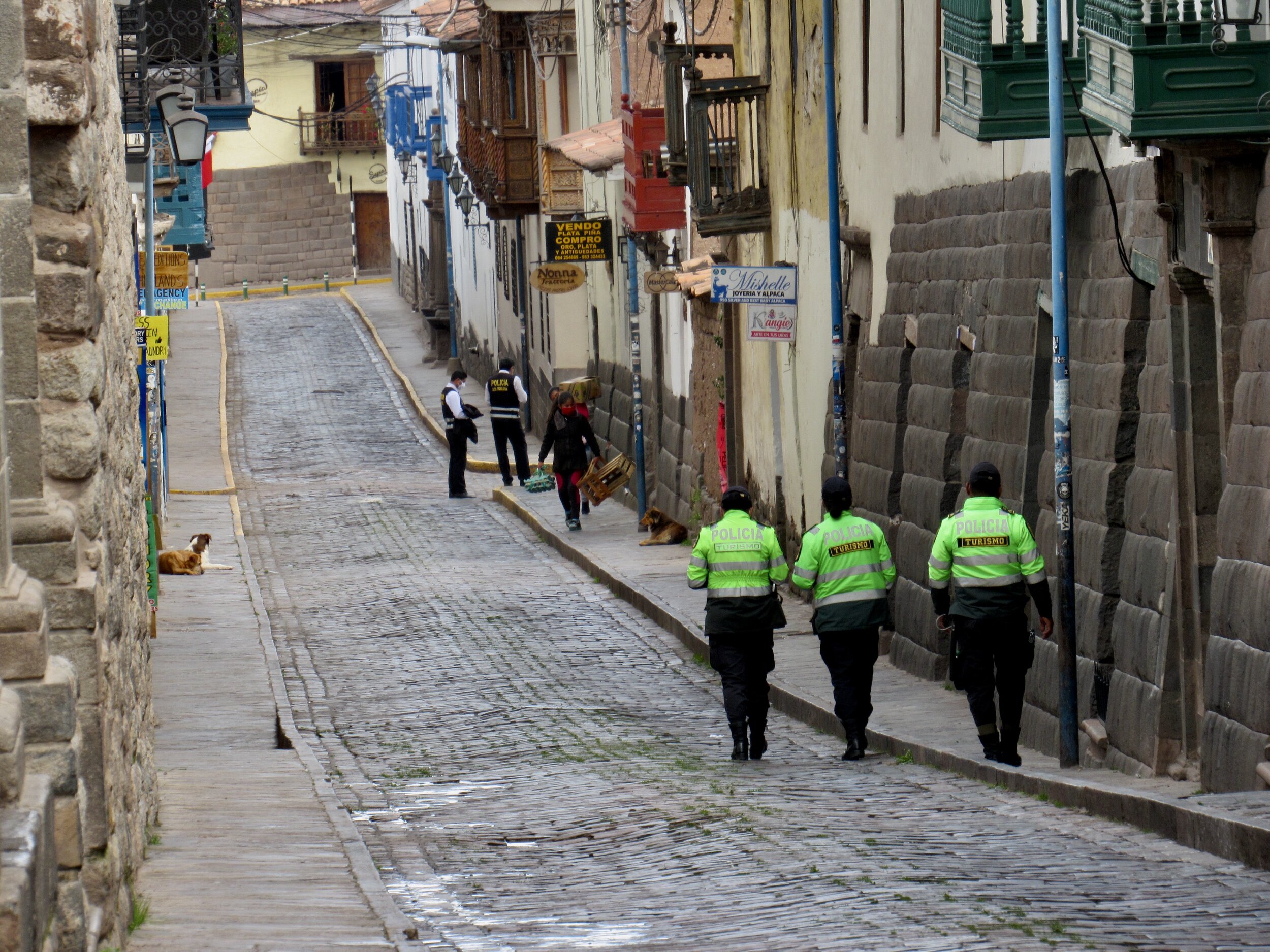
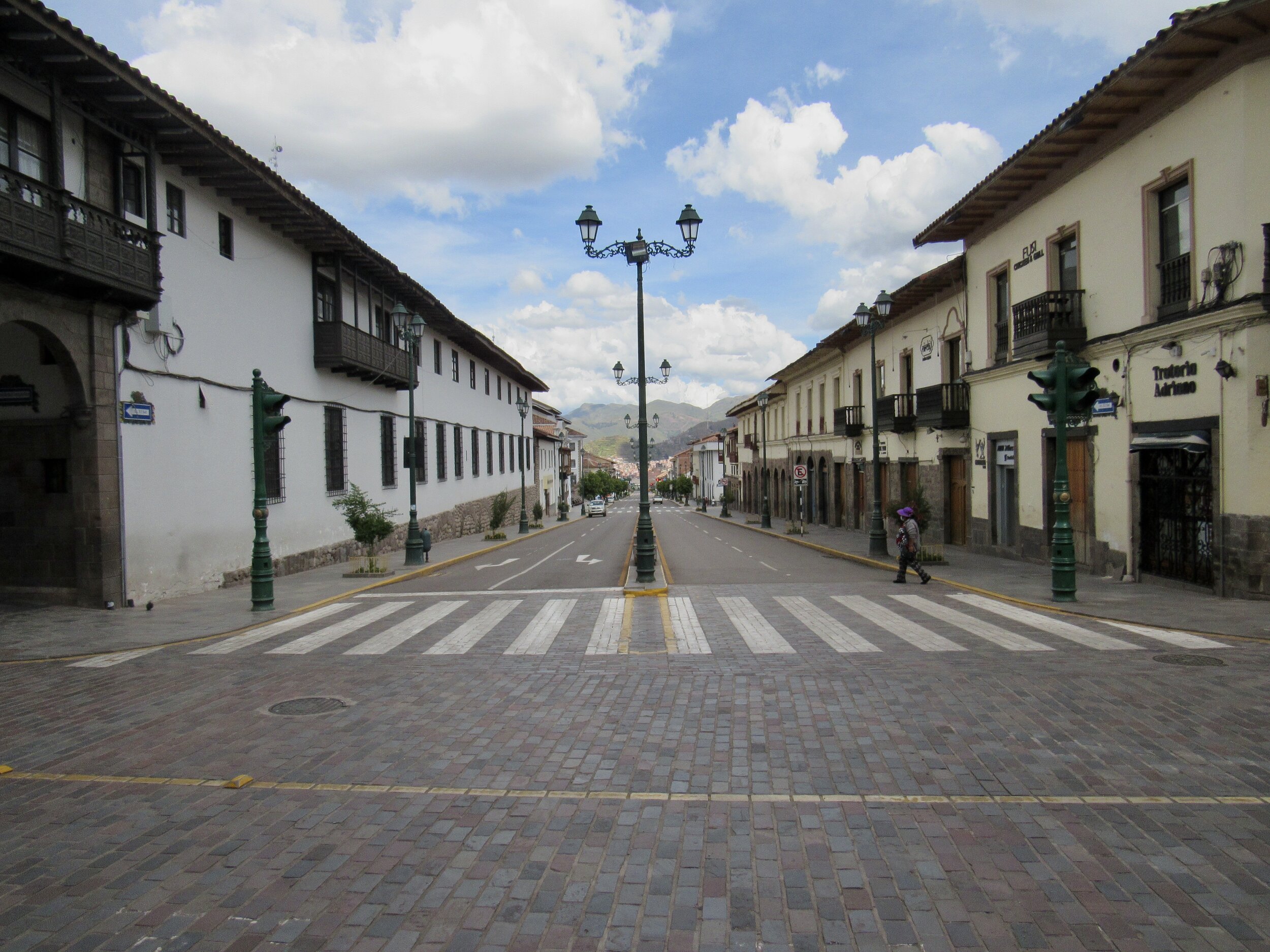
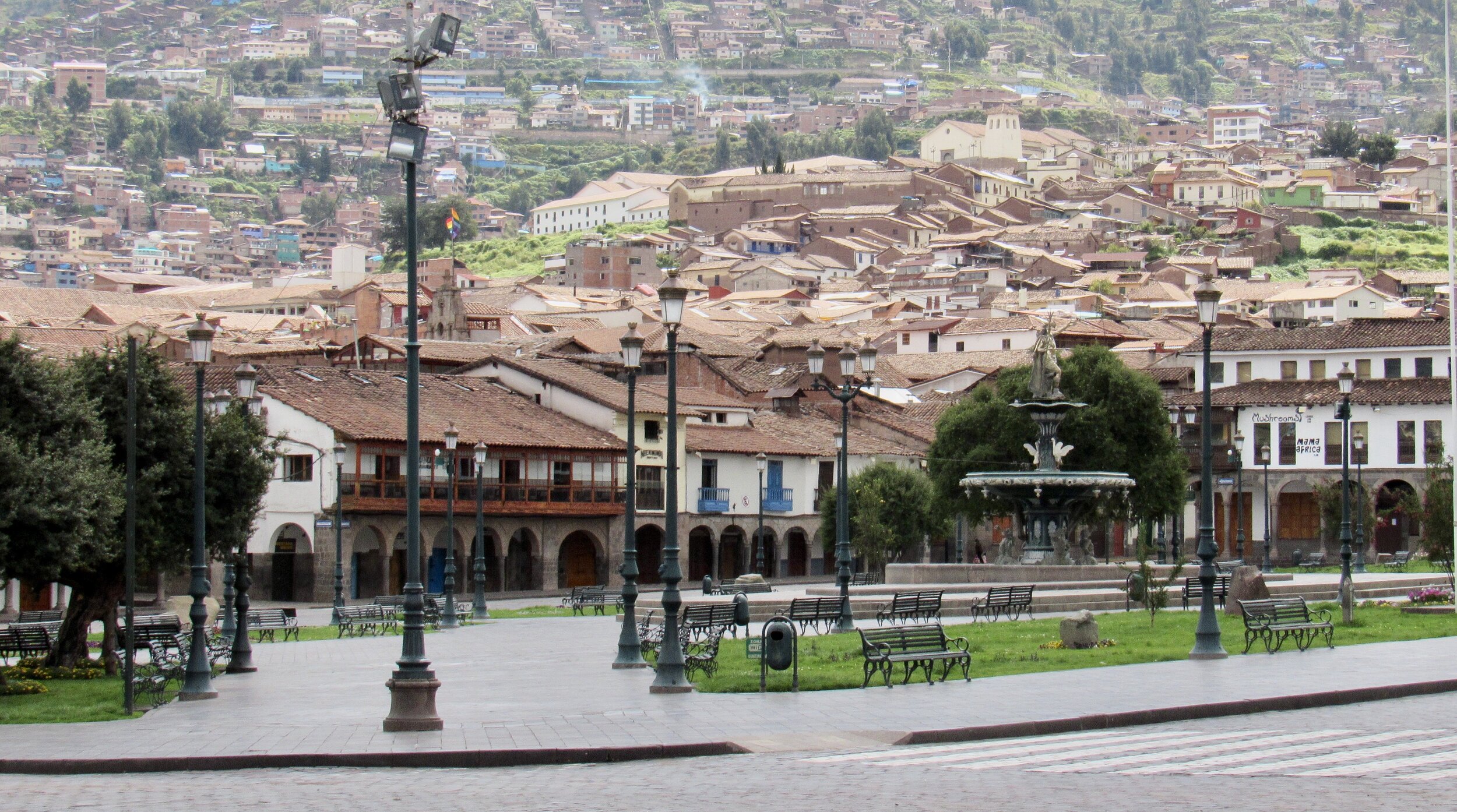
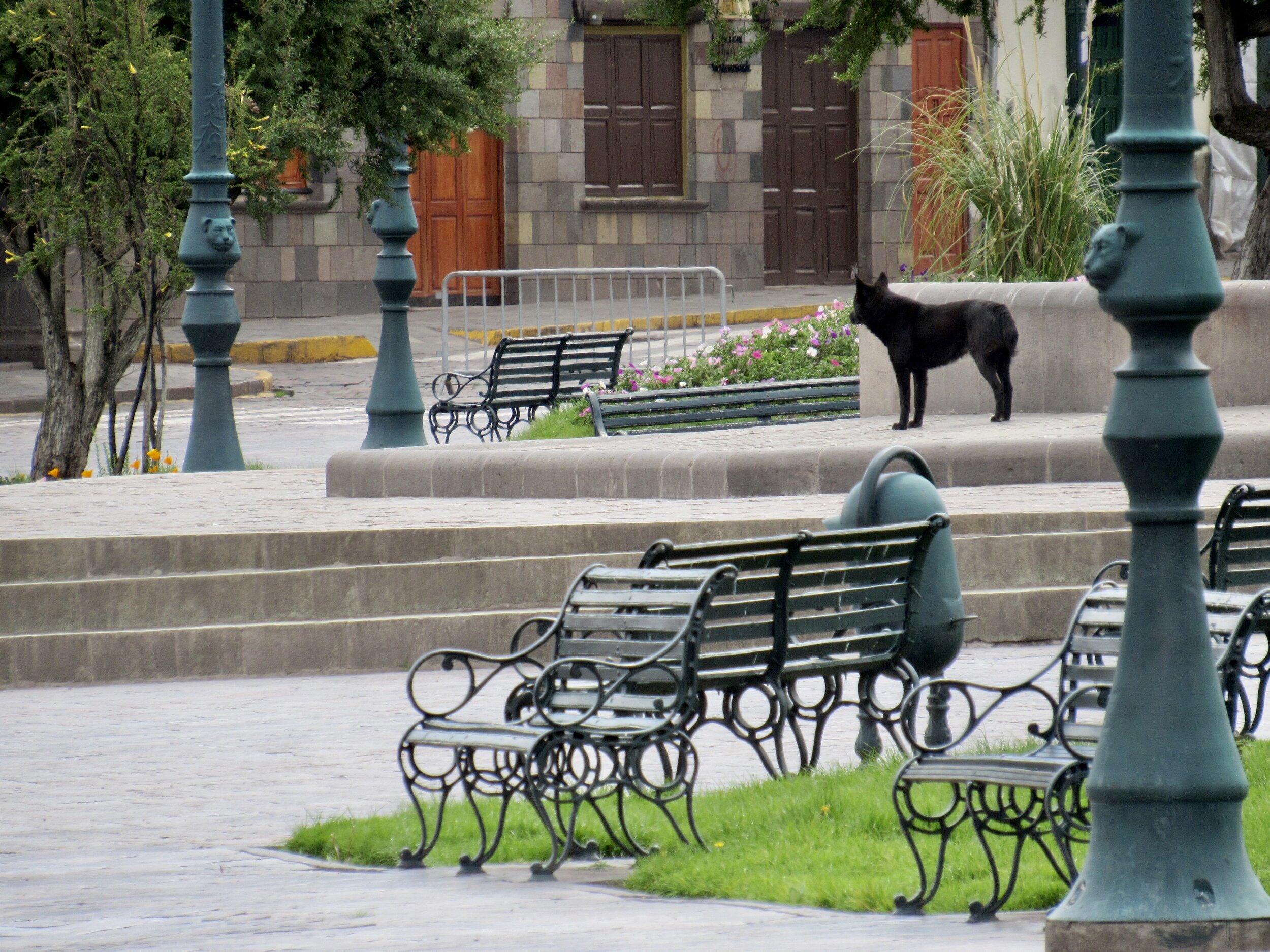


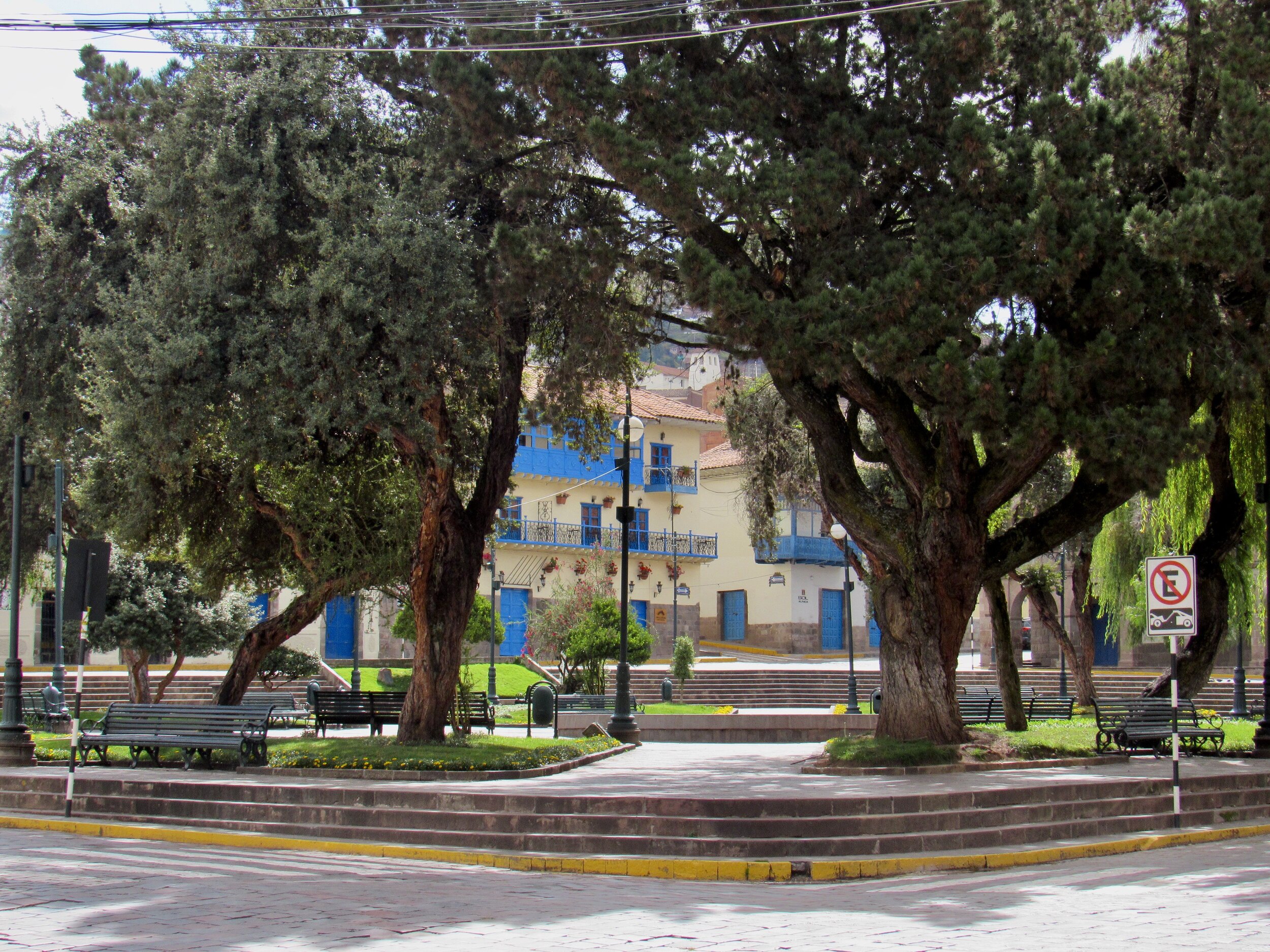
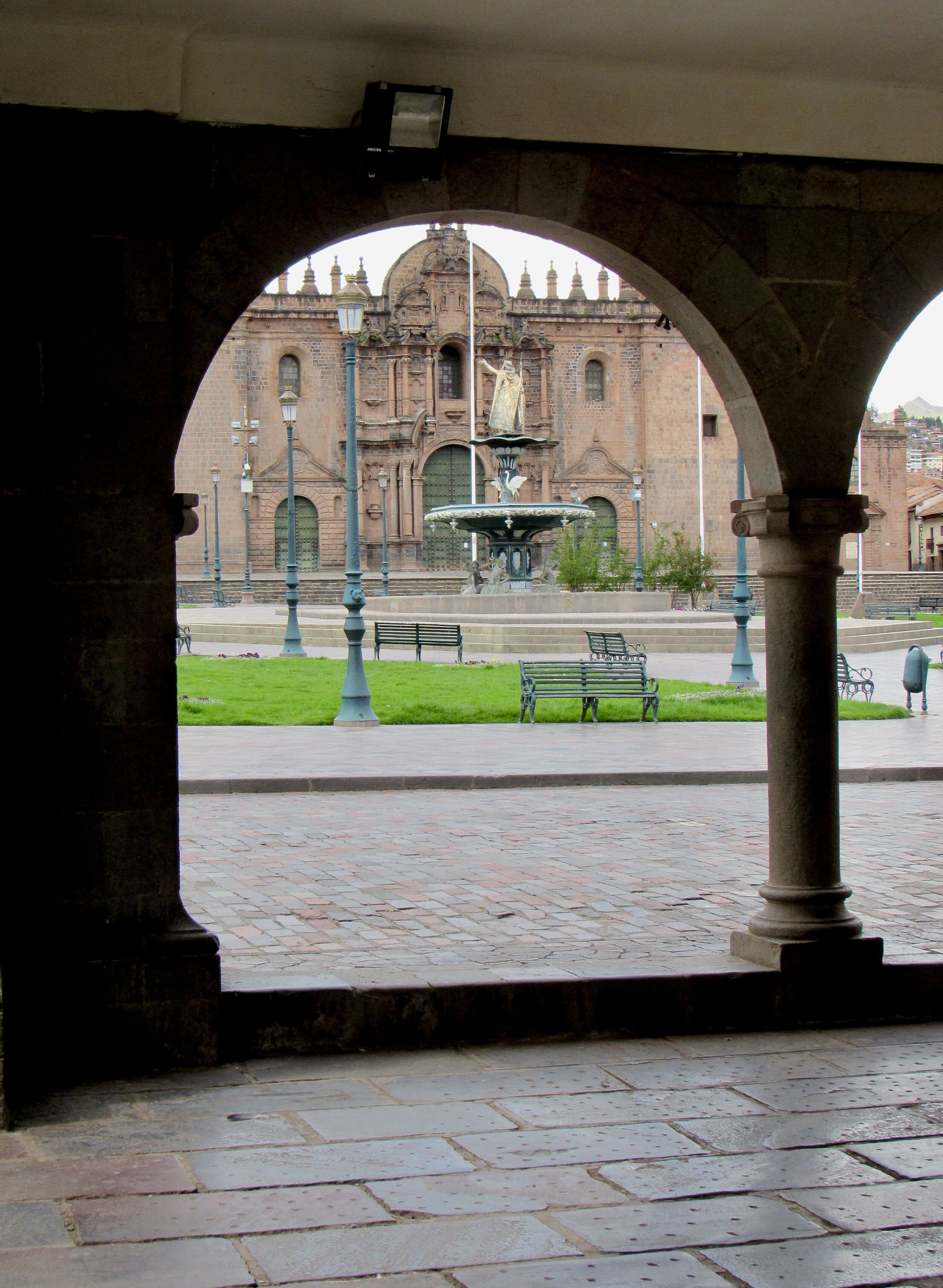
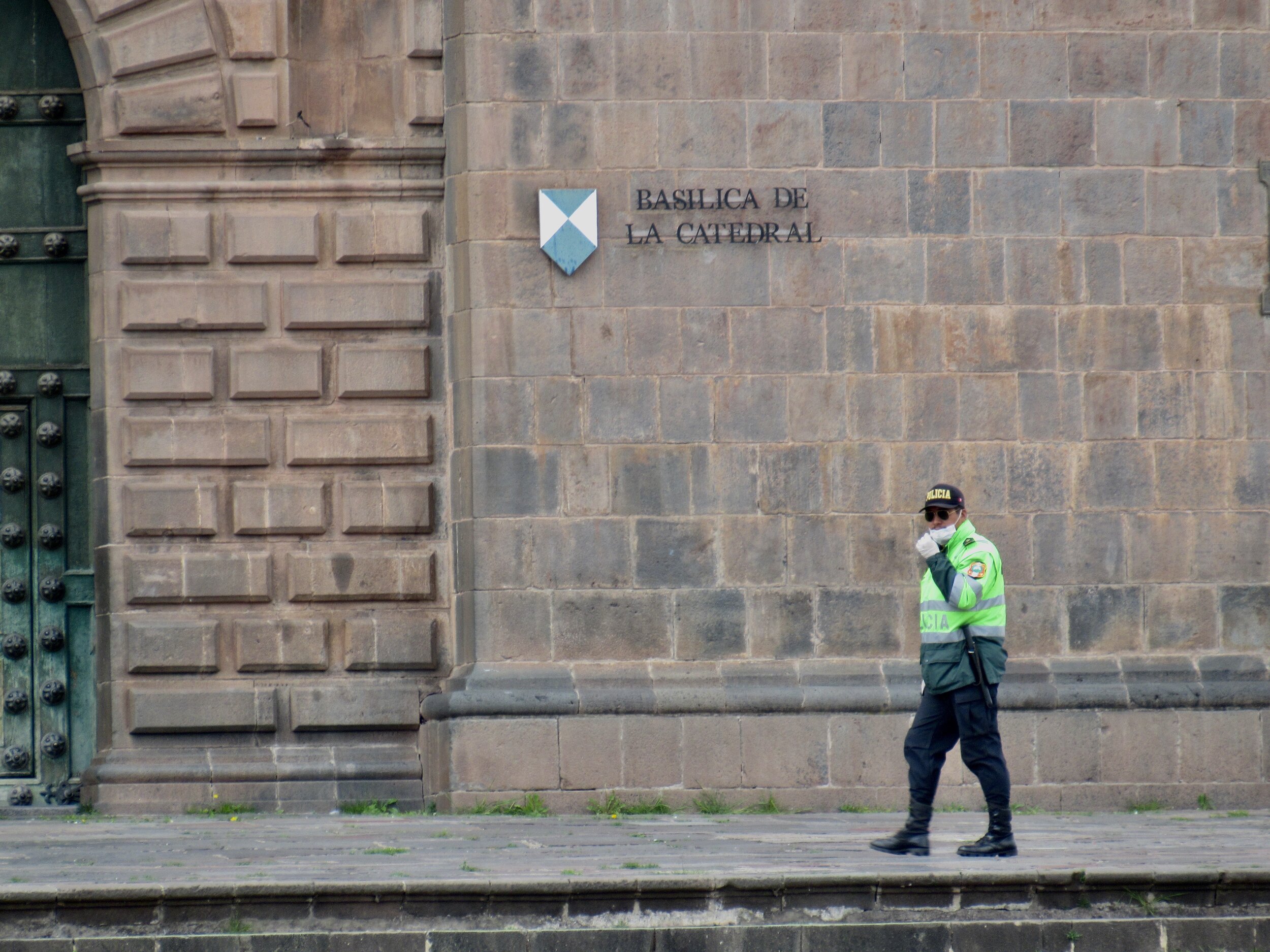
It felt so good to get outside and be able to walk. I am going to have to figure out which pharmacies I can walk to, maybe to buy a bar of soap one day, a bottle of shampoo the next. Is there a way to ethically work the system, so that I’m following the rules but not immobilized?
Wednesday, 8 April, 2020
President Vizcarra announced this morning that the quarantine and closed borders will be continued to April 26th. That will be 42 days. That’s six weeks. My mind went blank when I read that. Yesterday and Monday I felt great. Is this going to derail that?
I’m trying to reassure myself, I can do six weeks. My recovery from a hysterectomy was six weeks and that was brutal. I had very limited mobility and was in terrible pain for weeks. This isn’t as bad as having a hysterectomy. I’m clearly grasping at something to comfort myself. Anything.
I try venting to a friend in the US, who counters with “we have a Shelter-in-Place order until June 10th.” Okay, but it’s not the same. You are allowed to go out any day, as long as it is for a necessity. Necessities include grocery stores and pharmacies, but you are also allowed to go for a jog or bike ride by yourself. You are not threatened with arrest for taking the garbage out after 6pm. You will not be arrested if you go outside Monday, Wednesday, Friday or Sunday. It’s not really the same.
I try venting to a friend in Cusco. I whine that I just want to be able to go for a walk by myself. I tell him that my friend in Paris is allowed to go for a walk or jog or bike ride by herself. Why can’t they just recognize that exercise and fresh air are essential for both mental and physical health? Why can’t they just let us go outside as long as we are alone?
What I get from my friend is a gentle reminder that Peru is not Paris. Fair enough. It’s not. He reminds me that we don’t have the medical resources that France does and we can’t handle even a fraction of what they are dealing with. The numbers in France are way worse than Peru. Why would we look to anything they’re doing as something to emulate?
Also a very good point. As of 3pm today, Peru officially has 2,954 confirmed cases of COVID-19 and 107 deaths. That’s less than the number of cases in the state of Missouri and just a couple more deaths than the state of Maryland. When I look at the numbers for France, my idea of wanting the same freedoms as Parisians seems ludicrous. France has 82,048 cases and 10,869 deaths. Peru has half the population of France, but a hundredth the number of deaths.
Even more poignant, if you take the numbers in Paris and combine them with the infrastructure of Cusco, you would probably get Guyaquil, Ecuador. In Guyaquil, so many people have been dying at home that the city has been unable to keep up with collecting all the bodies. Families have had to leave their loved ones in the street because, with the tropical heat, you can’t keep them in the house. The government is now distributing cardboard coffins, so at least families don’t have to leave them in the street under just a blanket.
Neither of my housemates came upstairs all day, so I couldn’t commiserate with them. I think they’re either hibernating or have gone completely nocturnal.
Okay. Time to focus more on what I can do at home to keep busy and not go crazy: write this blog, work 4 hours a day, build my own website, cook three meals a day, exercise in my home studio (bedroom), learn Quechua, do the Creative projects by artist Anna Brones, write to and talk with friends and family, take photos of birds out the windows and keep finding more things I can do while in quarantine.
Six weeks. Recovering from surgery is way worse. This is definitely not as bad as surgery. I clearly survived that. I can do this too. I just have to stay positive.
The most exciting news of the day is that I found what could be a watermelon growing in the pear tree about six feet off the ground. I’ve been watching what I thought was a pumpkin vine flower out of the top of the pear tree, waiting for there to be pumpkins growing up higher than the pears. Until today I hadn’t done a thorough inspection of the rest of the tree. I was down on the neighbor’s back patio this afternoon, moving my potted basil plant from one spot of sun to the next, just wanting to be outside for a few minutes, when I noticed something half hidden in the tangled branches. It doesn’t look like a pumpkin. I’ll ask my neighbor next time I see him, but I really want to pick it and see if it’s a watermelon.
Last night the moon looked full and I got a few photos from my window, although it was cloudy most of the night. Hopefully tonight it will be clear and I’ll be able to get a better shot of the Super Pink Moon!
Thursday, 9 April, 2020
New countdown: this is day 25 of quarantine, with 17 days to go - unless it’s extended again.
Last night I got some really incredible shots of the moon. The sky was crystal clear and I am continually amazed at how little atmosphere interferes with photos at 11,000 feet. I went up on the roof last night and got some great shots. I don’t have a tripod, but I improvised with stray boards to balance my camera at just the right angle. I put on the timer so I didn’t move the camera when I depressed the shutter. I can hardly believe how clear each crater is in my photos.
I have taken some great photos out my windows and will have plenty of time to keep that up the next two weeks. Some offices have a resident cat or dog, I’m starting to think of my blue and yellow tanager as my office pet.
Today I finally got some clear shots of the hummingbird that visits the flowers outside my office windows. After 25 days of blurry images, I got some really great shots. It’s definitely a green violet-ear hummingbird. The white beak and face had me doubting the identification at first, until I realized it’s just pollen on his face. I got some good, sitting portraits, but my favorites are of him with his face in a flower, wings blurry and little feet perfectly in focus. I love little hummingbird feet. There’s my silver lining of quarantine for today.
Tonight one of my housemates and I had a movie night, complete with popcorn. It was so nice to sit on the couch with somebody and laugh at dumb jokes in the generic comedy we picked.
Friday, 10 April, 2020
Today is still a complete lockdown, with people only allowed to leave the house for emergency medical services. However, we did get some good news! Tomorrow is the last day with gender restrictions. It’s still a women-only day, but on Monday there will no longer be a gender restriction. Also, the president reduced the curfew from 5am to 6pm, to 4am to 6pm. I really don’t see that as any improvement or change at all. Maybe it will help sanitation workers get to work, since they generally start very early. Still, for the rest of us, that’s not going to make the slightest difference.
I also found out today that one of my coworkers just got out of being in the hospital for three days for a miscarraige. Of all the tragedies to experience during a global crisis like this, I can’t even imagine what she’s going through. She didn’t have any health insurance and they had to pay cash. Her inlaws sent her food three times a day while she was in the hospital, and she says they have been very supportive.
Just as we have very little healthcare infrastructure here in Peru, very few people have any kind of health insurance. The most vulnerable in terms of pre-existing health conditions, high percentage of elderly people, lack of running water for proper hand washing, low income and high unemployment are also those who live farthest from any kind of healthcare facility. True, most of these people live in small, isolated communities where it is unlikely that anybody from the outside could even get to under the current quarantine restrictions and travel bans. However, if we open up too soon and people from cities take the virus up to these mountain communities, it will be a complete disaster.
To cheer myself up, I spent the afternoon taking photos of birds out the windows. I added a lot to my portrait series of the blue and yellow tanager and started taking photos of the sparrows and pigeons.
Saturday, 11 April, 2020
Week four has actually gone pretty well, considering. I haven’t had as much trouble with anxiety and panic attacks as week three. Humans are infinitely adaptable and I think that I am actually adapting to this new reality.
Today I ventured out to deposit my rent at my landlord’s bank. I wasn’t able to get the cash out until last Tuesday afternoon, since I was paid for March that morning. By the time I left my bank, it was too late in the afternoon (3pm) to make the deposit. Wednesday only men were allowed outside and Thursday and Friday nobody was allowed outside. Hence, getting my March pay on April 6 meant that I couldn’t pay rent until April 11. My landlord was grateful to get it, regardless of how late. I think she’s worried, since there’s no way to replace my housemate who went home to Switzerland. People are fleeing Cusco and moving in with family as it becomes more apparent that it will take a long time for tourists to come back.
My housemate from Venezuela may have to move in with her brother in Lima soon. The restaurant she worked for notified employees today that they will not open until September or October and that they are only paying employees through the end of April. There really are no job opportunities for her in Cusco, so she’s trying to figure out how and when she can get to Lima. Currently, there is no transportation of any kind. If quarantine actually ends or relaxes on April 27th, she will probably be able to leave Cusco by the end of the month and not have to pay any rent for May. Of course, if she says here without paying, there is no way the landlord can evict her or make her pay.
I read on CNN today that a third of Americans did not pay rent, or did not pay rent on time, for April. I wonder what that statistic is for Peru. How many other people are not paying rent, or are not paying on time. It might not matter, since evicting a tenant is not on the list of essential business that we can conduct under quarantine. Grocery store and pharmacy to buy necessities, yes. Rental properties to evict people, no.
I’m honestly glad that tomorrow is not the last day of quarantine. I’m still not ready to go outside. As much as I have felt discouraged each time the quarantine has been extended, I’m also relieved that people aren’t out in the streets, blowing our chance to permanently keep our numbers low. Peru hasn’t had the same kinds of steep curves and spikes that the US and Europe are now dealing with. I just hope we can keep this curve flat.
Quarantine in Cusco: Week 3
The restrictions are getting tighter and the rules keep changing.
Sunday, 29 March, 2020
My housemate from Switzerland is leaving today. She got a message last night from her embassy in Lima that she has a spot on a bus leaving Cusco tonight. It’s 25 hours on the bus to Lima. Usually the bus is 18 hours, but she showed me the list of stops at all the cities and towns of people who will be on her flight. She’ll get to Lima Monday evening, spend the night in a hotel arranged by the embassy, then fly home.
It seems so sudden. During the first few days of quarantine, when I started getting emails from the US Embassy about their efforts to repatriate people who want to go back to the US, I asked her if the Swiss embassy was doing something similar. She didn’t even know that embassies were doing that. I recommended that she put her name on the list, just to have the option. I told her that it’s better to have the option, and then decide if you want to go home or not, than to not have the option.
Last Tuesday there was a flight but her name wasn’t on the list. I asked her how she felt about it at the time and she said she was relieved. She wasn’t ready to go. She still wasn’t sure she wanted to go. Between last Tuesday and yesterday, she made up her mind. She definitely wants to go home. Her original plan was to be here, volunteering in an orphanage until May. If she had decided to stay, she would maybe get two more weeks at the orphanage after quarantine ends. That’s assuming that it will end on April 12th and that the orphanage would allow outsiders who weren’t quarantined with them to come to the orphanage. It makes sense to me and she seemed so much happier once she did make the decision to go home.
Last week I was feeling pretty smug about being so safe here in Peru. Especially following the news of what’s going on in Europe and the US. It sounds like chaos, with people not respecting even the principle of social distancing or quarantine. The US Embassy website says that as of 1pm yesterday, we are at 671 confirmed cases in Peru and 16 deaths. If we can keep the numbers that low, I think we will escape the nightmare that’s playing out in Italy and New York. It’s still too soon to know and I’m hoping that the tables don’t turn on us.
Today a friend sent me a map of Cusco with some areas in varying shades of red. The darker the red, the more dangerous that part of town. There are three hotels marked on the map in a deep brick red. One is where a Mexican tourist died, one is where a Chinese tourist died and the third is where another Mexican tourist had a confirmed case of COVID-19. The “contingency” hospital is also marked on the map, where they take confirmed cases. Thankfully, where I live isn’t even on the map. My home is just outside the margin. That makes me feel better, but the grocery store that I wanted to go to tomorrow morning is in the red zone. I might have to rethink that one.
Monday, 30 March, 2020
I did not go anywhere near the red zone on that map. I went to the San Blas market where I usually shop, which is only a few blocks from my house.
But before that, I went on my morning walk again. I left home at 5:30, in the dark, hurrying up the back stairs and paths to get out of town before it got light out. Today, as I left town, two dogs joined me. I’ve hiked with them before, although there is usually a bigger pack of four or five of them. Of the two who joined me today, one is super shy and skittish but looks too well cared for to be a street dog. He is always immaculately clean and perfectly groomed. His companion today is one of the dogs who looks like a street dog to me because he has some matted fur that I think any owner would clip off.
We crossed the road, then started up the section of Inca trail that leads to the Temple of the Moon. The horses weren’t along the trail like they were last week, but I saw them grazing closer to the hilltop that is the Temple of the Moon. We jogged up to the top of the hill and sat down for just a few minutes before heading back down. I got down to the road by 6:30. I’m only exposed for about 30 seconds, at most a minute, as I approach and then cross the road. The past two weeks, when I have gone for these early morning walks, I haven’t seen anybody, but today the cops drove by right before I was about to cross the road. There was nowhere to hide and they slowed and stared, but kept driving. They didn’t stop or say anything. I certainly didn’t get fined or arrested, but I could have.
Just being seen is enough to scare me. I will be doing jumping jacks or running the stairs in my house or something for the next two weeks, rather than go on a hike, no matter how early. I can’t go earlier than I have been because we are under curfew until 5am. Last week curfew started at 8pm but now it’s 6pm. Piura, where they had a huge jump in cases last week, which I called the Florida of Peru, has a curfew starting at 4pm.
My hiking companions stopped right where they picked me up on my way out of town. It’s a beautiful spot with a great view of all of Cusco. I paused there with them for a minute, catching my breath. I hadn’t realized that we had been running since the cops saw me.
I feel so defeated. I thought I had found a safe way to get outside. Now I don’t think it’s worth it. No hike is worth getting arrested. I will find another way to get enough exercise.
On my quick trip to the San Blas market today, I thought about a CNN article I read: “Should or shouldn’t you wear a mask right now?” in which the author points out that considering the shortages, all masks should go to hospitals. Here, nobody is allowed to enter any market or shop without a mask. If you don’t have one, you can buy one at the door. Of course, these are not the N95 masks that are “worth their weight in gold” according to Dr. Sarosh Ashraf Janlua. However, I absolutely agree that they should be required to protect the people who work at the market. There are benches between shoppers and the vendors with their produce, but nobody is 6 feet away from the vendors. They are exposed to a lot of people every day. The least we can do is wear masks, just in case one of us is sick. We also wash out hands and step in bleach every time we enter the market, but you know what I mean.
Work started out this morning with a message from my boss, Saul. We are canceling all tours and treks through May 15. We will not resume normal operations until May 16. I take to Whatsapp and Messenger to warn the guides. The earliest any of them could possibly get any work from us will be May 16th, if tourists come back to Peru in May.
That’s a pretty big “if”. Saul sends me an encouraging message: May will be fine.
Maybe. I think the problem in May will not be what is happening in Peru, but what is happening in other countries. If the US and Europe continue to be such disasters, it won’t matter how safe Peru is. Tourists will still not be traveling. Once we are allowed out of our houses in Peru, will we be allowing any international flights to even land here?
It’s a busy day, updating our COVID page on the website and answering the emails that built up yesterday. At lunchtime, it’s actually sunny. The past three days it’s been raining too much to go out to the park. I grab my book and go sit on a bench in the sun, accompanied only by the pigeons and neighborhood dogs. At 3:00, when I get up to go back in, a neighbor sticks her head out of her window and tells me that I have to follow the rules of Peru. I reply that I’m not near anybody and that’s social isolation. She scolds me some more as I walk back to my house.
It’s so discouraging. No more walks up to the Temple of the Moon. Now I can’t even go to the park across the street? How inside do I really have to be these next two weeks?
Tuesday, 31 March, 2020
I have a new motivation for my morning workouts: it’s better than getting fined or arrested for going outside. During the workout I did this morning the instructor said several times to revisit our purpose for pressing play, our purpose for this workout. My motivation is to not have any interaction with the police, since yesterday’s sighting actually scared me.
My housemate from Switzerland called this morning to tell me that she made it back home today. The chartered bus to Lima and flight to Geneva was a collaboration of the Swiss, Austrian and Swedish embassies. I had wondered if there could possibly be enough Swiss tourists in Peru to charter their own bus and plane. Now I know the answer: no.
I dealt with emails and website edits till lunch. Instead of going to the park with my book I take a chair out behind my neighbor’s house, where there is a little patch of sun next to a pear tree and a monsterous pumpkin vine that has grown out across the whole back patio, up into the tree and across the shed roof. It feels good to have some sun on my back, even if I’m not in the park across the street.
I hope that it won’t be too hard for me to stay inside another twelve days. I’ve already done sixteen days and I’m getting used to it. I think. It was so much harder at first because I was so used to going outside, so used to walking four miles every day. It also seemed more uncertain. We didn’t know how well this would work to keep the numbers down. I also didn't believe that the quarantine would end on March 31st, so there was the unknown of how long we would be told to stay home.
Now we know that the quarantine is working. Numbers of both confirmed cases and deaths are still low. I do believe that I’ll be able to leave home on April 13th, even though I am sure there will still be a lot of restrictions. Maybe I’ll be able to leave Cusco for a few days, to go stay in a smaller town that has better access to the mountains. I wonder if there’s anywhere I could stay in Ollantaytambo or Urubamba.
Tonight at 6:00 the police cars rolled through the neighborhood with their sirens on, I expect to remind us that curfew is now two hours earlier. Around the park, people applauded them out their windows. The applause was loud enough I could hear it despite the sirens.
I feel like I can see the light at the end of the tunnel. It’s not very close, but it’s there.
Wednesday, 1 April, 2020
Today is Day 17 in quarantine. 11 more days to go. Even though it’s getting easier to stay inside, the days are also dragging on slower. I vacillate between anxiety and apathy, not sure what to do with myself even though I still have a job and am still working 9-1 and 3-7.
Exactly a year ago I left Cusco, headed back to Seattle with the group of high school students that I had just taken on the Inca Trail. Last year on April 1st I had partly made up my mind to quit my job in Seattle and move here. It took a couple months to feel like I could make that happen, and then just a couple more to actually move. I was only back in the US four months before I picked up and moved to Cusco.
This is not the Cusco that I knew a year ago and certainly not the Cusco I knew a month ago. As with everywhere on the planet that is working to prevent or mitigate an outbreak of COIVD-19, Cusco is an empty shell of its normal self.
Today was the first time I went to a grocery store in over three weeks. I usually do most of my shopping at the San Blas Market or the Wanchaq Market, but some things like milk and olive oil are much cheaper at the grocery store. I wrote out a shopping list so it would be more believable that I was on my way to a grocery store, grabbed my backpack and walked downhill to the Orion on the Plaza Tupac Amaru.
Everybody I passed in the street had a mask on, but I didn’t put mine on until I got about a block from Orion because I cannot figure out how to stop it from fogging up my glasses. At the entrance they sprayed my hands with disinfectant then let me in. I found most of what I needed, but neither of the two things that one of my housemates had asked me to pick up for her. There was lots of toilet paper available, which I’ve heard from some is not the case in the US. Waiting in line to pay there were big signs overhead and on every cash register to keep 1 meter distance between us. There was also a sign that the limit for buying any item is five. That limit’s not an issue for me, but I don’t know how you shop for a family of ten. On the way out, I saw a line down the block. Apparently I had gotten there just in time, when there were few enough people in the store that I didn’t have to wait. They didn’t spray me with disinfectant on the way out, but I always have a bottle of hand sanitizer, so I could disinfect myself.
Part of me found all of that comforting. Limiting the number of people in the store, spraying us with disinfectant, requiring masks and space between people waiting in line to pay, all of that made me feel safer. It’s really the first time I’ve been in such an enclosed space with strangers in weeks. The San Blas Market is so big and open, it doesn’t feel like an enclosed space at all.
The other part of me was so relieved to get back outside. I felt a little panicky being inside with so many people. Even with the number of people in the store so limited, there were many times I was less than a meter from other people.
The other thing that was unsettling was that none of the cops who passed me asked where I was going or why I was outside. I put all my groceries in my backpack for the trek back uphill to my neighborhood Lucrepata, so it wasn’t obvious that I had been buying food. There was definitely a big police presence, but none of them stopped me. I don’t know why that’s upsetting, since normally I would be terrified if a cop stopped me. Nothing feels normal these days and maybe even that little bit of human interaction, of a cop interrogating me about being out of my house, would be nice.
Tonight we had way more drama than I could deal with after my shopping experience, which provoked my first panic attack in years. I suppose that’s happening to a lot of people these days. What I was so panicked about was taking a taxi to help our last two guests get out of Cusco. I can hardly believe that they’re still here. They spent two weeks travelin in Peru, then were supposed to fly home to Canada on March 17th. It’s like saying they had a flight on September 12, 2001.
The Canadian Embassy has a chartered bus picking up people tomorrow to take them to the airport. Where these two are staying is closer to the airport, but they have to register on the bus at 6am. They’re not allowed to go straight to the airport.
All yesterday and all today five people from my office were calling everybody they knew to try to find a taxi who would pick them up at 5:30 and take them to the bus. I heard from one after the other of my colleagues that once the drivers asked who they were transporting, and were told tourists, they just hung up. Nobody wants to get near a foreigner, much less have one in their car. The rumors going around town about tourists having COVID are out of control. Somebody from the company will have to go with them, to make sure that the taxi driver actually shows up and also to pay the driver, since we would not ask the guests to have to pay. It’s the least we can do, right? I got volunteered for this one, with the rationale that I am the only one who speaks English.
Eventually we gave up and called one of the company drivers to tell him that he had to get up at 5:00am and go out in the streets to get the company van and then drive to pick the Canadians up. I didn’t think that was possible because it’s so hard to get permission to drive. The fine in Lima for driving your car is s/6,300, which is about $2000. That’s A LOT of money here. Of course, the company vans are registered in the boss’s name and he has permission to drive for his hotel. I’m not sure what loophole lets one of our drivers take Canadians to their bus, but my colleagues seem convinced they have it sorted out.
This whole episode reminded me of last week’s Savage Lovecast podcast by Dan Savage. He was comparing the HIV crisis in the 80s and our current COVID pandemic. Similarly, people can be asymptomatic and contagious. Also similarly, you have to assume that people you have contact with have it and protect yourself. Sometimes, you have to assume that you have it and protect others. The other big parallel is the importance of testing.
Dan said that one of the biggest differences is the stigma. The homophobia that exploded around the AIDS crisis was so damaging, for so many people. Dan said that stigma isn’t a problem with COVID. I actually wrote to him to disagree. I’ve heard that people from China or of Chinese descent or who just look like they could possibly be from China, have suffered terrible acts of racism. Then, there’s the foreigners in Cusco. Nobody wants to get near us and certainly no taxi drivers would want me in their car.
Thursday, 2 April, 2020
Today will be the usual workout, shower, coffee, smoothie, work, lunch, work, dinner, Factime with friends and family and go to bed. Quarantine is such an exciting life.
When I opened up my computer this morning, I saw the office chat group had exploded while I had my phone on silent and my computer off. Apparently, the Canadians left their AirBnb before 5:30 without bothering to tell us and when the driver arrived he waited for them until 6:00 before the boss finally told him to just go home. All that trouble, and they decided to walk.
I got a message this morning from our former housemate, who is now safely quarantined in her parents’ basement, at home in Switzerland. She said it’s sad to see her home country in such a terrible state. She also said that the security, masks, disinfectant, gloves and temperature-taking in the airports were really intense. She was so glad that she had already been quarantined for more than two weeks, so she knows she didn’t leave Peru with COVID. Now she just has to hang out in the basement until she can be sure she didn’t pick it up in transit.
My housemate from Venezuela decided that if we can’t go outside tomorrow, she’s going to make a quick run to the store. She went to the same grocery store that I was at yesterday, which, of course, has new rules. She said that they took her temperature before she could go in. They had a thermometer that they held about a foot away from her forehead. New rule: nobody with a fever can enter the grocery store. That actually sounds like a good idea to me. Just like the rules changing constantly, the line between paranoid and reasonable seems to move every day.
Today the president announced new “gender” rules for going outside. I feel like I’m playing Monopoly, except that every time I pass go, the rules change. Starting tomorrow, to go out to buy food or medicine, only women can go out Tuesday, Thursday and Saturday. Men can leave the house Monday, Wednesday and Friday. Nobody can go outside on Sunday. So, if I don’t go outside today, I can’t go out until Saturday. After my experience at the grocery store yesterday, I’d rather stay home. I can’t think of anything I need to buy at the pharmacy, and that’s the only other option for leaving the house.
I’m trying to find the good news in all of the bad news from the US. The best news I consistently see is the impact this pandemic is having on air quality. I feel like the planet is taking its first deep breath in decades. The Pachamama is finally able to breathe again. Jet fuel is horrendous for the environment and I wonder how many tons of CO2 are not being pumped into the air for each day that airlines are grounded. We are all confined to our homes, sent to our rooms. Mother Nature has grounded us, literally.
Friday, 3 April, 2020
Yesterday Governor Inslee extended Washington’s “Stay home, stay healthy” order to May 4th. They don’t have military in the streets, or a curfew, but I wonder if maybe they should. The state government has a website where you can report an open business that you suspect is not an “essential” business. Now we’re reporting on our neighbors? Is that a slippery slope?
Today is the first day of Peru’s gendered quarantine. Friday it is now literally a man’s world in Peru. It seems wrong to me that the phrase “man’s world” implies that men are in charge, while the phrase “women’s world” brings to mind a magazine about makeup and weight loss.
Sitting down in my home office, I notice that the pumpkin vine, which has been growing up into the pear tree, has a flower high up in the branches. I suspect that might be the most exciting thing that happens all day.
Opening up my messages, I see that one of the office staff has sent what looks like fake news to our group chat which also includes about 30 guides. I thought fake news was a problem in the US and have been so sad to see it take hold here too. One of my colleageus told me that she believes that the CIA created this virus in a lab and sent it to infect China and Iran, to destroy them. I tried to share some real facts with her, but she wasn’t having it.
This particular post looks like a screenshot of a Facebook mime. It actually says: “Alarming data that Vizcarra is hiding to not cause alarm. THIS IS VERY CONFIDENTIAL” and goes on to list ninve Peruvian cities with an alarmingly high number of cases. The total of this “confidential” note is 9245 cases for March 31, when Peru was still under a thousand, according to the US Embassy in Lima and several other credible sources I checked. I actually posted the links to several credible sources on the group chat, determined to combat fake news with real information. Nobody commented.
If history ultimately judges Trump to be responsible for the slow reaction in the US to COVID, not only is he responsible for thousands of preventable deaths, I will also hold him responsible for the economic crash of places like Cusco, which rely on so many tourists from the US. Of course, people come from around the world to see Machu Picchu, but the US, with its proximity and wealth, contributes to a lot of the tourism in Cusco. If Americans are unable to travel because the country is such a disaster, both economically and in terms of public health, that has a direct impact on the ability of people in Cusco to pay rent and buy food. That affects not only guides, cooks and porters, but also everybody who works in hotels and restaurants. If the guides are broke, they can’t pay for English lessons from my housemate from England. If nobody comes to the restaurants, there’s no work for my housemate from Venezuela, who works in one of the most upscale restaurants in Cusco. It’s not a place locals can afford to go. Her employer depends on foreign tourists.
The ripple effects of Trump’s incompetence are so far reaching. Like the families of many Sherpa porters who work the trails of Mount Everest, most of the Inca Trail porters here live in small, isolated communities high in the Andes. They can protect themselves from COVID by staying isolated and the government can send them food and money to help them through, but until the tourists come back, they will be unemployed. How long can the government support them? So far, the government has sent 380 soles to each family deemed vulnerable. Can they repeat that? How many times? How long will it take? Sure, the porters can go back to being subsistence farmers, but how does that get them anything besides food? How can they fund a family member to live down in town so their kids can go to high school? How can they send their kids to college?
Saturday, 4 April, 2020
20 days of quarantine down, 8 more to go. I think it actually helps to have a countdown. Otherwise every day seems like every other day. It’s like driving across Kansas. It all looks the same and only the miles ticking by on the odometer give you any indication that you’re getting anywhere.
I ventured out to the market this morning, only to find it closed. Apparently it’s closed both Saturday and Sunday now. This strikes me as very unfair, since women are only allowed to leave the house Tuesday, Thursday and Saturday. Since all shops are closed on Sunday, and everybody is supposed to stay home, anything I can’t find today will have to wait for Tuesday.
I went to four different shops and managed to find most of what was on my list. For those of you in the US, all four shops had plenty of toilet paper.
I was wearing a mask and using hand sanitizer before and after each shop. Still, we are all so much more exposed to each other in little shops than in the big, open market. Two of the shops were so little that they only let in one person at a time, a larger one was allowing in five people at a time and the smallest one I went to wasn’t letting anybody in. You had to just stand at the door and make your request, just like the bakery is now. This is only mildly annoying for me, but it’s absolutely debilitating for my housemate who doesn’t speak Spanish. That’s why she usually shops at Plaza Vea at the mall, which is a lot like Target or Fred Meyer.
My most exciting find was granny smith apples, which are not easy to find, even under normal circumstances. Now I can make an apple pie this weekend! I haven’t baked an apple pie since Thanksgiving, but I have plenty of time this weekend.
I’m only working four hours on Saturday and not at all on Sunday anymore. The chaos of March has settled down, now that everybody has a better idea of what we’re dealing with and how long it will probably go on. When people try to cancel June and later, I ask them to hold off unless they are absolutely positive that they won’t be able to come. We still don’t have any money to give refunds, so unless they want to reschedule, they have nothing to lose to wait until closer to the date anyway.
It was sunny this afternoon, so I had lunch under my neighbor’s pear tree. I’m going to have to learn to appreciate this back patio space, since I’m not allowed outside until Tuesday.

